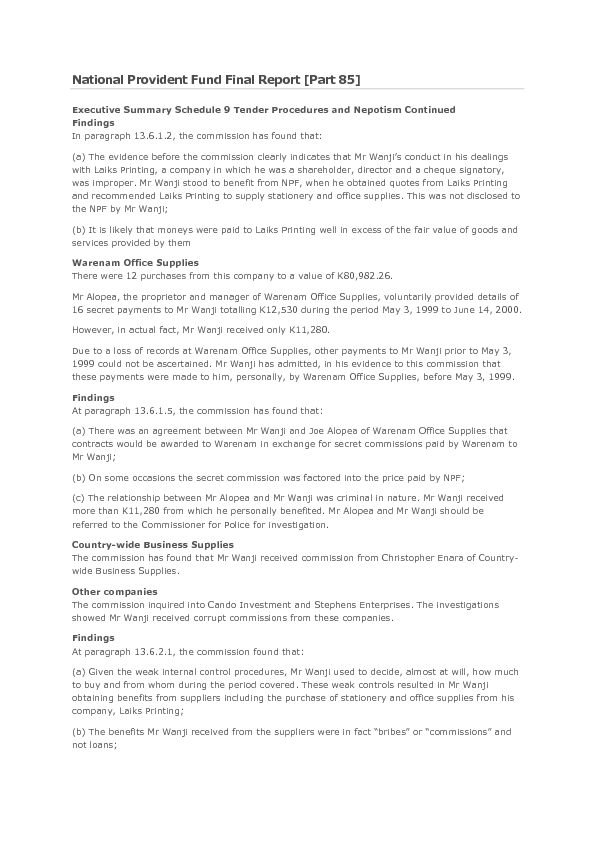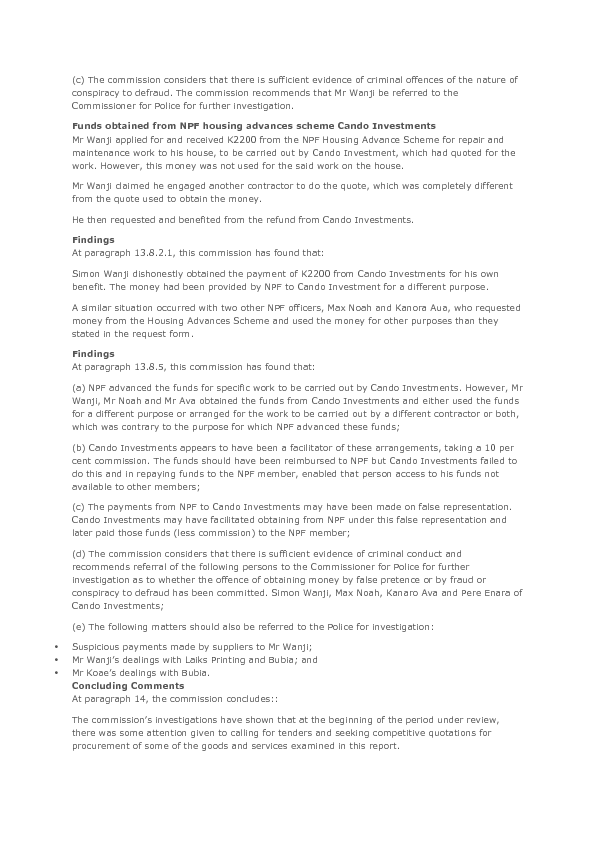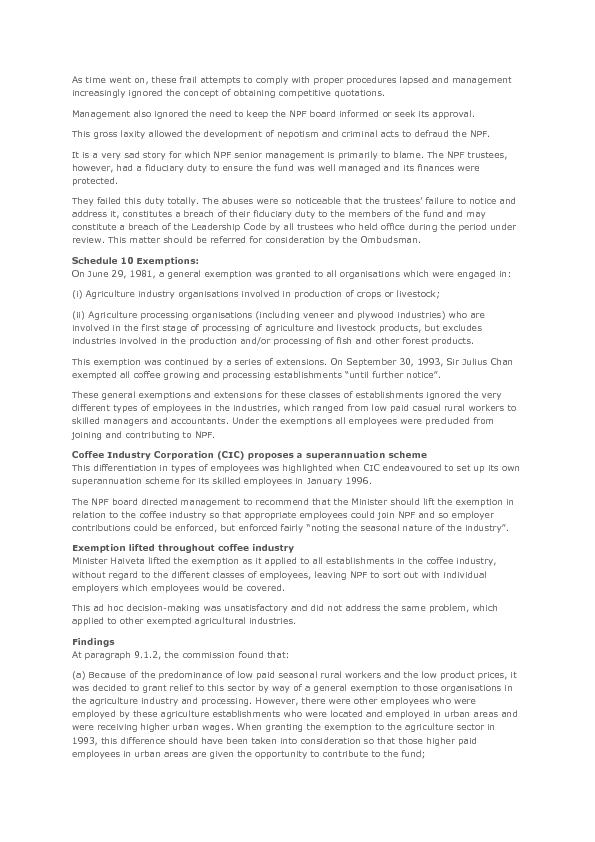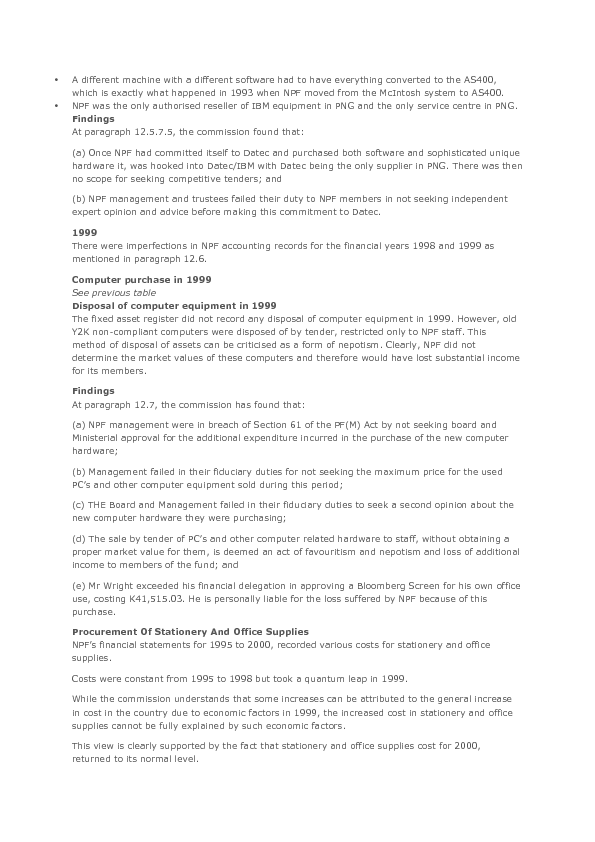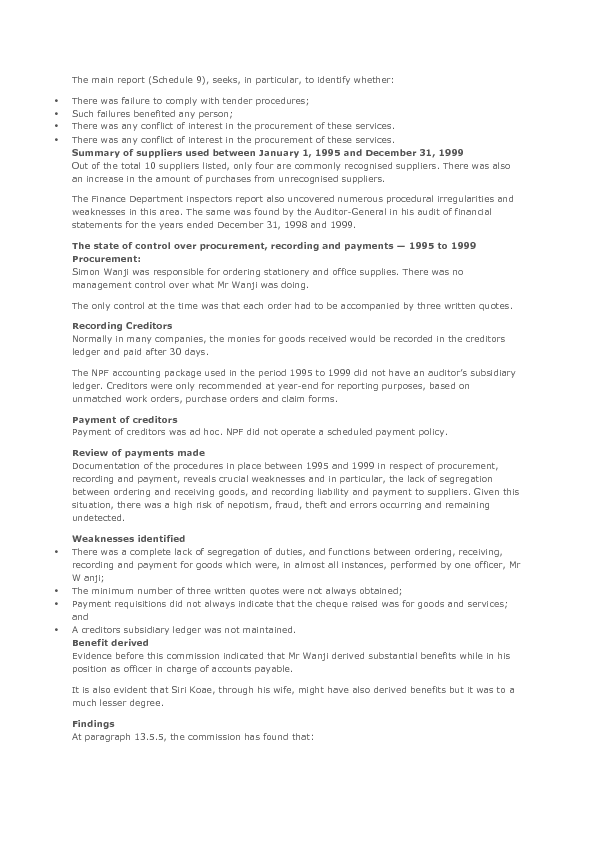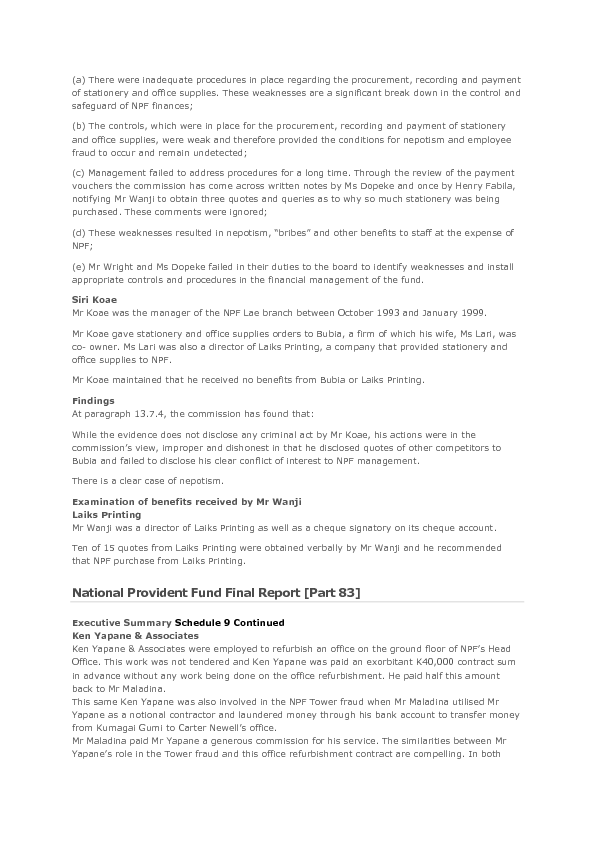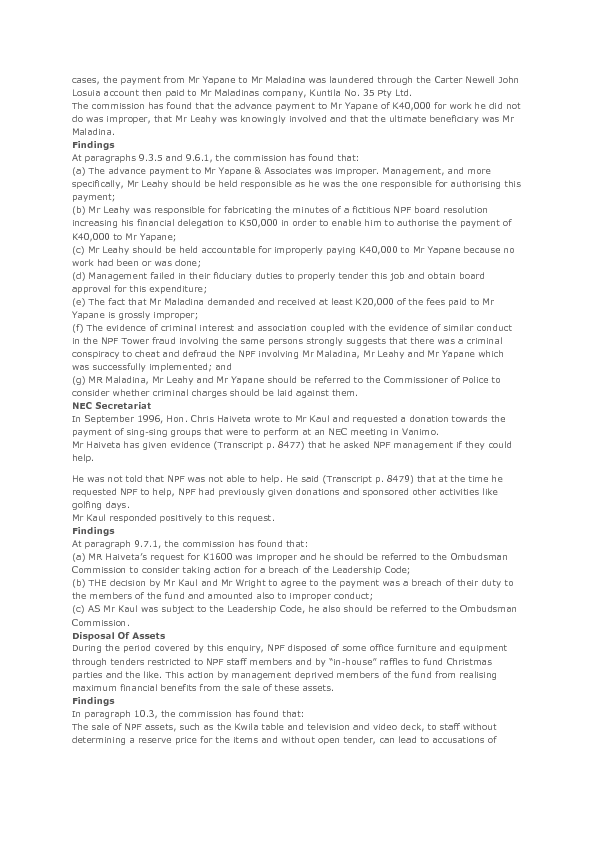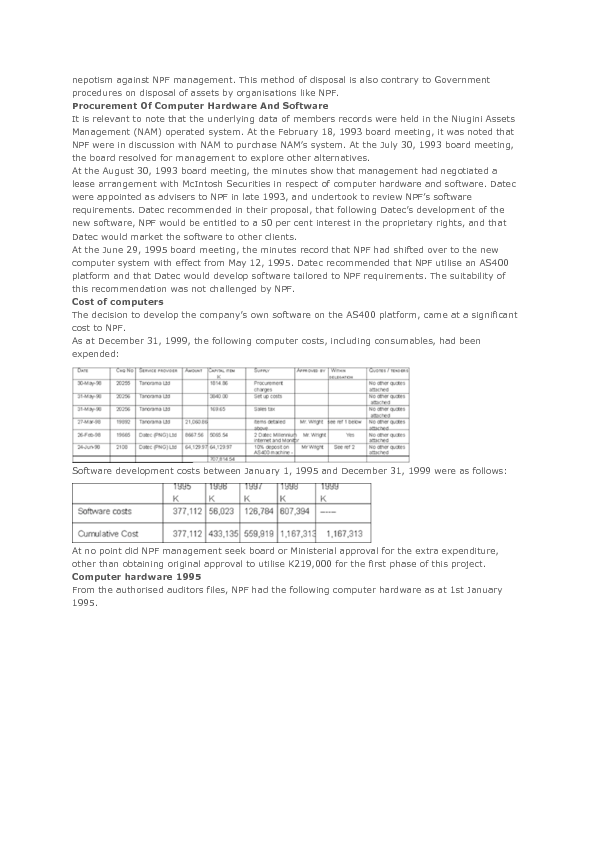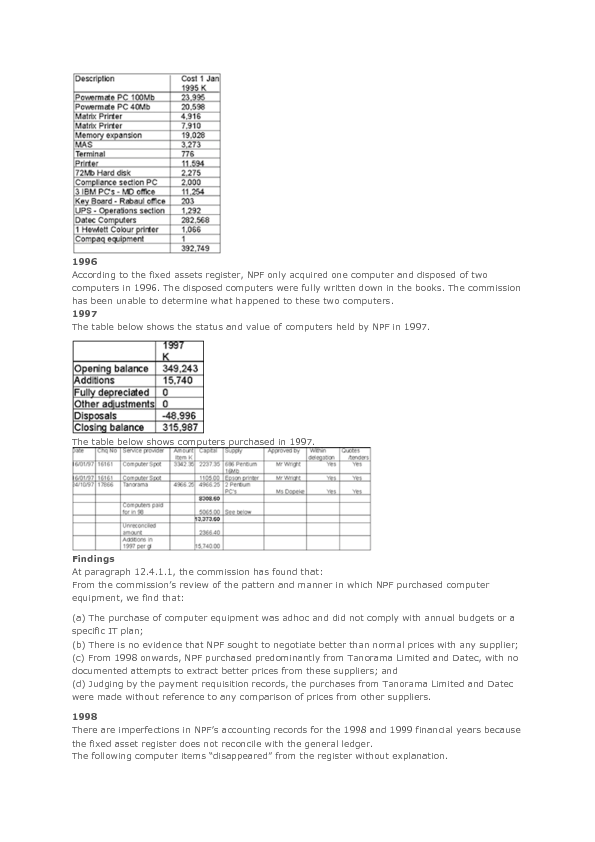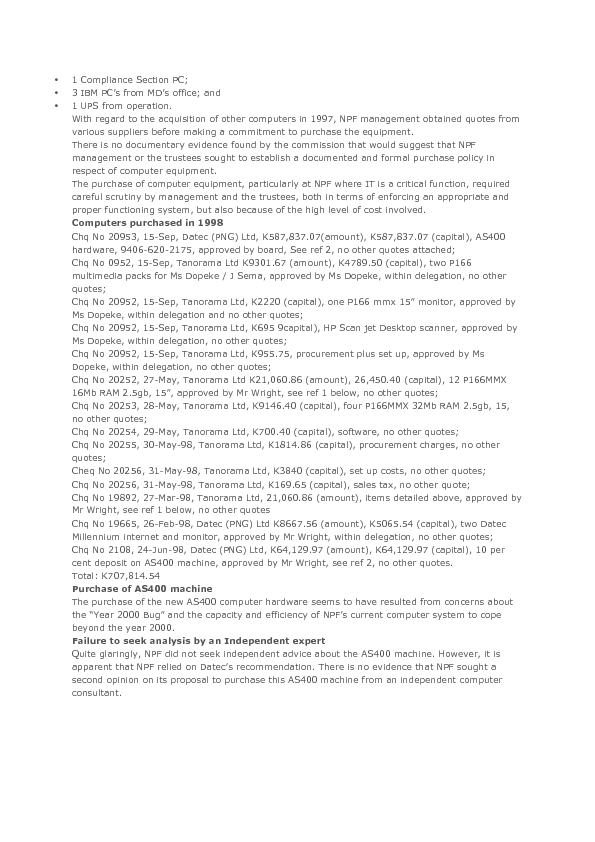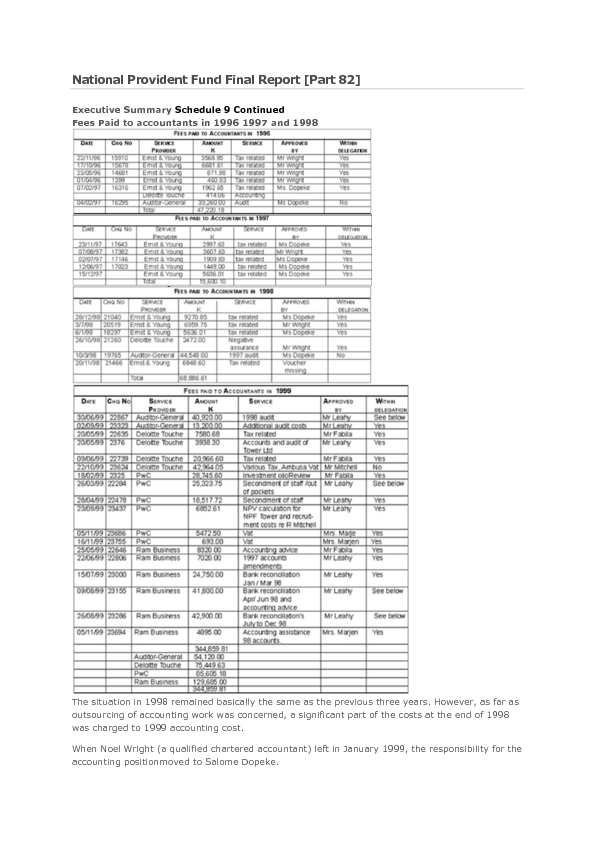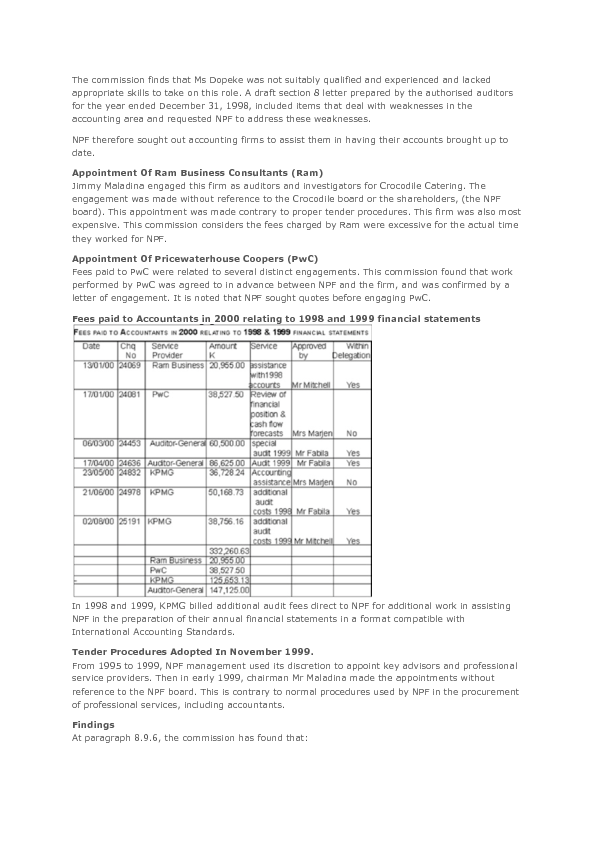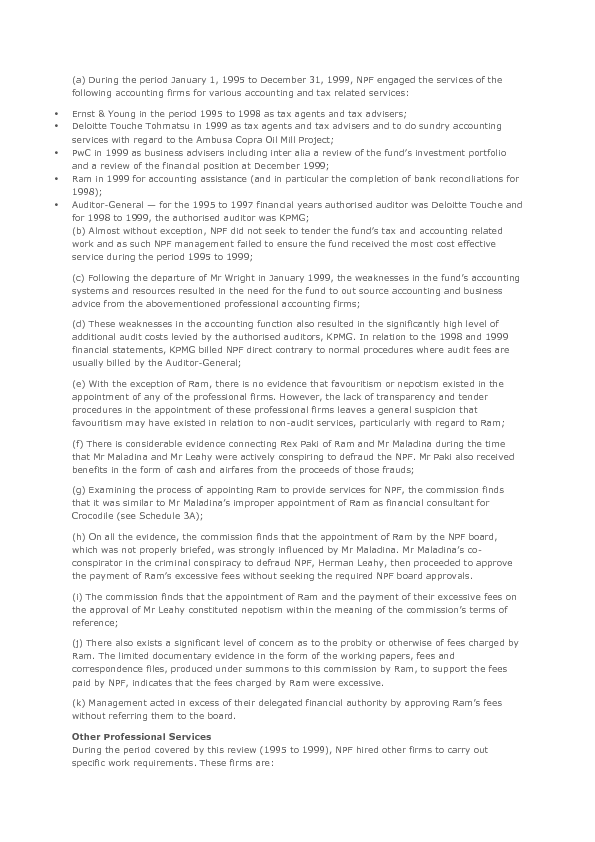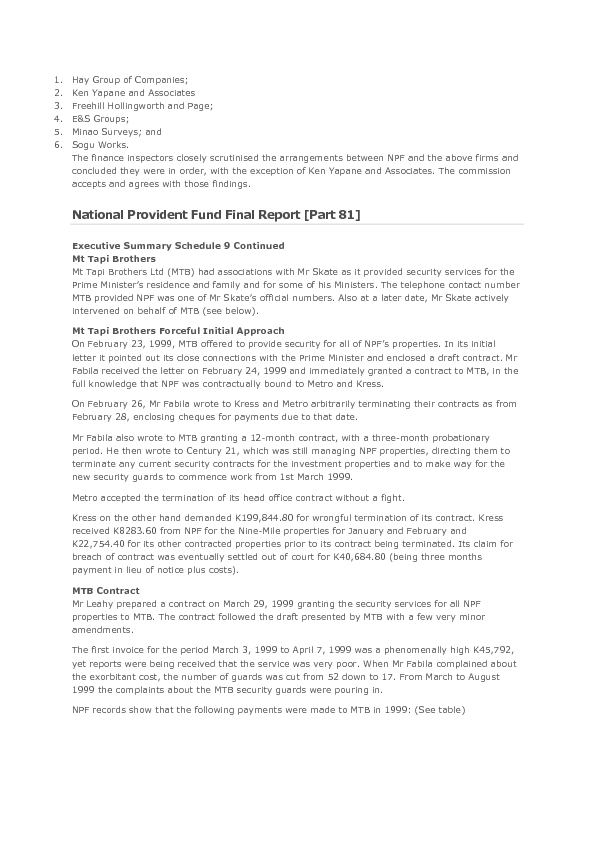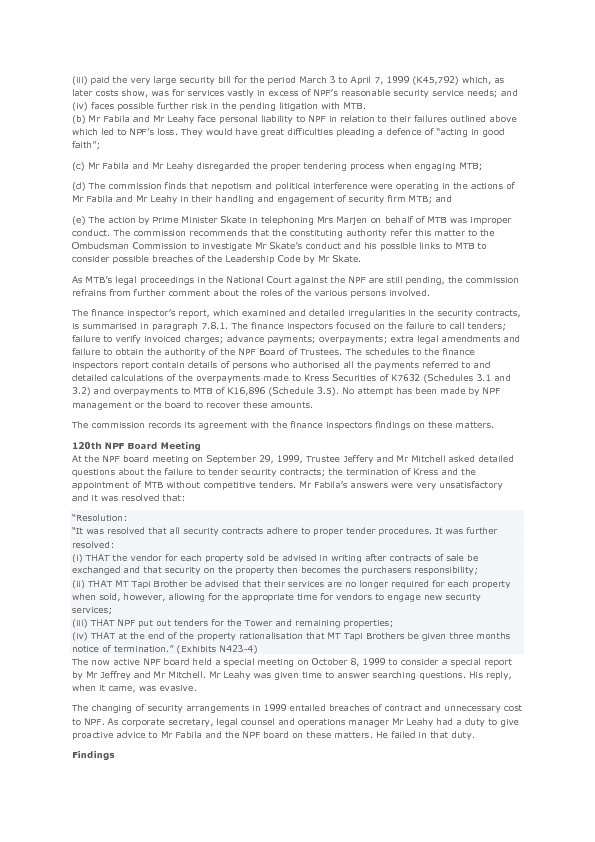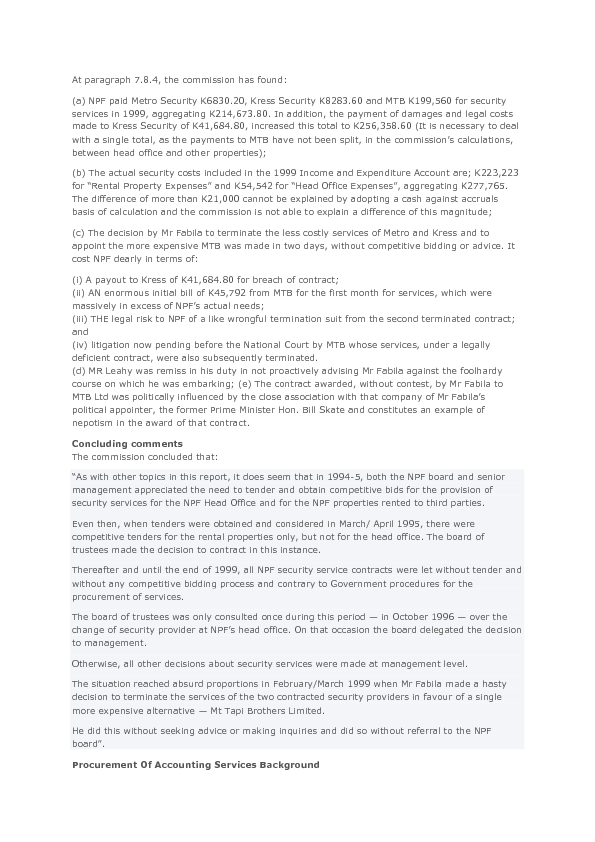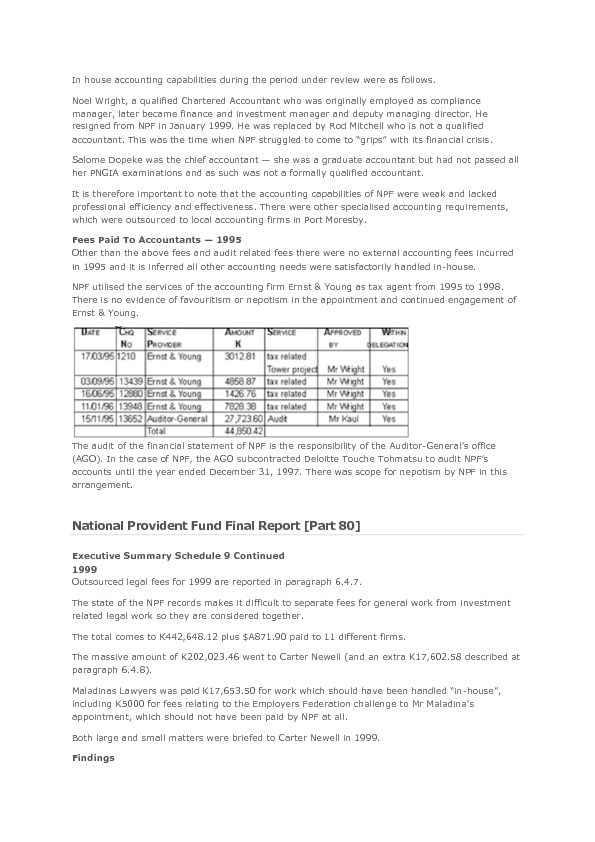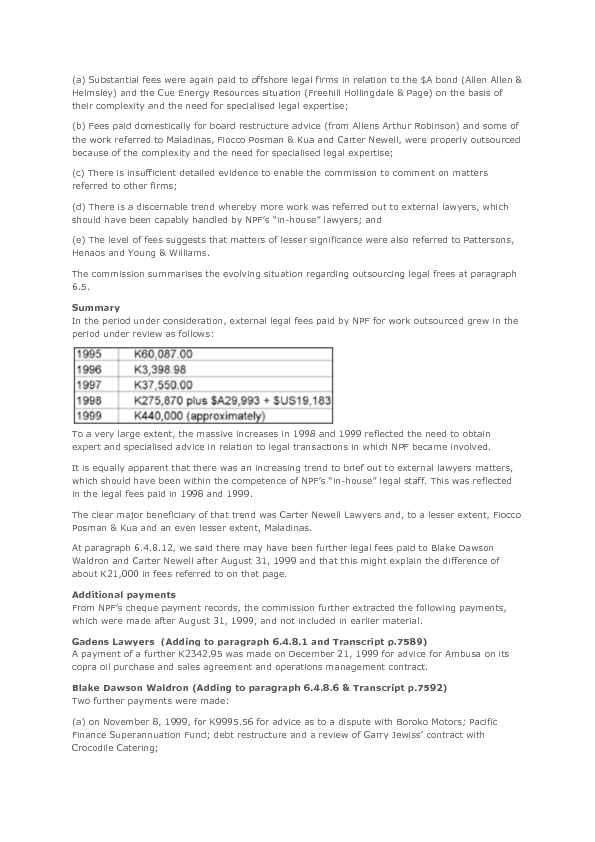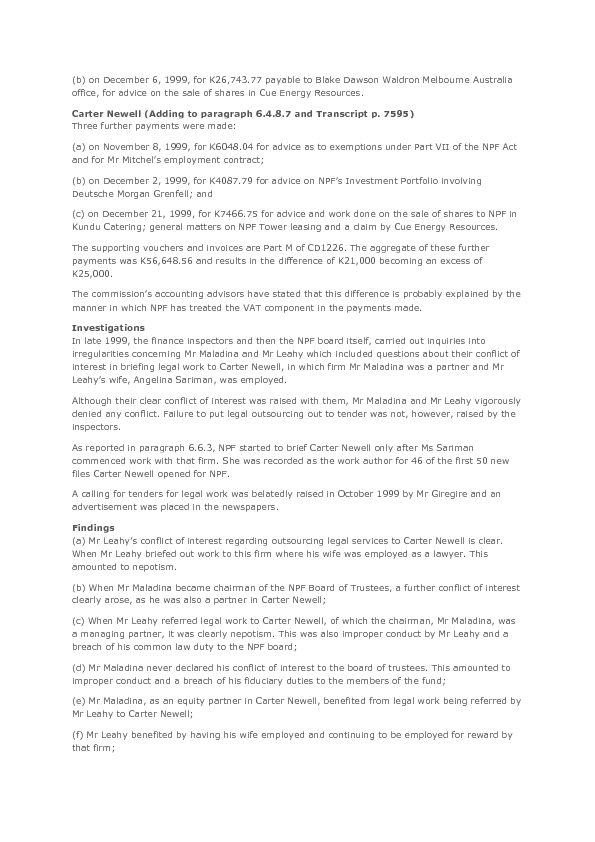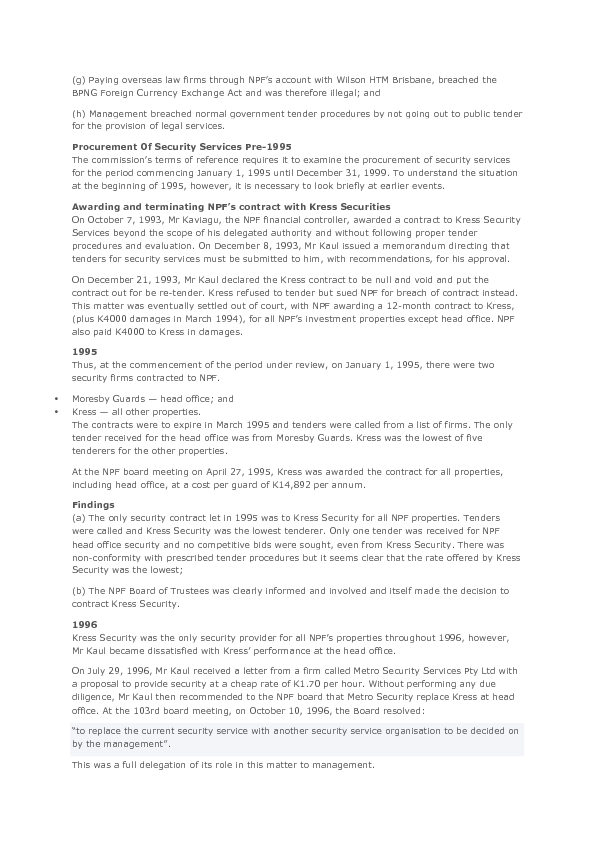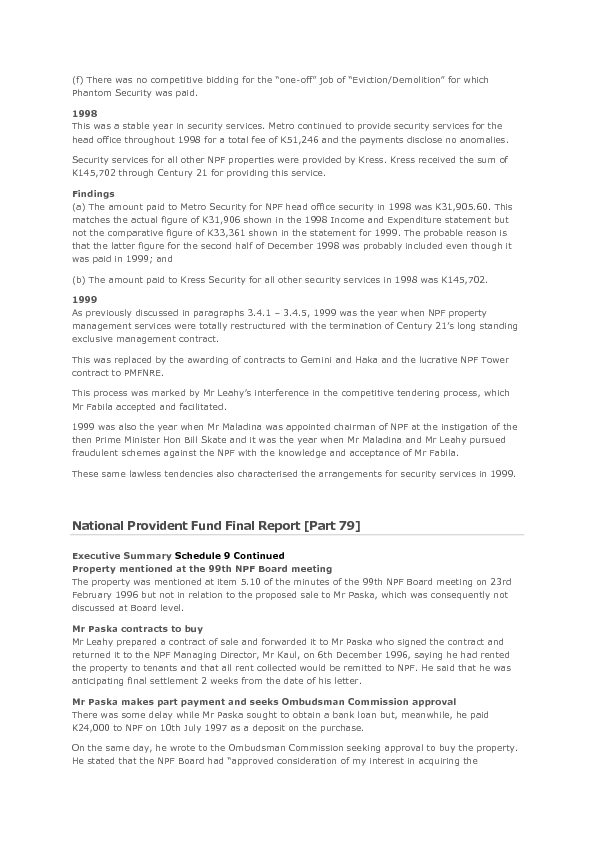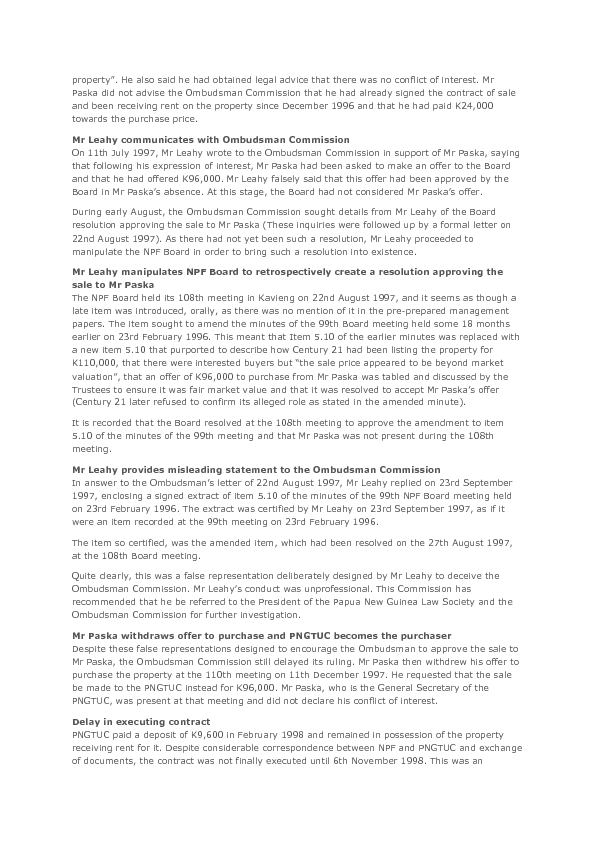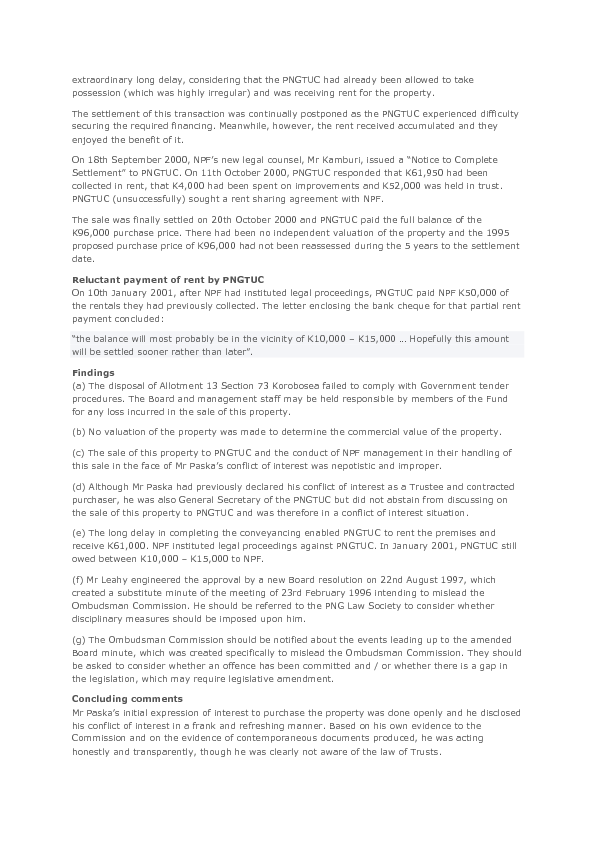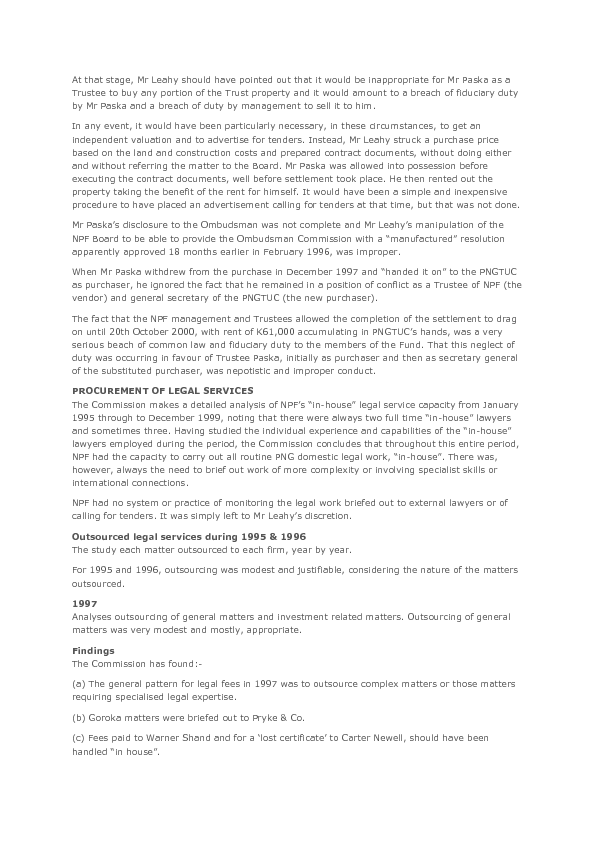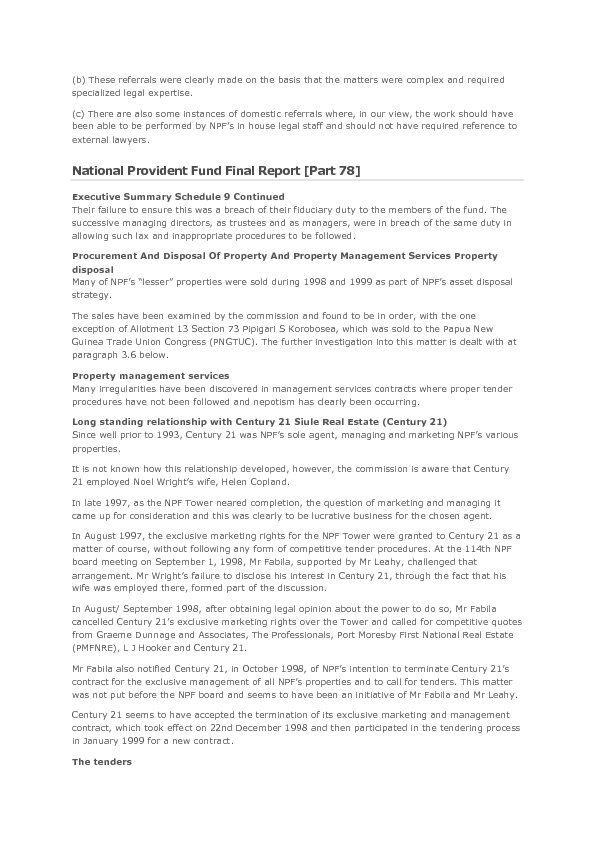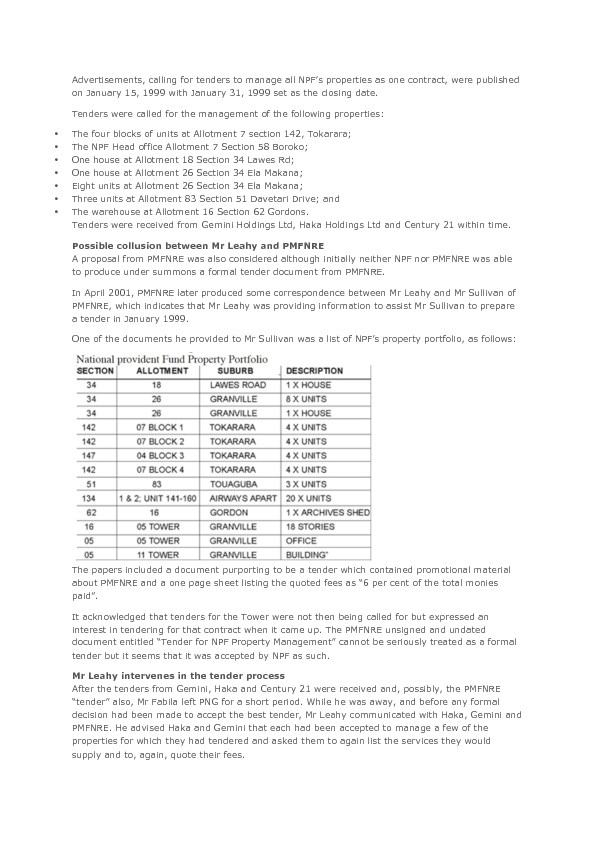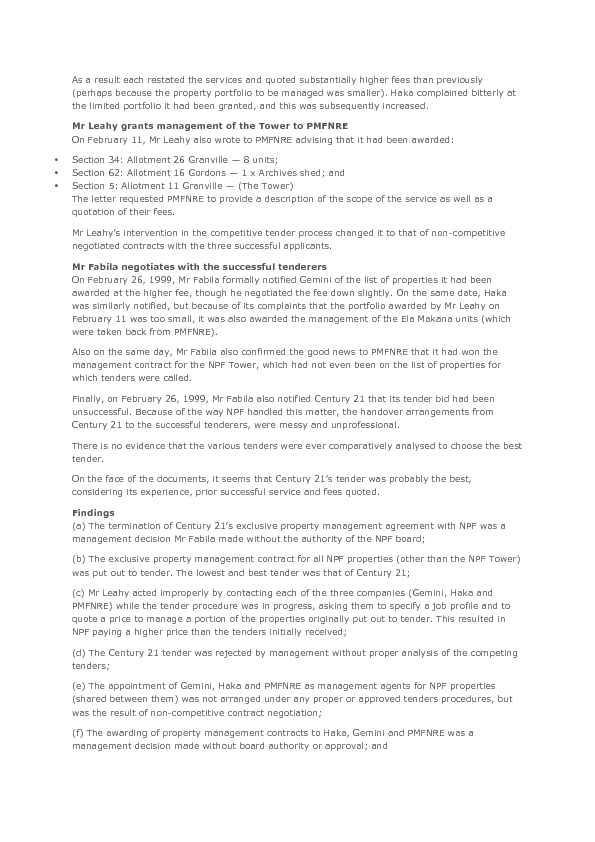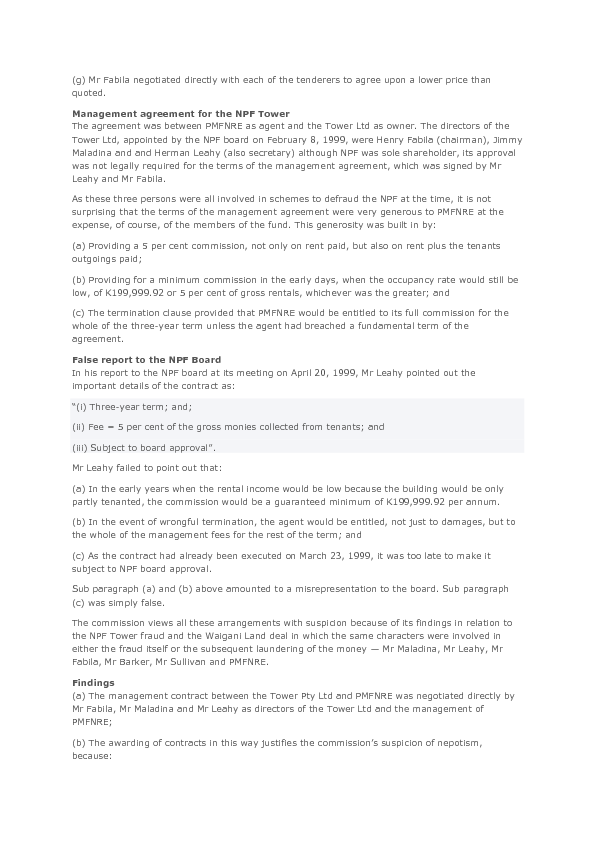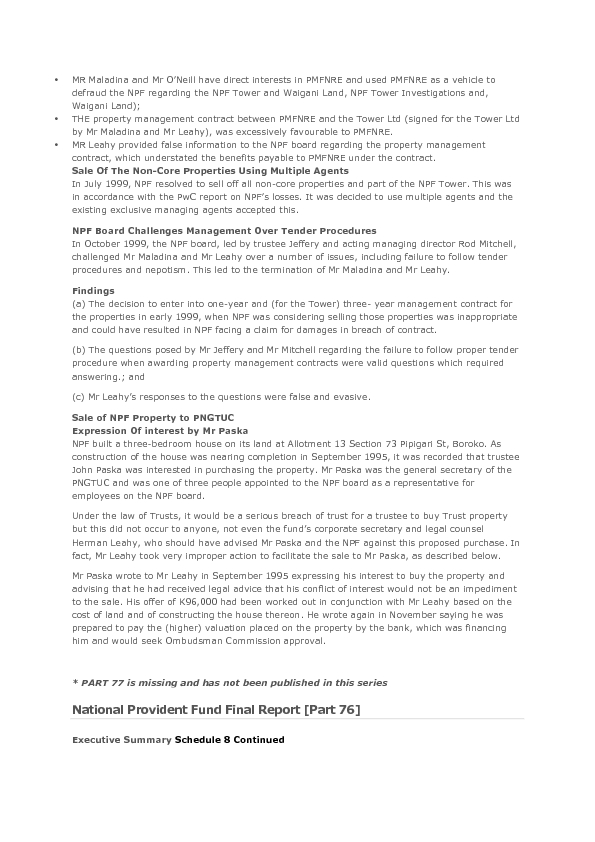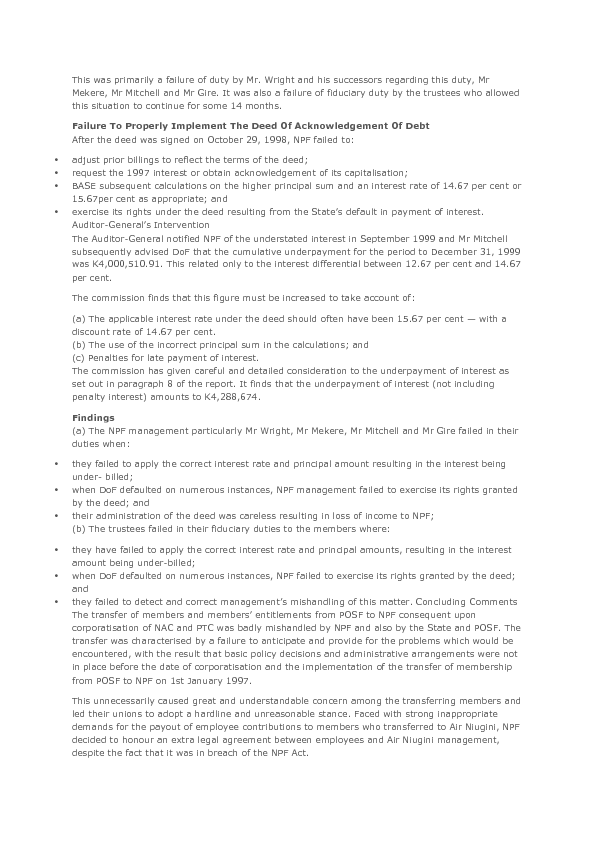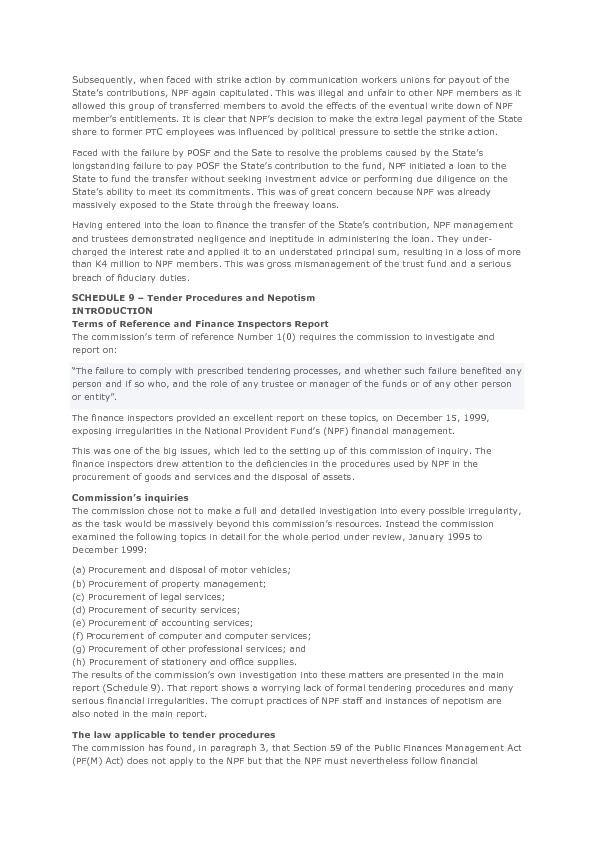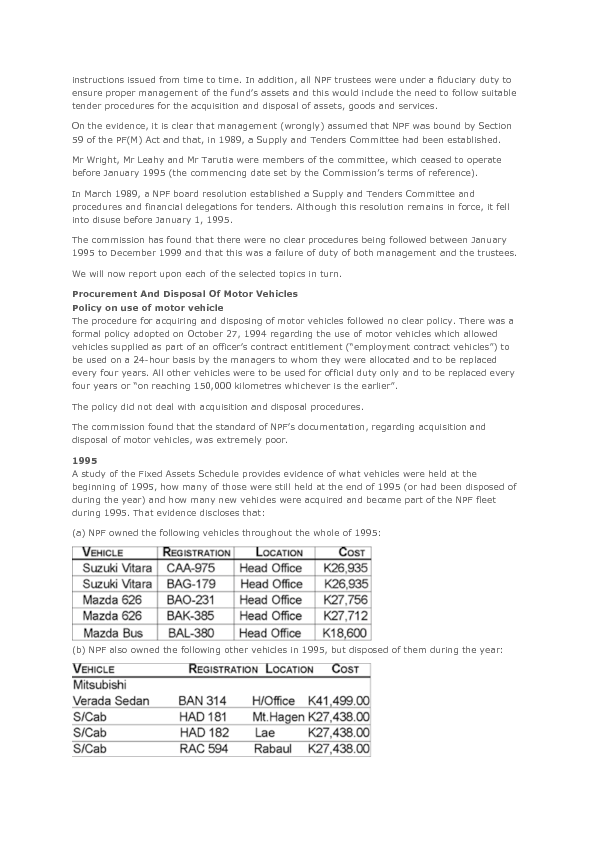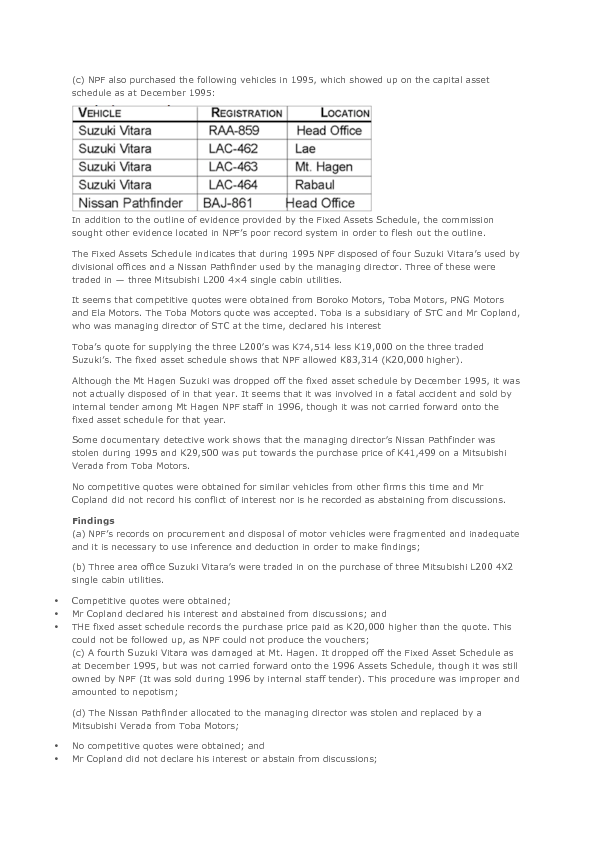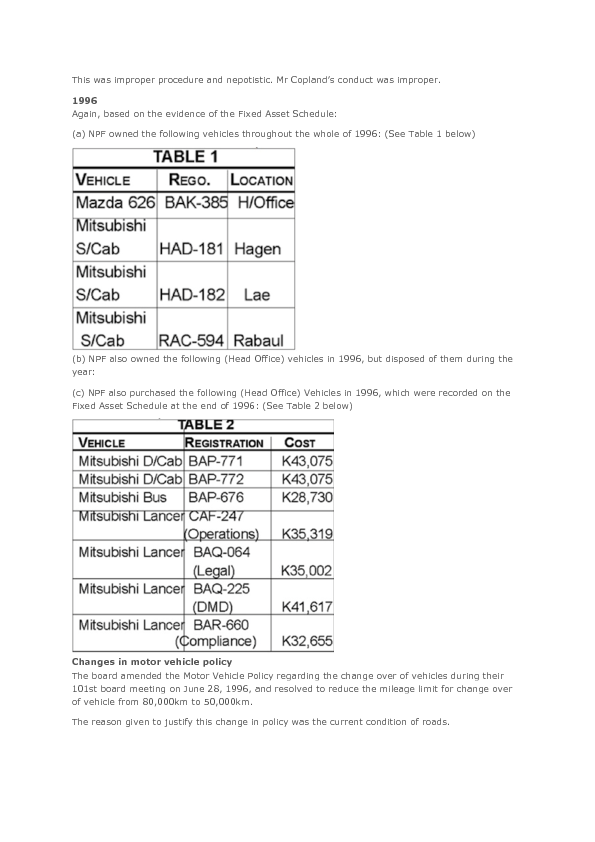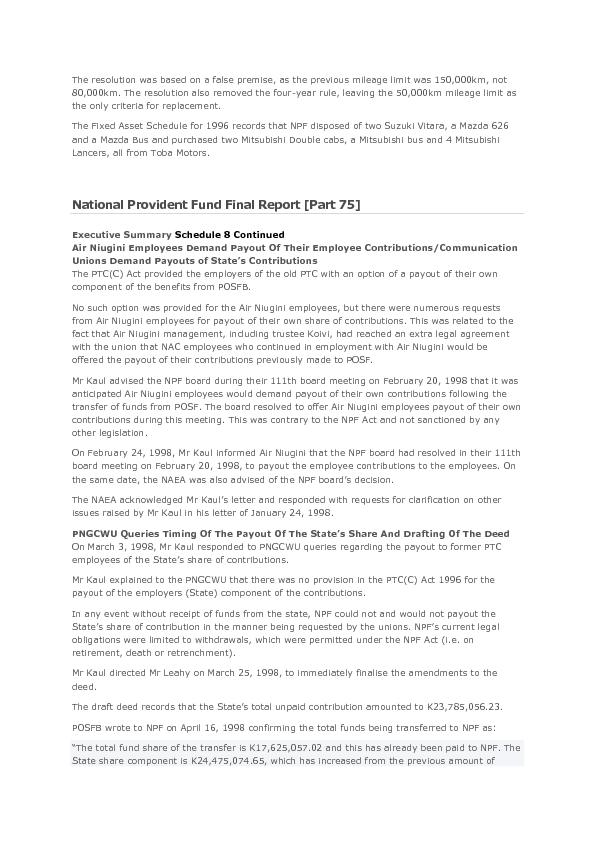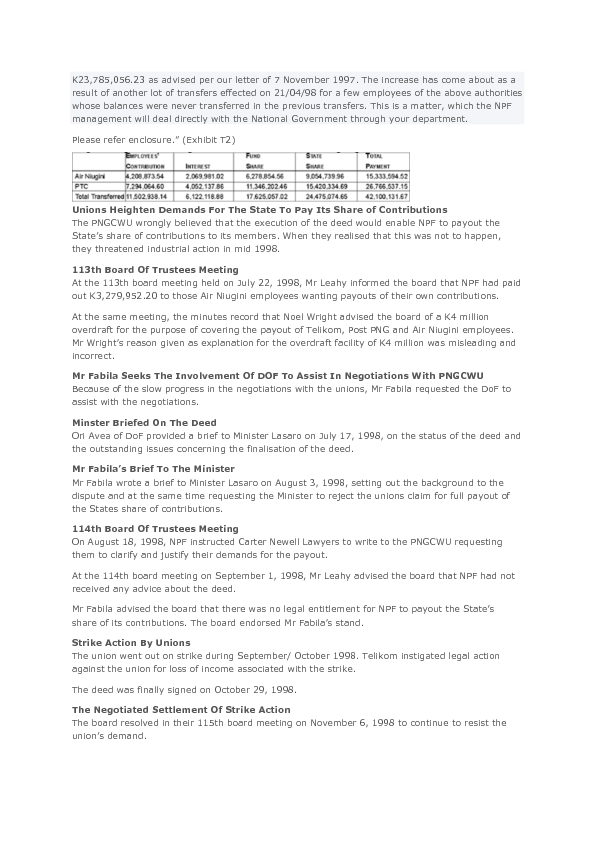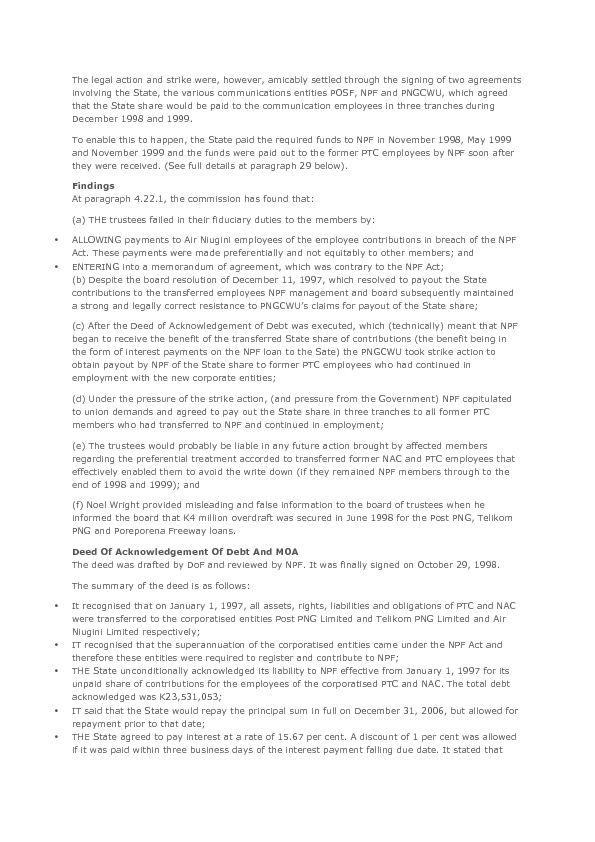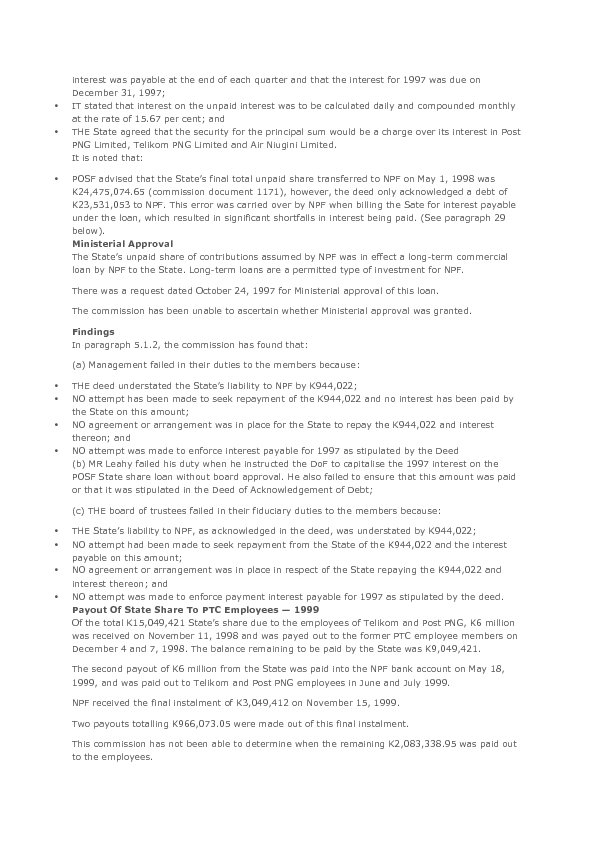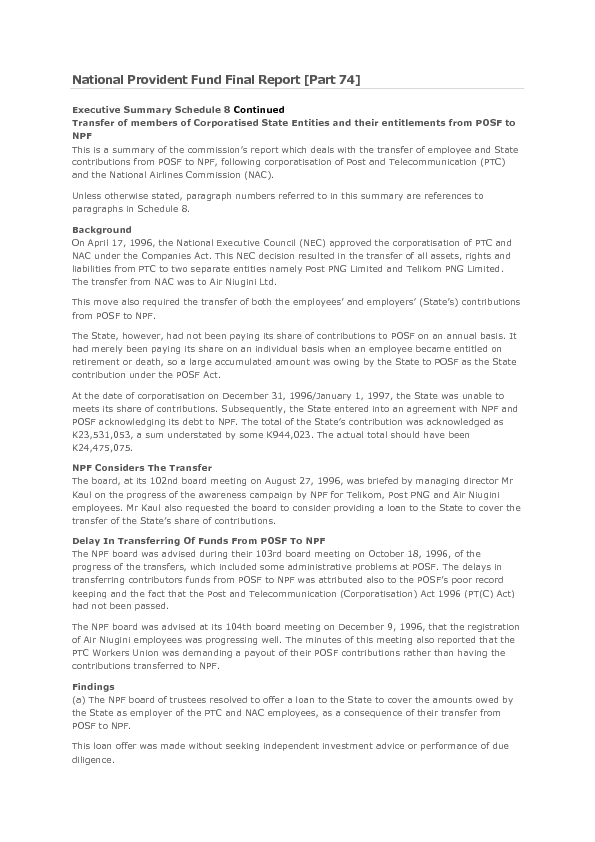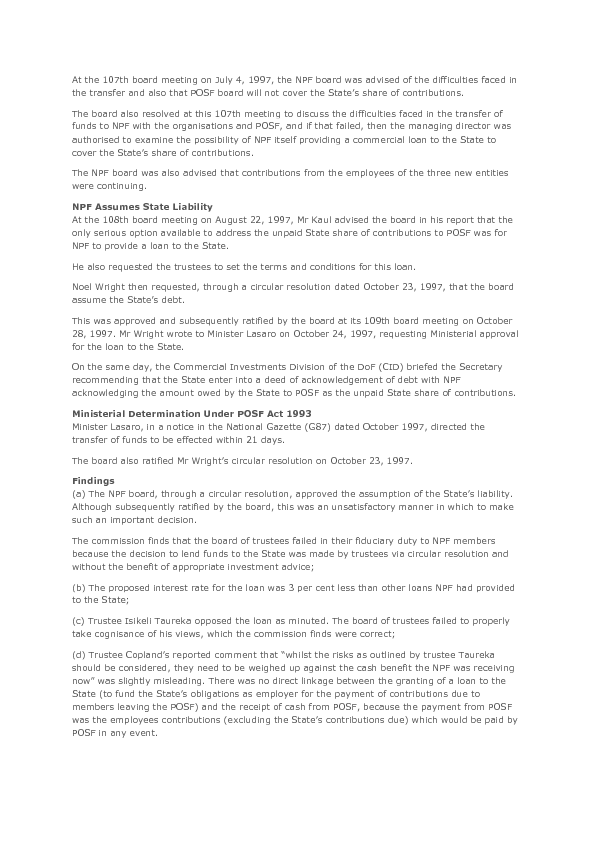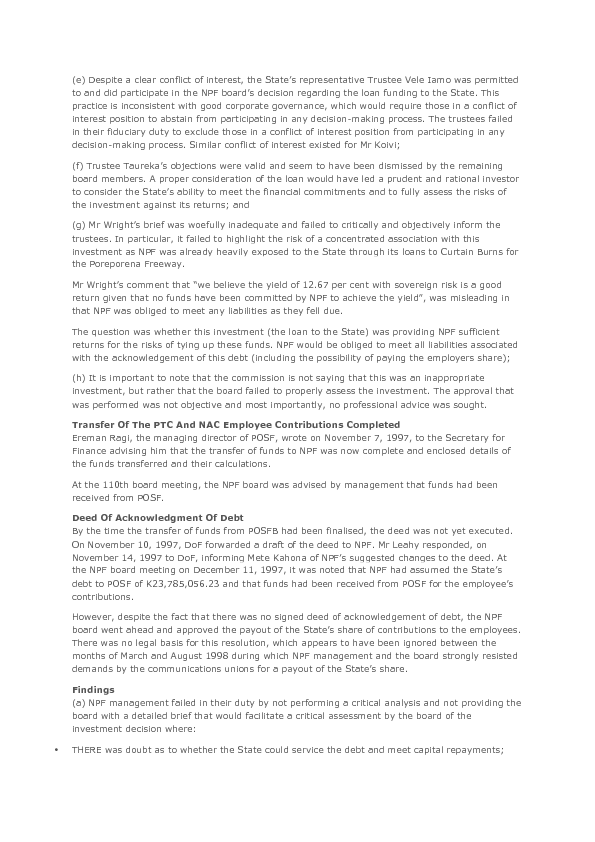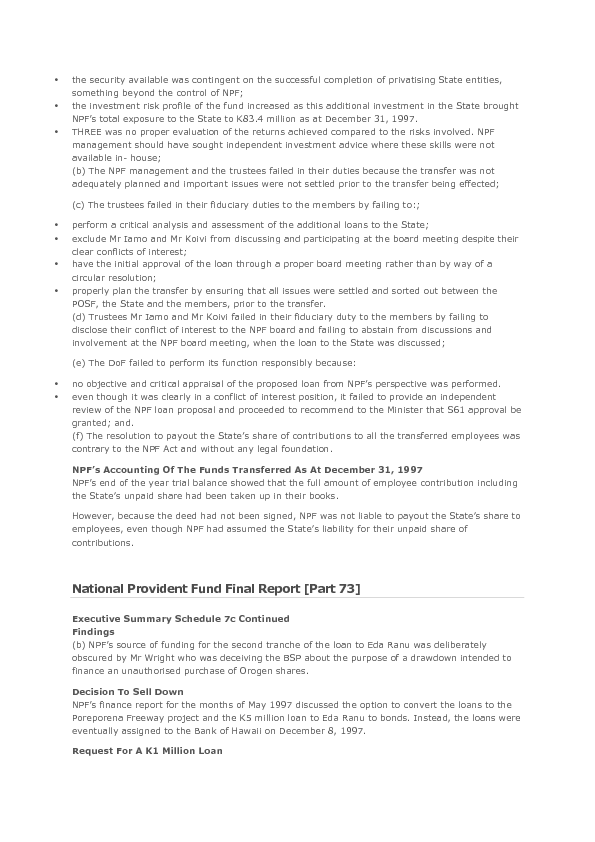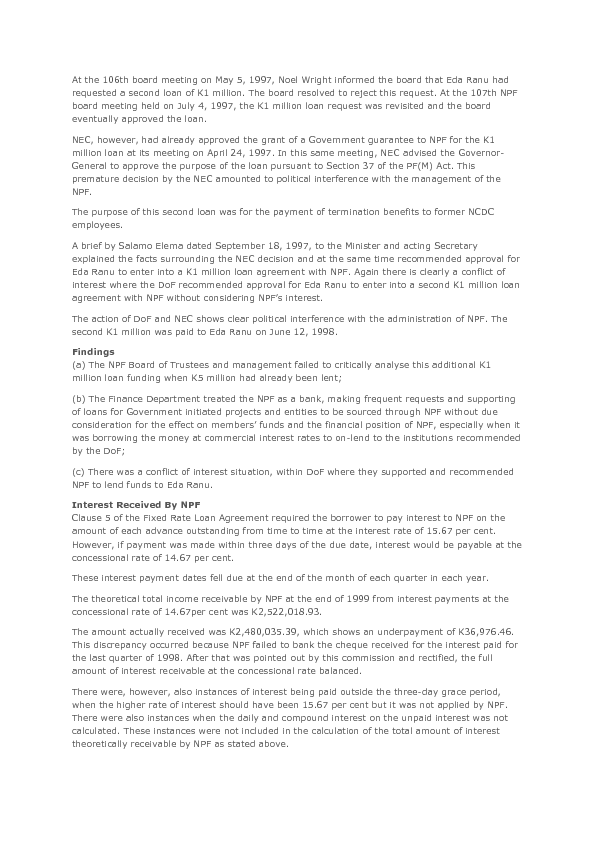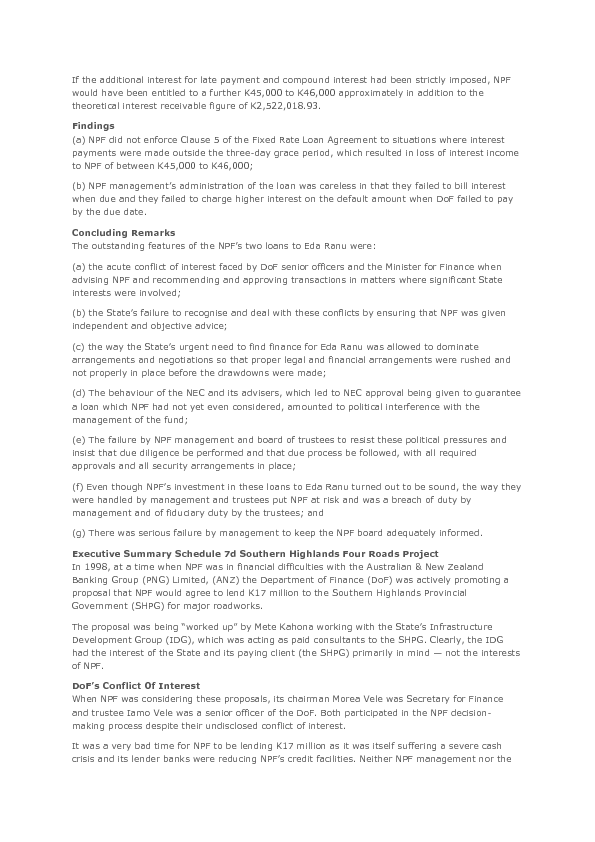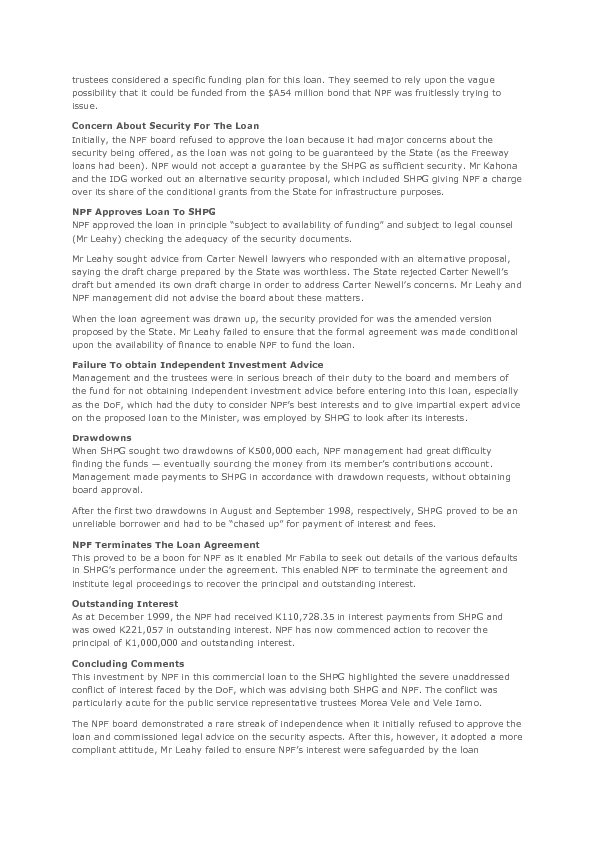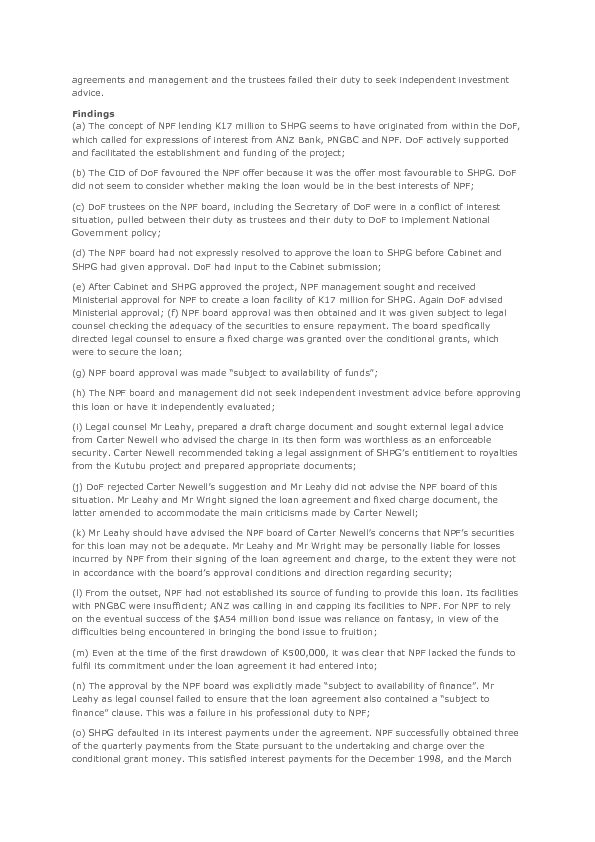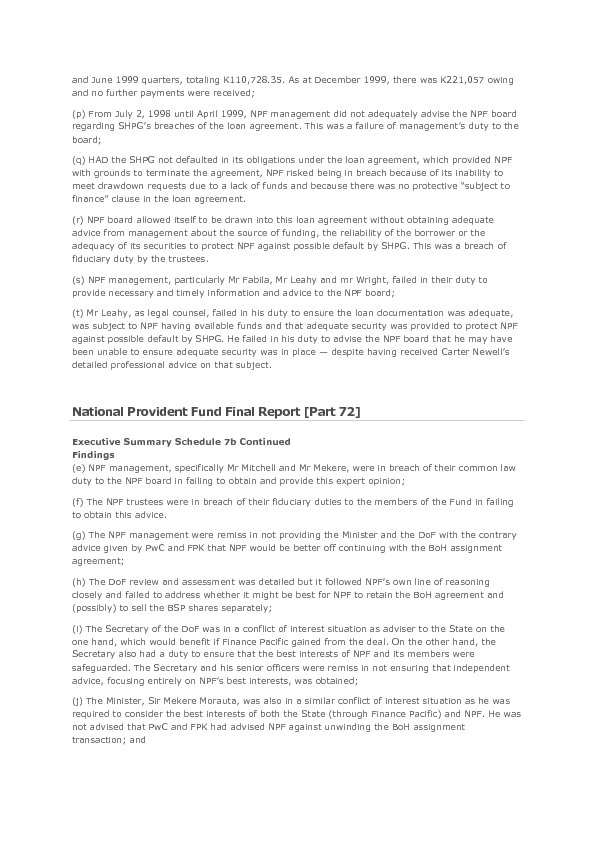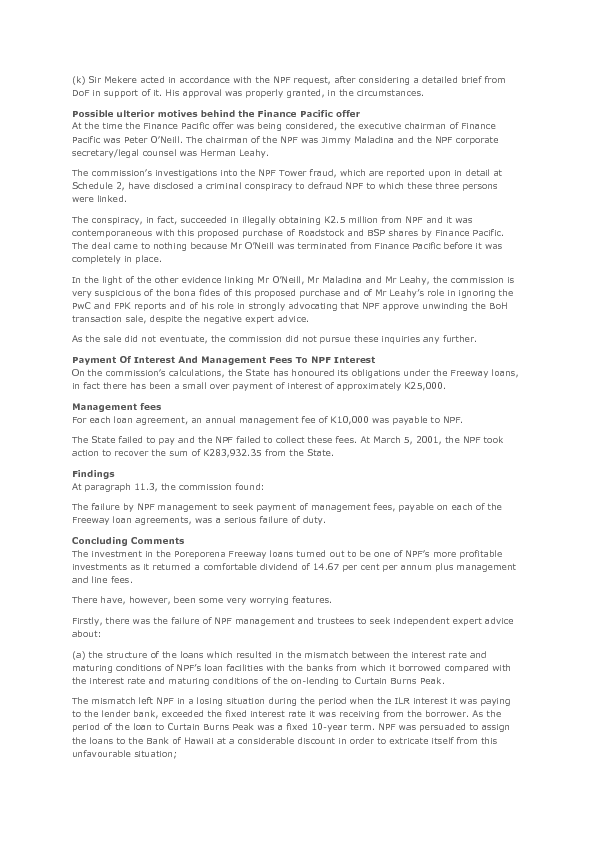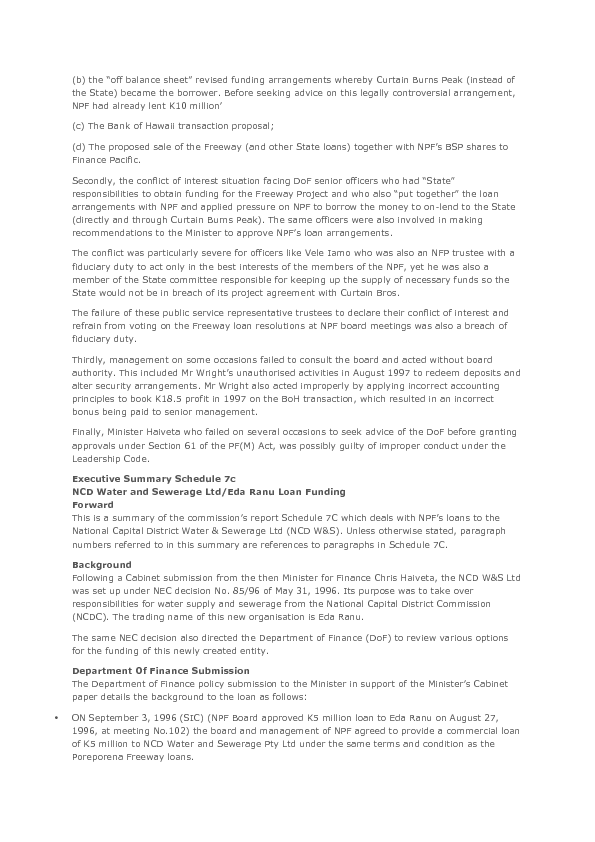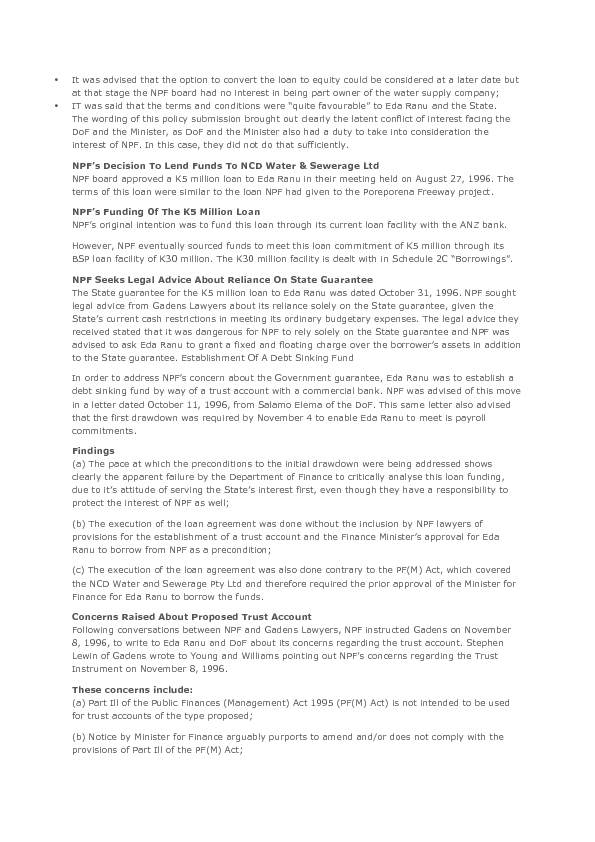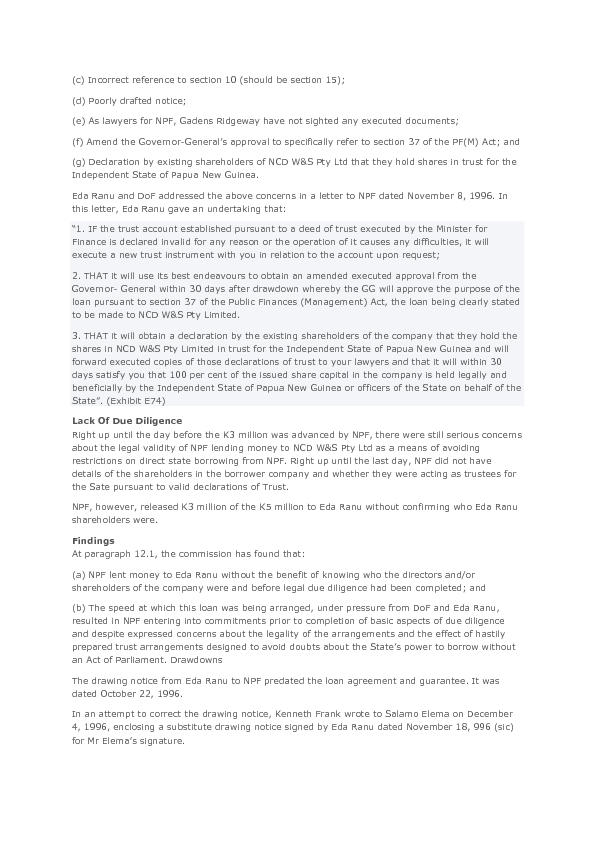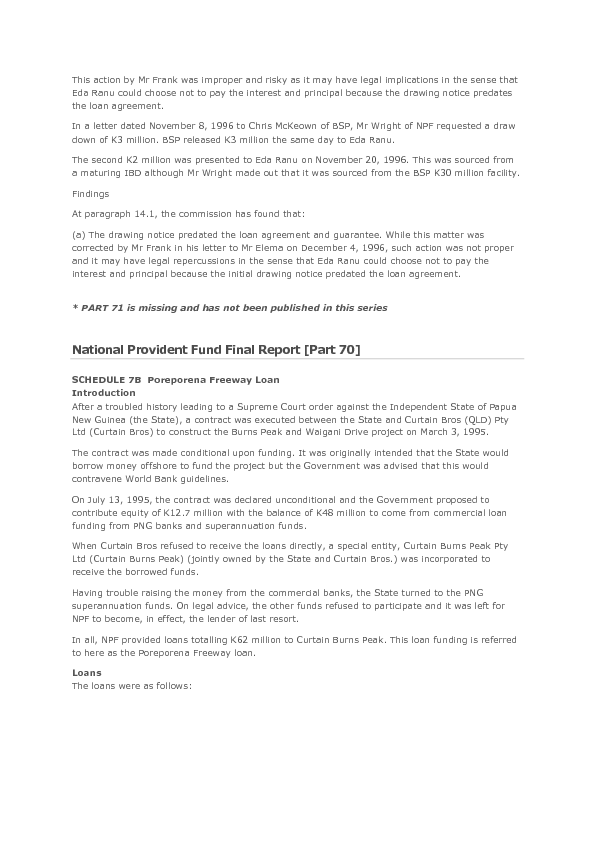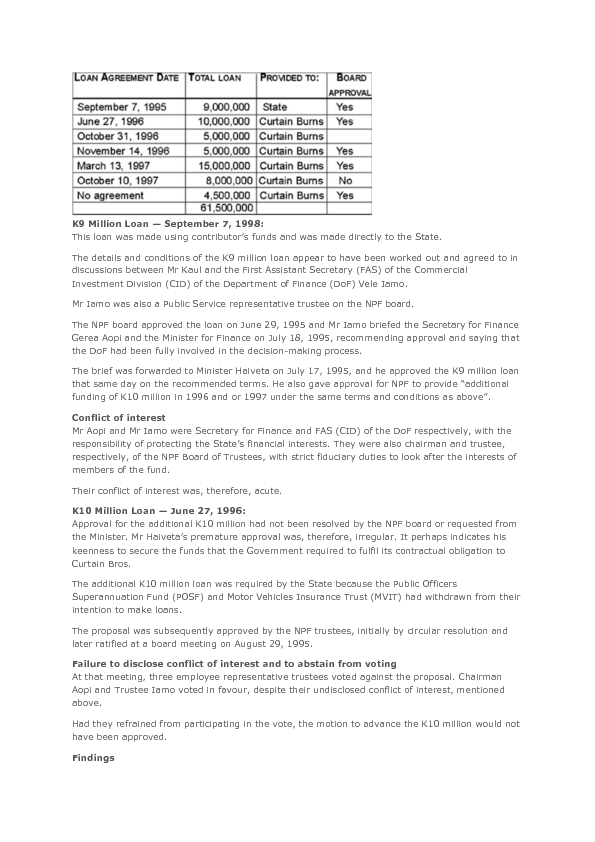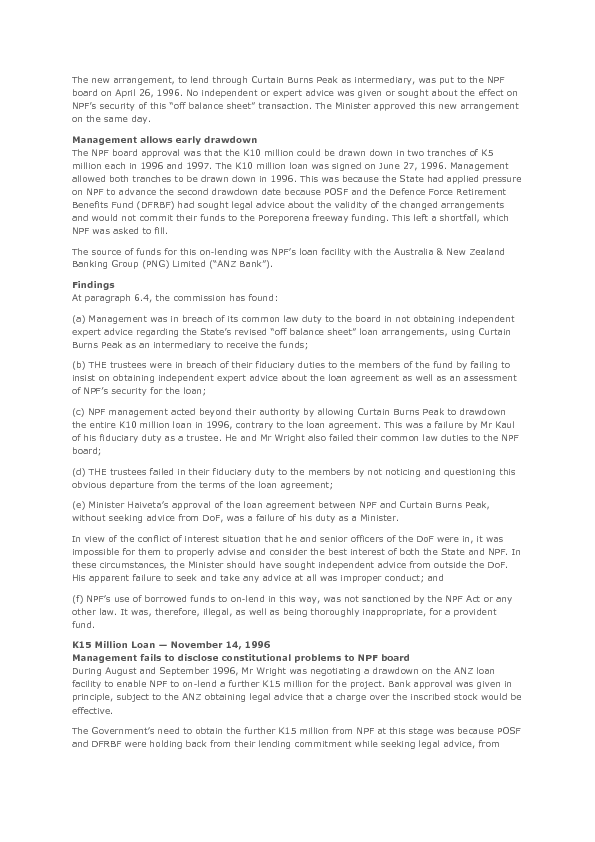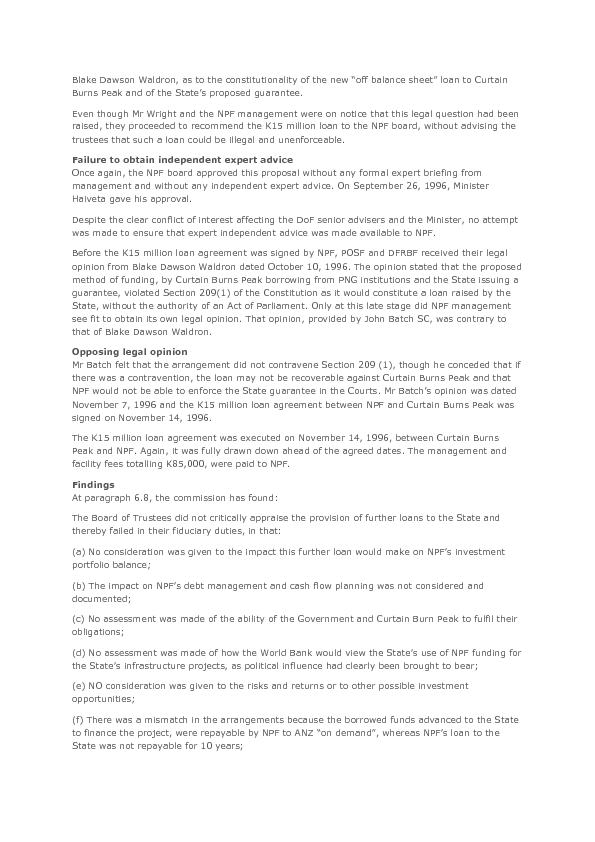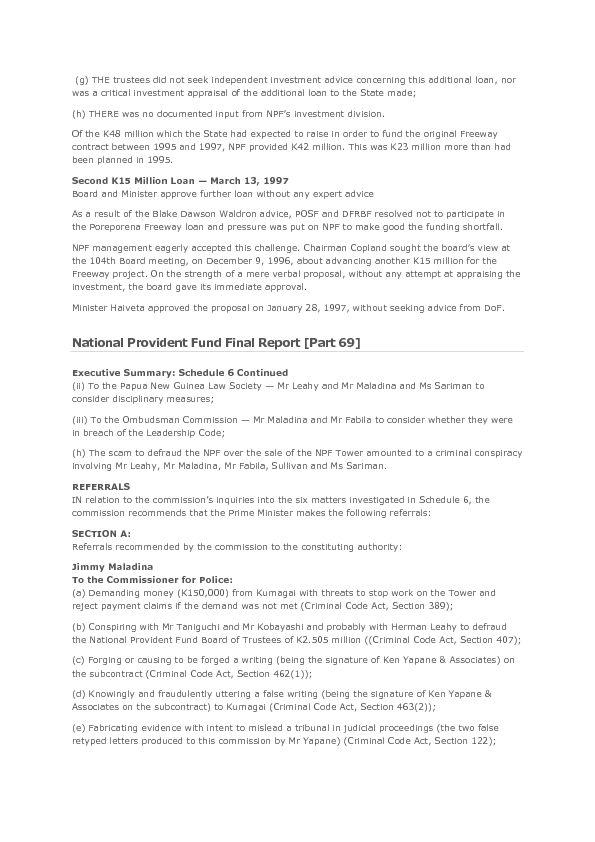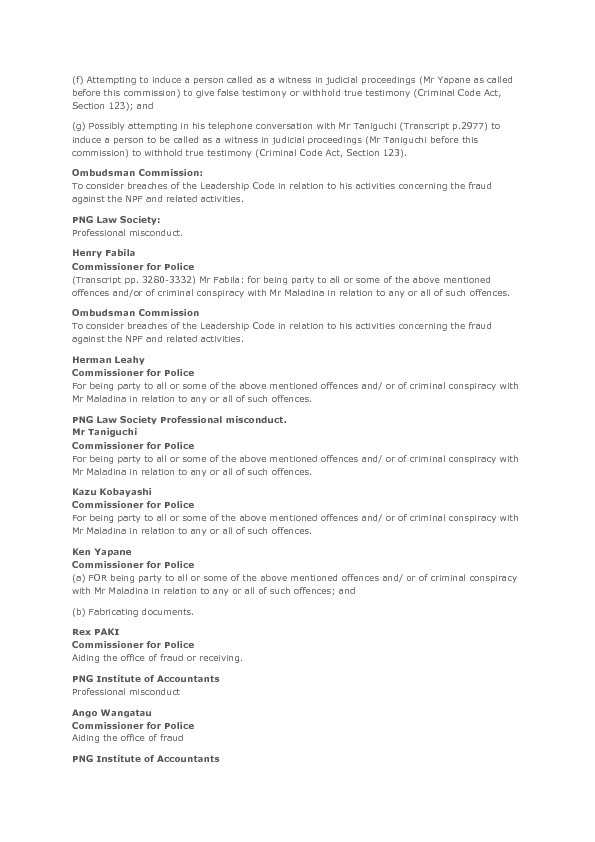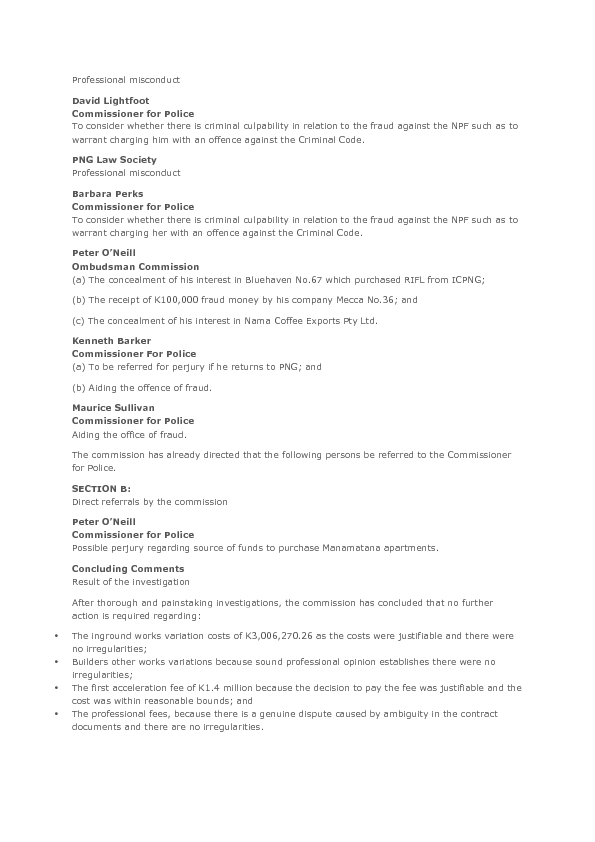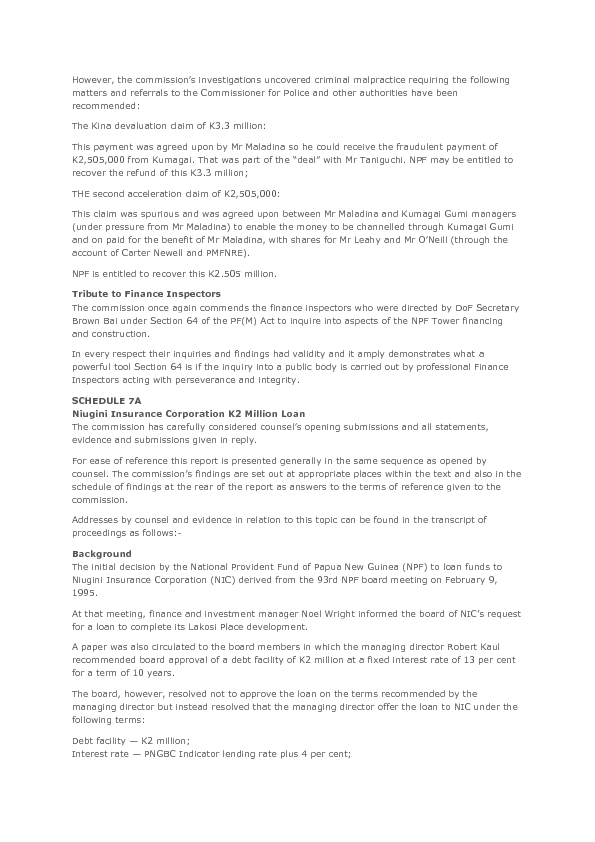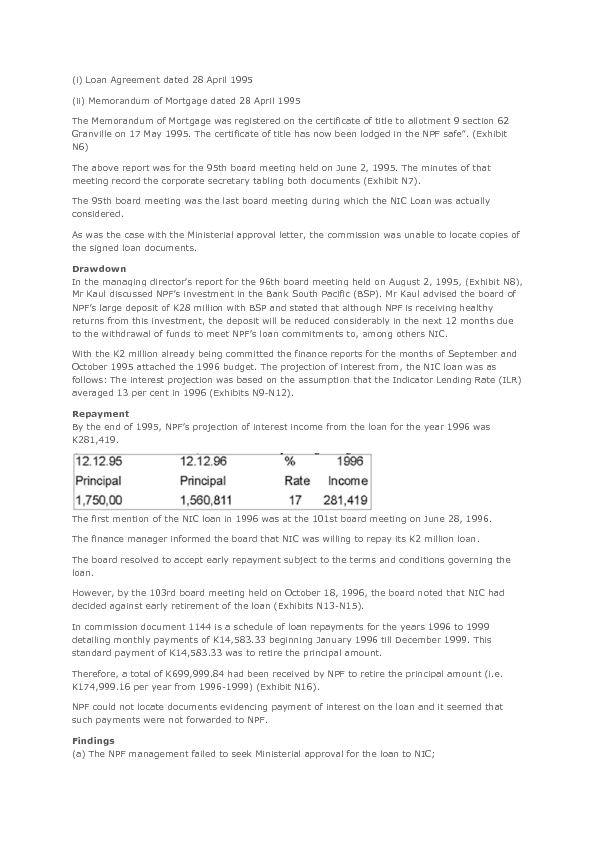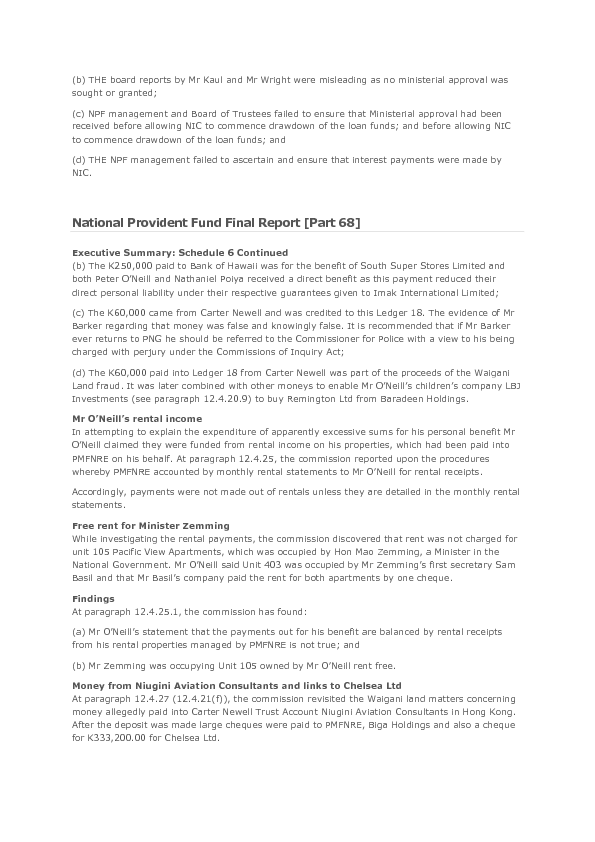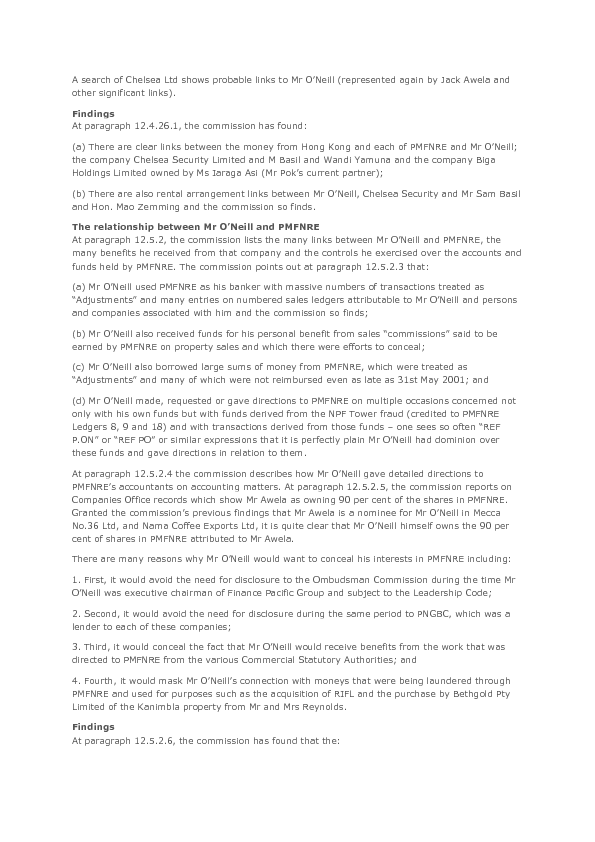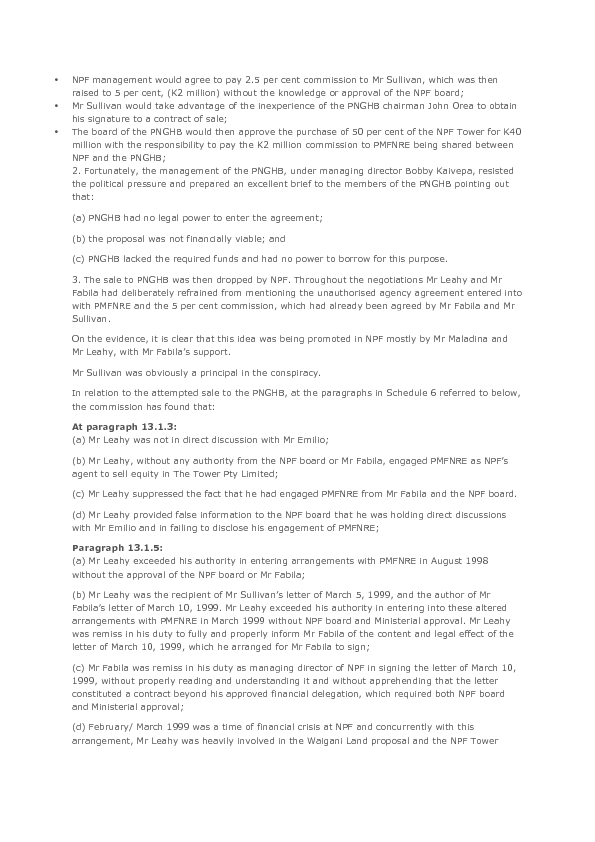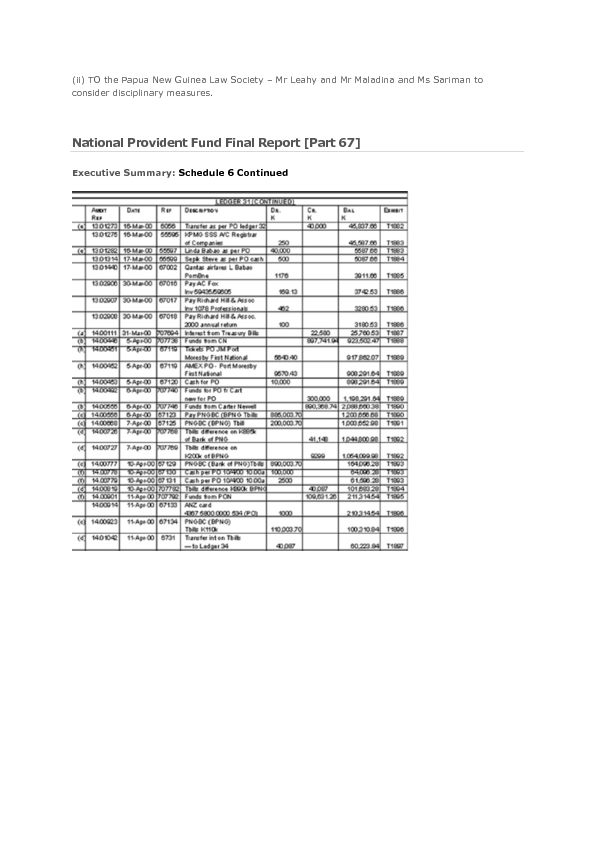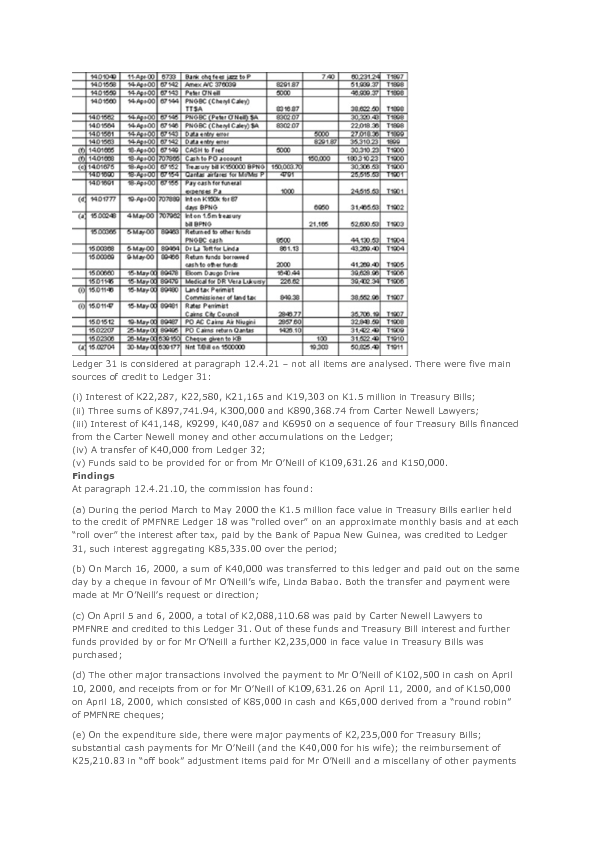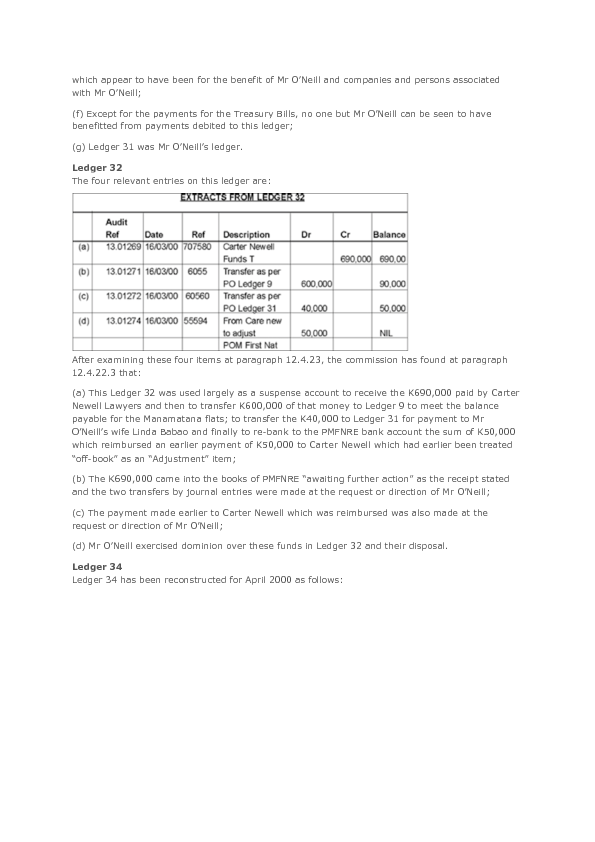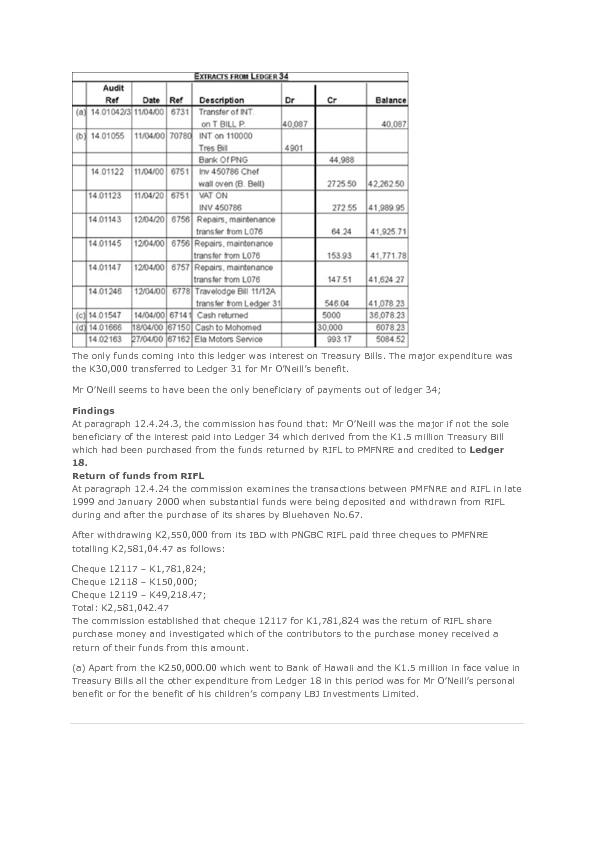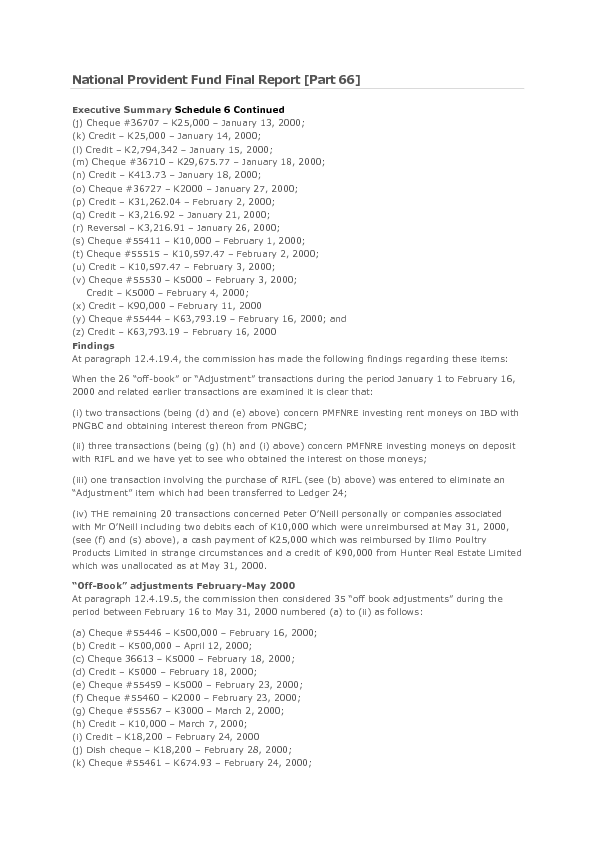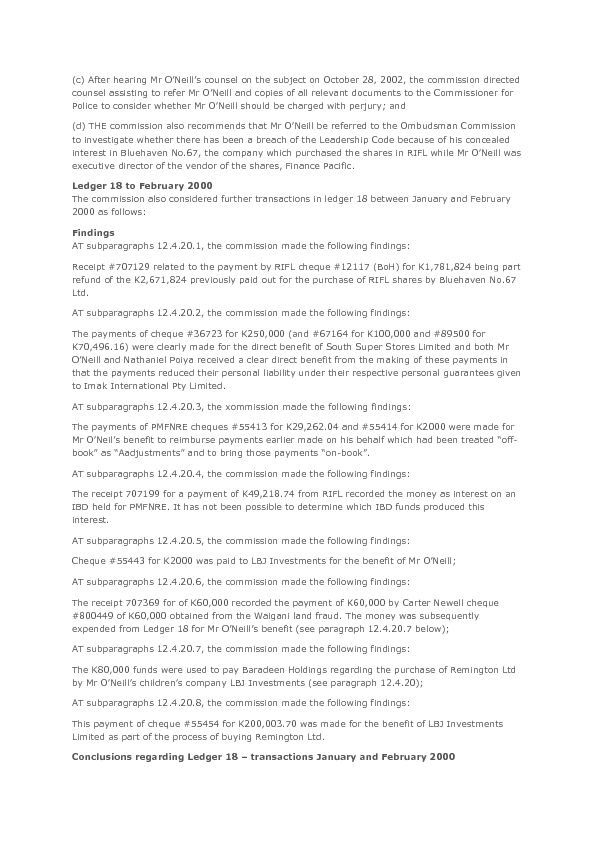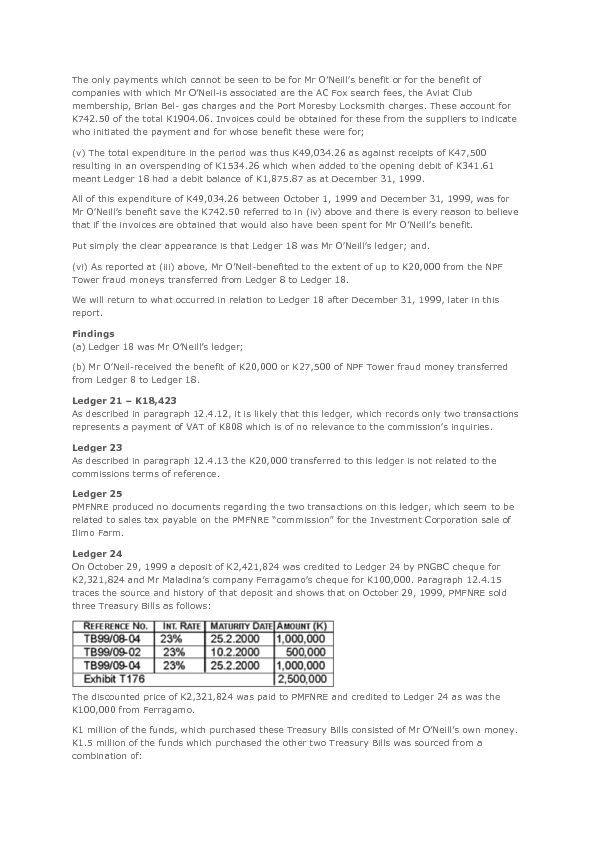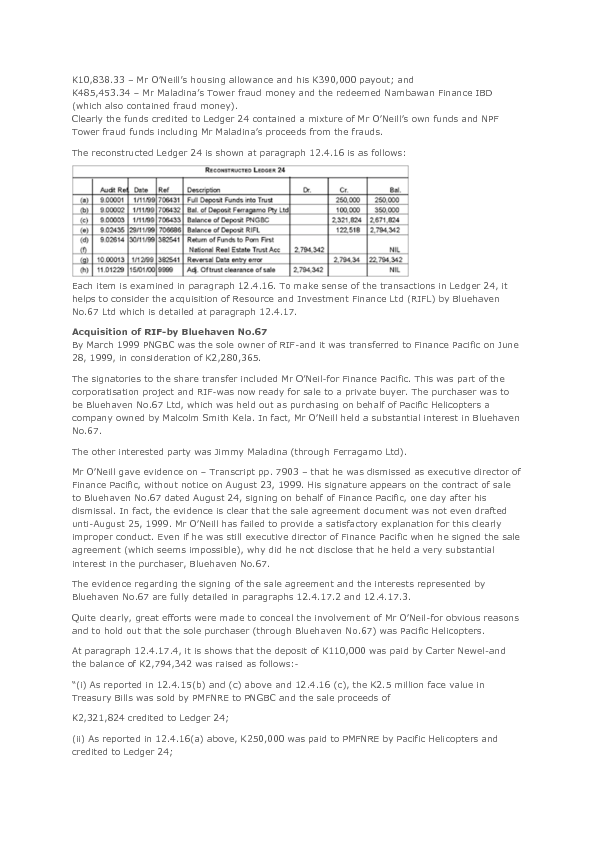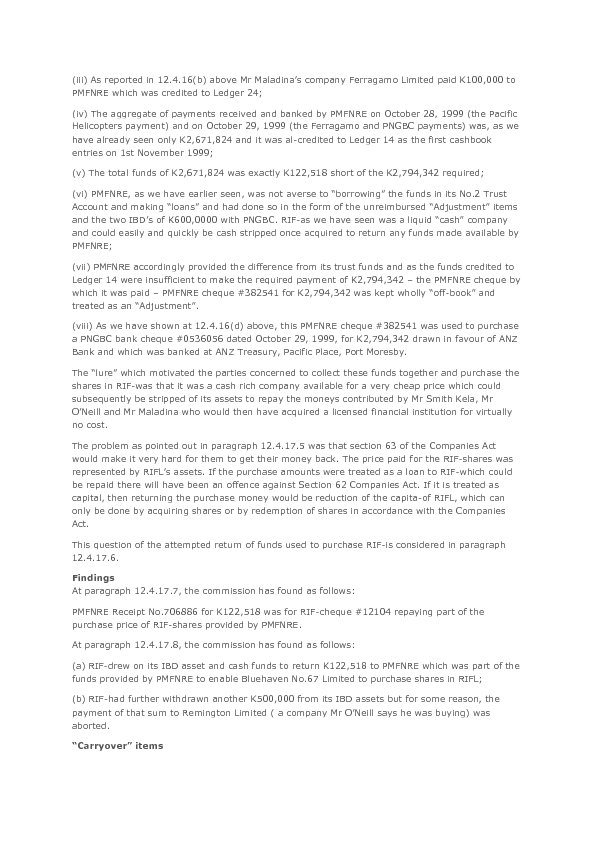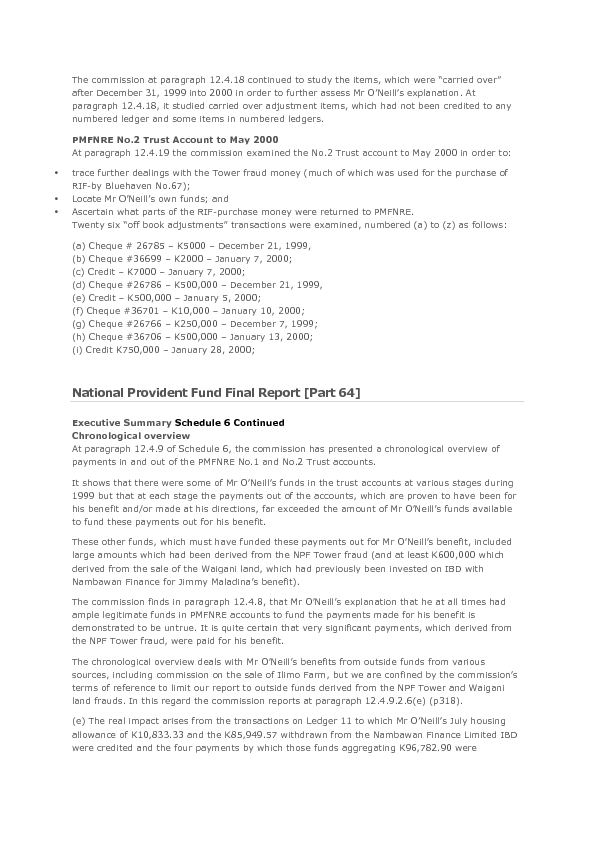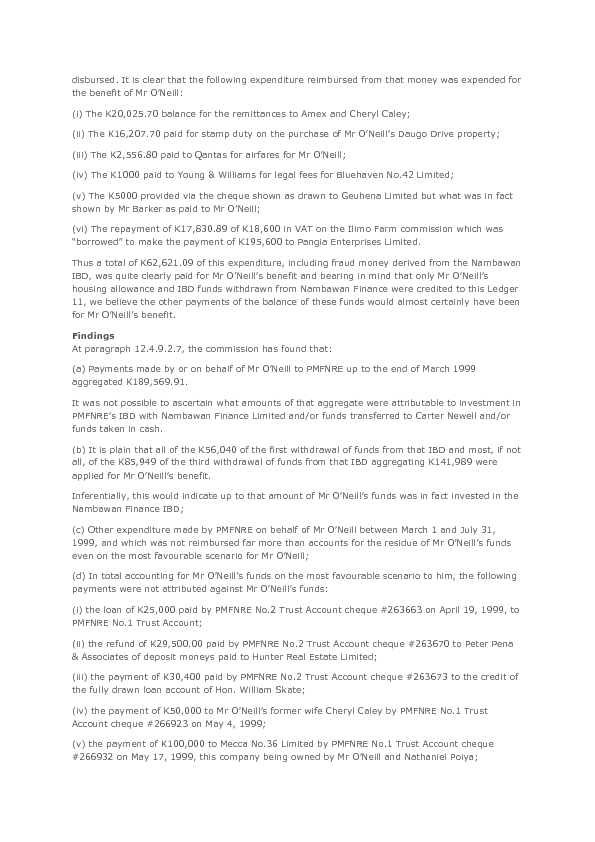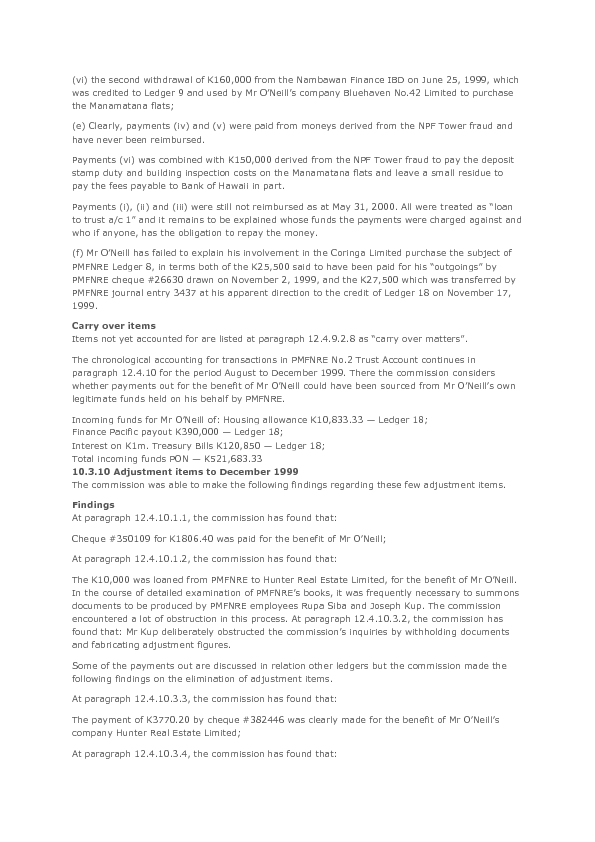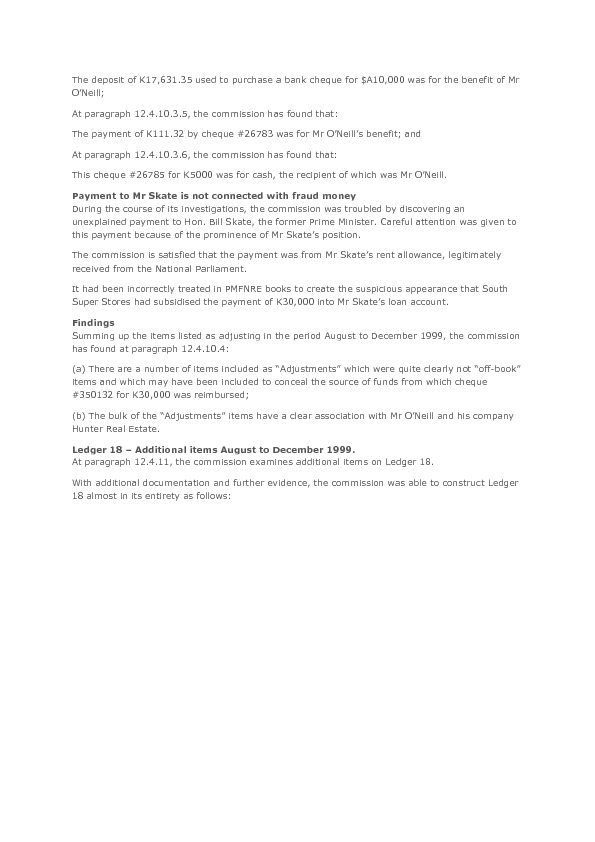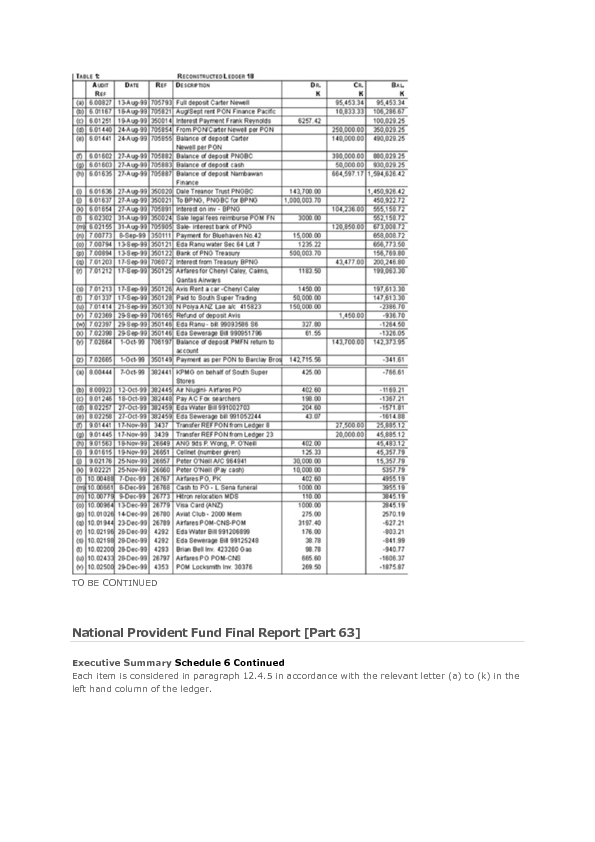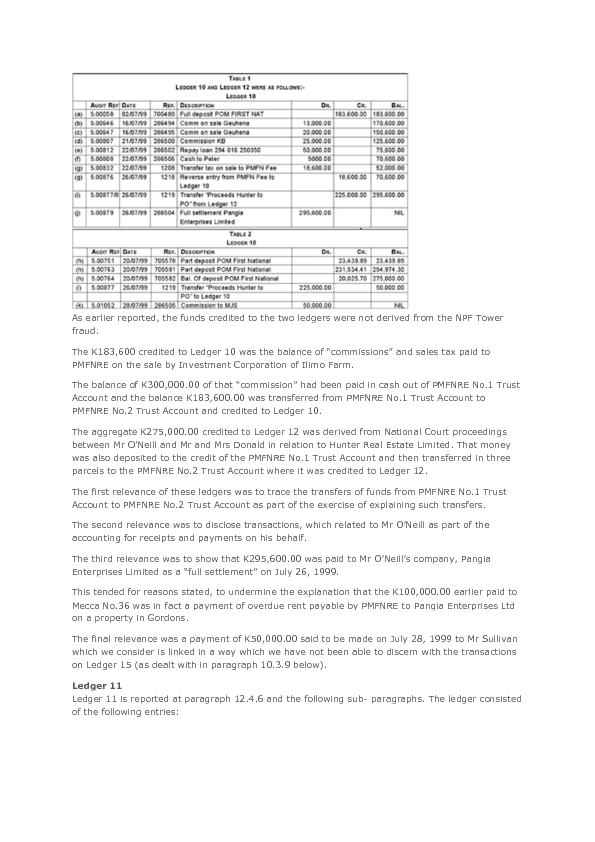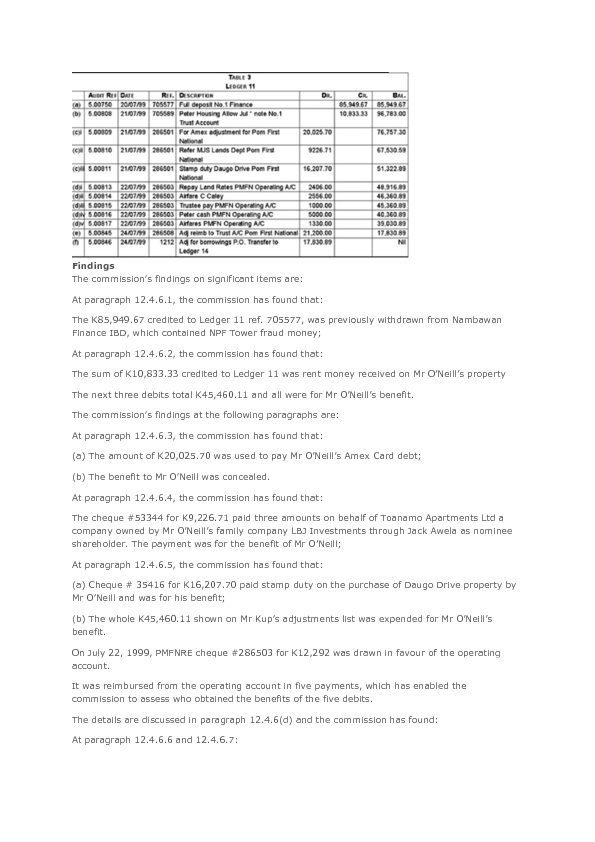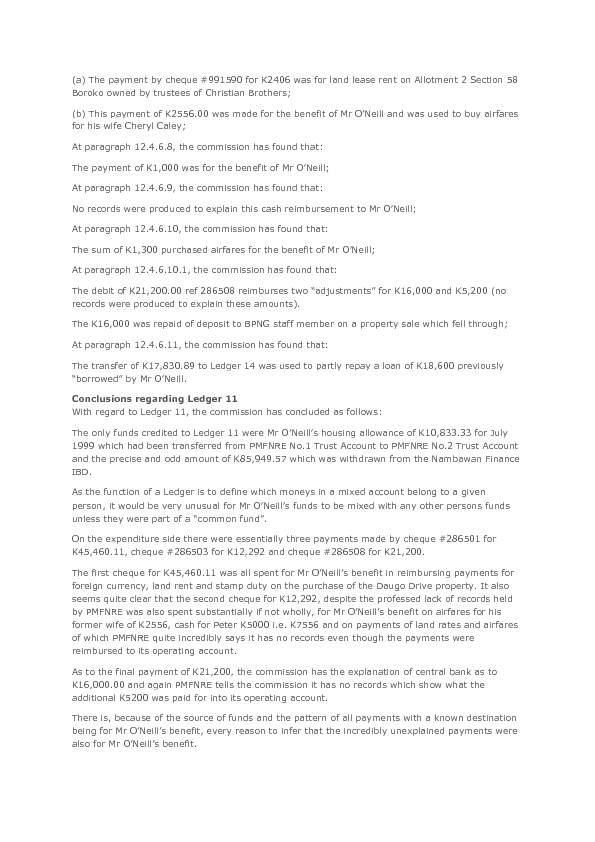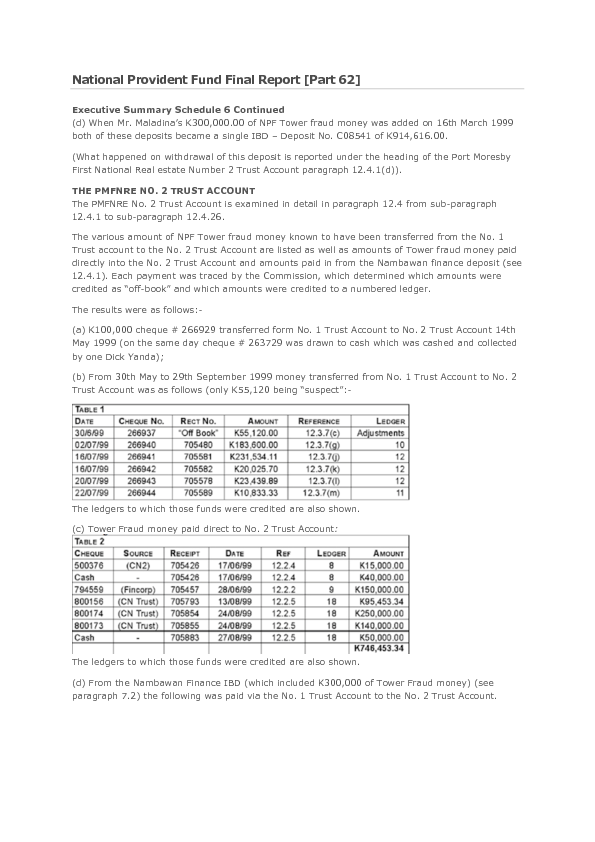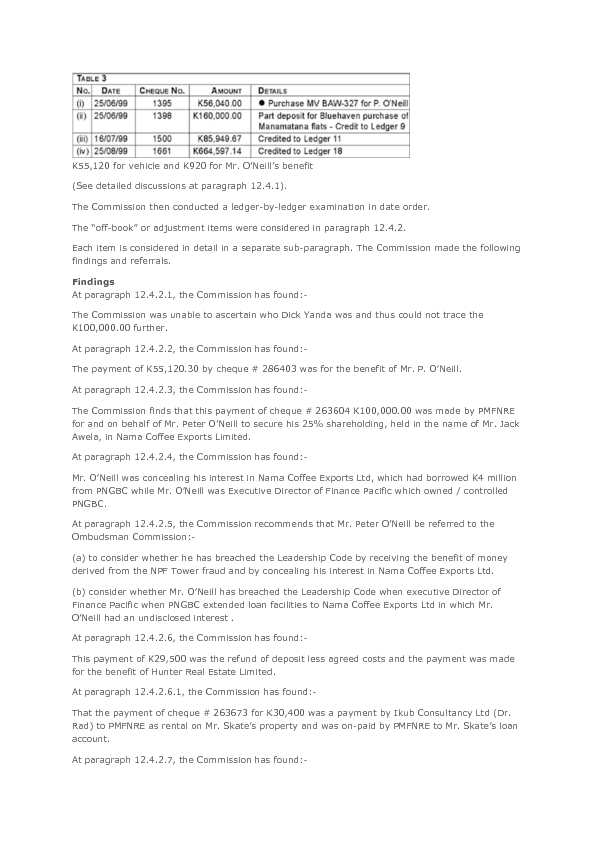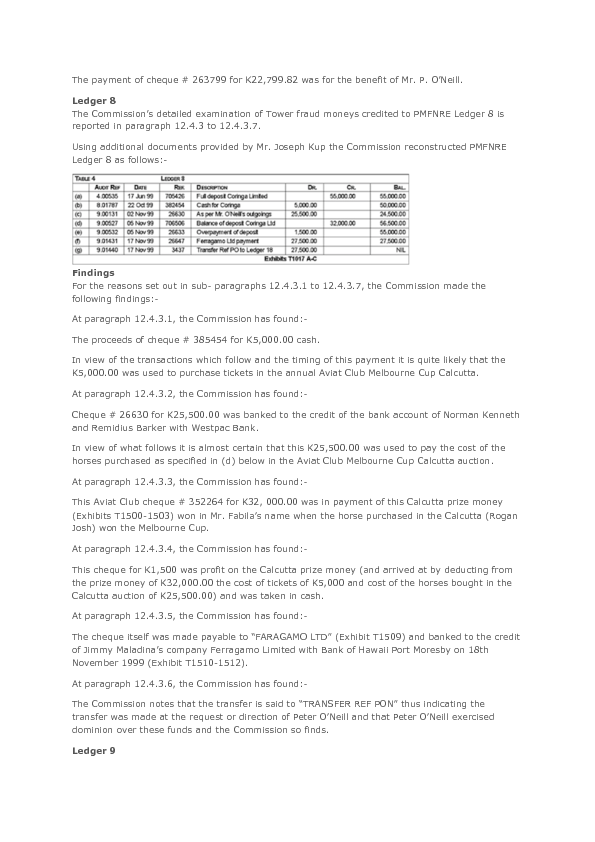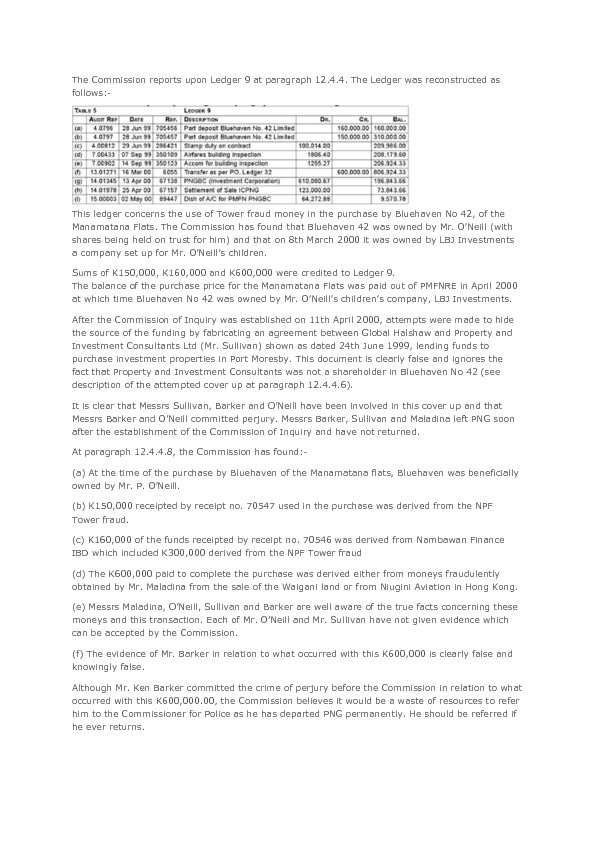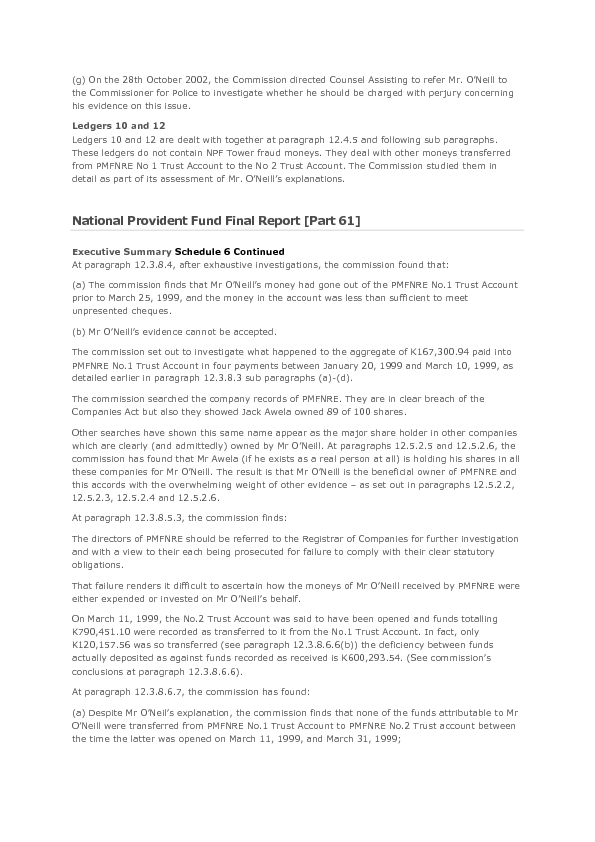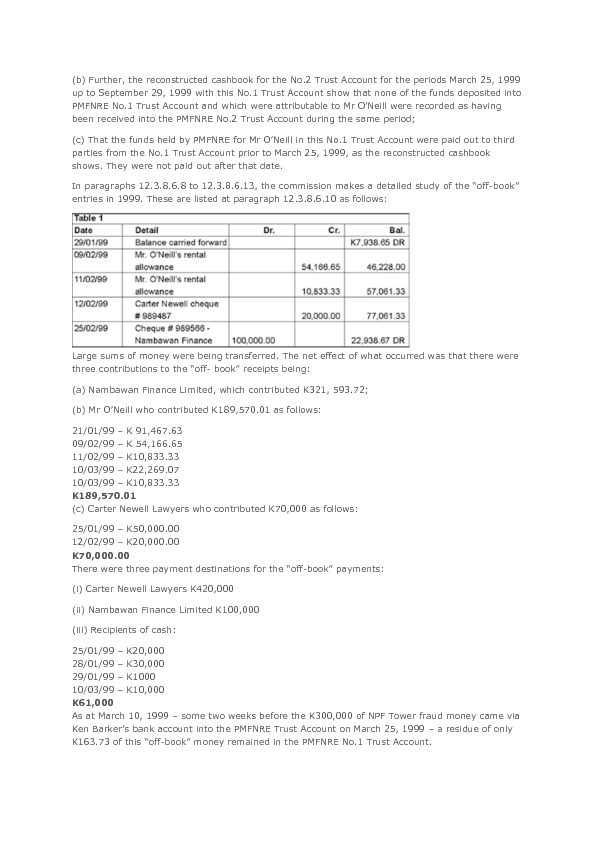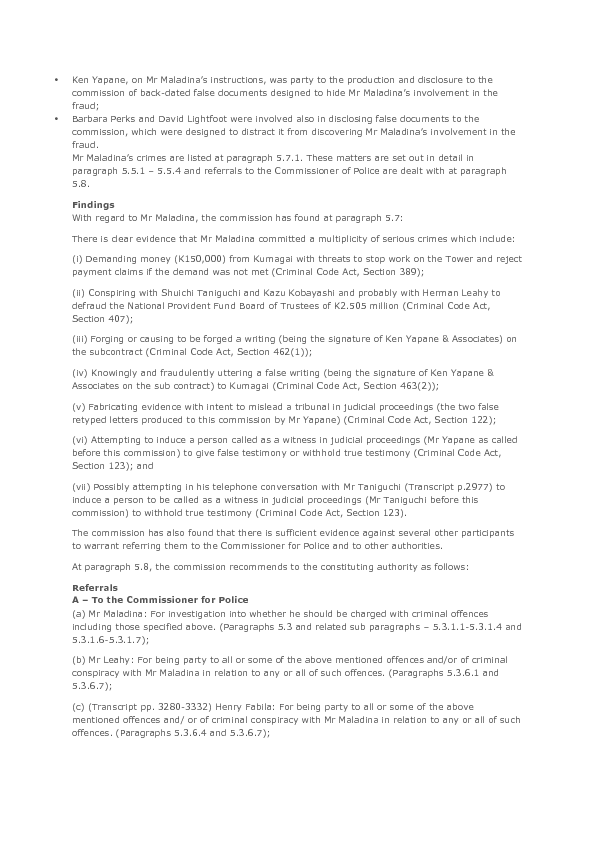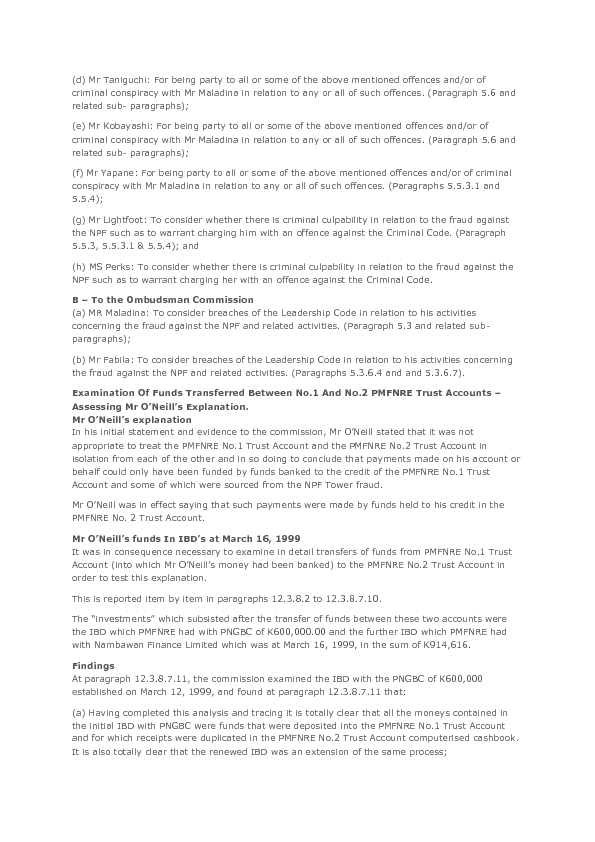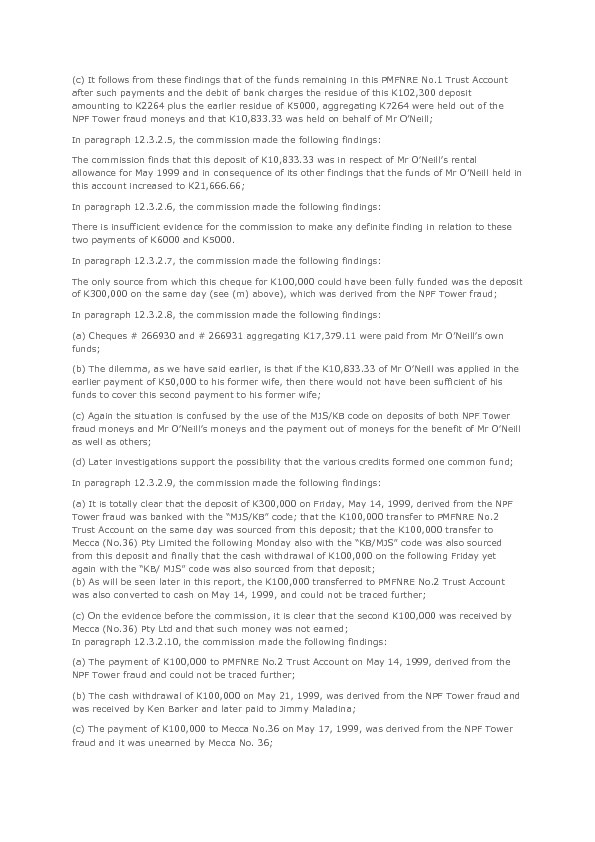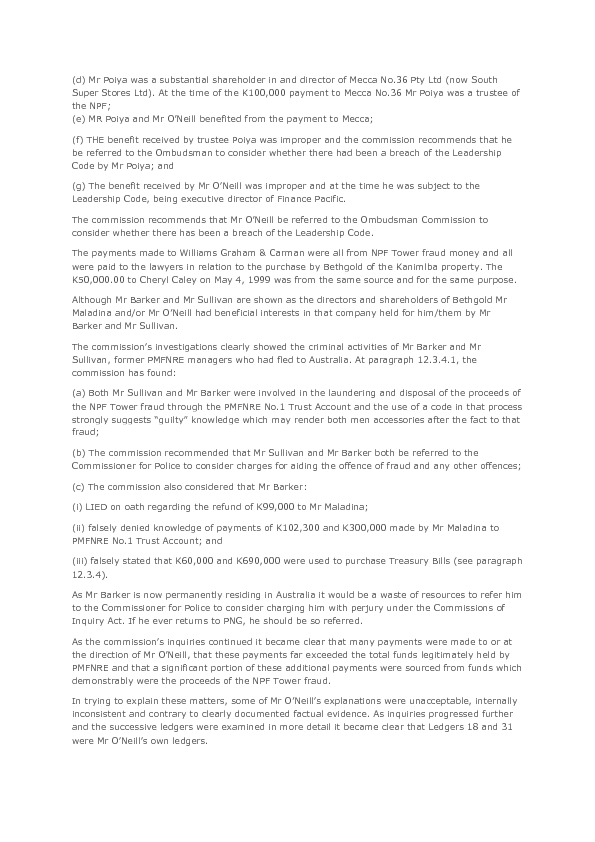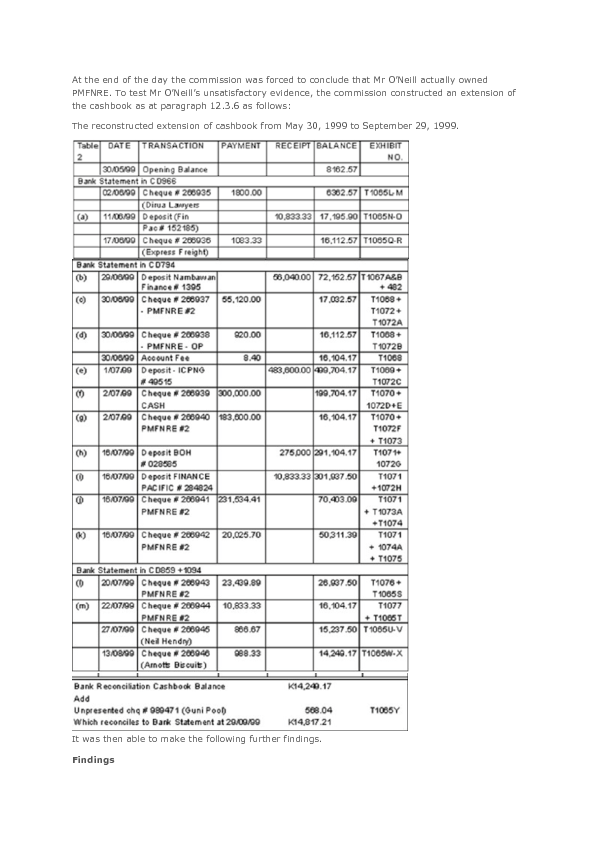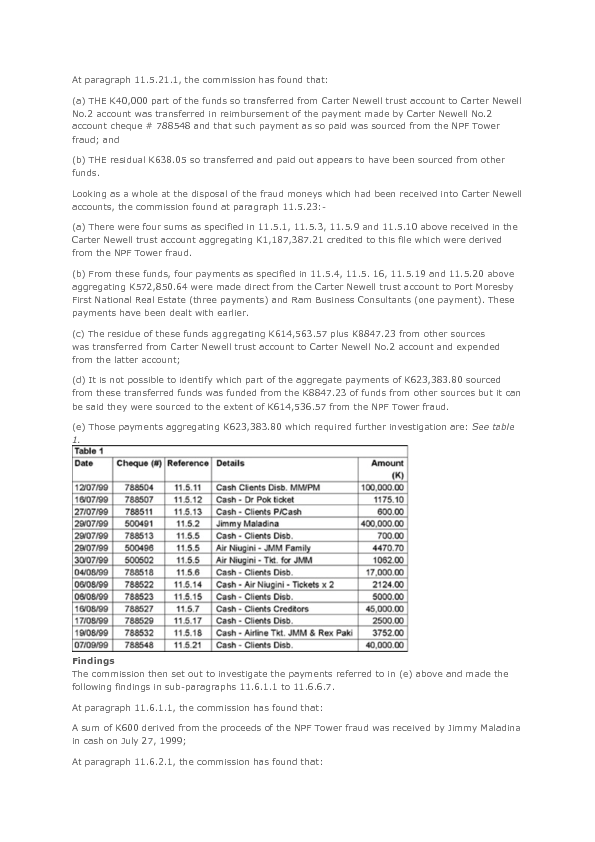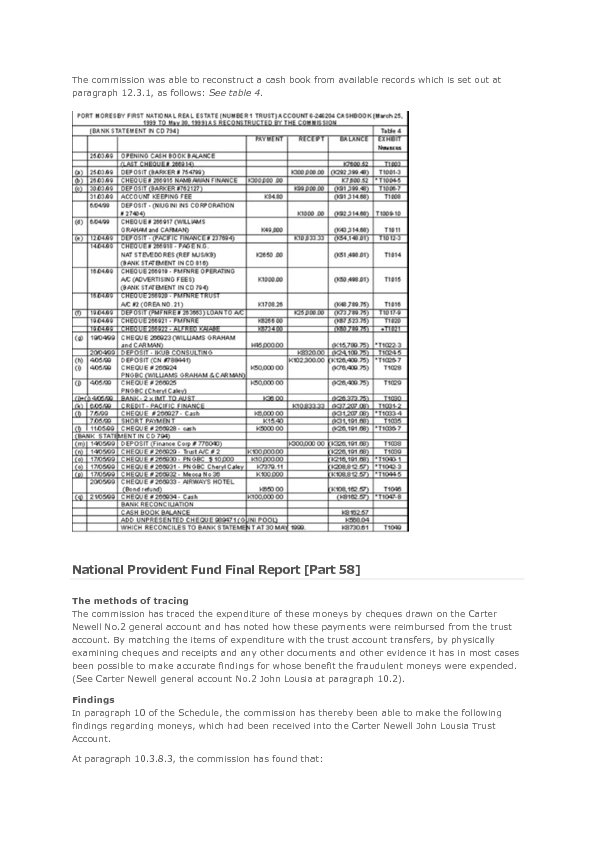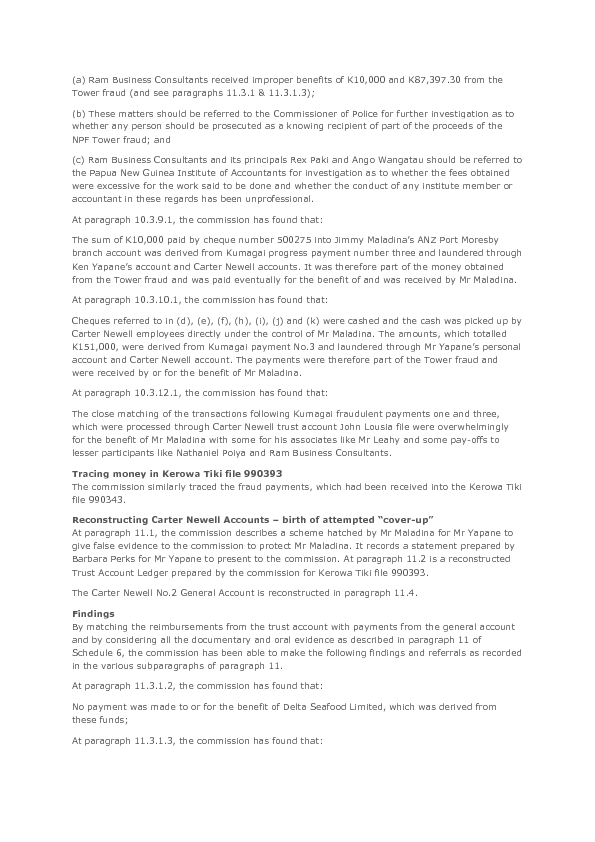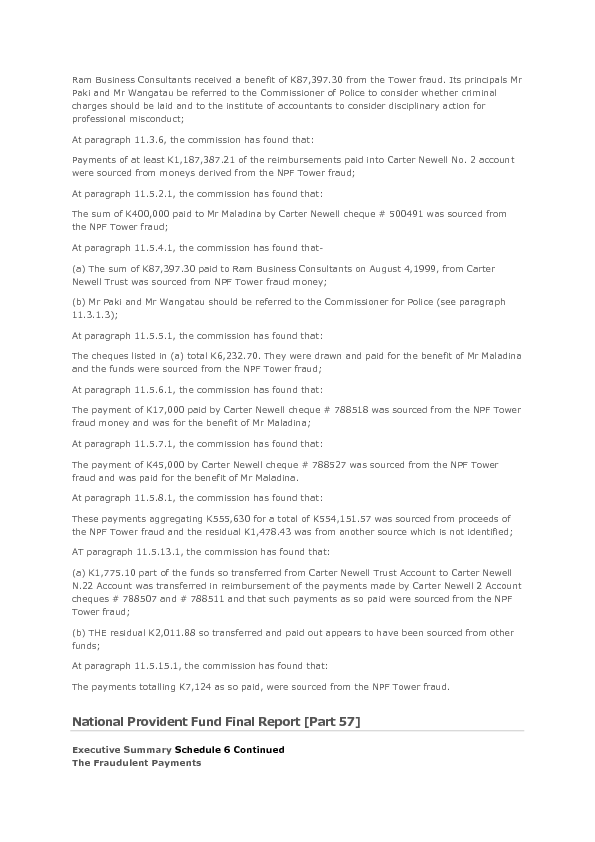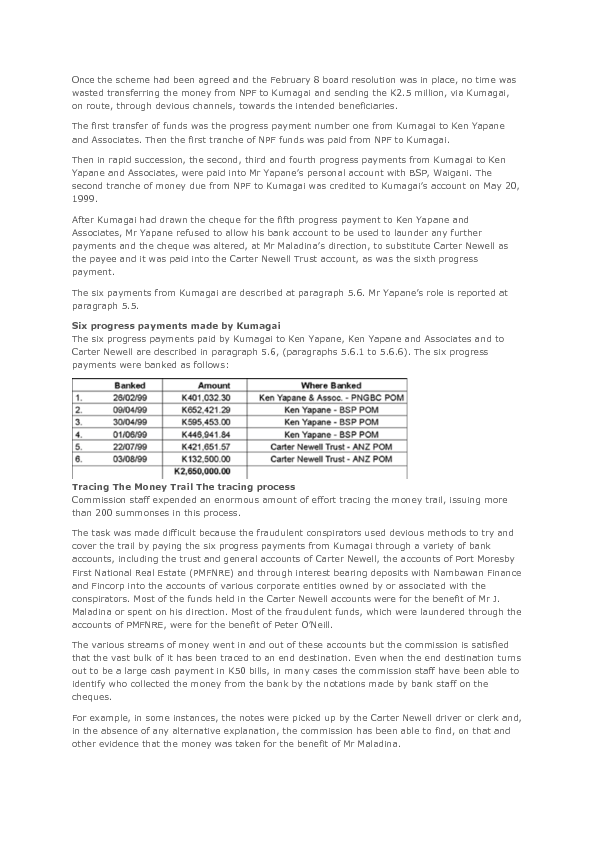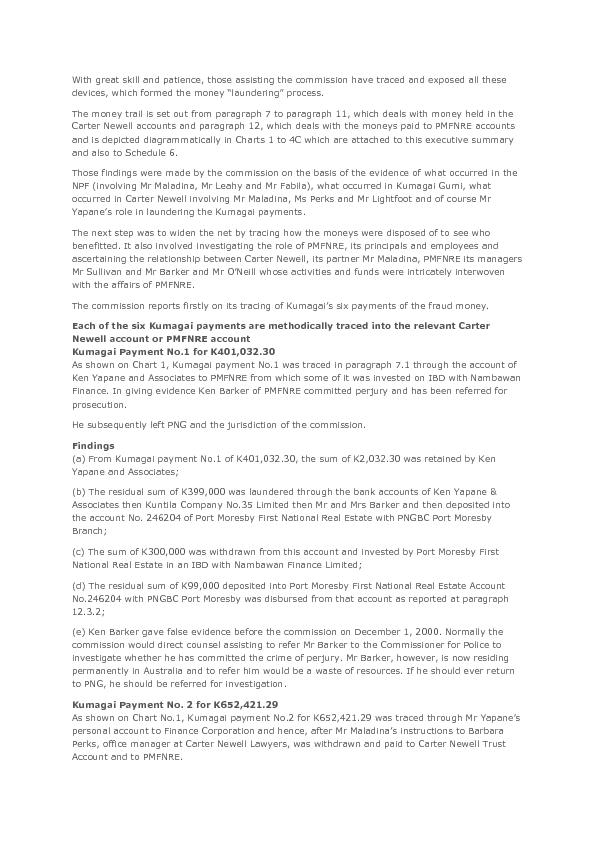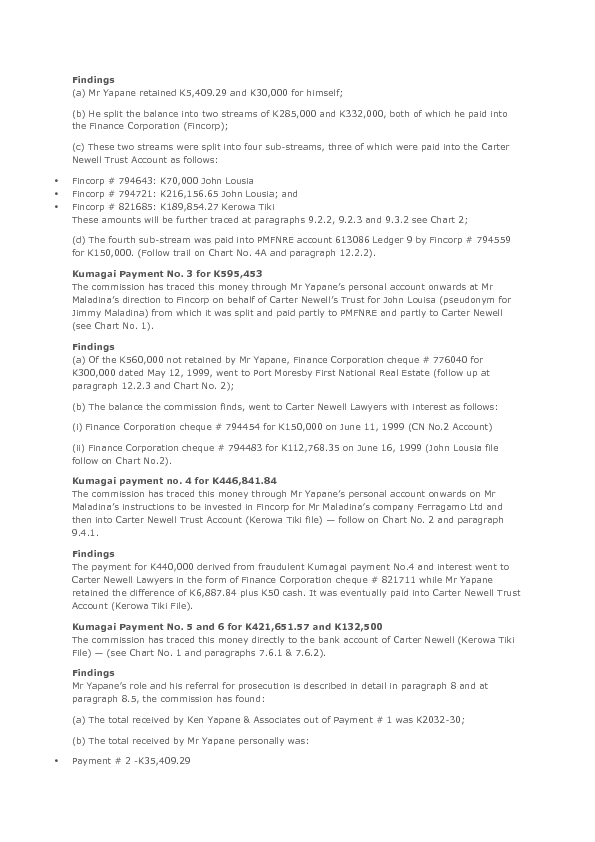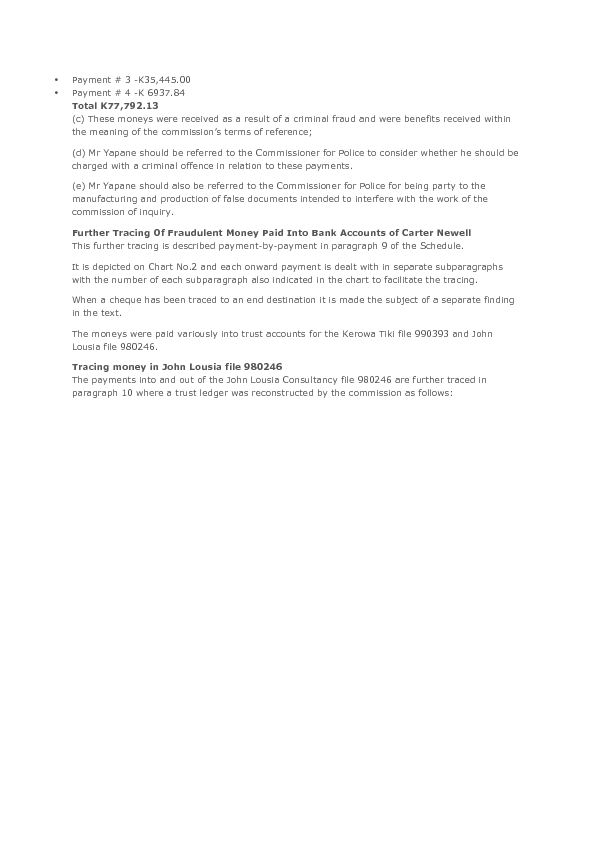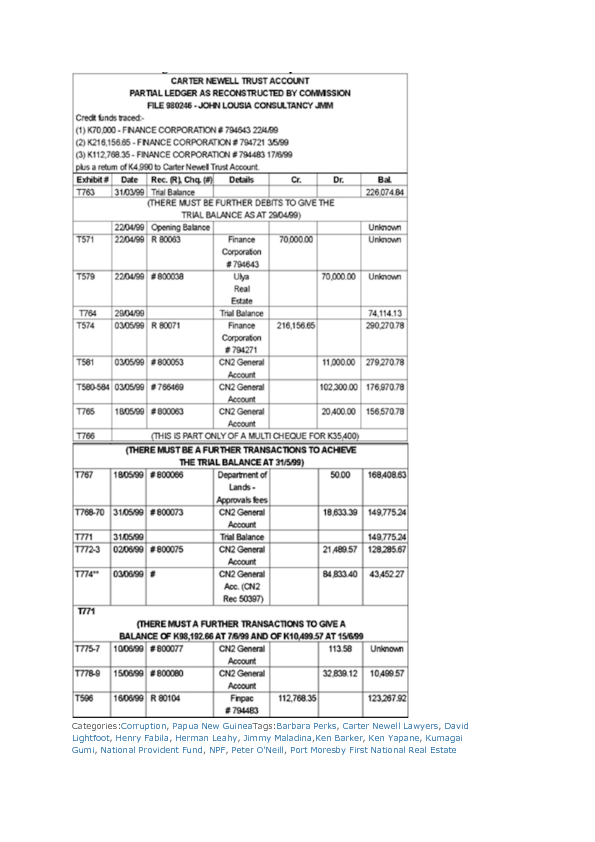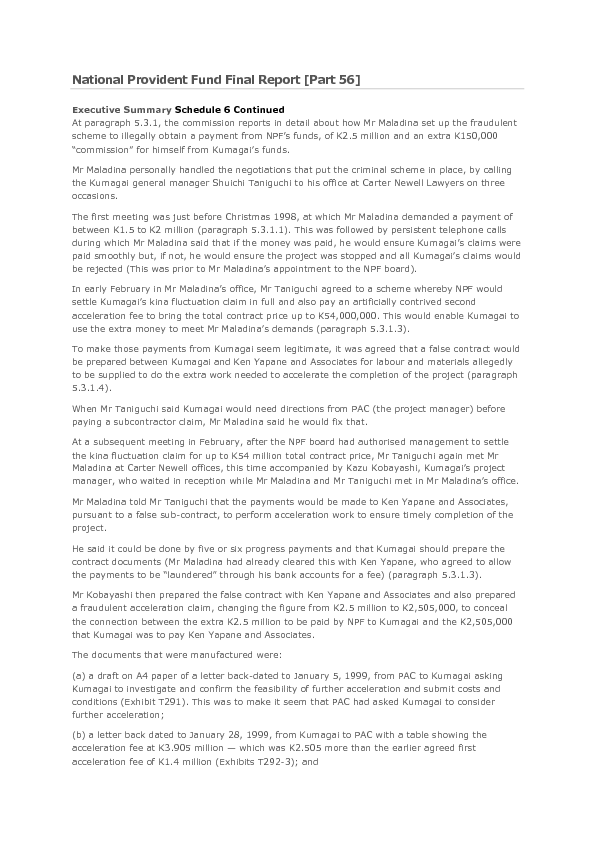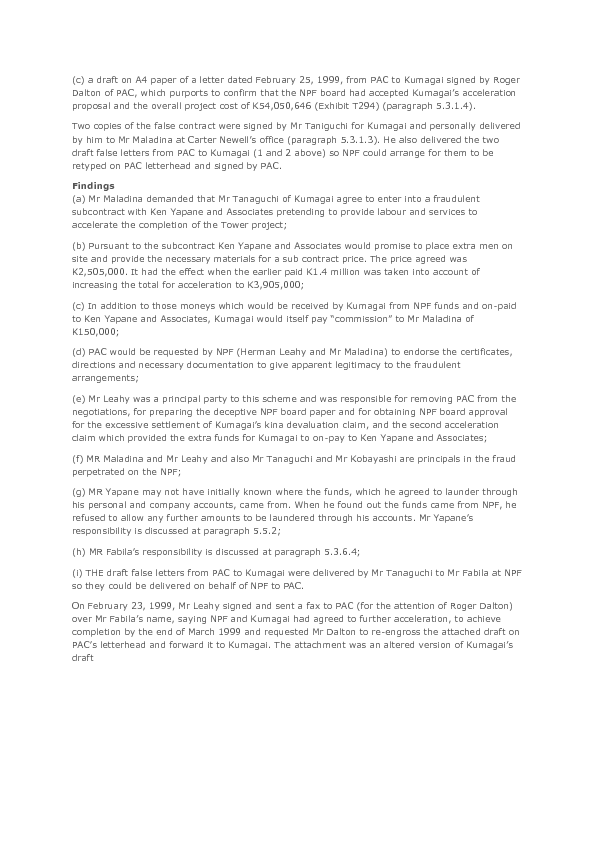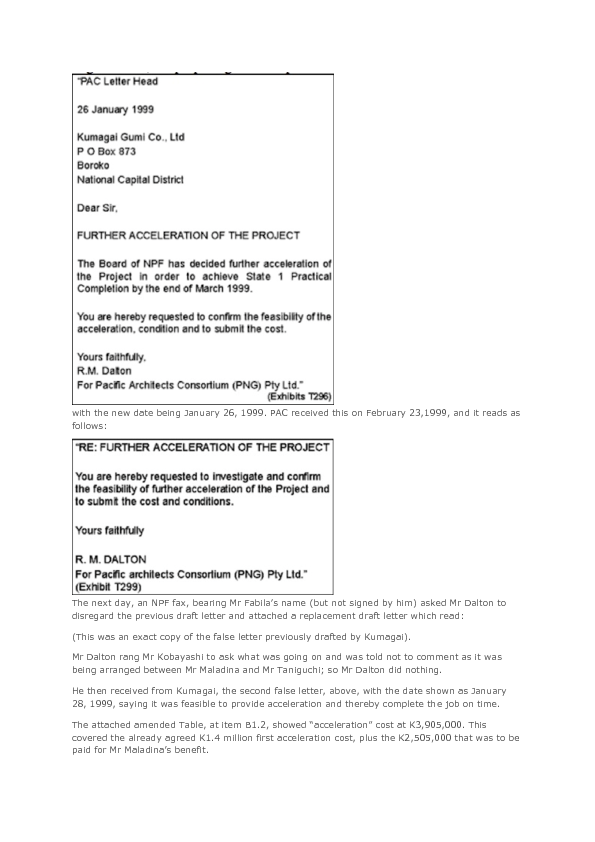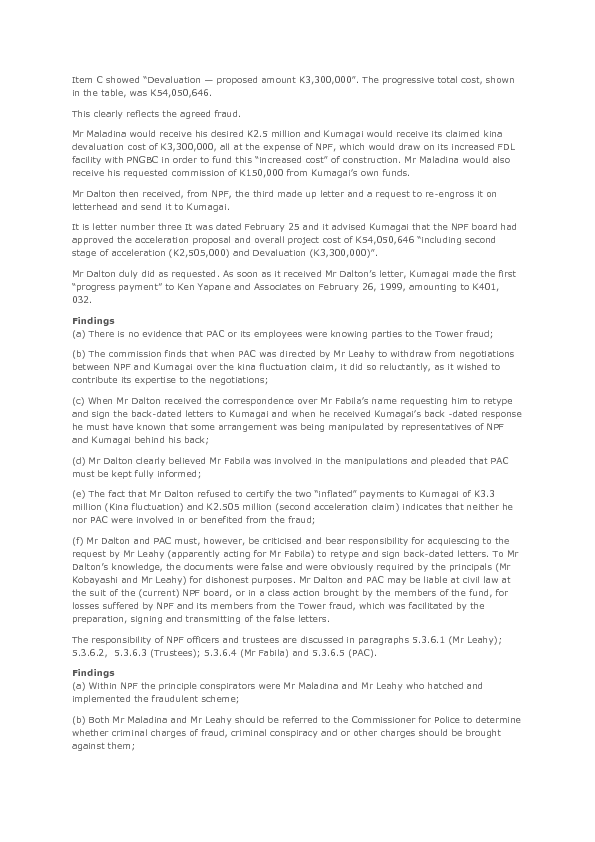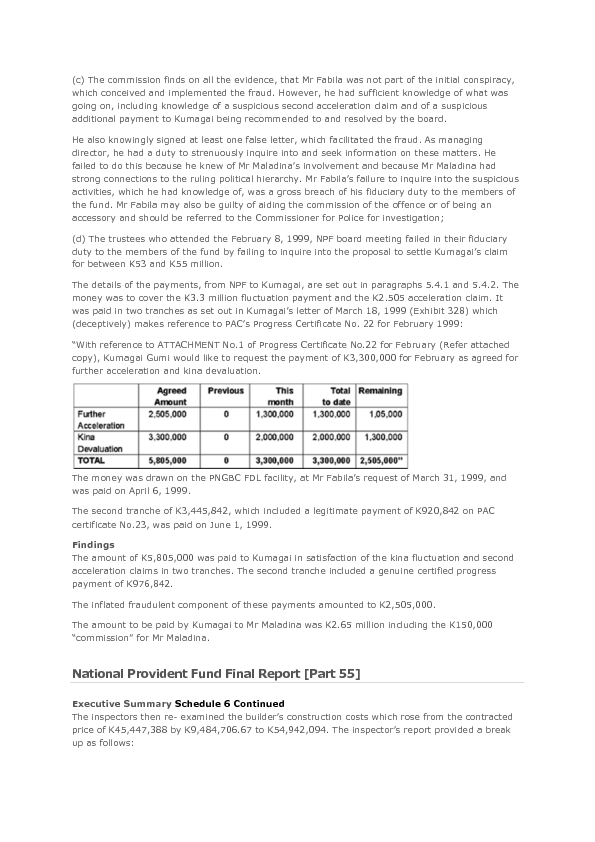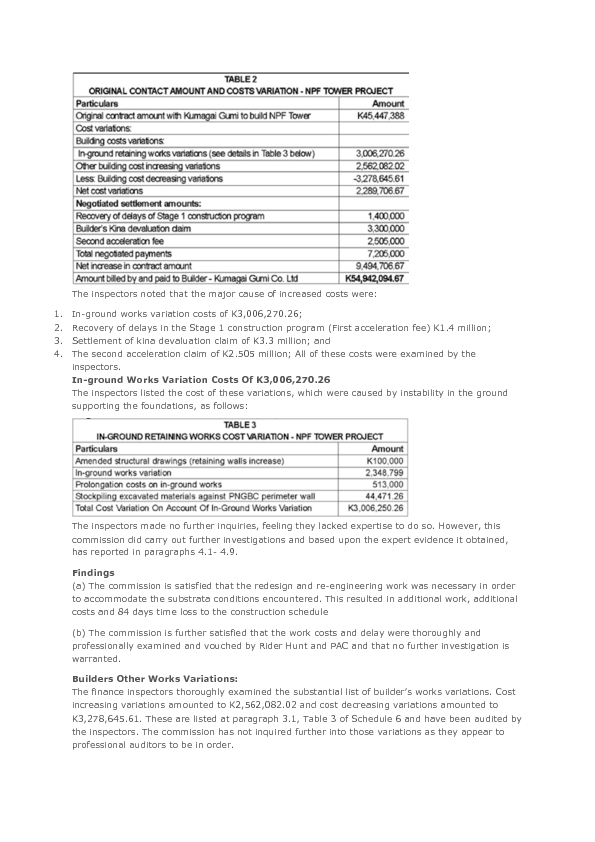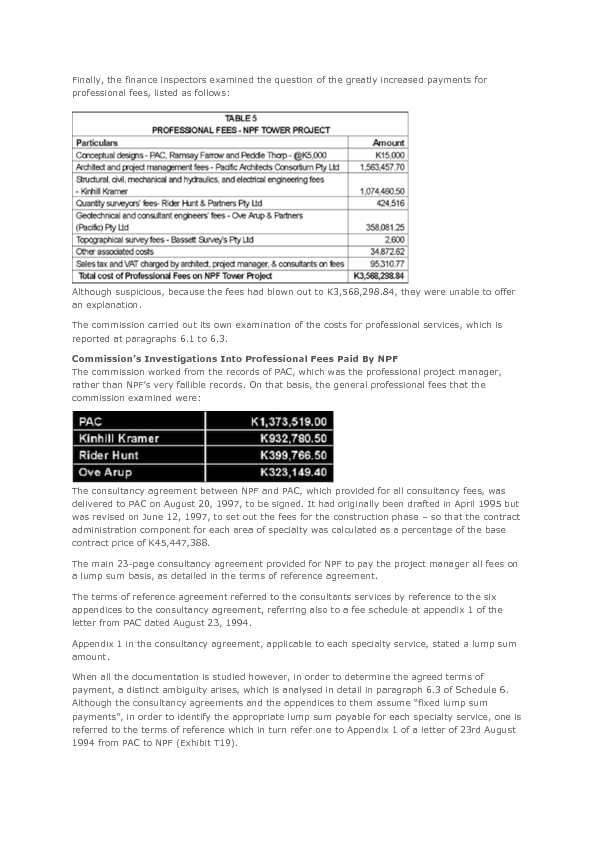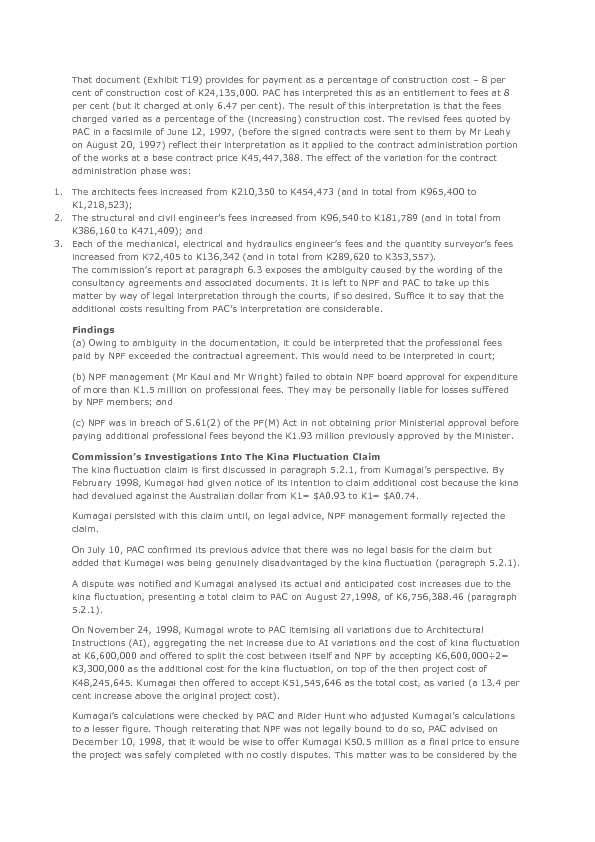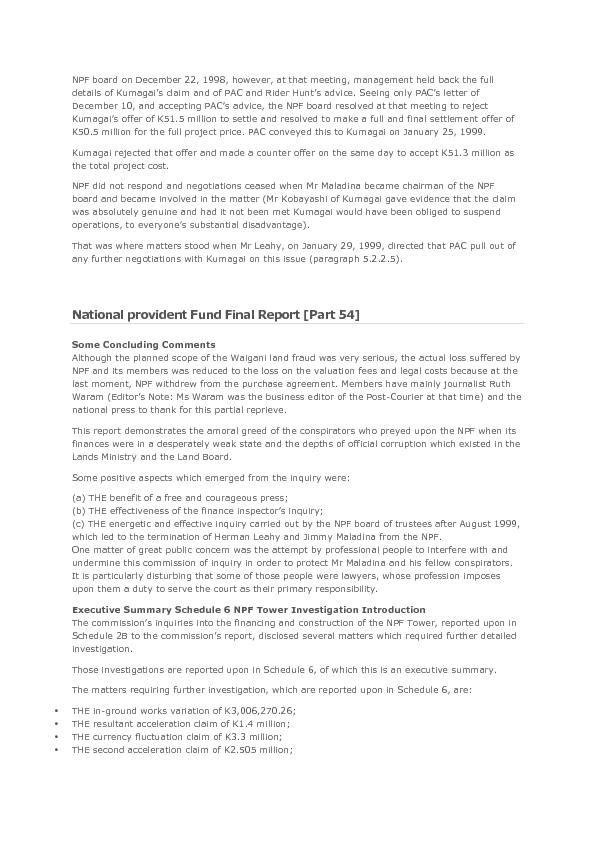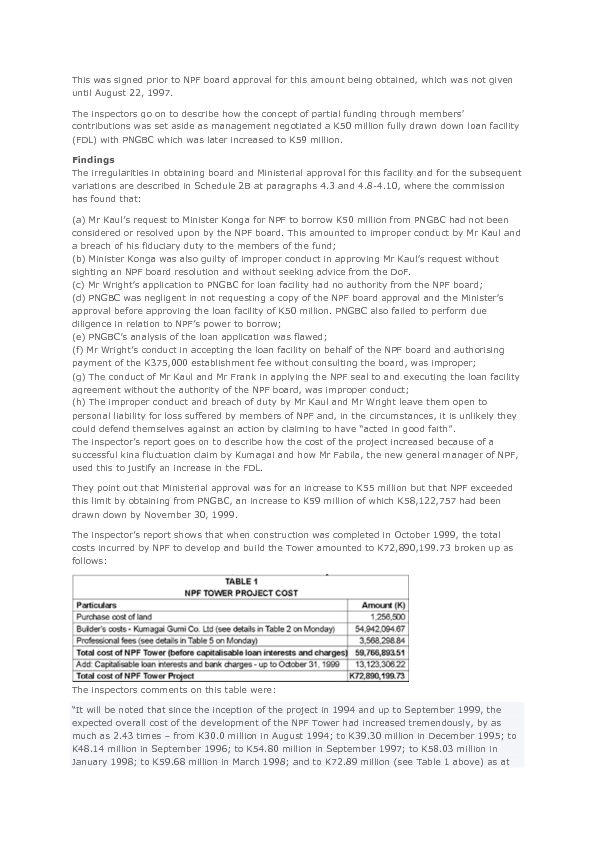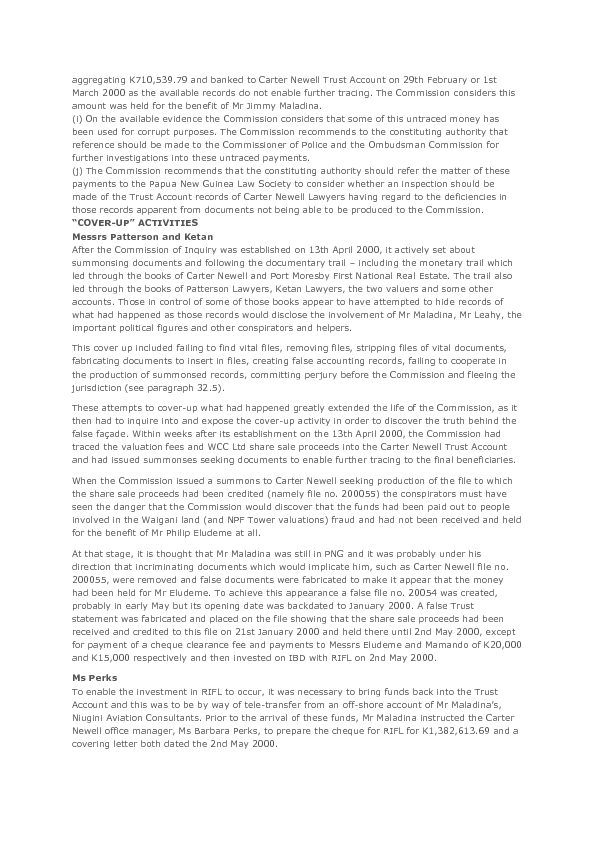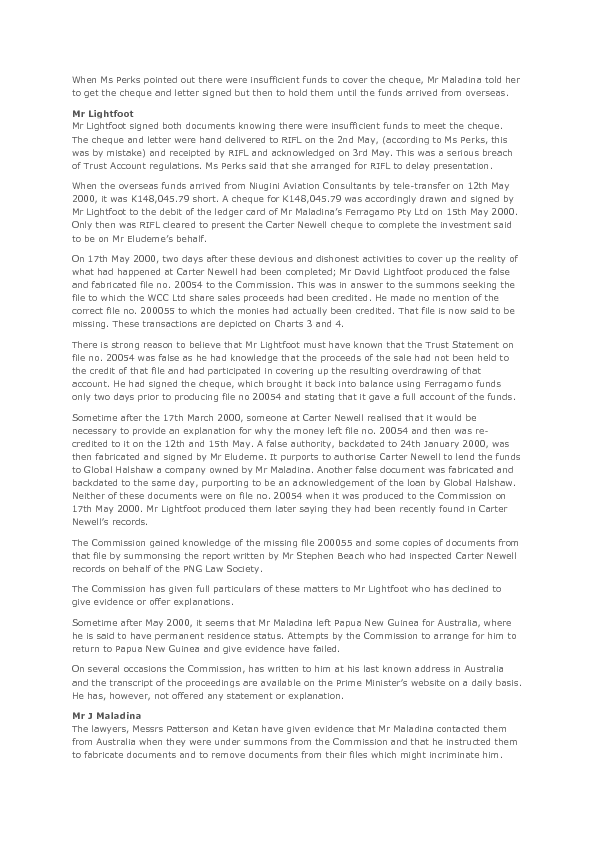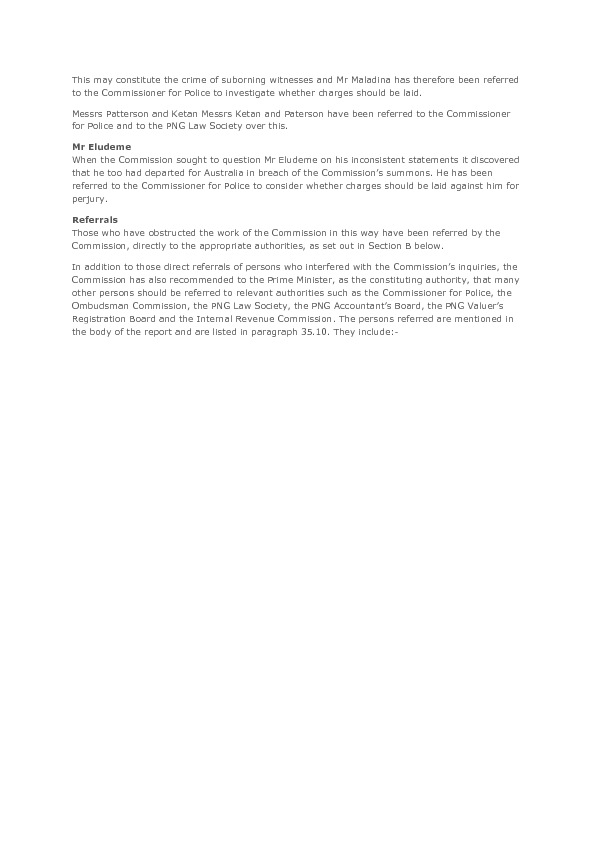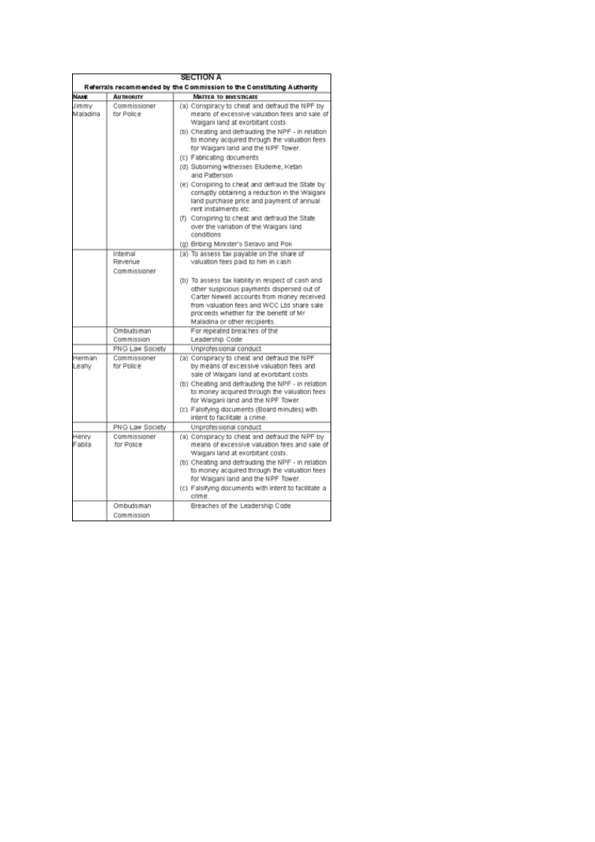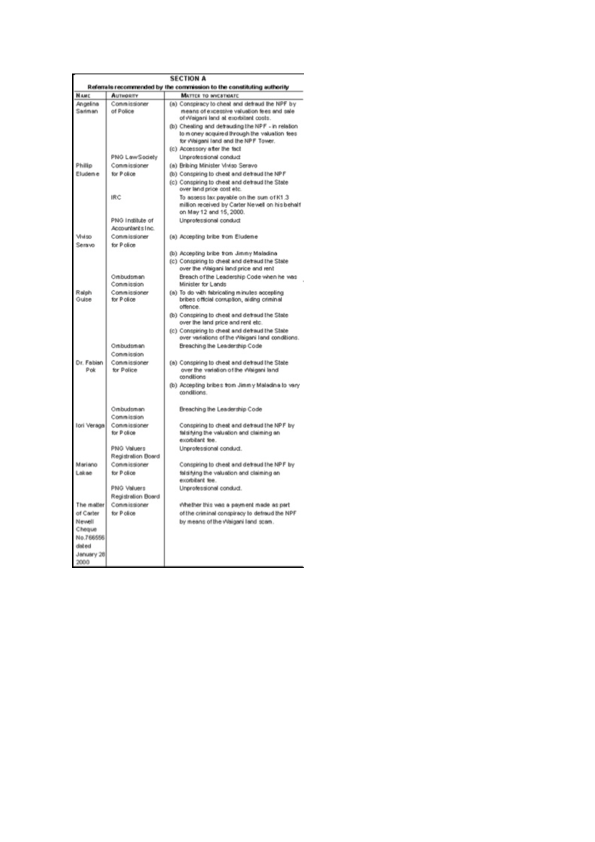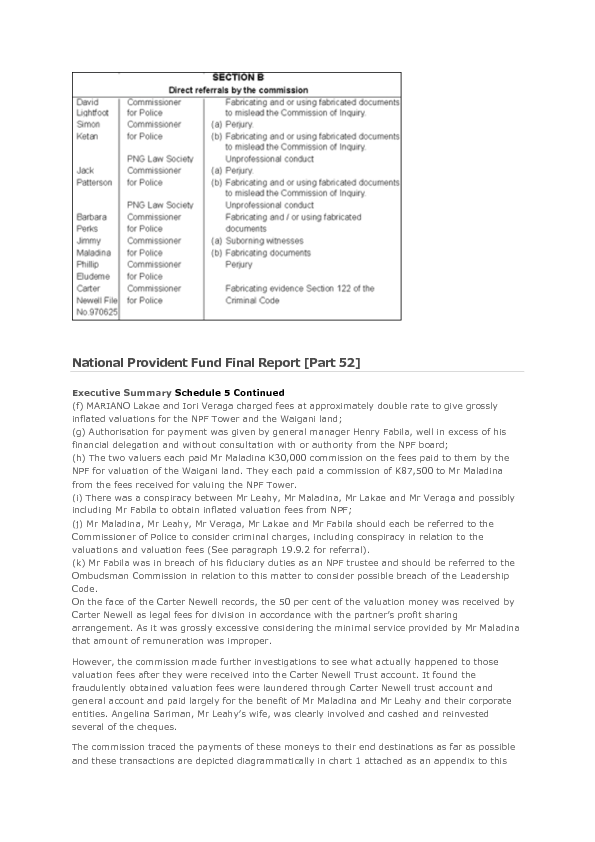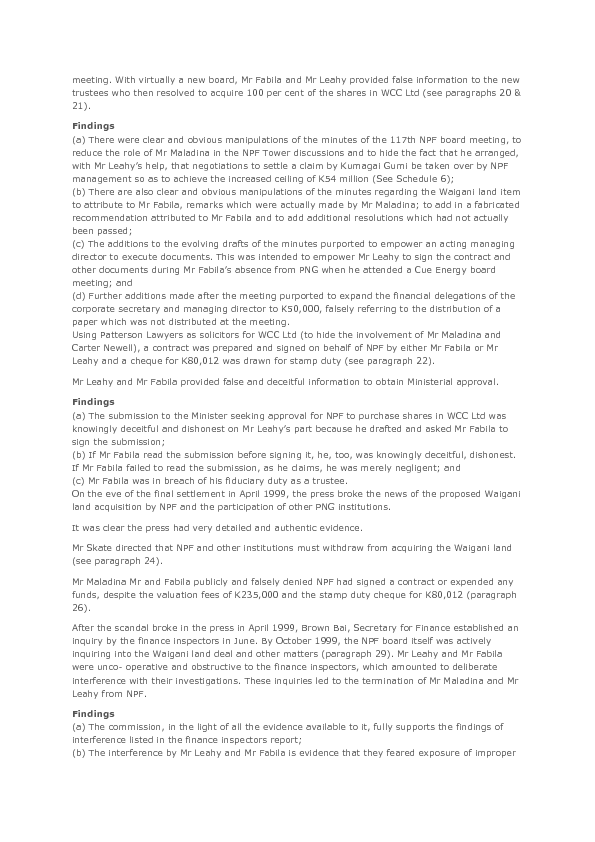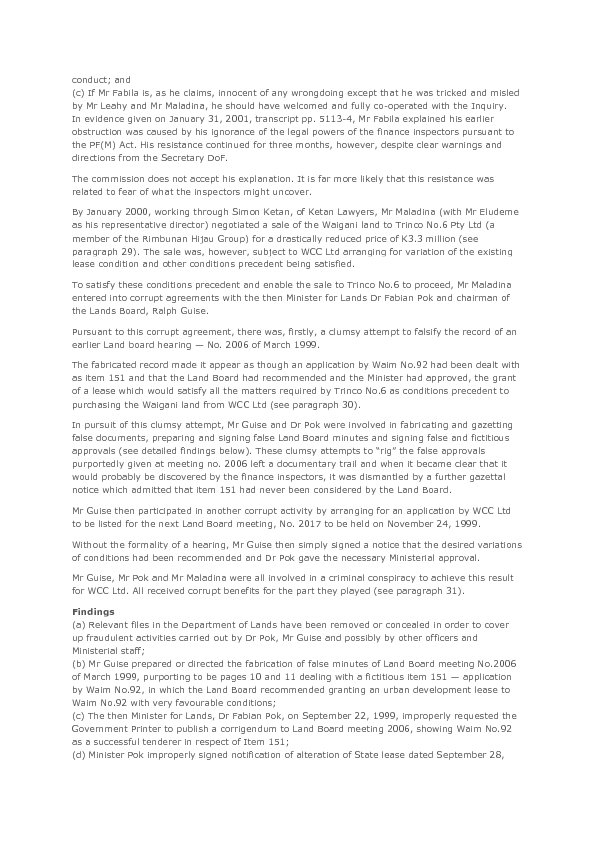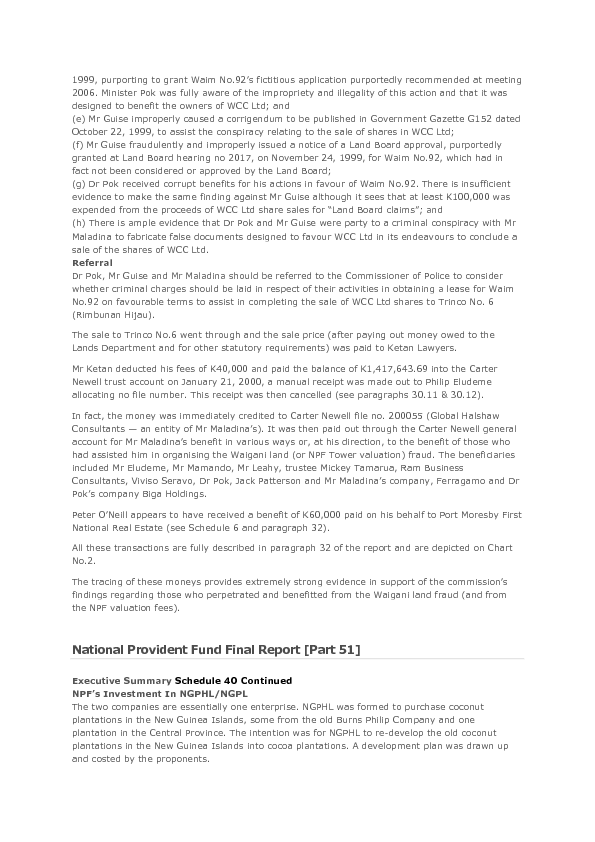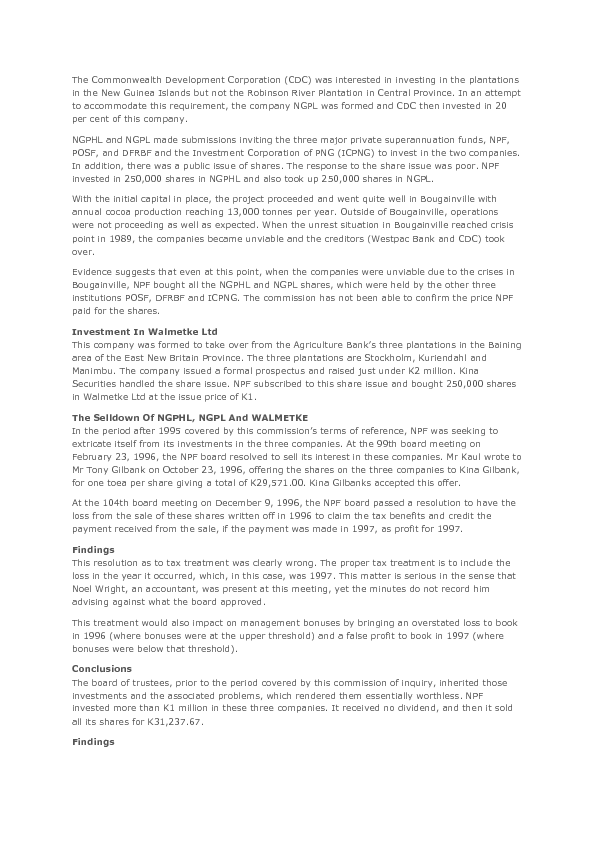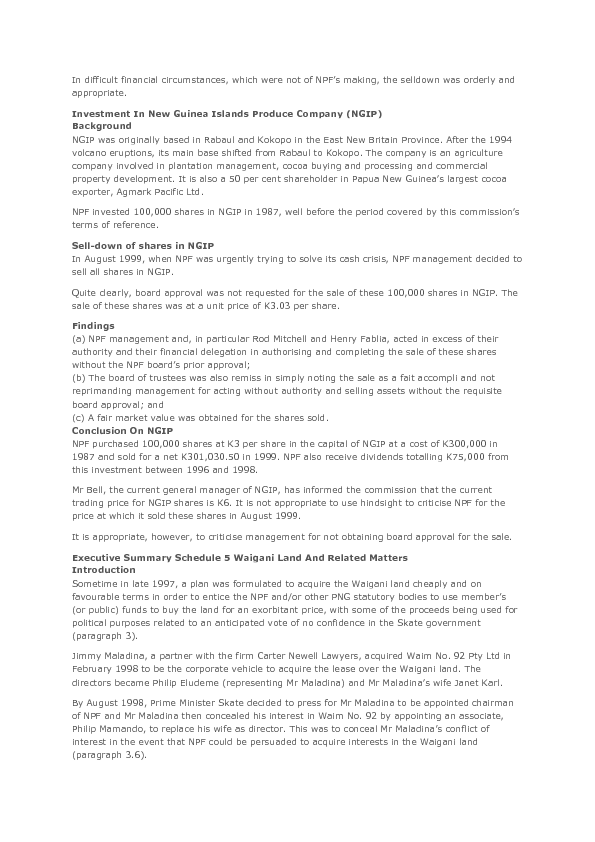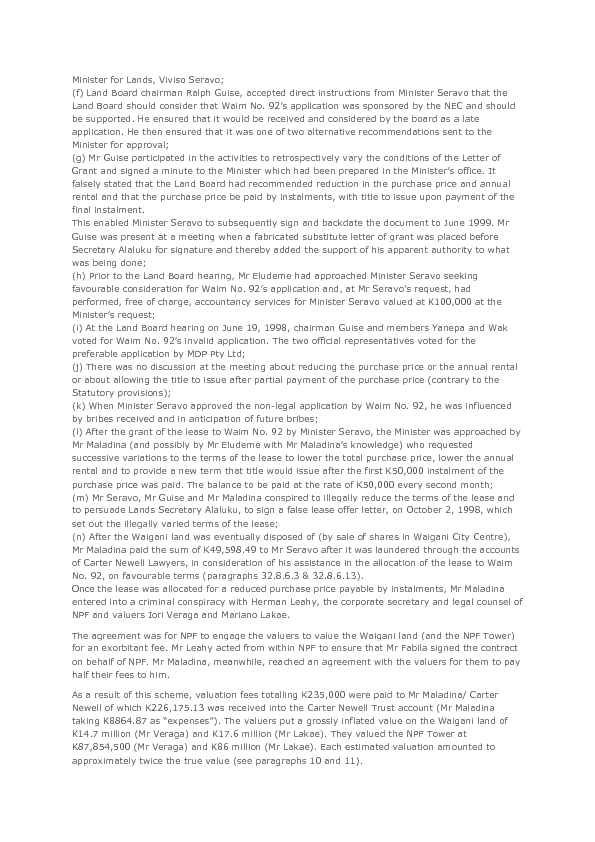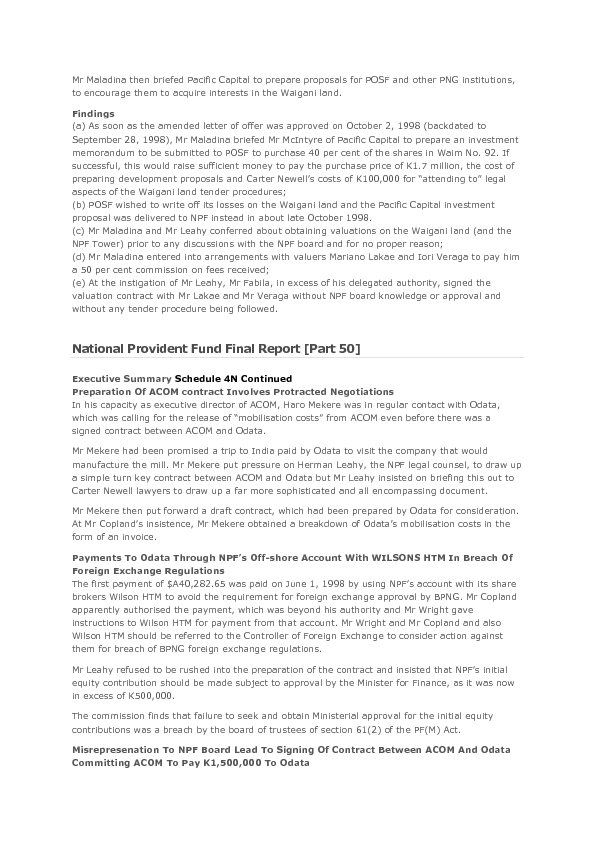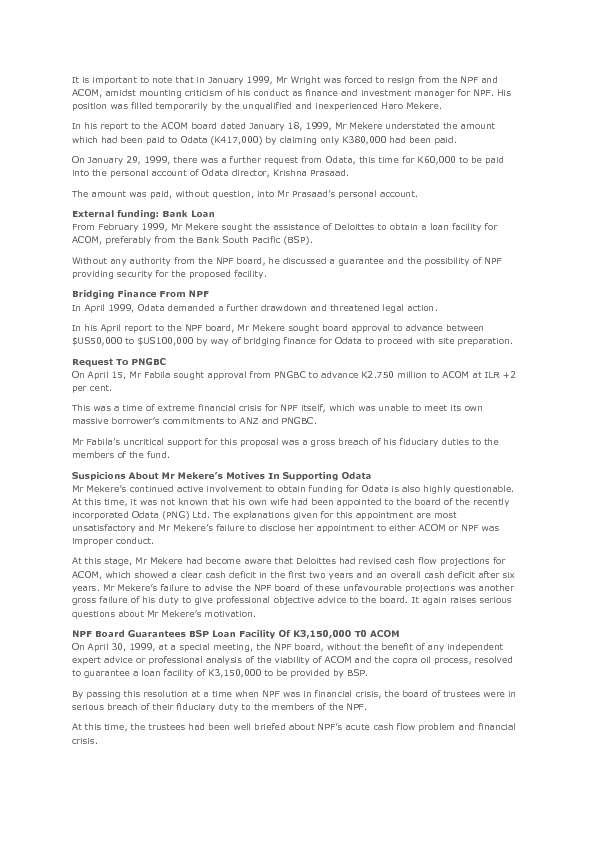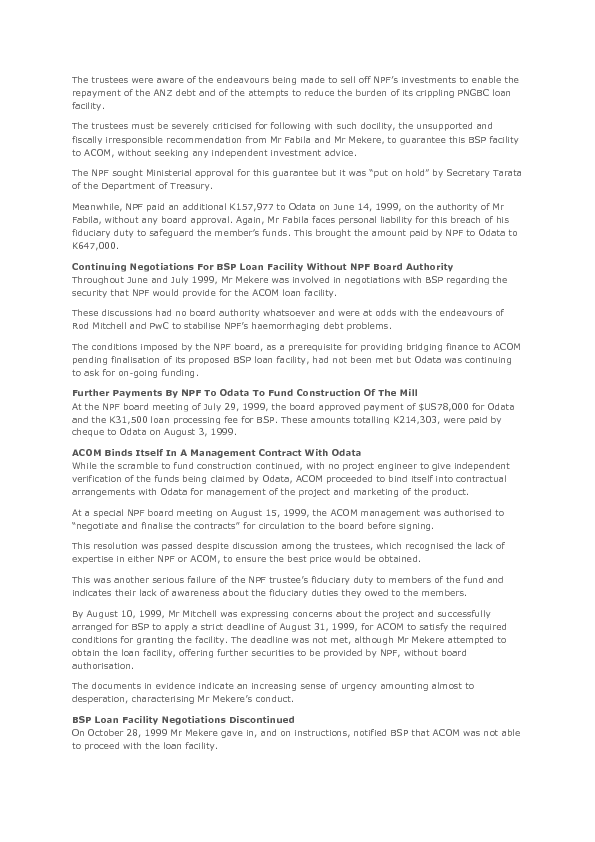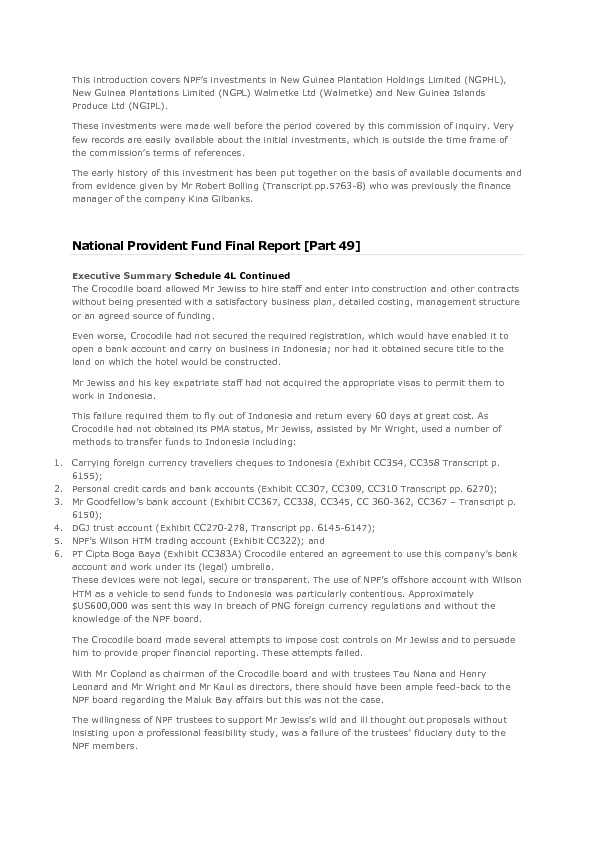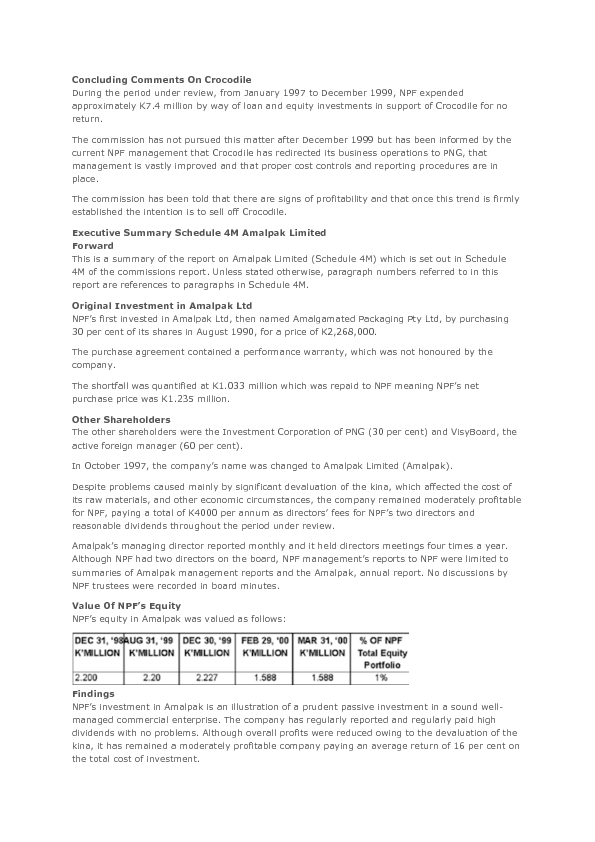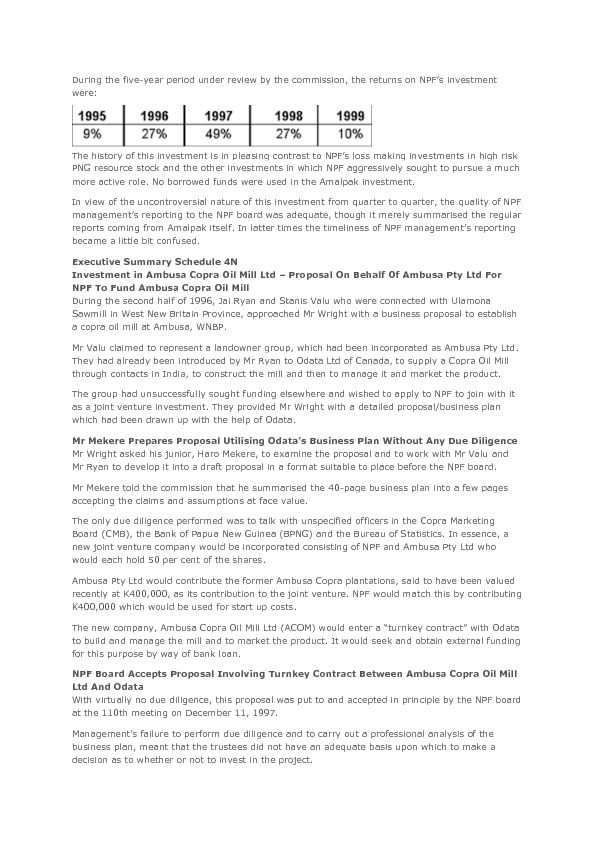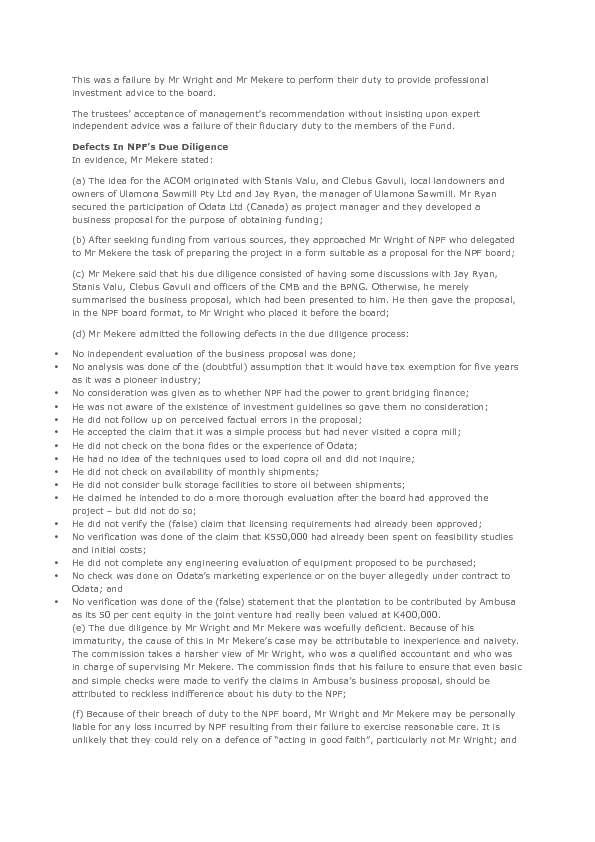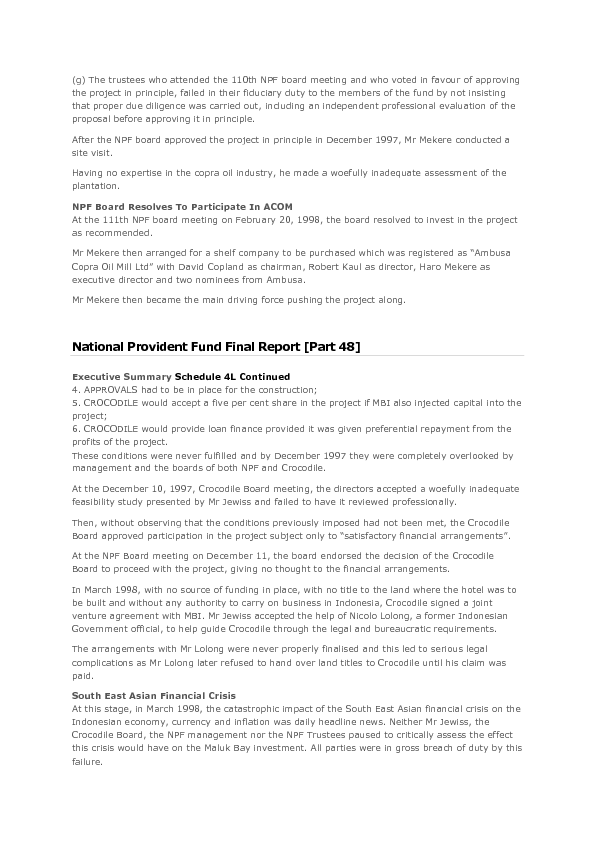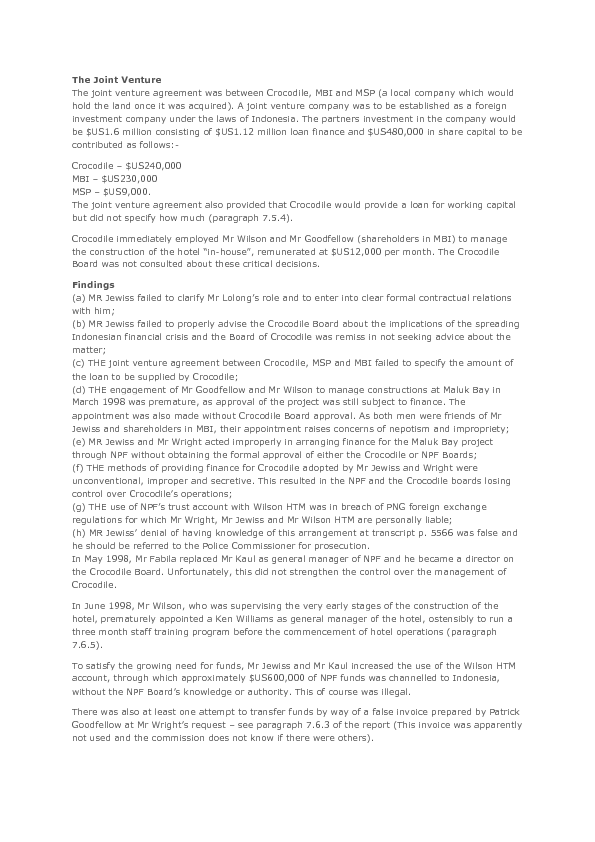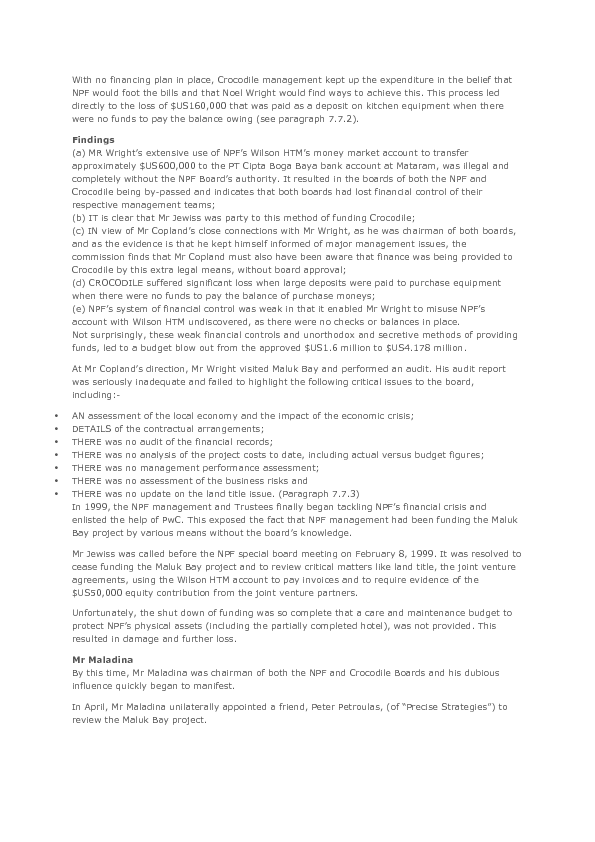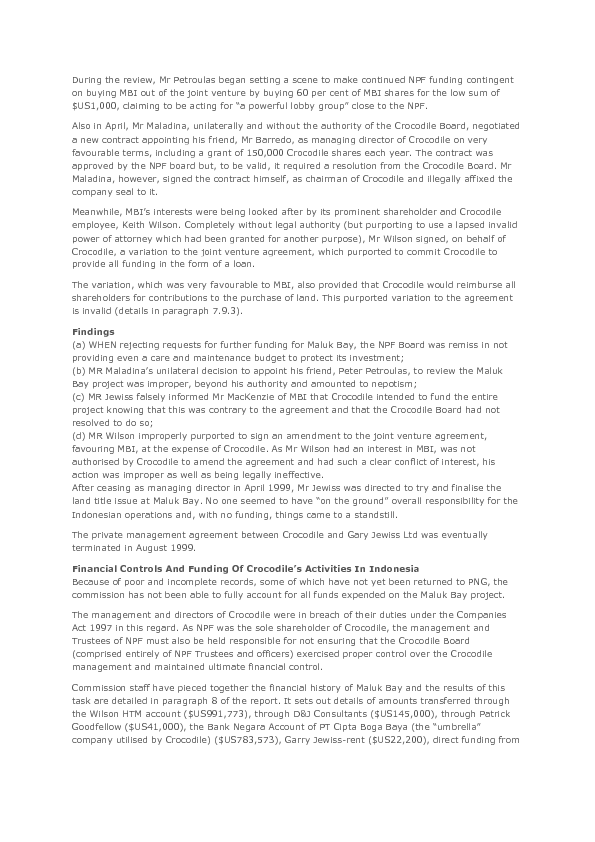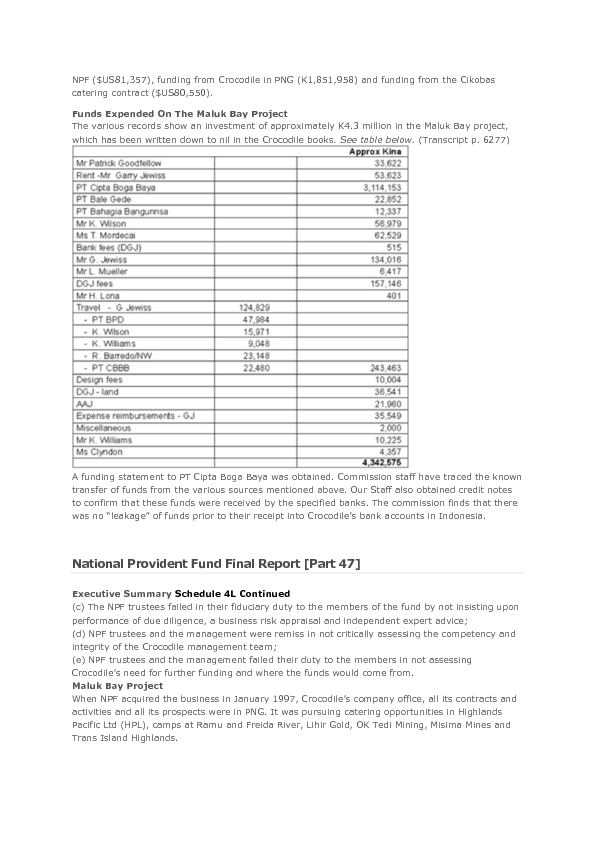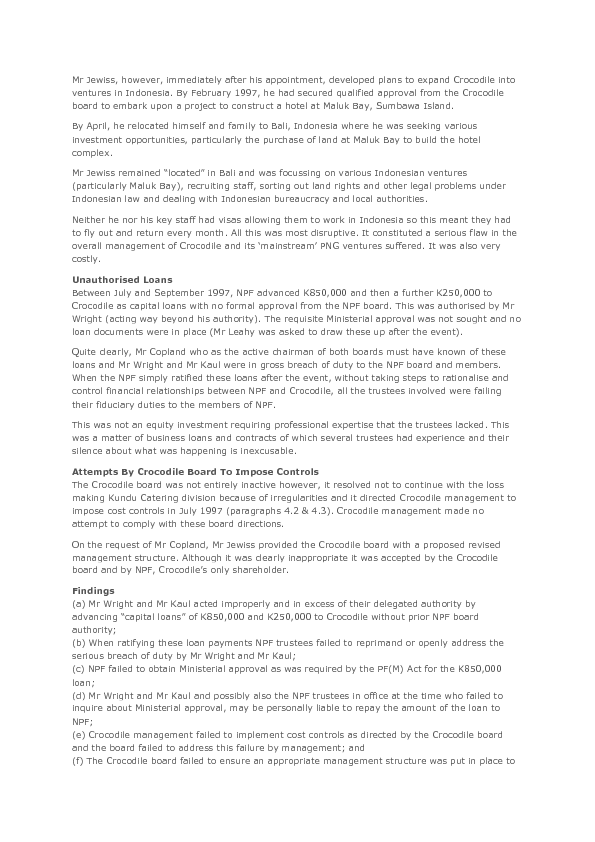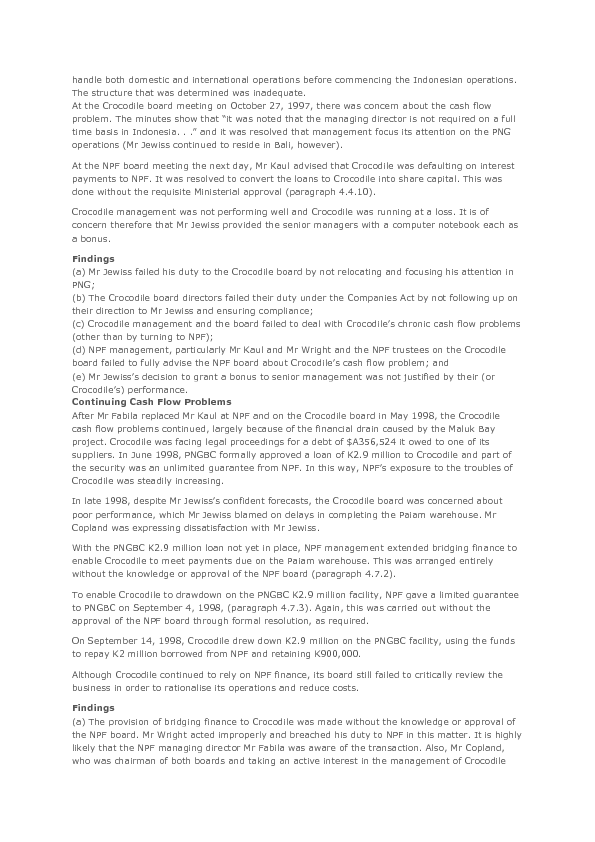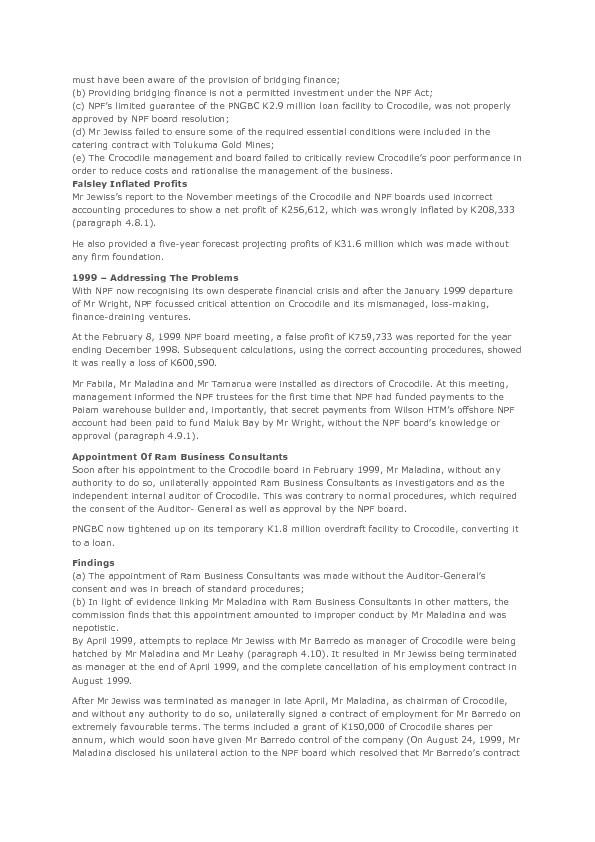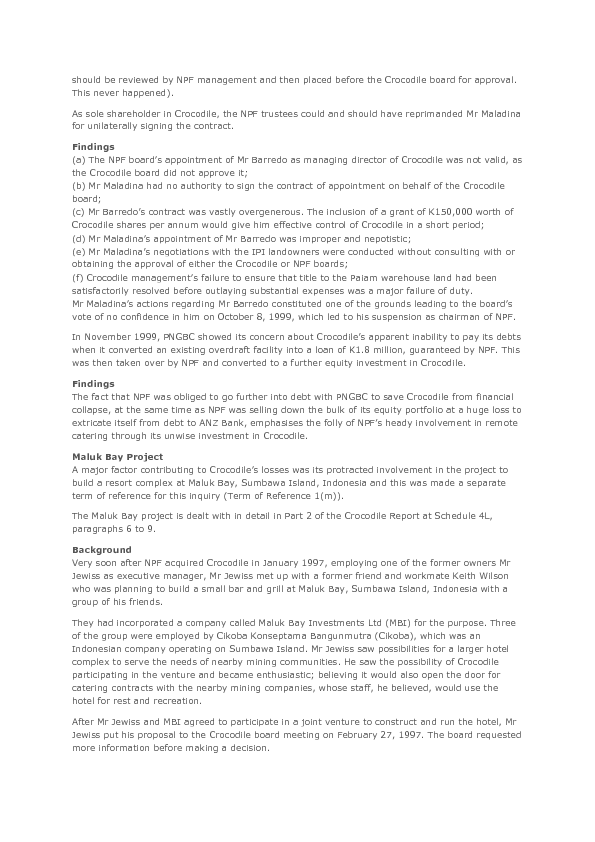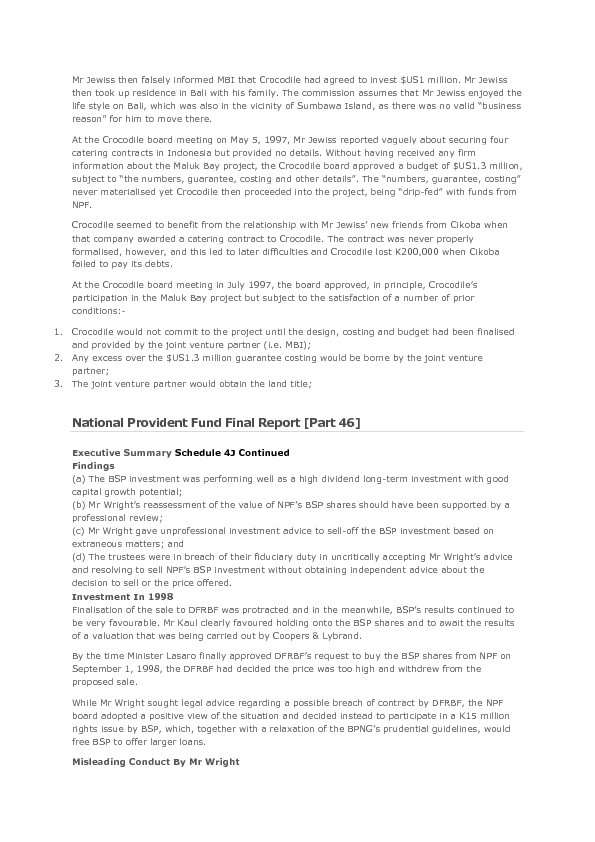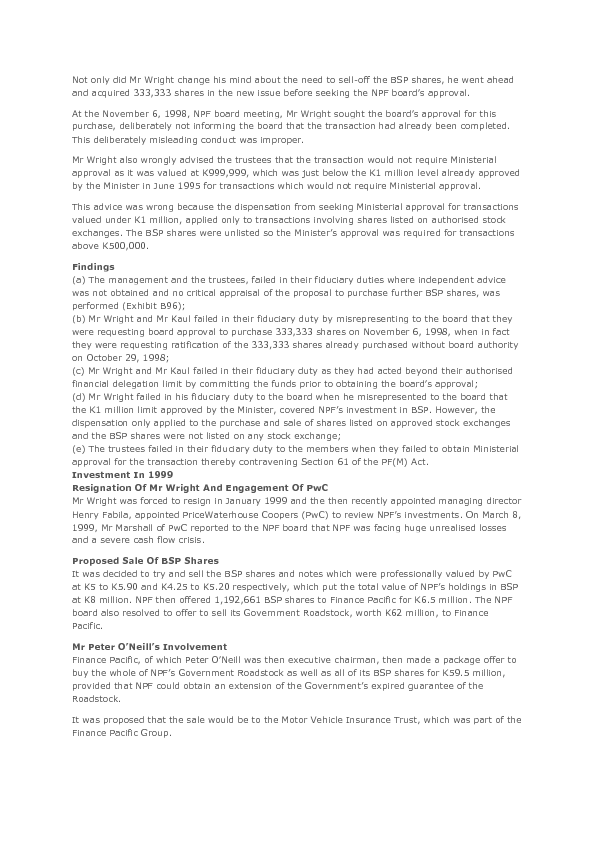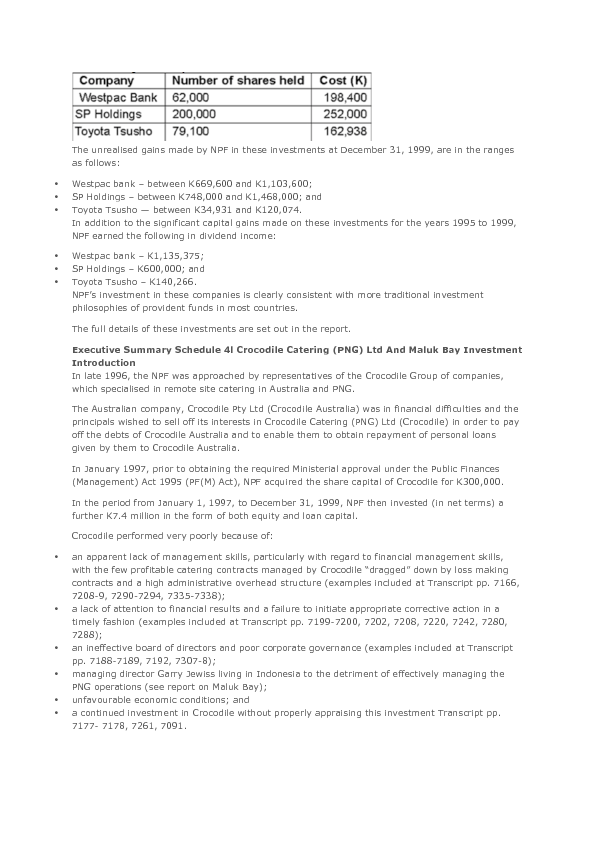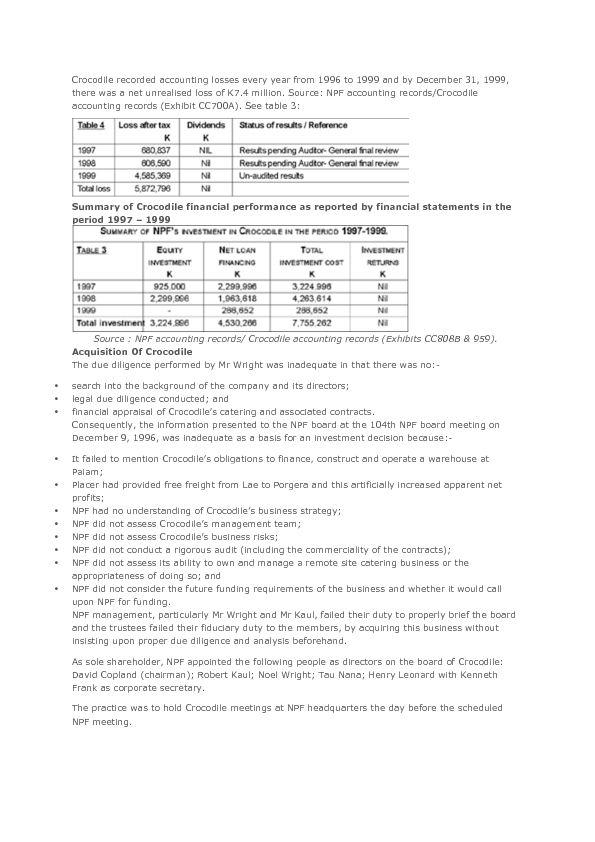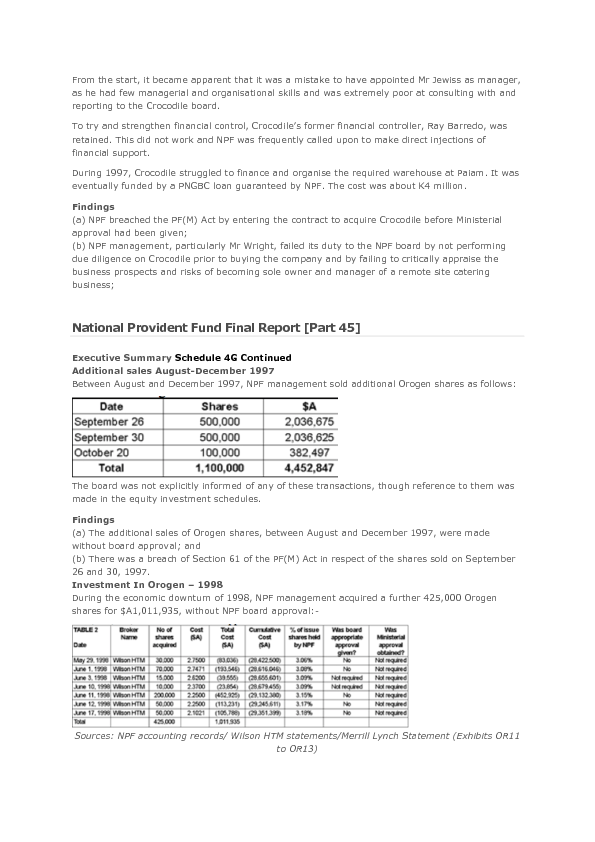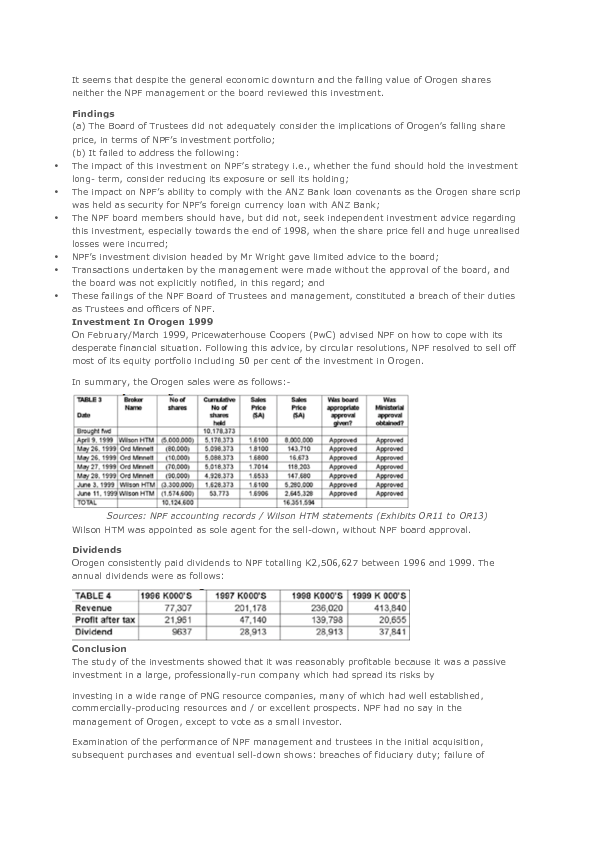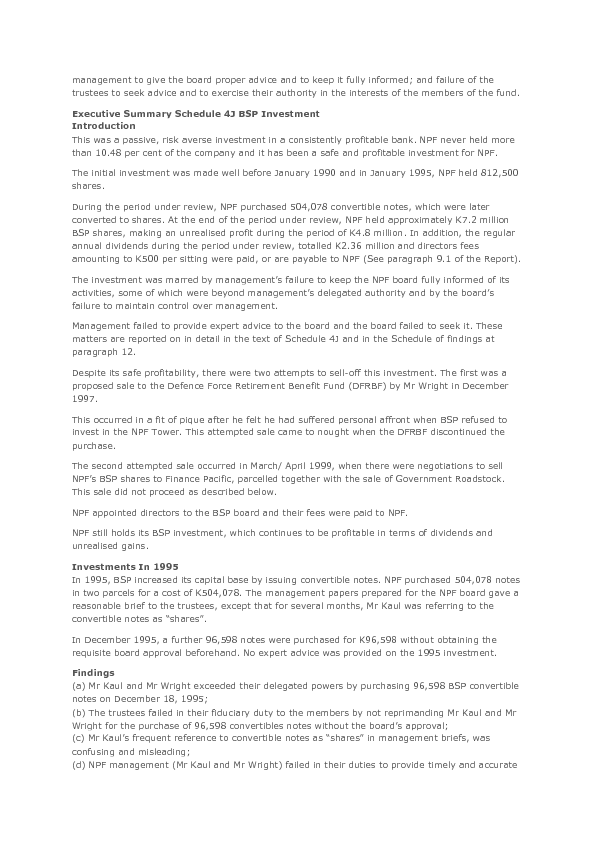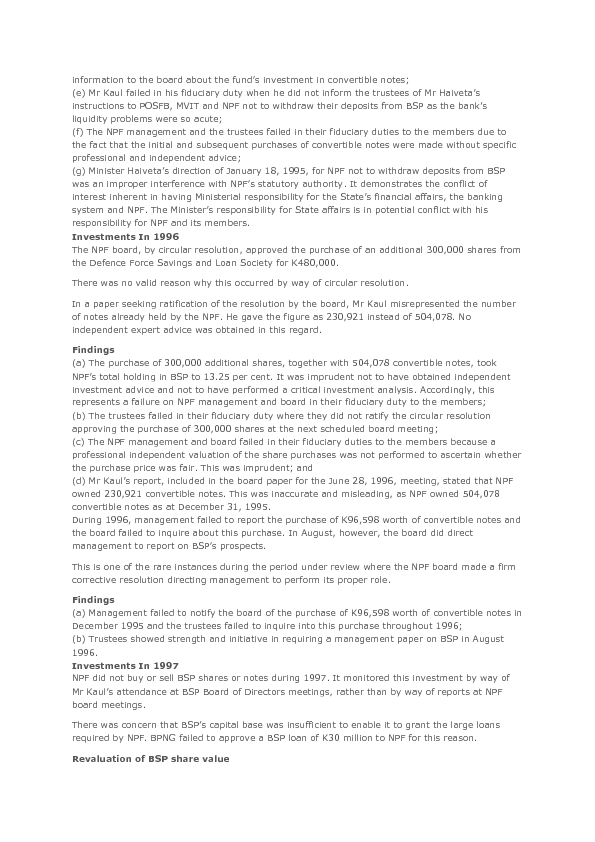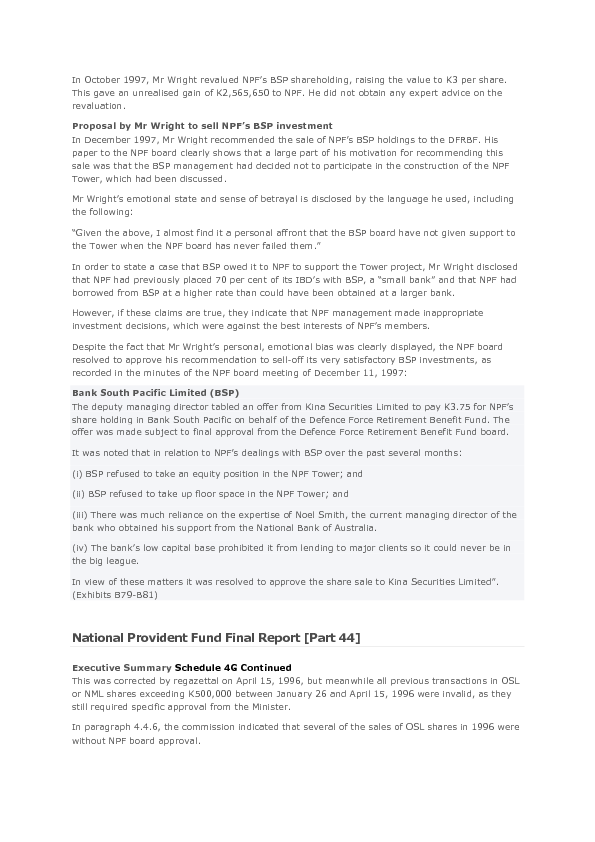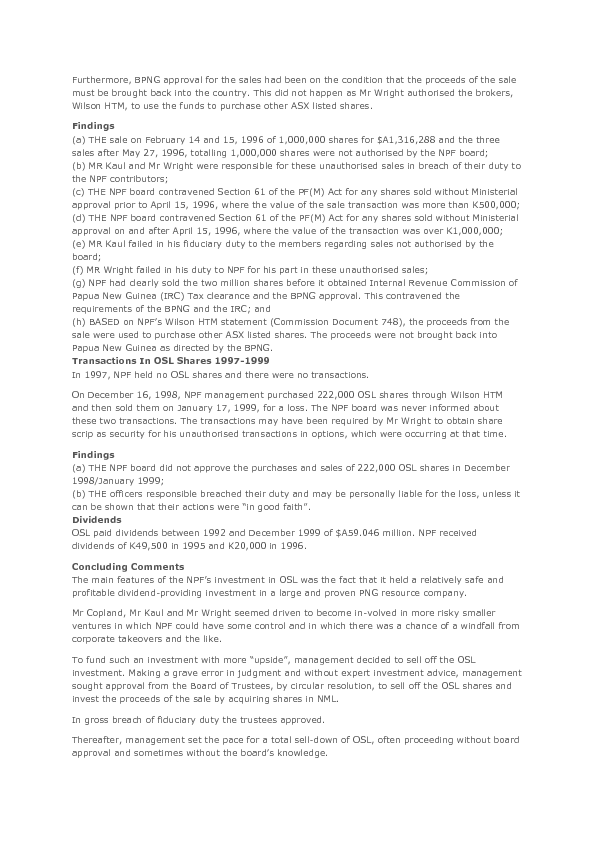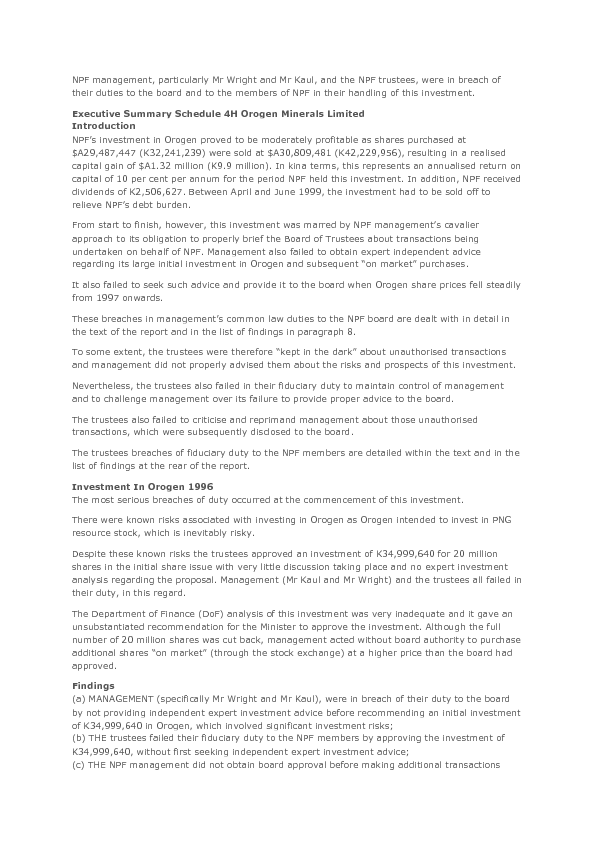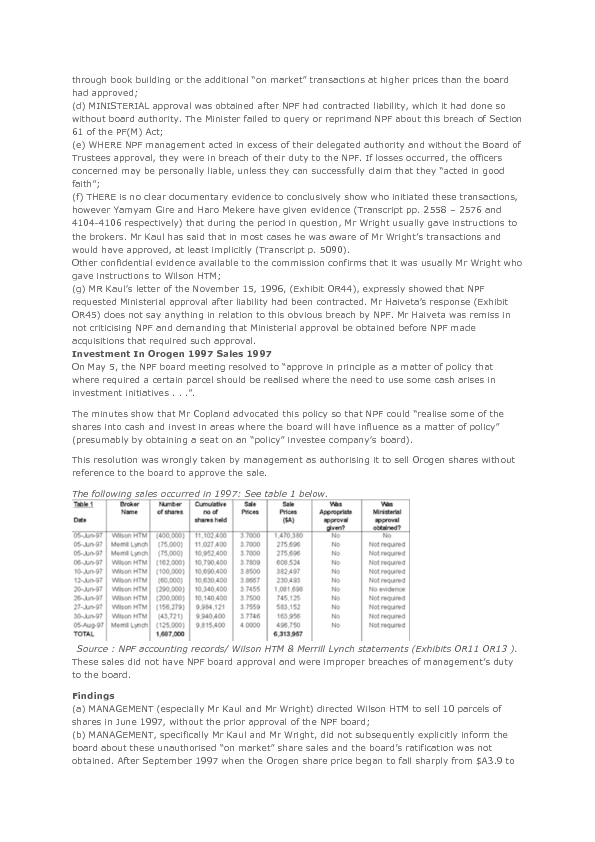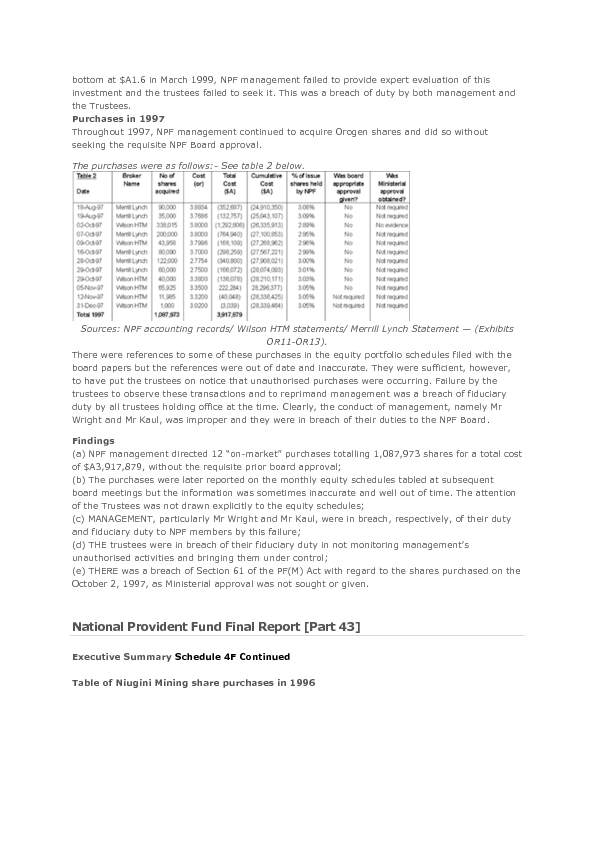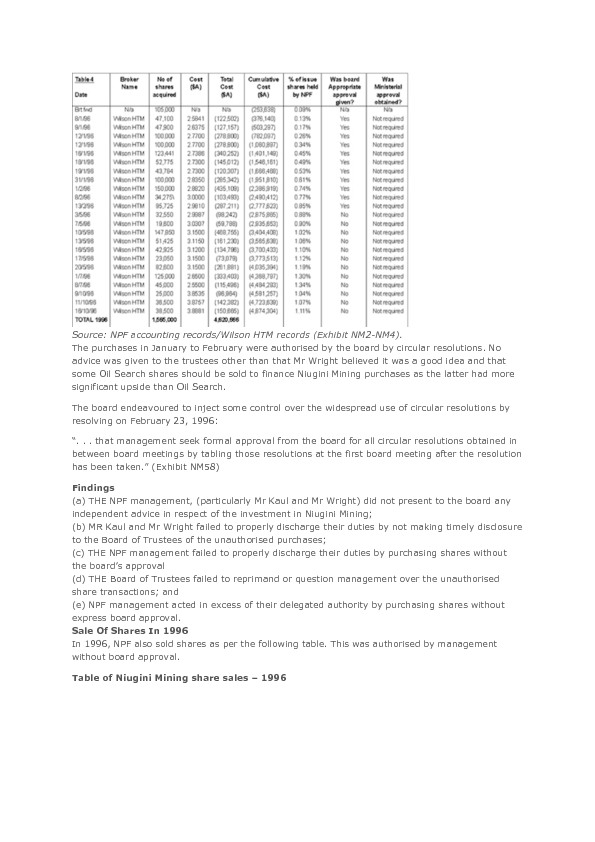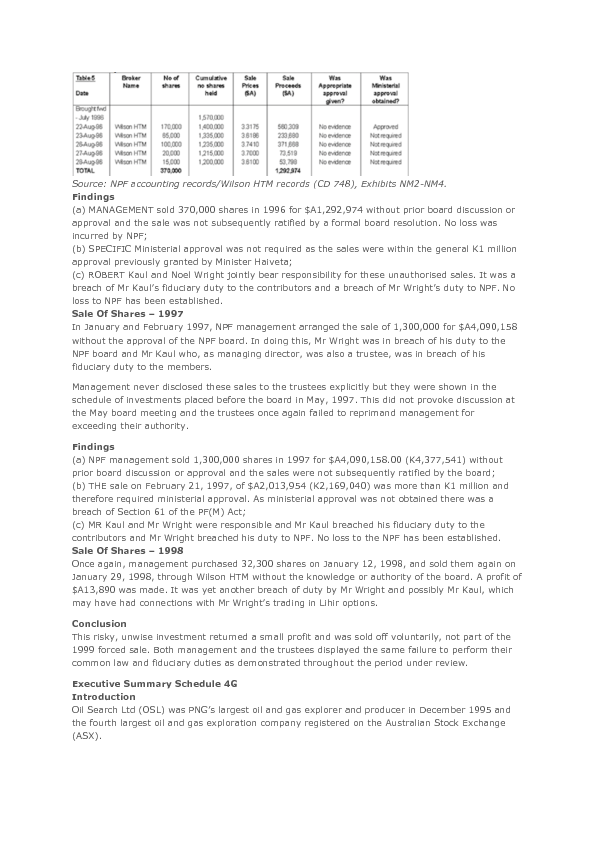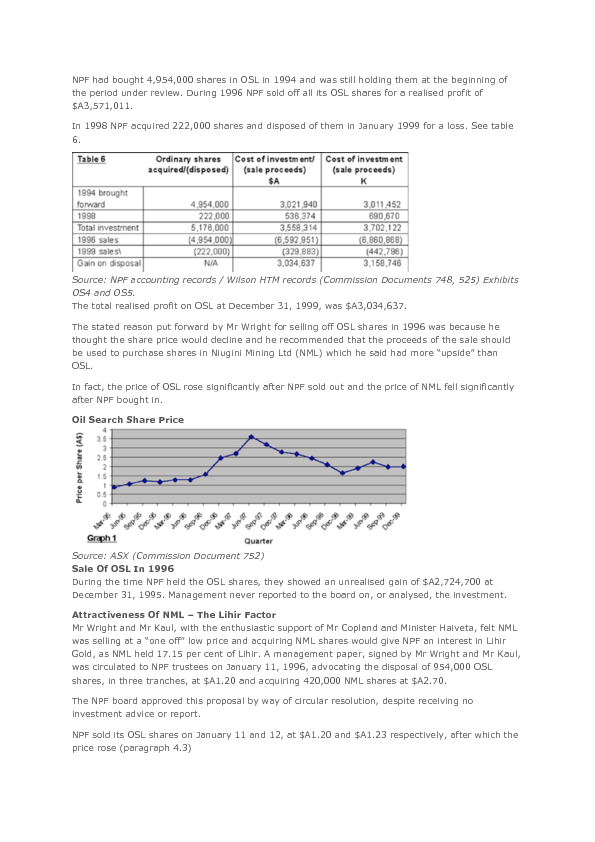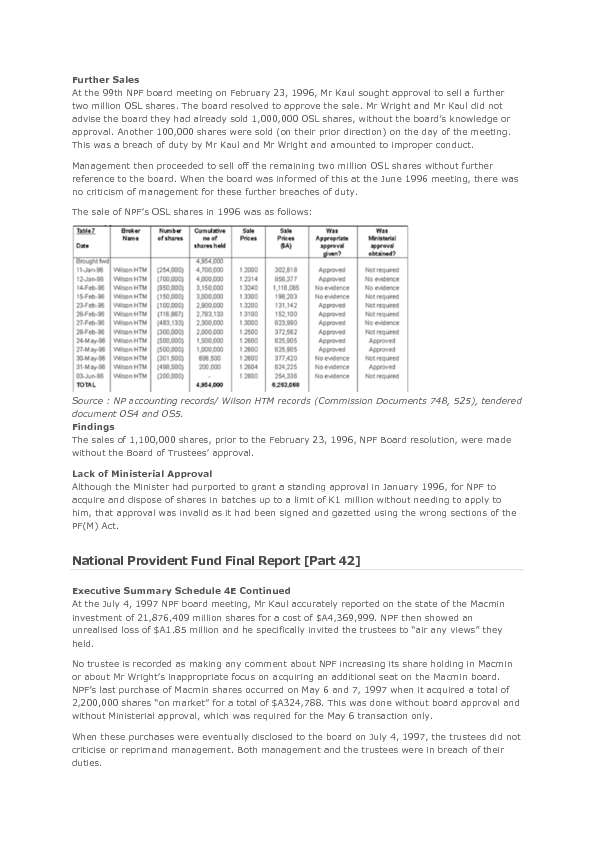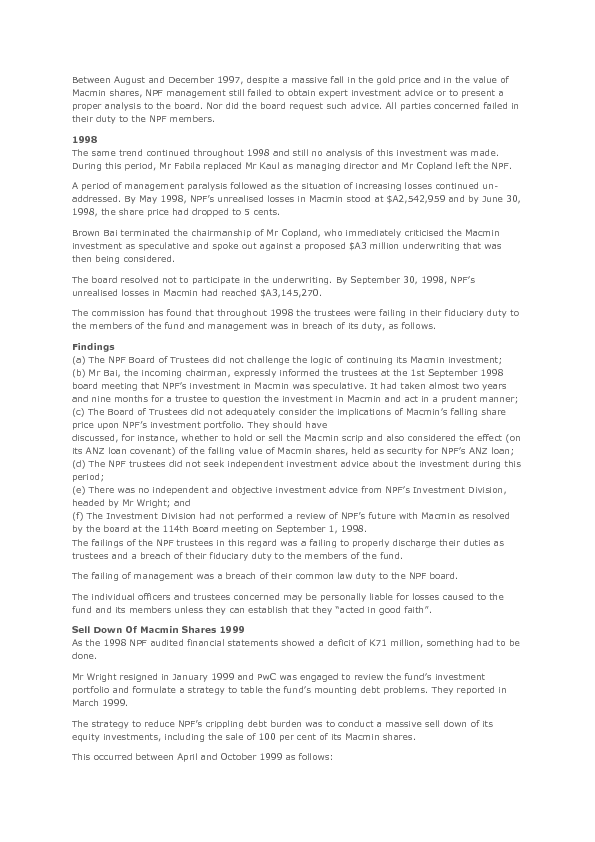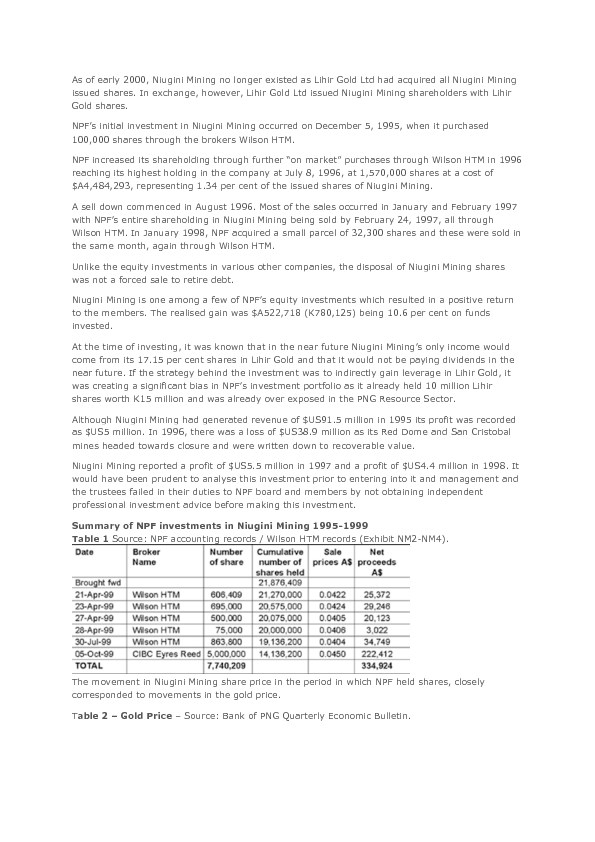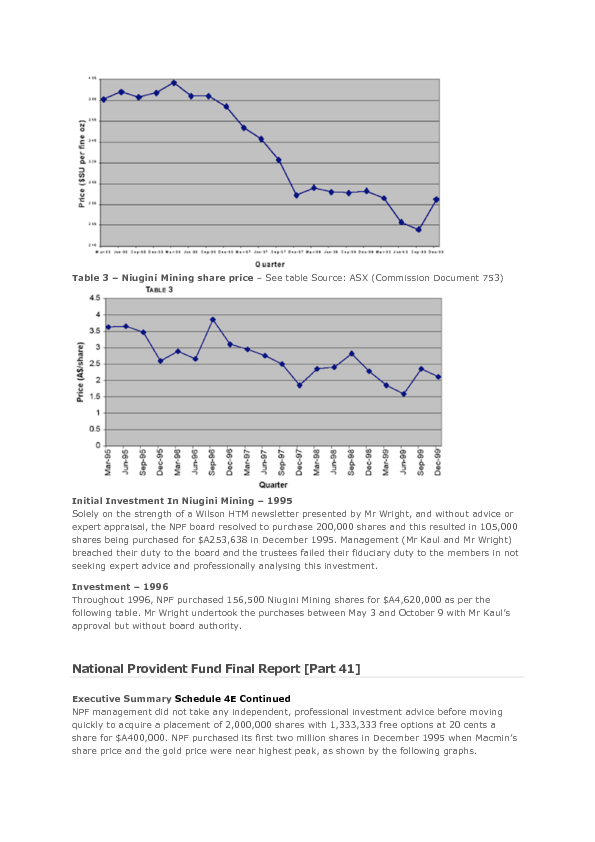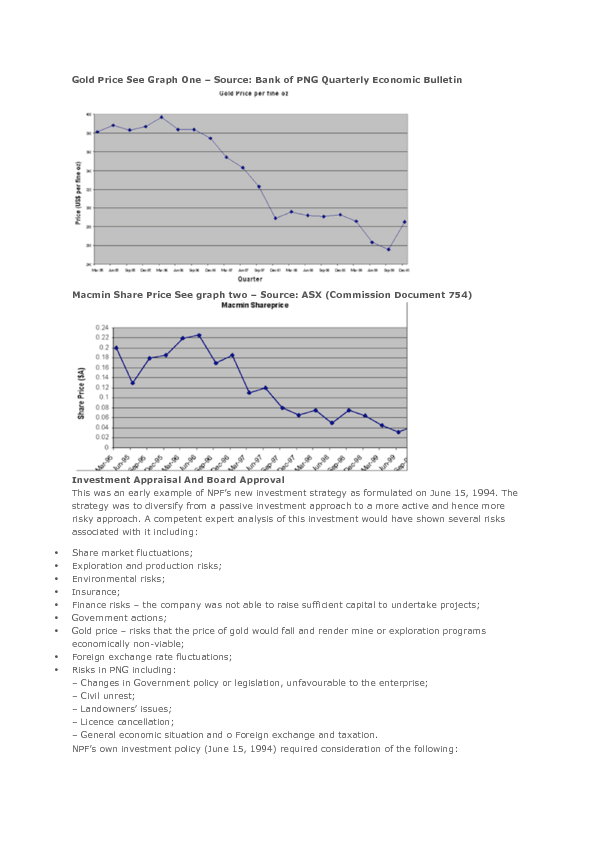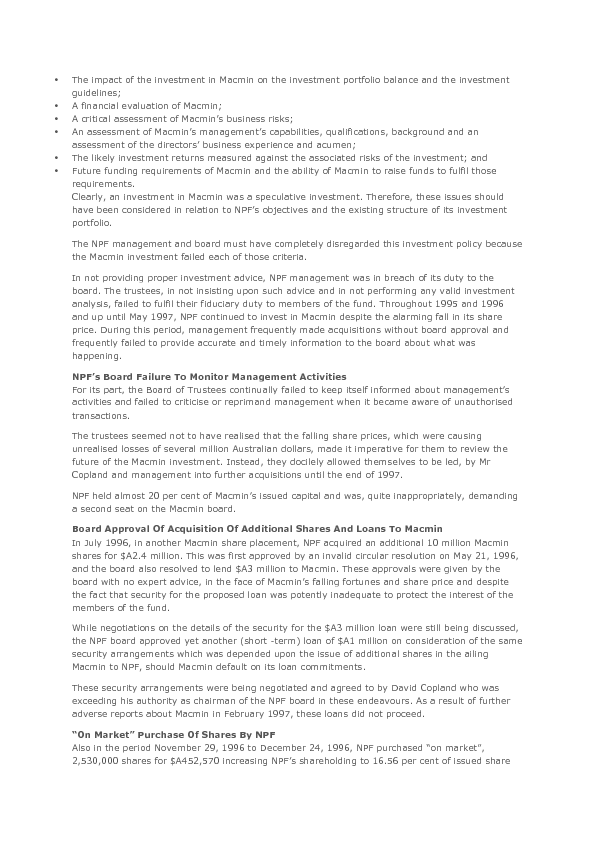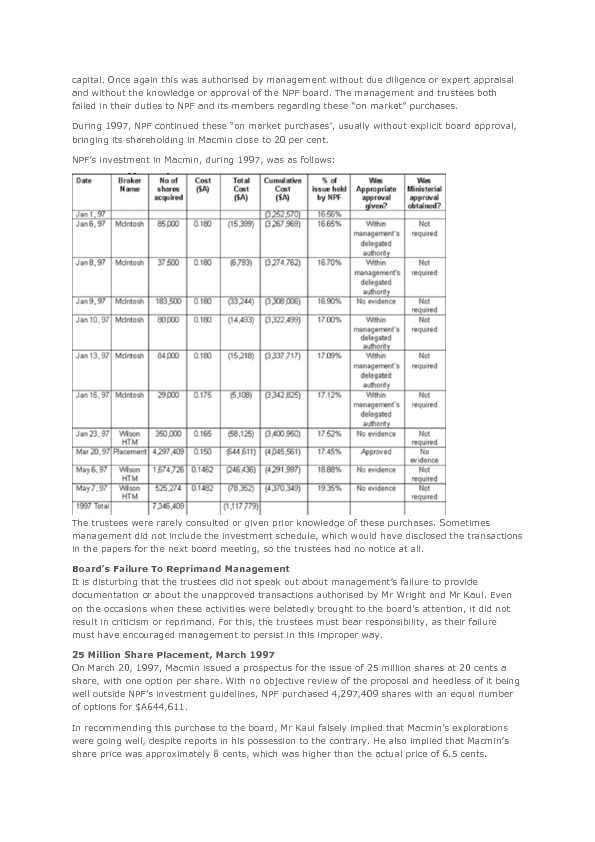National Provident Fund Commission of Inquiry Final Report (Serialization Parts 41-85)
Mentions of people and company names in this document
It is not suggested or implied that simply because a person, company or other entity is mentioned in the documents in the database that they have broken the law or otherwise acted improperly. Read our full disclaimer
Document content
-
National Provident Fund Final Report [Part 85]
Executive Summary Schedule 9 Tender Procedures and Nepotism Continued Findings In paragraph 13.6.1.2, the commission has found that:
(a) The evidence before the commission clearly indicates that Mr Wanji’s conduct in his dealings with Laiks Printing, a company in which he was a shareholder, director and a cheque signatory, was improper. Mr Wanji stood to benefit from NPF, when he obtained quotes from Laiks Printing and recommended Laiks Printing to supply stationery and office supplies. This was not disclosed to the NPF by Mr Wanji;
(b) It is likely that moneys were paid to Laiks Printing well in excess of the fair value of goods and services provided by them
Warenam Office Supplies There were 12 purchases from this company to a value of K80,982.26.
Mr Alopea, the proprietor and manager of Warenam Office Supplies, voluntarily provided details of 16 secret payments to Mr Wanji totalling K12,530 during the period May 3, 1999 to June 14, 2000.
However, in actual fact, Mr Wanji received only K11,280.
Due to a loss of records at Warenam Office Supplies, other payments to Mr Wanji prior to May 3, 1999 could not be ascertained. Mr Wanji has admitted, in his evidence to this commission that these payments were made to him, personally, by Warenam Office Supplies, before May 3, 1999.
Findings At paragraph 13.6.1.5, the commission has found that:
(a) There was an agreement between Mr Wanji and Joe Alopea of Warenam Office Supplies that contracts would be awarded to Warenam in exchange for secret commissions paid by Warenam to Mr Wanji;
(b) On some occasions the secret commission was factored into the price paid by NPF;
(c) The relationship between Mr Alopea and Mr Wanji was criminal in nature. Mr Wanji received more than K11,280 from which he personally benefited. Mr Alopea and Mr Wanji should be referred to the Commissioner for Police for investigation.
Country-wide Business Supplies The commission has found that Mr Wanji received commission from Christopher Enara of Country- wide Business Supplies.
Other companies The commission inquired into Cando Investment and Stephens Enterprises. The investigations showed Mr Wanji received corrupt commissions from these companies.
Findings At paragraph 13.6.2.1, the commission found that:
(a) Given the weak internal control procedures, Mr Wanji used to decide, almost at will, how much to buy and from whom during the period covered. These weak controls resulted in Mr Wanji obtaining benefits from suppliers including the purchase of stationery and office supplies from his company, Laiks Printing;
(b) The benefits Mr Wanji received from the suppliers were in fact “bribes” or “commissions” and not loans;
-
Page 2 of 190
-
(c) The commission considers that there is sufficient evidence of criminal offences of the nature of conspiracy to defraud. The commission recommends that Mr Wanji be referred to the Commissioner for Police for further investigation.
Funds obtained from NPF housing advances scheme Cando Investments Mr Wanji applied for and received K2200 from the NPF Housing Advance Scheme for repair and maintenance work to his house, to be carried out by Cando Investment, which had quoted for the work. However, this money was not used for the said work on the house.
Mr Wanji claimed he engaged another contractor to do the quote, which was completely different from the quote used to obtain the money.
He then requested and benefited from the refund from Cando Investments.
Findings At paragraph 13.8.2.1, this commission has found that:
Simon Wanji dishonestly obtained the payment of K2200 from Cando Investments for his own benefit. The money had been provided by NPF to Cando Investment for a different purpose.
A similar situation occurred with two other NPF officers, Max Noah and Kanora Aua, who requested money from the Housing Advances Scheme and used the money for other purposes than they stated in the request form.
Findings At paragraph 13.8.5, this commission has found that:
(a) NPF advanced the funds for specific work to be carried out by Cando Investments. However, Mr Wanji, Mr Noah and Mr Ava obtained the funds from Cando Investments and either used the funds for a different purpose or arranged for the work to be carried out by a different contractor or both, which was contrary to the purpose for which NPF advanced these funds;
(b) Cando Investments appears to have been a facilitator of these arrangements, taking a 10 per cent commission. The funds should have been reimbursed to NPF but Cando Investments failed to do this and in repaying funds to the NPF member, enabled that person access to his funds not available to other members;
(c) The payments from NPF to Cando Investments may have been made on false representation. Cando Investments may have facilitated obtaining from NPF under this false representation and later paid those funds (less commission) to the NPF member;
(d) The commission considers that there is sufficient evidence of criminal conduct and recommends referral of the following persons to the Commissioner for Police for further investigation as to whether the offence of obtaining money by false pretence or by fraud or conspiracy to defraud has been committed. Simon Wanji, Max Noah, Kanaro Ava and Pere Enara of Cando Investments;
(e) The following matters should also be referred to the Police for investigation:
• Suspicious payments made by suppliers to Mr Wanji; • Mr Wanji’s dealings with Laiks Printing and Bubia; and • Mr Koae’s dealings with Bubia. Concluding Comments At paragraph 14, the commission concludes::
The commission’s investigations have shown that at the beginning of the period under review, there was some attention given to calling for tenders and seeking competitive quotations for procurement of some of the goods and services examined in this report.
-
Page 3 of 190
-
As time went on, these frail attempts to comply with proper procedures lapsed and management increasingly ignored the concept of obtaining competitive quotations.
Management also ignored the need to keep the NPF board informed or seek its approval.
This gross laxity allowed the development of nepotism and criminal acts to defraud the NPF.
It is a very sad story for which NPF senior management is primarily to blame. The NPF trustees, however, had a fiduciary duty to ensure the fund was well managed and its finances were protected.
They failed this duty totally. The abuses were so noticeable that the trustees’ failure to notice and address it, constitutes a breach of their fiduciary duty to the members of the fund and may constitute a breach of the Leadership Code by all trustees who held office during the period under review. This matter should be referred for consideration by the Ombudsman.
Schedule 10 Exemptions: On June 29, 1981, a general exemption was granted to all organisations which were engaged in:
(i) Agriculture industry organisations involved in production of crops or livestock;
(ii) Agriculture processing organisations (including veneer and plywood industries) who are involved in the first stage of processing of agriculture and livestock products, but excludes industries involved in the production and/or processing of fish and other forest products.
This exemption was continued by a series of extensions. On September 30, 1993, Sir Julius Chan exempted all coffee growing and processing establishments “until further notice”.
These general exemptions and extensions for these classes of establishments ignored the very different types of employees in the industries, which ranged from low paid casual rural workers to skilled managers and accountants. Under the exemptions all employees were precluded from joining and contributing to NPF.
Coffee Industry Corporation (CIC) proposes a superannuation scheme This differentiation in types of employees was highlighted when CIC endeavoured to set up its own superannuation scheme for its skilled employees in January 1996.
The NPF board directed management to recommend that the Minister should lift the exemption in relation to the coffee industry so that appropriate employees could join NPF and so employer contributions could be enforced, but enforced fairly “noting the seasonal nature of the industry”.
Exemption lifted throughout coffee industry Minister Haiveta lifted the exemption as it applied to all establishments in the coffee industry, without regard to the different classes of employees, leaving NPF to sort out with individual employers which employees would be covered.
This ad hoc decision-making was unsatisfactory and did not address the same problem, which applied to other exempted agricultural industries.
Findings At paragraph 9.1.2, the commission found that:
(a) Because of the predominance of low paid seasonal rural workers and the low product prices, it was decided to grant relief to this sector by way of a general exemption to those organisations in the agriculture industry and processing. However, there were other employees who were employed by these agriculture establishments who were located and employed in urban areas and were receiving higher urban wages. When granting the exemption to the agriculture sector in 1993, this difference should have been taken into consideration so that those higher paid employees in urban areas are given the opportunity to contribute to the fund;
-
Page 4 of 190
-
(b) When the exemption applying to the coffee industry was lifted in May 1996, the difference between permanent, urban, casual and rural employees was again not sufficiently addressed and the lifting of the exemption simply applied across the board to all establishments in the coffee sector. This led to ad hoc decision making and confusion in the application of the Act.
Specific Exemptions Already Granted According to documents obtained from the Office of Legislative Counsel, the following establishments have been exempted by the managing director under Section 42 of the Act, as they had superannuation schemes at least as favourable as the NPF scheme and the Minister was satisfied the employees wished the exemption to be granted: Bougainville Copper Ltd exempted in 1984 and again in 1986.
Ok Tedi Mining Ltd was exempted in May 1991. From February 1994 until late 1997, the NPF board and management made half-hearted attempts to encourage the unions to lead the OTML employees into the NPF, as OTML management had expressed its willingness. It seems Mr Leahy, Mr Paska and Mr Leonard failed to follow through on this matter. Despite being exempted under Section 42 of the Act, OTML remained liable to report on its superannuation scheme as directed pursuant to Section 43. This was not followed up by NPF.
Findings At paragraph 10.2.1, the commission found:
(a) The statutory instrument does not expressly exempt OTML from Section 43 of the Act; Management failed to advise OTML of this factor during their discussions;
(b) Trustee Leonard failed in his fiduciary duty to the board and NPF by not completing the task given to him by the board through a proper board resolution and his failure to advise the board on the progress or otherwise, about OTML staff move to join NPF.
(c) All trustees and NPF management failed in their duty to proactively pursue the possibility of engaging OTML employees in the NPF scheme.
(d) The exempted establishments remained bound by Section 43 to report to NPF as directed. NPF failed to follow through on this aspect.
National Provident Fund Final Report [Part 84]
Executive Summary Schedule 9 Continued Tender Procedures and Nepotism Management contract price in excess of NPF Board approval The total cost of the new AS400 machine was within the amount approved under Section 61 of the PF(M) Act. However, the amount paid was greater than the earlier quotes provided by Datec to NPF and on which the board provided its original approval.
Evidence given by Mr Ta’eed and Mr Vere of Datec Mr Ta’eed gave evidence (Transcript pp. 8128-42) that:
• The AS400 which NPF had was over utilised; • Datec had advised NPF that a performance analysis of the computer system was required; • The return advice revealed that the system was too small for NPF’s needs, which was already known. Reasons for choosing the AS400 Mr Ta’eed advised that:
• The software NPF required ran only on AS400 machines;
-
Page 5 of 190
-
• A different machine with a different software had to have everything converted to the AS400, which is exactly what happened in 1993 when NPF moved from the McIntosh system to AS400. • NPF was the only authorised reseller of IBM equipment in PNG and the only service centre in PNG. Findings At paragraph 12.5.7.5, the commission found that:
(a) Once NPF had committed itself to Datec and purchased both software and sophisticated unique hardware it, was hooked into Datec/IBM with Datec being the only supplier in PNG. There was then no scope for seeking competitive tenders; and
(b) NPF management and trustees failed their duty to NPF members in not seeking independent expert opinion and advice before making this commitment to Datec.
1999 There were imperfections in NPF accounting records for the financial years 1998 and 1999 as mentioned in paragraph 12.6.
Computer purchase in 1999 See previous table Disposal of computer equipment in 1999 The fixed asset register did not record any disposal of computer equipment in 1999. However, old Y2K non-compliant computers were disposed of by tender, restricted only to NPF staff. This method of disposal of assets can be criticised as a form of nepotism. Clearly, NPF did not determine the market values of these computers and therefore would have lost substantial income for its members.
Findings At paragraph 12.7, the commission has found that:
(a) NPF management were in breach of Section 61 of the PF(M) Act by not seeking board and Ministerial approval for the additional expenditure incurred in the purchase of the new computer hardware;
(b) Management failed in their fiduciary duties for not seeking the maximum price for the used PC’s and other computer equipment sold during this period;
(c) THE Board and Management failed in their fiduciary duties to seek a second opinion about the new computer hardware they were purchasing;
(d) The sale by tender of PC’s and other computer related hardware to staff, without obtaining a proper market value for them, is deemed an act of favouritism and nepotism and loss of additional income to members of the fund; and
(e) Mr Wright exceeded his financial delegation in approving a Bloomberg Screen for his own office use, costing K41,515.03. He is personally liable for the loss suffered by NPF because of this purchase.
Procurement Of Stationery And Office Supplies NPF’s financial statements for 1995 to 2000, recorded various costs for stationery and office supplies.
Costs were constant from 1995 to 1998 but took a quantum leap in 1999.
While the commission understands that some increases can be attributed to the general increase in cost in the country due to economic factors in 1999, the increased cost in stationery and office supplies cannot be fully explained by such economic factors.
This view is clearly supported by the fact that stationery and office supplies cost for 2000, returned to its normal level.
-
Page 6 of 190
-
The main report (Schedule 9), seeks, in particular, to identify whether:
• There was failure to comply with tender procedures; • Such failures benefited any person; • There was any conflict of interest in the procurement of these services. • There was any conflict of interest in the procurement of these services. Summary of suppliers used between January 1, 1995 and December 31, 1999 Out of the total 10 suppliers listed, only four are commonly recognised suppliers. There was also an increase in the amount of purchases from unrecognised suppliers.
The Finance Department inspectors report also uncovered numerous procedural irregularities and weaknesses in this area. The same was found by the Auditor-General in his audit of financial statements for the years ended December 31, 1998 and 1999.
The state of control over procurement, recording and payments — 1995 to 1999 Procurement: Simon Wanji was responsible for ordering stationery and office supplies. There was no management control over what Mr Wanji was doing.
The only control at the time was that each order had to be accompanied by three written quotes.
Recording Creditors Normally in many companies, the monies for goods received would be recorded in the creditors ledger and paid after 30 days.
The NPF accounting package used in the period 1995 to 1999 did not have an auditor’s subsidiary ledger. Creditors were only recommended at year-end for reporting purposes, based on unmatched work orders, purchase orders and claim forms.
Payment of creditors Payment of creditors was ad hoc. NPF did not operate a scheduled payment policy.
Review of payments made Documentation of the procedures in place between 1995 and 1999 in respect of procurement, recording and payment, reveals crucial weaknesses and in particular, the lack of segregation between ordering and receiving goods, and recording liability and payment to suppliers. Given this situation, there was a high risk of nepotism, fraud, theft and errors occurring and remaining undetected.
Weaknesses identified • There was a complete lack of segregation of duties, and functions between ordering, receiving, recording and payment for goods which were, in almost all instances, performed by one officer, Mr W anji; • The minimum number of three written quotes were not always obtained; • Payment requisitions did not always indicate that the cheque raised was for goods and services; and • A creditors subsidiary ledger was not maintained. Benefit derived Evidence before this commission indicated that Mr Wanji derived substantial benefits while in his position as officer in charge of accounts payable.
It is also evident that Siri Koae, through his wife, might have also derived benefits but it was to a much lesser degree.
Findings At paragraph 13.5.5, the commission has found that:
-
Page 7 of 190
-
(a) There were inadequate procedures in place regarding the procurement, recording and payment of stationery and office supplies. These weaknesses are a significant break down in the control and safeguard of NPF finances;
(b) The controls, which were in place for the procurement, recording and payment of stationery and office supplies, were weak and therefore provided the conditions for nepotism and employee fraud to occur and remain undetected;
(c) Management failed to address procedures for a long time. Through the review of the payment vouchers the commission has come across written notes by Ms Dopeke and once by Henry Fabila, notifying Mr Wanji to obtain three quotes and queries as to why so much stationery was being purchased. These comments were ignored;
(d) These weaknesses resulted in nepotism, “bribes” and other benefits to staff at the expense of NPF;
(e) Mr Wright and Ms Dopeke failed in their duties to the board to identify weaknesses and install appropriate controls and procedures in the financial management of the fund.
Siri Koae Mr Koae was the manager of the NPF Lae branch between October 1993 and January 1999.
Mr Koae gave stationery and office supplies orders to Bubia, a firm of which his wife, Ms Lari, was co- owner. Ms Lari was also a director of Laiks Printing, a company that provided stationery and office supplies to NPF.
Mr Koae maintained that he received no benefits from Bubia or Laiks Printing.
Findings At paragraph 13.7.4, the commission has found that:
While the evidence does not disclose any criminal act by Mr Koae, his actions were in the commission’s view, improper and dishonest in that he disclosed quotes of other competitors to Bubia and failed to disclose his clear conflict of interest to NPF management.
There is a clear case of nepotism.
Examination of benefits received by Mr Wanji Laiks Printing Mr Wanji was a director of Laiks Printing as well as a cheque signatory on its cheque account.
Ten of 15 quotes from Laiks Printing were obtained verbally by Mr Wanji and he recommended that NPF purchase from Laiks Printing.
National Provident Fund Final Report [Part 83]
Executive Summary Schedule 9 Continued Ken Yapane & Associates Ken Yapane & Associates were employed to refurbish an office on the ground floor of NPF’s Head Office. This work was not tendered and Ken Yapane was paid an exorbitant K40,000 contract sum in advance without any work being done on the office refurbishment. He paid half this amount back to Mr Maladina. This same Ken Yapane was also involved in the NPF Tower fraud when Mr Maladina utilised Mr Yapane as a notional contractor and laundered money through his bank account to transfer money from Kumagai Gumi to Carter Newell’s office. Mr Maladina paid Mr Yapane a generous commission for his service. The similarities between Mr Yapane’s role in the Tower fraud and this office refurbishment contract are compelling. In both
-
Page 8 of 190
-
cases, the payment from Mr Yapane to Mr Maladina was laundered through the Carter Newell John Losuia account then paid to Mr Maladinas company, Kuntila No. 35 Pty Ltd. The commission has found that the advance payment to Mr Yapane of K40,000 for work he did not do was improper, that Mr Leahy was knowingly involved and that the ultimate beneficiary was Mr Maladina. Findings At paragraphs 9.3.5 and 9.6.1, the commission has found that: (a) The advance payment to Mr Yapane & Associates was improper. Management, and more specifically, Mr Leahy should be held responsible as he was the one responsible for authorising this payment; (b) Mr Leahy was responsible for fabricating the minutes of a fictitious NPF board resolution increasing his financial delegation to K50,000 in order to enable him to authorise the payment of K40,000 to Mr Yapane; (c) Mr Leahy should be held accountable for improperly paying K40,000 to Mr Yapane because no work had been or was done; (d) Management failed in their fiduciary duties to properly tender this job and obtain board approval for this expenditure; (e) The fact that Mr Maladina demanded and received at least K20,000 of the fees paid to Mr Yapane is grossly improper; (f) The evidence of criminal interest and association coupled with the evidence of similar conduct in the NPF Tower fraud involving the same persons strongly suggests that there was a criminal conspiracy to cheat and defraud the NPF involving Mr Maladina, Mr Leahy and Mr Yapane which was successfully implemented; and (g) MR Maladina, Mr Leahy and Mr Yapane should be referred to the Commissioner of Police to consider whether criminal charges should be laid against them. NEC Secretariat In September 1996, Hon. Chris Haiveta wrote to Mr Kaul and requested a donation towards the payment of sing-sing groups that were to perform at an NEC meeting in Vanimo. Mr Haiveta has given evidence (Transcript p. 8477) that he asked NPF management if they could help.
He was not told that NPF was not able to help. He said (Transcript p. 8479) that at the time he requested NPF to help, NPF had previously given donations and sponsored other activities like golfing days. Mr Kaul responded positively to this request. Findings At paragraph 9.7.1, the commission has found that: (a) MR Haiveta’s request for K1600 was improper and he should be referred to the Ombudsman Commission to consider taking action for a breach of the Leadership Code; (b) THE decision by Mr Kaul and Mr Wright to agree to the payment was a breach of their duty to the members of the fund and amounted also to improper conduct; (c) AS Mr Kaul was subject to the Leadership Code, he also should be referred to the Ombudsman Commission. Disposal Of Assets During the period covered by this enquiry, NPF disposed of some office furniture and equipment through tenders restricted to NPF staff members and by “in-house” raffles to fund Christmas parties and the like. This action by management deprived members of the fund from realising maximum financial benefits from the sale of these assets. Findings In paragraph 10.3, the commission has found that: The sale of NPF assets, such as the Kwila table and television and video deck, to staff without determining a reserve price for the items and without open tender, can lead to accusations of
-
Page 9 of 190
-
nepotism against NPF management. This method of disposal is also contrary to Government procedures on disposal of assets by organisations like NPF. Procurement Of Computer Hardware And Software It is relevant to note that the underlying data of members records were held in the Niugini Assets Management (NAM) operated system. At the February 18, 1993 board meeting, it was noted that NPF were in discussion with NAM to purchase NAM’s system. At the July 30, 1993 board meeting, the board resolved for management to explore other alternatives. At the August 30, 1993 board meeting, the minutes show that management had negotiated a lease arrangement with McIntosh Securities in respect of computer hardware and software. Datec were appointed as advisers to NPF in late 1993, and undertook to review NPF’s software requirements. Datec recommended in their proposal, that following Datec’s development of the new software, NPF would be entitled to a 50 per cent interest in the proprietary rights, and that Datec would market the software to other clients. At the June 29, 1995 board meeting, the minutes record that NPF had shifted over to the new computer system with effect from May 12, 1995. Datec recommended that NPF utilise an AS400 platform and that Datec would develop software tailored to NPF requirements. The suitability of this recommendation was not challenged by NPF. Cost of computers The decision to develop the company’s own software on the AS400 platform, came at a significant cost to NPF. As at December 31, 1999, the following computer costs, including consumables, had been expended:
Software development costs between January 1, 1995 and December 31, 1999 were as follows:
At no point did NPF management seek board or Ministerial approval for the extra expenditure, other than obtaining original approval to utilise K219,000 for the first phase of this project. Computer hardware 1995 From the authorised auditors files, NPF had the following computer hardware as at 1st January 1995.
-
Page 10 of 190
-
1996 According to the fixed assets register, NPF only acquired one computer and disposed of two computers in 1996. The disposed computers were fully written down in the books. The commission has been unable to determine what happened to these two computers. 1997 The table below shows the status and value of computers held by NPF in 1997.
The table below shows computers purchased in 1997.
Findings At paragraph 12.4.1.1, the commission has found that: From the commission’s review of the pattern and manner in which NPF purchased computer equipment, we find that:
(a) The purchase of computer equipment was adhoc and did not comply with annual budgets or a specific IT plan; (b) There is no evidence that NPF sought to negotiate better than normal prices with any supplier; (c) From 1998 onwards, NPF purchased predominantly from Tanorama Limited and Datec, with no documented attempts to extract better prices from these suppliers; and (d) Judging by the payment requisition records, the purchases from Tanorama Limited and Datec were made without reference to any comparison of prices from other suppliers.
1998 There are imperfections in NPF’s accounting records for the 1998 and 1999 financial years because the fixed asset register does not reconcile with the general ledger. The following computer items “disappeared” from the register without explanation.
-
Page 11 of 190
-
• 1 Compliance Section PC; • 3 IBM PC’s from MD’s office; and • 1 UPS from operation. With regard to the acquisition of other computers in 1997, NPF management obtained quotes from various suppliers before making a commitment to purchase the equipment. There is no documentary evidence found by the commission that would suggest that NPF management or the trustees sought to establish a documented and formal purchase policy in respect of computer equipment. The purchase of computer equipment, particularly at NPF where IT is a critical function, required careful scrutiny by management and the trustees, both in terms of enforcing an appropriate and proper functioning system, but also because of the high level of cost involved. Computers purchased in 1998 Chq No 20953, 15-Sep, Datec (PNG) Ltd, K587,837.07(amount), K587,837.07 (capital), AS400 hardware, 9406-620-2175, approved by board, See ref 2, no other quotes attached; Chq No 0952, 15-Sep, Tanorama Ltd K9301.67 (amount), K4789.50 (capital), two P166 multimedia packs for Ms Dopeke / J Sema, approved by Ms Dopeke, within delegation, no other quotes; Chq No 20952, 15-Sep, Tanorama Ltd, K2220 (capital), one P166 mmx 15” monitor, approved by Ms Dopeke, within delegation and no other quotes; Chq No 20952, 15-Sep, Tanorama Ltd, K695 9capital), HP Scan jet Desktop scanner, approved by Ms Dopeke, within delegation, no other quotes; Chq No 20952, 15-Sep, Tanorama Ltd, K955.75, procurement plus set up, approved by Ms Dopeke, within delegation, no other quotes; Chq No 20252, 27-May, Tanorama Ltd K21,060.86 (amount), 26,450.40 (capital), 12 P166MMX 16Mb RAM 2.5gb, 15”, approved by Mr Wright, see ref 1 below, no other quotes; Chq No 20253, 28-May, Tanorama Ltd, K9146.40 (capital), four P166MMX 32Mb RAM 2.5gb, 15, no other quotes; Chq No 20254, 29-May, Tanorama Ltd, K700.40 (capital), software, no other quotes; Chq No 20255, 30-May-98, Tanorama Ltd, K1814.86 (capital), procurement charges, no other quotes; Cheq No 20256, 31-May-98, Tanorama Ltd, K3840 (capital), set up costs, no other quotes; Chq No 20256, 31-May-98, Tanorama Ltd, K169.65 (capital), sales tax, no other quote; Chq No 19892, 27-Mar-98, Tanorama Ltd, 21,060.86 (amount), items detailed above, approved by Mr Wright, see ref 1 below, no other quotes Chq No 19665, 26-Feb-98, Datec (PNG) Ltd K8667.56 (amount), K5065.54 (capital), two Datec Millennium internet and monitor, approved by Mr Wright, within delegation, no other quotes; Chq No 2108, 24-Jun-98, Datec (PNG) Ltd, K64,129.97 (amount), K64,129.97 (capital), 10 per cent deposit on AS400 machine, approved by Mr Wright, see ref 2, no other quotes. Total: K707,814.54 Purchase of AS400 machine The purchase of the new AS400 computer hardware seems to have resulted from concerns about the “Year 2000 Bug” and the capacity and efficiency of NPF’s current computer system to cope beyond the year 2000. Failure to seek analysis by an Independent expert Quite glaringly, NPF did not seek independent advice about the AS400 machine. However, it is apparent that NPF relied on Datec’s recommendation. There is no evidence that NPF sought a second opinion on its proposal to purchase this AS400 machine from an independent computer consultant.
-
Page 12 of 190
-
National Provident Fund Final Report [Part 82]
Executive Summary Schedule 9 Continued Fees Paid to accountants in 1996 1997 and 1998
The situation in 1998 remained basically the same as the previous three years. However, as far as outsourcing of accounting work was concerned, a significant part of the costs at the end of 1998 was charged to 1999 accounting cost.
When Noel Wright (a qualified chartered accountant) left in January 1999, the responsibility for the accounting positionmoved to Salome Dopeke.
-
Page 13 of 190
-
The commission finds that Ms Dopeke was not suitably qualified and experienced and lacked appropriate skills to take on this role. A draft section 8 letter prepared by the authorised auditors for the year ended December 31, 1998, included items that deal with weaknesses in the accounting area and requested NPF to address these weaknesses.
NPF therefore sought out accounting firms to assist them in having their accounts brought up to date.
Appointment Of Ram Business Consultants (Ram) Jimmy Maladina engaged this firm as auditors and investigators for Crocodile Catering. The engagement was made without reference to the Crocodile board or the shareholders, (the NPF board). This appointment was made contrary to proper tender procedures. This firm was also most expensive. This commission considers the fees charged by Ram were excessive for the actual time they worked for NPF.
Appointment Of Pricewaterhouse Coopers (PwC) Fees paid to PwC were related to several distinct engagements. This commission found that work performed by PwC was agreed to in advance between NPF and the firm, and was confirmed by a letter of engagement. It is noted that NPF sought quotes before engaging PwC.
Fees paid to Accountants in 2000 relating to 1998 and 1999 financial statements
In 1998 and 1999, KPMG billed additional audit fees direct to NPF for additional work in assisting NPF in the preparation of their annual financial statements in a format compatible with International Accounting Standards.
Tender Procedures Adopted In November 1999. From 1995 to 1999, NPF management used its discretion to appoint key advisors and professional service providers. Then in early 1999, chairman Mr Maladina made the appointments without reference to the NPF board. This is contrary to normal procedures used by NPF in the procurement of professional services, including accountants.
Findings At paragraph 8.9.6, the commission has found that:
-
Page 14 of 190
-
(a) During the period January 1, 1995 to December 31, 1999, NPF engaged the services of the following accounting firms for various accounting and tax related services:
• Ernst & Young in the period 1995 to 1998 as tax agents and tax advisers; • Deloitte Touche Tohmatsu in 1999 as tax agents and tax advisers and to do sundry accounting services with regard to the Ambusa Copra Oil Mill Project; • PwC in 1999 as business advisers including inter alia a review of the fund’s investment portfolio and a review of the financial position at December 1999; • Ram in 1999 for accounting assistance (and in particular the completion of bank reconciliations for 1998); • Auditor-General — for the 1995 to 1997 financial years authorised auditor was Deloitte Touche and for 1998 to 1999, the authorised auditor was KPMG; (b) Almost without exception, NPF did not seek to tender the fund’s tax and accounting related work and as such NPF management failed to ensure the fund received the most cost effective service during the period 1995 to 1999;
(c) Following the departure of Mr Wright in January 1999, the weaknesses in the fund’s accounting systems and resources resulted in the need for the fund to out source accounting and business advice from the abovementioned professional accounting firms;
(d) These weaknesses in the accounting function also resulted in the significantly high level of additional audit costs levied by the authorised auditors, KPMG. In relation to the 1998 and 1999 financial statements, KPMG billed NPF direct contrary to normal procedures where audit fees are usually billed by the Auditor-General;
(e) With the exception of Ram, there is no evidence that favouritism or nepotism existed in the appointment of any of the professional firms. However, the lack of transparency and tender procedures in the appointment of these professional firms leaves a general suspicion that favouritism may have existed in relation to non-audit services, particularly with regard to Ram;
(f) There is considerable evidence connecting Rex Paki of Ram and Mr Maladina during the time that Mr Maladina and Mr Leahy were actively conspiring to defraud the NPF. Mr Paki also received benefits in the form of cash and airfares from the proceeds of those frauds;
(g) Examining the process of appointing Ram to provide services for NPF, the commission finds that it was similar to Mr Maladina’s improper appointment of Ram as financial consultant for Crocodile (see Schedule 3A);
(h) On all the evidence, the commission finds that the appointment of Ram by the NPF board, which was not properly briefed, was strongly influenced by Mr Maladina. Mr Maladina’s co- conspirator in the criminal conspiracy to defraud NPF, Herman Leahy, then proceeded to approve the payment of Ram’s excessive fees without seeking the required NPF board approvals.
(i) The commission finds that the appointment of Ram and the payment of their excessive fees on the approval of Mr Leahy constituted nepotism within the meaning of the commission’s terms of reference;
(j) There also exists a significant level of concern as to the probity or otherwise of fees charged by Ram. The limited documentary evidence in the form of the working papers, fees and correspondence files, produced under summons to this commission by Ram, to support the fees paid by NPF, indicates that the fees charged by Ram were excessive.
(k) Management acted in excess of their delegated financial authority by approving Ram’s fees without referring them to the board.
Other Professional Services During the period covered by this review (1995 to 1999), NPF hired other firms to carry out specific work requirements. These firms are:
-
Page 15 of 190
-
1. Hay Group of Companies; 2. Ken Yapane and Associates 3. Freehill Hollingworth and Page; 4. E&S Groups; 5. Minao Surveys; and 6. Sogu Works. The finance inspectors closely scrutinised the arrangements between NPF and the above firms and concluded they were in order, with the exception of Ken Yapane and Associates. The commission accepts and agrees with those findings.
National Provident Fund Final Report [Part 81]
Executive Summary Schedule 9 Continued Mt Tapi Brothers Mt Tapi Brothers Ltd (MTB) had associations with Mr Skate as it provided security services for the Prime Minister’s residence and family and for some of his Ministers. The telephone contact number MTB provided NPF was one of Mr Skate’s official numbers. Also at a later date, Mr Skate actively intervened on behalf of MTB (see below).
Mt Tapi Brothers Forceful Initial Approach On February 23, 1999, MTB offered to provide security for all of NPF’s properties. In its initial letter it pointed out its close connections with the Prime Minister and enclosed a draft contract. Mr Fabila received the letter on February 24, 1999 and immediately granted a contract to MTB, in the full knowledge that NPF was contractually bound to Metro and Kress.
On February 26, Mr Fabila wrote to Kress and Metro arbitrarily terminating their contracts as from February 28, enclosing cheques for payments due to that date.
Mr Fabila also wrote to MTB granting a 12-month contract, with a three-month probationary period. He then wrote to Century 21, which was still managing NPF properties, directing them to terminate any current security contracts for the investment properties and to make way for the new security guards to commence work from 1st March 1999.
Metro accepted the termination of its head office contract without a fight.
Kress on the other hand demanded K199,844.80 for wrongful termination of its contract. Kress received K8283.60 from NPF for the Nine-Mile properties for January and February and K22,754.40 for its other contracted properties prior to its contract being terminated. Its claim for breach of contract was eventually settled out of court for K40,684.80 (being three months payment in lieu of notice plus costs).
MTB Contract Mr Leahy prepared a contract on March 29, 1999 granting the security services for all NPF properties to MTB. The contract followed the draft presented by MTB with a few very minor amendments.
The first invoice for the period March 3, 1999 to April 7, 1999 was a phenomenally high K45,792, yet reports were being received that the service was very poor. When Mr Fabila complained about the exorbitant cost, the number of guards was cut from 52 down to 17. From March to August 1999 the complaints about the MTB security guards were pouring in.
NPF records show that the following payments were made to MTB in 1999: (See table)
-
Page 16 of 190
-
In October 1999, the NPF board resolved to terminate the services of MTB for the properties being sold off by NPF and the purchasers were advised that they could contact MTB if they wished to reemploy that firm. This resulted in MTB instituting court proceedings claiming K200,000 from NPF, which had been rejected by the NPF board. On June 21, 2000, Shirley Marjen noted on an NPF file:
“File Note — Tapi Bros Security Service Bill Skate phone me at home on 20/06/00 at about 8.00pm asking me if I could assist with Mr Tapi Bros claim of about K200,000.00 I told Mr Skate that it would not be possible as NPF had objected to the claim and that Mr Tapi Bros can proceed to sue NPF if it wished to.
“I also told Mr Skate that if the matter went as far as the National Court, NPF would defend the matter vigorously.” (Exhibit N401)
In evidence to the commission on December 12, 2001 (Transcript pp. 9897-9902), Mr Skate admitted that the head of MTB Mr Okil, was employed on his Prime Ministerial staff and that MTB provided security services for himself and his family. He denied holding any interest in MTB or putting pressure on NPF to employ MTB. He said that if MTB played upon its close association with the Prime Minister, it was without his knowledge or authority.
Findings (a) Both Mr Fabila and Mr Leahy failed in their duty to NPF in the way they handled the security services arrangements. As a result of these failures, NPF:
(i) suffered a K41,684.80 loss, paid to Kress Security, plus the related legal costs paid to Maladinas Lawyers; (ii) may well be at risk of a similar claim or suit by Metro Security;
-
Page 17 of 190
-
(iii) paid the very large security bill for the period March 3 to April 7, 1999 (K45,792) which, as later costs show, was for services vastly in excess of NPF’s reasonable security service needs; and (iv) faces possible further risk in the pending litigation with MTB. (b) Mr Fabila and Mr Leahy face personal liability to NPF in relation to their failures outlined above which led to NPF’s loss. They would have great difficulties pleading a defence of “acting in good faith”;
(c) Mr Fabila and Mr Leahy disregarded the proper tendering process when engaging MTB;
(d) The commission finds that nepotism and political interference were operating in the actions of Mr Fabila and Mr Leahy in their handling and engagement of security firm MTB; and
(e) The action by Prime Minister Skate in telephoning Mrs Marjen on behalf of MTB was improper conduct. The commission recommends that the constituting authority refer this matter to the Ombudsman Commission to investigate Mr Skate’s conduct and his possible links to MTB to consider possible breaches of the Leadership Code by Mr Skate.
As MTB’s legal proceedings in the National Court against the NPF are still pending, the commission refrains from further comment about the roles of the various persons involved.
The finance inspector’s report, which examined and detailed irregularities in the security contracts, is summarised in paragraph 7.8.1. The finance inspectors focused on the failure to call tenders; failure to verify invoiced charges; advance payments; overpayments; extra legal amendments and failure to obtain the authority of the NPF Board of Trustees. The schedules to the finance inspectors report contain details of persons who authorised all the payments referred to and detailed calculations of the overpayments made to Kress Securities of K7632 (Schedules 3.1 and 3.2) and overpayments to MTB of K16,896 (Schedule 3.5). No attempt has been made by NPF management or the board to recover these amounts.
The commission records its agreement with the finance inspectors findings on these matters.
120th NPF Board Meeting At the NPF board meeting on September 29, 1999, Trustee Jeffery and Mr Mitchell asked detailed questions about the failure to tender security contracts; the termination of Kress and the appointment of MTB without competitive tenders. Mr Fabila’s answers were very unsatisfactory and it was resolved that:
“Resolution: “It was resolved that all security contracts adhere to proper tender procedures. It was further resolved: (i) THAT the vendor for each property sold be advised in writing after contracts of sale be exchanged and that security on the property then becomes the purchasers responsibility; (ii) THAT MT Tapi Brother be advised that their services are no longer required for each property when sold, however, allowing for the appropriate time for vendors to engage new security services; (iii) THAT NPF put out tenders for the Tower and remaining properties; (iv) THAT at the end of the property rationalisation that MT Tapi Brothers be given three months notice of termination.” (Exhibits N423-4) The now active NPF board held a special meeting on October 8, 1999 to consider a special report by Mr Jeffrey and Mr Mitchell. Mr Leahy was given time to answer searching questions. His reply, when it came, was evasive.
The changing of security arrangements in 1999 entailed breaches of contract and unnecessary cost to NPF. As corporate secretary, legal counsel and operations manager Mr Leahy had a duty to give proactive advice to Mr Fabila and the NPF board on these matters. He failed in that duty.
Findings
-
Page 18 of 190
-
At paragraph 7.8.4, the commission has found:
(a) NPF paid Metro Security K6830.20, Kress Security K8283.60 and MTB K199,560 for security services in 1999, aggregating K214,673.80. In addition, the payment of damages and legal costs made to Kress Security of K41,684.80, increased this total to K256,358.60 (It is necessary to deal with a single total, as the payments to MTB have not been split, in the commission’s calculations, between head office and other properties);
(b) The actual security costs included in the 1999 Income and Expenditure Account are; K223,223 for “Rental Property Expenses” and K54,542 for “Head Office Expenses”, aggregating K277,765. The difference of more than K21,000 cannot be explained by adopting a cash against accruals basis of calculation and the commission is not able to explain a difference of this magnitude;
(c) The decision by Mr Fabila to terminate the less costly services of Metro and Kress and to appoint the more expensive MTB was made in two days, without competitive bidding or advice. It cost NPF dearly in terms of:
(i) A payout to Kress of K41,684.80 for breach of contract; (ii) AN enormous initial bill of K45,792 from MTB for the first month for services, which were massively in excess of NPF’s actual needs; (iii) THE legal risk to NPF of a like wrongful termination suit from the second terminated contract; and (iv) litigation now pending before the National Court by MTB whose services, under a legally deficient contract, were also subsequently terminated. (d) MR Leahy was remiss in his duty in not proactively advising Mr Fabila against the foolhardy course on which he was embarking; (e) The contract awarded, without contest, by Mr Fabila to MTB Ltd was politically influenced by the close association with that company of Mr Fabila’s political appointer, the former Prime Minister Hon. Bill Skate and constitutes an example of nepotism in the award of that contract.
Concluding comments The commission concluded that:
“As with other topics in this report, it does seem that in 1994-5, both the NPF board and senior management appreciated the need to tender and obtain competitive bids for the provision of security services for the NPF Head Office and for the NPF properties rented to third parties.
Even then, when tenders were obtained and considered in March/ April 1995, there were competitive tenders for the rental properties only, but not for the head office. The board of trustees made the decision to contract in this instance.
Thereafter and until the end of 1999, all NPF security service contracts were let without tender and without any competitive bidding process and contrary to Government procedures for the procurement of services.
The board of trustees was only consulted once during this period — in October 1996 — over the change of security provider at NPF’s head office. On that occasion the board delegated the decision to management.
Otherwise, all other decisions about security services were made at management level.
The situation reached absurd proportions in February/March 1999 when Mr Fabila made a hasty decision to terminate the services of the two contracted security providers in favour of a single more expensive alternative — Mt Tapi Brothers Limited.
He did this without seeking advice or making inquiries and did so without referral to the NPF board”.
Procurement Of Accounting Services Background
-
Page 19 of 190
-
In house accounting capabilities during the period under review were as follows.
Noel Wright, a qualified Chartered Accountant who was originally employed as compliance manager, later became finance and investment manager and deputy managing director. He resigned from NPF in January 1999. He was replaced by Rod Mitchell who is not a qualified accountant. This was the time when NPF struggled to come to “grips” with its financial crisis.
Salome Dopeke was the chief accountant — she was a graduate accountant but had not passed all her PNGIA examinations and as such was not a formally qualified accountant.
It is therefore important to note that the accounting capabilities of NPF were weak and lacked professional efficiency and effectiveness. There were other specialised accounting requirements, which were outsourced to local accounting firms in Port Moresby.
Fees Paid To Accountants — 1995 Other than the above fees and audit related fees there were no external accounting fees incurred in 1995 and it is inferred all other accounting needs were satisfactorily handled in-house.
NPF utilised the services of the accounting firm Ernst & Young as tax agent from 1995 to 1998. There is no evidence of favouritism or nepotism in the appointment and continued engagement of Ernst & Young.
The audit of the financial statement of NPF is the responsibility of the Auditor-General’s office (AGO). In the case of NPF, the AGO subcontracted Deloitte Touche Tohmatsu to audit NPF’s accounts until the year ended December 31, 1997. There was scope for nepotism by NPF in this arrangement.
National Provident Fund Final Report [Part 80]
Executive Summary Schedule 9 Continued 1999 Outsourced legal fees for 1999 are reported in paragraph 6.4.7.
The state of the NPF records makes it difficult to separate fees for general work from investment related legal work so they are considered together.
The total comes to K442,648.12 plus $A871.90 paid to 11 different firms.
The massive amount of K202,023.46 went to Carter Newell (and an extra K17,602.58 described at paragraph 6.4.8).
Maladinas Lawyers was paid K17,653.50 for work which should have been handled “in-house”, including K5000 for fees relating to the Employers Federation challenge to Mr Maladina’s appointment, which should not have been paid by NPF at all.
Both large and small matters were briefed to Carter Newell in 1999.
Findings
-
Page 20 of 190
-
(a) Substantial fees were again paid to offshore legal firms in relation to the $A bond (Allen Allen & Helmsley) and the Cue Energy Resources situation (Freehill Hollingdale & Page) on the basis of their complexity and the need for specialised legal expertise;
(b) Fees paid domestically for board restructure advice (from Allens Arthur Robinson) and some of the work referred to Maladinas, Fiocco Posman & Kua and Carter Newell, were properly outsourced because of the complexity and the need for specialised legal expertise;
(c) There is insufficient detailed evidence to enable the commission to comment on matters referred to other firms;
(d) There is a discernable trend whereby more work was referred out to external lawyers, which should have been capably handled by NPF’s “in-house” lawyers; and
(e) The level of fees suggests that matters of lesser significance were also referred to Pattersons, Henaos and Young & Williams.
The commission summarises the evolving situation regarding outsourcing legal frees at paragraph 6.5.
Summary In the period under consideration, external legal fees paid by NPF for work outsourced grew in the period under review as follows:
To a very large extent, the massive increases in 1998 and 1999 reflected the need to obtain expert and specialised advice in relation to legal transactions in which NPF became involved.
It is equally apparent that there was an increasing trend to brief out to external lawyers matters, which should have been within the competence of NPF’s “in-house” legal staff. This was reflected in the legal fees paid in 1998 and 1999.
The clear major beneficiary of that trend was Carter Newell Lawyers and, to a lesser extent, Fiocco Posman & Kua and an even lesser extent, Maladinas.
At paragraph 6.4.8.12, we said there may have been further legal fees paid to Blake Dawson Waldron and Carter Newell after August 31, 1999 and that this might explain the difference of about K21,000 in fees referred to on that page.
Additional payments From NPF’s cheque payment records, the commission further extracted the following payments, which were made after August 31, 1999, and not included in earlier material.
Gadens Lawyers (Adding to paragraph 6.4.8.1 and Transcript p.7589) A payment of a further K2342.95 was made on December 21, 1999 for advice for Ambusa on its copra oil purchase and sales agreement and operations management contract.
Blake Dawson Waldron (Adding to paragraph 6.4.8.6 & Transcript p.7592) Two further payments were made:
(a) on November 8, 1999, for K9995.56 for advice as to a dispute with Boroko Motors; Pacific Finance Superannuation Fund; debt restructure and a review of Garry Jewiss’ contract with Crocodile Catering;
-
Page 21 of 190
-
(b) on December 6, 1999, for K26,743.77 payable to Blake Dawson Waldron Melbourne Australia office, for advice on the sale of shares in Cue Energy Resources.
Carter Newell (Adding to paragraph 6.4.8.7 and Transcript p. 7595) Three further payments were made:
(a) on November 8, 1999, for K6048.04 for advice as to exemptions under Part VII of the NPF Act and for Mr Mitchel’s employment contract;
(b) on December 2, 1999, for K4087.79 for advice on NPF’s Investment Portfolio involving Deutsche Morgan Grenfell; and
(c) on December 21, 1999, for K7466.75 for advice and work done on the sale of shares to NPF in Kundu Catering; general matters on NPF Tower leasing and a claim by Cue Energy Resources.
The supporting vouchers and invoices are Part M of CD1226. The aggregate of these further payments was K56,648.56 and results in the difference of K21,000 becoming an excess of K25,000.
The commission’s accounting advisors have stated that this difference is probably explained by the manner in which NPF has treated the VAT component in the payments made.
Investigations In late 1999, the finance inspectors and then the NPF board itself, carried out inquiries into irregularities concerning Mr Maladina and Mr Leahy which included questions about their conflict of interest in briefing legal work to Carter Newell, in which firm Mr Maladina was a partner and Mr Leahy’s wife, Angelina Sariman, was employed.
Although their clear conflict of interest was raised with them, Mr Maladina and Mr Leahy vigorously denied any conflict. Failure to put legal outsourcing out to tender was not, however, raised by the inspectors.
As reported in paragraph 6.6.3, NPF started to brief Carter Newell only after Ms Sariman commenced work with that firm. She was recorded as the work author for 46 of the first 50 new files Carter Newell opened for NPF.
A calling for tenders for legal work was belatedly raised in October 1999 by Mr Giregire and an advertisement was placed in the newspapers.
Findings (a) Mr Leahy’s conflict of interest regarding outsourcing legal services to Carter Newell is clear. When Mr Leahy briefed out work to this firm where his wife was employed as a lawyer. This amounted to nepotism.
(b) When Mr Maladina became chairman of the NPF Board of Trustees, a further conflict of interest clearly arose, as he was also a partner in Carter Newell;
(c) When Mr Leahy referred legal work to Carter Newell, of which the chairman, Mr Maladina, was a managing partner, it was clearly nepotism. This was also improper conduct by Mr Leahy and a breach of his common law duty to the NPF board;
(d) Mr Maladina never declared his conflict of interest to the board of trustees. This amounted to improper conduct and a breach of his fiduciary duties to the members of the fund;
(e) Mr Maladina, as an equity partner in Carter Newell, benefited from legal work being referred by Mr Leahy to Carter Newell;
(f) Mr Leahy benefited by having his wife employed and continuing to be employed for reward by that firm;
-
Page 22 of 190
-
(g) Paying overseas law firms through NPF’s account with Wilson HTM Brisbane, breached the BPNG Foreign Currency Exchange Act and was therefore illegal; and
(h) Management breached normal government tender procedures by not going out to public tender for the provision of legal services.
Procurement Of Security Services Pre-1995 The commission’s terms of reference requires it to examine the procurement of security services for the period commencing January 1, 1995 until December 31, 1999. To understand the situation at the beginning of 1995, however, it is necessary to look briefly at earlier events.
Awarding and terminating NPF’s contract with Kress Securities On October 7, 1993, Mr Kaviagu, the NPF financial controller, awarded a contract to Kress Security Services beyond the scope of his delegated authority and without following proper tender procedures and evaluation. On December 8, 1993, Mr Kaul issued a memorandum directing that tenders for security services must be submitted to him, with recommendations, for his approval.
On December 21, 1993, Mr Kaul declared the Kress contract to be null and void and put the contract out for be re-tender. Kress refused to tender but sued NPF for breach of contract instead. This matter was eventually settled out of court, with NPF awarding a 12-month contract to Kress, (plus K4000 damages in March 1994), for all NPF’s investment properties except head office. NPF also paid K4000 to Kress in damages.
1995 Thus, at the commencement of the period under review, on January 1, 1995, there were two security firms contracted to NPF.
• Moresby Guards — head office; and • Kress — all other properties. The contracts were to expire in March 1995 and tenders were called from a list of firms. The only tender received for the head office was from Moresby Guards. Kress was the lowest of five tenderers for the other properties.
At the NPF board meeting on April 27, 1995, Kress was awarded the contract for all properties, including head office, at a cost per guard of K14,892 per annum.
Findings (a) The only security contract let in 1995 was to Kress Security for all NPF properties. Tenders were called and Kress Security was the lowest tenderer. Only one tender was received for NPF head office security and no competitive bids were sought, even from Kress Security. There was non-conformity with prescribed tender procedures but it seems clear that the rate offered by Kress Security was the lowest;
(b) The NPF Board of Trustees was clearly informed and involved and itself made the decision to contract Kress Security.
1996 Kress Security was the only security provider for all NPF’s properties throughout 1996, however, Mr Kaul became dissatisfied with Kress’ performance at the head office.
On July 29, 1996, Mr Kaul received a letter from a firm called Metro Security Services Pty Ltd with a proposal to provide security at a cheap rate of K1.70 per hour. Without performing any due diligence, Mr Kaul then recommended to the NPF board that Metro Security replace Kress at head office. At the 103rd board meeting, on October 10, 1996, the Board resolved:
“to replace the current security service with another security service organisation to be decided on by the management”.
This was a full delegation of its role in this matter to management.
-
Page 23 of 190
-
On October 25, 1996, Mr Kaul gave Kress three months notice, terminating its head office contract from January 26, 1997. He expressly assured Kress it would continue to provide security for NPF’s other properties.
The commission has examined records of the payments to Kress throughout 1996 and finds that they were in order. The details are set out at paragraphs 7.4.3.1 and 7.8.3.2.
Findings (a) The amounts paid to Kress Security for head office security services in 1996 was K29,142.80. This compares to the figure shown in the 1995 Income and Expenditure Statement and the same figure for the comparables in the like statement for 1997;
(b) The amount shown by Century 21 statements for rental property security in 1996 was K148,226.41 as against K149,491 shown in the Income and Expenditure statements. Again, the minor differences are probably explained by the fact the commission’s figures are on a cash basis and those in the Income and Expenditure statements were probably made on an accruals basis; and
(c) No new security contract was actually let in 1996, but after being fully informed the NPF board delegated the decision to management.
1997 Contract with Metro Mr Kaul awarded the head office contract to Metro on November 19, 1996, to commence on January 26, 1997. Mr Frank then wrongly drafted the contract to also include five other NPF properties over which the Kress contract was still in force. This resulted in double security for some weeks until Metro agreed to withdraw from the extra properties on payment by NPF of K4694.75 compensation.
The commission’s research into payments for security in 1997 is set out at paragraphs 7.5.4, 7.5.5, 7.5.6 and 7.5.7. There appear to be no anomalies except two unexplained payments totalling K11,800 to a company named Phantom Security Services Pty Ltd. No invoices exist for this alleged service. The documents show that Mr Leahy was involved in this matter.
Findings (a) Tender procedures and requirements were totally ignored by NPF management in the letting of security services in 1997;
(b) The amounts paid for head office security in 1997 were K5395.80 to Kress Security and K35,770.95 to Metro Security aggregating K41,166.75. This compares to the figure shown in the 1997 Income and Expenditure statement of K38,593 and the same comparable figure in the like statement for 1998;
(c) The amounts paid for other security services were Kress Security K11,372.40 (for Nine-Mile) and Phantom Security K11,800 for the Kaubebe St property plus the amount shown in the Century 21 statements for rental property security in 1997 of K150,112.80 aggregating in all K169,435.20. This matches the figure shown in the 1997 Income and Expenditure statement of K169,435 and the same comparable figure in the like statement for 1998;
(d) The only changes which took place in the area of continuous security work in 1997 were:
(i) Metro Securities replacing Kress Security as the provider of security at the NPF head office; and
(ii) Kress Security being given additional security work at Nine- Mile housing project.
(e) No tenders were called in 1997 to provide security and there was no competitive bidding obtained for either of the changes in (c) above; and
-
Page 24 of 190
-
(f) There was no competitive bidding for the “one-off” job of “Eviction/Demolition” for which Phantom Security was paid.
1998 This was a stable year in security services. Metro continued to provide security services for the head office throughout 1998 for a total fee of K51,246 and the payments disclose no anomalies.
Security services for all other NPF properties were provided by Kress. Kress received the sum of K145,702 through Century 21 for providing this service.
Findings (a) The amount paid to Metro Security for NPF head office security in 1998 was K31,905.60. This matches the actual figure of K31,906 shown in the 1998 Income and Expenditure statement but not the comparative figure of K33,361 shown in the statement for 1999. The probable reason is that the latter figure for the second half of December 1998 was probably included even though it was paid in 1999; and
(b) The amount paid to Kress Security for all other security services in 1998 was K145,702.
1999 As previously discussed in paragraphs 3.4.1 – 3.4.5, 1999 was the year when NPF property management services were totally restructured with the termination of Century 21’s long standing exclusive management contract.
This was replaced by the awarding of contracts to Gemini and Haka and the lucrative NPF Tower contract to PMFNRE.
This process was marked by Mr Leahy’s interference in the competitive tendering process, which Mr Fabila accepted and facilitated.
1999 was also the year when Mr Maladina was appointed chairman of NPF at the instigation of the then Prime Minister Hon Bill Skate and it was the year when Mr Maladina and Mr Leahy pursued fraudulent schemes against the NPF with the knowledge and acceptance of Mr Fabila.
These same lawless tendencies also characterised the arrangements for security services in 1999.
National Provident Fund Final Report [Part 79]
Executive Summary Schedule 9 Continued Property mentioned at the 99th NPF Board meeting The property was mentioned at item 5.10 of the minutes of the 99th NPF Board meeting on 23rd February 1996 but not in relation to the proposed sale to Mr Paska, which was consequently not discussed at Board level.
Mr Paska contracts to buy Mr Leahy prepared a contract of sale and forwarded it to Mr Paska who signed the contract and returned it to the NPF Managing Director, Mr Kaul, on 6th December 1996, saying he had rented the property to tenants and that all rent collected would be remitted to NPF. He said that he was anticipating final settlement 2 weeks from the date of his letter.
Mr Paska makes part payment and seeks Ombudsman Commission approval There was some delay while Mr Paska sought to obtain a bank loan but, meanwhile, he paid K24,000 to NPF on 10th July 1997 as a deposit on the purchase.
On the same day, he wrote to the Ombudsman Commission seeking approval to buy the property. He stated that the NPF Board had “approved consideration of my interest in acquiring the
-
Page 25 of 190
-
property”. He also said he had obtained legal advice that there was no conflict of interest. Mr Paska did not advise the Ombudsman Commission that he had already signed the contract of sale and been receiving rent on the property since December 1996 and that he had paid K24,000 towards the purchase price.
Mr Leahy communicates with Ombudsman Commission On 11th July 1997, Mr Leahy wrote to the Ombudsman Commission in support of Mr Paska, saying that following his expression of interest, Mr Paska had been asked to make an offer to the Board and that he had offered K96,000. Mr Leahy falsely said that this offer had been approved by the Board in Mr Paska’s absence. At this stage, the Board had not considered Mr Paska’s offer.
During early August, the Ombudsman Commission sought details from Mr Leahy of the Board resolution approving the sale to Mr Paska (These inquiries were followed up by a formal letter on 22nd August 1997). As there had not yet been such a resolution, Mr Leahy proceeded to manipulate the NPF Board in order to bring such a resolution into existence.
Mr Leahy manipulates NPF Board to retrospectively create a resolution approving the sale to Mr Paska The NPF Board held its 108th meeting in Kavieng on 22nd August 1997, and it seems as though a late item was introduced, orally, as there was no mention of it in the pre-prepared management papers. The item sought to amend the minutes of the 99th Board meeting held some 18 months earlier on 23rd February 1996. This meant that Item 5.10 of the earlier minutes was replaced with a new item 5.10 that purported to describe how Century 21 had been listing the property for K110,000, that there were interested buyers but “the sale price appeared to be beyond market valuation”, that an offer of K96,000 to purchase from Mr Paska was tabled and discussed by the Trustees to ensure it was fair market value and that it was resolved to accept Mr Paska’s offer (Century 21 later refused to confirm its alleged role as stated in the amended minute).
It is recorded that the Board resolved at the 108th meeting to approve the amendment to item 5.10 of the minutes of the 99th meeting and that Mr Paska was not present during the 108th meeting.
Mr Leahy provides misleading statement to the Ombudsman Commission In answer to the Ombudsman’s letter of 22nd August 1997, Mr Leahy replied on 23rd September 1997, enclosing a signed extract of item 5.10 of the minutes of the 99th NPF Board meeting held on 23rd February 1996. The extract was certified by Mr Leahy on 23rd September 1997, as if it were an item recorded at the 99th meeting on 23rd February 1996.
The item so certified, was the amended item, which had been resolved on the 27th August 1997, at the 108th Board meeting.
Quite clearly, this was a false representation deliberately designed by Mr Leahy to deceive the Ombudsman Commission. Mr Leahy’s conduct was unprofessional. This Commission has recommended that he be referred to the President of the Papua New Guinea Law Society and the Ombudsman Commission for further investigation.
Mr Paska withdraws offer to purchase and PNGTUC becomes the purchaser Despite these false representations designed to encourage the Ombudsman to approve the sale to Mr Paska, the Ombudsman Commission still delayed its ruling. Mr Paska then withdrew his offer to purchase the property at the 110th meeting on 11th December 1997. He requested that the sale be made to the PNGTUC instead for K96,000. Mr Paska, who is the General Secretary of the PNGTUC, was present at that meeting and did not declare his conflict of interest.
Delay in executing contract PNGTUC paid a deposit of K9,600 in February 1998 and remained in possession of the property receiving rent for it. Despite considerable correspondence between NPF and PNGTUC and exchange of documents, the contract was not finally executed until 6th November 1998. This was an
-
Page 26 of 190
-
extraordinary long delay, considering that the PNGTUC had already been allowed to take possession (which was highly irregular) and was receiving rent for the property.
The settlement of this transaction was continually postponed as the PNGTUC experienced difficulty securing the required financing. Meanwhile, however, the rent received accumulated and they enjoyed the benefit of it.
On 18th September 2000, NPF’s new legal counsel, Mr Kamburi, issued a “Notice to Complete Settlement” to PNGTUC. On 11th October 2000, PNGTUC responded that K61,950 had been collected in rent, that K4,000 had been spent on improvements and K52,000 was held in trust. PNGTUC (unsuccessfully) sought a rent sharing agreement with NPF.
The sale was finally settled on 20th October 2000 and PNGTUC paid the full balance of the K96,000 purchase price. There had been no independent valuation of the property and the 1995 proposed purchase price of K96,000 had not been reassessed during the 5 years to the settlement date.
Reluctant payment of rent by PNGTUC On 10th January 2001, after NPF had instituted legal proceedings, PNGTUC paid NPF K50,000 of the rentals they had previously collected. The letter enclosing the bank cheque for that partial rent payment concluded:
“the balance will most probably be in the vicinity of K10,000 – K15,000 … Hopefully this amount will be settled sooner rather than later”.
Findings (a) The disposal of Allotment 13 Section 73 Korobosea failed to comply with Government tender procedures. The Board and management staff may be held responsible by members of the Fund for any loss incurred in the sale of this property.
(b) No valuation of the property was made to determine the commercial value of the property.
(c) The sale of this property to PNGTUC and the conduct of NPF management in their handling of this sale in the face of Mr Paska’s conflict of interest was nepotistic and improper.
(d) Although Mr Paska had previously declared his conflict of interest as a Trustee and contracted purchaser, he was also General Secretary of the PNGTUC but did not abstain from discussing on the sale of this property to PNGTUC and was therefore in a conflict of interest situation.
(e) The long delay in completing the conveyancing enabled PNGTUC to rent the premises and receive K61,000. NPF instituted legal proceedings against PNGTUC. In January 2001, PNGTUC still owed between K10,000 – K15,000 to NPF.
(f) Mr Leahy engineered the approval by a new Board resolution on 22nd August 1997, which created a substitute minute of the meeting of 23rd February 1996 intending to mislead the Ombudsman Commission. He should be referred to the PNG Law Society to consider whether disciplinary measures should be imposed upon him.
(g) The Ombudsman Commission should be notified about the events leading up to the amended Board minute, which was created specifically to mislead the Ombudsman Commission. They should be asked to consider whether an offence has been committed and / or whether there is a gap in the legislation, which may require legislative amendment.
Concluding comments Mr Paska’s initial expression of interest to purchase the property was done openly and he disclosed his conflict of interest in a frank and refreshing manner. Based on his own evidence to the Commission and on the evidence of contemporaneous documents produced, he was acting honestly and transparently, though he was clearly not aware of the law of Trusts.
-
Page 27 of 190
-
At that stage, Mr Leahy should have pointed out that it would be inappropriate for Mr Paska as a Trustee to buy any portion of the Trust property and it would amount to a breach of fiduciary duty by Mr Paska and a breach of duty by management to sell it to him.
In any event, it would have been particularly necessary, in these circumstances, to get an independent valuation and to advertise for tenders. Instead, Mr Leahy struck a purchase price based on the land and construction costs and prepared contract documents, without doing either and without referring the matter to the Board. Mr Paska was allowed into possession before executing the contract documents, well before settlement took place. He then rented out the property taking the benefit of the rent for himself. It would have been a simple and inexpensive procedure to have placed an advertisement calling for tenders at that time, but that was not done.
Mr Paska’s disclosure to the Ombudsman was not complete and Mr Leahy’s manipulation of the NPF Board to be able to provide the Ombudsman Commission with a “manufactured” resolution apparently approved 18 months earlier in February 1996, was improper.
When Mr Paska withdrew from the purchase in December 1997 and “handed it on” to the PNGTUC as purchaser, he ignored the fact that he remained in a position of conflict as a Trustee of NPF (the vendor) and general secretary of the PNGTUC (the new purchaser).
The fact that the NPF management and Trustees allowed the completion of the settlement to drag on until 20th October 2000, with rent of K61,000 accumulating in PNGTUC’s hands, was a very serious beach of common law and fiduciary duty to the members of the Fund. That this neglect of duty was occurring in favour of Trustee Paska, initially as purchaser and then as secretary general of the substituted purchaser, was nepotistic and improper conduct.
PROCUREMENT OF LEGAL SERVICES The Commission makes a detailed analysis of NPF’s “in-house” legal service capacity from January 1995 through to December 1999, noting that there were always two full time “in-house” lawyers and sometimes three. Having studied the individual experience and capabilities of the “in-house” lawyers employed during the period, the Commission concludes that throughout this entire period, NPF had the capacity to carry out all routine PNG domestic legal work, “in-house”. There was, however, always the need to brief out work of more complexity or involving specialist skills or international connections.
NPF had no system or practice of monitoring the legal work briefed out to external lawyers or of calling for tenders. It was simply left to Mr Leahy’s discretion.
Outsourced legal services during 1995 & 1996 The study each matter outsourced to each firm, year by year.
For 1995 and 1996, outsourcing was modest and justifiable, considering the nature of the matters outsourced.
1997 Analyses outsourcing of general matters and investment related matters. Outsourcing of general matters was very modest and mostly, appropriate.
Findings The Commission has found:-
(a) The general pattern for legal fees in 1997 was to outsource complex matters or those matters requiring specialised legal expertise.
(b) Goroka matters were briefed out to Pryke & Co.
(c) Fees paid to Warner Shand and for a ‘lost certificate’ to Carter Newell, should have been handled “in house”.
-
Page 28 of 190
-
Investment related matters in 1997 are reported upon in paragraphs 6.4.4 to 6.4.4.4, which analyse the fees paid to each firm involved. By far, the greatest fees were paid to Carter Newell. However further study showed that K38,376.12 of these fees were for services provided by Carter Newell for the ANZ Bank regarding loans to NPF. The Bank billed these fees to NPF in the normal course of banking business.
It is notable, however, that the first record of NPF itself briefing Carter Newell, occurs soon after Mr Leahy’s wife commenced working for Carter Newell, after their return from Mr Leahy’s study leave in July 1997.
Findings (a) The general pattern regarding investment related fees in 1997, was to outsource complex matters or those requiring specialized legal expertise, coupled with the “briefing out” of the conveyancing settlement in Lae.
(b) The Bomana conveyancing matter, the Gordons lease and the insurance policy documentation could have been done in-house.
(c) The Commi-ssion cannot explain why the accounts show an expenditure on outsourced legal services of only K61,483 when the voucher evidence clearly shows that an expenditure of K68,646 actually occurred.
1998 The general fees for 1998 are reported in paragraph 6.4.5.1 through to 6.4.5.3. After commenting upon figures which had been wrongly recorded, the only matter of significance is the sizeable sum of K27,389.84 paid to Carter Newell for which NPF was not able to supply vouchers.
Findings (a) After deducting disbursement and similar fees NPF’s total expenditure on outsourced general legal fees in 1998 was K29,705.34.
(b) By far, the greatest fees were paid to Carter Newell (K27,389.84) for a mixture of specified and unspecified matters. As the vouchers were not available, the Commission is unable to determine whether the fees paid to Carter Newell were for complex matters or matters requiring specialized legal skills. Evidence from other sources indicates that at least some of these matters should have been done by NPF’s in-house lawyers.
(c) The outsourcing to Fiocco Posman and Kua and to Pryke & Co. were in order.
The investment related outsourced legal fees for 1998 are reported in paragraphs 6.4.6 to 6.4.6.8, firm by firm. After wrongly recorded items were deducted, they still totalled a massive K244,780 plus a further A$33,541.65 and US$24,183.39.
On a firm-by-firm basis, the aborted AUD Bond issue accounted for over K72,000 of the Kina fees and another heavy expenditure concerned Crocodile Catering (Some of this was sourced from funds held offshore with Wilson HTM).
A large part of the K27,389.84 briefed out to Carter Newell was capable of being handled “in- house”. Once again, NPF was unable to produce vouchers for matters briefed out to Carter Newell.
Findings (a) A substantial part of these 1998 investment related legal fees paid both onshore (to Gadens Ridgeway and Allens Arthur Robinson) and offshore (to Clifford Chance, Corrs Chambers Westgarth and Troy & Gould) were related to the AUD Bond.
Some part of the fees paid onshore (to Carter Newell) and offshore (to Deacon Graham James) were related to the Maluk Bay venture.
-
Page 29 of 190
-
(b) These referrals were clearly made on the basis that the matters were complex and required specialized legal expertise.
(c) There are also some instances of domestic referrals where, in our view, the work should have been able to be performed by NPF’s in house legal staff and should not have required reference to external lawyers.
National Provident Fund Final Report [Part 78]
Executive Summary Schedule 9 Continued Their failure to ensure this was a breach of their fiduciary duty to the members of the fund. The successive managing directors, as trustees and as managers, were in breach of the same duty in allowing such lax and inappropriate procedures to be followed.
Procurement And Disposal Of Property And Property Management Services Property disposal Many of NPF’s “lesser” properties were sold during 1998 and 1999 as part of NPF’s asset disposal strategy.
The sales have been examined by the commission and found to be in order, with the one exception of Allotment 13 Section 73 Pipigari S Korobosea, which was sold to the Papua New Guinea Trade Union Congress (PNGTUC). The further investigation into this matter is dealt with at paragraph 3.6 below.
Property management services Many irregularities have been discovered in management services contracts where proper tender procedures have not been followed and nepotism has clearly been occurring.
Long standing relationship with Century 21 Siule Real Estate (Century 21) Since well prior to 1993, Century 21 was NPF’s sole agent, managing and marketing NPF’s various properties.
It is not known how this relationship developed, however, the commission is aware that Century 21 employed Noel Wright’s wife, Helen Copland.
In late 1997, as the NPF Tower neared completion, the question of marketing and managing it came up for consideration and this was clearly to be lucrative business for the chosen agent.
In August 1997, the exclusive marketing rights for the NPF Tower were granted to Century 21 as a matter of course, without following any form of competitive tender procedures. At the 114th NPF board meeting on September 1, 1998, Mr Fabila, supported by Mr Leahy, challenged that arrangement. Mr Wright’s failure to disclose his interest in Century 21, through the fact that his wife was employed there, formed part of the discussion.
In August/ September 1998, after obtaining legal opinion about the power to do so, Mr Fabila cancelled Century 21’s exclusive marketing rights over the Tower and called for competitive quotes from Graeme Dunnage and Associates, The Professionals, Port Moresby First National Real Estate (PMFNRE), L J Hooker and Century 21.
Mr Fabila also notified Century 21, in October 1998, of NPF’s intention to terminate Century 21’s contract for the exclusive management of all NPF’s properties and to call for tenders. This matter was not put before the NPF board and seems to have been an initiative of Mr Fabila and Mr Leahy.
Century 21 seems to have accepted the termination of its exclusive marketing and management contract, which took effect on 22nd December 1998 and then participated in the tendering process in January 1999 for a new contract.
The tenders
-
Page 30 of 190
-
Advertisements, calling for tenders to manage all NPF’s properties as one contract, were published on January 15, 1999 with January 31, 1999 set as the closing date.
Tenders were called for the management of the following properties:
• The four blocks of units at Allotment 7 section 142, Tokarara; • The NPF Head office Allotment 7 Section 58 Boroko; • One house at Allotment 18 Section 34 Lawes Rd; • One house at Allotment 26 Section 34 Ela Makana; • Eight units at Allotment 26 Section 34 Ela Makana; • Three units at Allotment 83 Section 51 Davetari Drive; and • The warehouse at Allotment 16 Section 62 Gordons. Tenders were received from Gemini Holdings Ltd, Haka Holdings Ltd and Century 21 within time.
Possible collusion between Mr Leahy and PMFNRE A proposal from PMFNRE was also considered although initially neither NPF nor PMFNRE was able to produce under summons a formal tender document from PMFNRE.
In April 2001, PMFNRE later produced some correspondence between Mr Leahy and Mr Sullivan of PMFNRE, which indicates that Mr Leahy was providing information to assist Mr Sullivan to prepare a tender in January 1999.
One of the documents he provided to Mr Sullivan was a list of NPF’s property portfolio, as follows:
The papers included a document purporting to be a tender which contained promotional material about PMFNRE and a one page sheet listing the quoted fees as “6 per cent of the total monies paid”.
It acknowledged that tenders for the Tower were not then being called for but expressed an interest in tendering for that contract when it came up. The PMFNRE unsigned and undated document entitled “Tender for NPF Property Management” cannot be seriously treated as a formal tender but it seems that it was accepted by NPF as such.
Mr Leahy intervenes in the tender process After the tenders from Gemini, Haka and Century 21 were received and, possibly, the PMFNRE “tender” also, Mr Fabila left PNG for a short period. While he was away, and before any formal decision had been made to accept the best tender, Mr Leahy communicated with Haka, Gemini and PMFNRE. He advised Haka and Gemini that each had been accepted to manage a few of the properties for which they had tendered and asked them to again list the services they would supply and to, again, quote their fees.
-
Page 31 of 190
-
As a result each restated the services and quoted substantially higher fees than previously (perhaps because the property portfolio to be managed was smaller). Haka complained bitterly at the limited portfolio it had been granted, and this was subsequently increased.
Mr Leahy grants management of the Tower to PMFNRE On February 11, Mr Leahy also wrote to PMFNRE advising that it had been awarded:
• Section 34: Allotment 26 Granville — 8 units; • Section 62: Allotment 16 Gordons — 1 x Archives shed; and • Section 5: Allotment 11 Granville — (The Tower) The letter requested PMFNRE to provide a description of the scope of the service as well as a quotation of their fees.
Mr Leahy’s intervention in the competitive tender process changed it to that of non-competitive negotiated contracts with the three successful applicants.
Mr Fabila negotiates with the successful tenderers On February 26, 1999, Mr Fabila formally notified Gemini of the list of properties it had been awarded at the higher fee, though he negotiated the fee down slightly. On the same date, Haka was similarly notified, but because of its complaints that the portfolio awarded by Mr Leahy on February 11 was too small, it was also awarded the management of the Ela Makana units (which were taken back from PMFNRE).
Also on the same day, Mr Fabila also confirmed the good news to PMFNRE that it had won the management contract for the NPF Tower, which had not even been on the list of properties for which tenders were called.
Finally, on February 26, 1999, Mr Fabila also notified Century 21 that its tender bid had been unsuccessful. Because of the way NPF handled this matter, the handover arrangements from Century 21 to the successful tenderers, were messy and unprofessional.
There is no evidence that the various tenders were ever comparatively analysed to choose the best tender.
On the face of the documents, it seems that Century 21’s tender was probably the best, considering its experience, prior successful service and fees quoted.
Findings (a) The termination of Century 21’s exclusive property management agreement with NPF was a management decision Mr Fabila made without the authority of the NPF board;
(b) The exclusive property management contract for all NPF properties (other than the NPF Tower) was put out to tender. The lowest and best tender was that of Century 21;
(c) Mr Leahy acted improperly by contacting each of the three companies (Gemini, Haka and PMFNRE) while the tender procedure was in progress, asking them to specify a job profile and to quote a price to manage a portion of the properties originally put out to tender. This resulted in NPF paying a higher price than the tenders initially received;
(d) The Century 21 tender was rejected by management without proper analysis of the competing tenders;
(e) The appointment of Gemini, Haka and PMFNRE as management agents for NPF properties (shared between them) was not arranged under any proper or approved tenders procedures, but was the result of non-competitive contract negotiation;
(f) The awarding of property management contracts to Haka, Gemini and PMFNRE was a management decision made without board authority or approval; and
-
Page 32 of 190
-
(g) Mr Fabila negotiated directly with each of the tenderers to agree upon a lower price than quoted.
Management agreement for the NPF Tower The agreement was between PMFNRE as agent and the Tower Ltd as owner. The directors of the Tower Ltd, appointed by the NPF board on February 8, 1999, were Henry Fabila (chairman), Jimmy Maladina and and Herman Leahy (also secretary) although NPF was sole shareholder, its approval was not legally required for the terms of the management agreement, which was signed by Mr Leahy and Mr Fabila.
As these three persons were all involved in schemes to defraud the NPF at the time, it is not surprising that the terms of the management agreement were very generous to PMFNRE at the expense, of course, of the members of the fund. This generosity was built in by:
(a) Providing a 5 per cent commission, not only on rent paid, but also on rent plus the tenants outgoings paid;
(b) Providing for a minimum commission in the early days, when the occupancy rate would still be low, of K199,999.92 or 5 per cent of gross rentals, whichever was the greater; and
(c) The termination clause provided that PMFNRE would be entitled to its full commission for the whole of the three-year term unless the agent had breached a fundamental term of the agreement.
False report to the NPF Board In his report to the NPF board at its meeting on April 20, 1999, Mr Leahy pointed out the important details of the contract as:
“(i) Three-year term; and;
(ii) Fee = 5 per cent of the gross monies collected from tenants; and
(iii) Subject to board approval”.
Mr Leahy failed to point out that:
(a) In the early years when the rental income would be low because the building would be only partly tenanted, the commission would be a guaranteed minimum of K199,999.92 per annum.
(b) In the event of wrongful termination, the agent would be entitled, not just to damages, but to the whole of the management fees for the rest of the term; and
(c) As the contract had already been executed on March 23, 1999, it was too late to make it subject to NPF board approval.
Sub paragraph (a) and (b) above amounted to a misrepresentation to the board. Sub paragraph (c) was simply false.
The commission views all these arrangements with suspicion because of its findings in relation to the NPF Tower fraud and the Waigani Land deal in which the same characters were involved in either the fraud itself or the subsequent laundering of the money — Mr Maladina, Mr Leahy, Mr Fabila, Mr Barker, Mr Sullivan and PMFNRE.
Findings (a) The management contract between the Tower Pty Ltd and PMFNRE was negotiated directly by Mr Fabila, Mr Maladina and Mr Leahy as directors of the Tower Ltd and the management of PMFNRE;
(b) The awarding of contracts in this way justifies the commission’s suspicion of nepotism, because:
-
Page 33 of 190
-
• MR Maladina and Mr O’Neill have direct interests in PMFNRE and used PMFNRE as a vehicle to defraud the NPF regarding the NPF Tower and Waigani Land, NPF Tower Investigations and, Waigani Land); • THE property management contract between PMFNRE and the Tower Ltd (signed for the Tower Ltd by Mr Maladina and Mr Leahy), was excessively favourable to PMFNRE. • MR Leahy provided false information to the NPF board regarding the property management contract, which understated the benefits payable to PMFNRE under the contract. Sale Of The Non-Core Properties Using Multiple Agents In July 1999, NPF resolved to sell off all non-core properties and part of the NPF Tower. This was in accordance with the PwC report on NPF’s losses. It was decided to use multiple agents and the existing exclusive managing agents accepted this.
NPF Board Challenges Management Over Tender Procedures In October 1999, the NPF board, led by trustee Jeffery and acting managing director Rod Mitchell, challenged Mr Maladina and Mr Leahy over a number of issues, including failure to follow tender procedures and nepotism. This led to the termination of Mr Maladina and Mr Leahy.
Findings (a) The decision to enter into one-year and (for the Tower) three- year management contract for the properties in early 1999, when NPF was considering selling those properties was inappropriate and could have resulted in NPF facing a claim for damages in breach of contract.
(b) The questions posed by Mr Jeffery and Mr Mitchell regarding the failure to follow proper tender procedure when awarding property management contracts were valid questions which required answering.; and
(c) Mr Leahy’s responses to the questions were false and evasive.
Sale of NPF Property to PNGTUC Expression Of interest by Mr Paska NPF built a three-bedroom house on its land at Allotment 13 Section 73 Pipigari St, Boroko. As construction of the house was nearing completion in September 1995, it was recorded that trustee John Paska was interested in purchasing the property. Mr Paska was the general secretary of the PNGTUC and was one of three people appointed to the NPF board as a representative for employees on the NPF board.
Under the law of Trusts, it would be a serious breach of trust for a trustee to buy Trust property but this did not occur to anyone, not even the fund’s corporate secretary and legal counsel Herman Leahy, who should have advised Mr Paska and the NPF against this proposed purchase. In fact, Mr Leahy took very improper action to facilitate the sale to Mr Paska, as described below.
Mr Paska wrote to Mr Leahy in September 1995 expressing his interest to buy the property and advising that he had received legal advice that his conflict of interest would not be an impediment to the sale. His offer of K96,000 had been worked out in conjunction with Mr Leahy based on the cost of land and of constructing the house thereon. He wrote again in November saying he was prepared to pay the (higher) valuation placed on the property by the bank, which was financing him and would seek Ombudsman Commission approval.
* PART 77 is missing and has not been published in this series
National Provident Fund Final Report [Part 76]
Executive Summary Schedule 8 Continued
-
Page 34 of 190
-
This was primarily a failure of duty by Mr. Wright and his successors regarding this duty, Mr Mekere, Mr Mitchell and Mr Gire. It was also a failure of fiduciary duty by the trustees who allowed this situation to continue for some 14 months.
Failure To Properly Implement The Deed Of Acknowledgement Of Debt After the deed was signed on October 29, 1998, NPF failed to:
• adjust prior billings to reflect the terms of the deed; • request the 1997 interest or obtain acknowledgement of its capitalisation; • BASE subsequent calculations on the higher principal sum and an interest rate of 14.67 per cent or 15.67per cent as appropriate; and • exercise its rights under the deed resulting from the State’s default in payment of interest. Auditor-General’s Intervention The Auditor-General notified NPF of the understated interest in September 1999 and Mr Mitchell subsequently advised DoF that the cumulative underpayment for the period to December 31, 1999 was K4,000,510.91. This related only to the interest differential between 12.67 per cent and 14.67 per cent.
The commission finds that this figure must be increased to take account of:
(a) The applicable interest rate under the deed should often have been 15.67 per cent — with a discount rate of 14.67 per cent. (b) The use of the incorrect principal sum in the calculations; and (c) Penalties for late payment of interest. The commission has given careful and detailed consideration to the underpayment of interest as set out in paragraph 8 of the report. It finds that the underpayment of interest (not including penalty interest) amounts to K4,288,674.
Findings (a) The NPF management particularly Mr Wright, Mr Mekere, Mr Mitchell and Mr Gire failed in their duties when:
• they failed to apply the correct interest rate and principal amount resulting in the interest being under- billed; • when DoF defaulted on numerous instances, NPF management failed to exercise its rights granted by the deed; and • their administration of the deed was careless resulting in loss of income to NPF; (b) The trustees failed in their fiduciary duties to the members where:
• they have failed to apply the correct interest rate and principal amounts, resulting in the interest amount being under-billed; • when DoF defaulted on numerous instances, NPF failed to exercise its rights granted by the deed; and • they failed to detect and correct management’s mishandling of this matter. Concluding Comments The transfer of members and members’ entitlements from POSF to NPF consequent upon corporatisation of NAC and PTC was badly mishandled by NPF and also by the State and POSF. The transfer was characterised by a failure to anticipate and provide for the problems which would be encountered, with the result that basic policy decisions and administrative arrangements were not in place before the date of corporatisation and the implementation of the transfer of membership from POSF to NPF on 1st January 1997.
This unnecessarily caused great and understandable concern among the transferring members and led their unions to adopt a hardline and unreasonable stance. Faced with strong inappropriate demands for the payout of employee contributions to members who transferred to Air Niugini, NPF decided to honour an extra legal agreement between employees and Air Niugini management, despite the fact that it was in breach of the NPF Act.
-
Page 35 of 190
-
Subsequently, when faced with strike action by communication workers unions for payout of the State’s contributions, NPF again capitulated. This was illegal and unfair to other NPF members as it allowed this group of transferred members to avoid the effects of the eventual write down of NPF member’s entitlements. It is clear that NPF’s decision to make the extra legal payment of the State share to former PTC employees was influenced by political pressure to settle the strike action.
Faced with the failure by POSF and the Sate to resolve the problems caused by the State’s longstanding failure to pay POSF the State’s contribution to the fund, NPF initiated a loan to the State to fund the transfer without seeking investment advice or performing due diligence on the State’s ability to meet its commitments. This was of great concern because NPF was already massively exposed to the State through the freeway loans.
Having entered into the loan to finance the transfer of the State’s contribution, NPF management and trustees demonstrated negligence and ineptitude in administering the loan. They under- charged the interest rate and applied it to an understated principal sum, resulting in a loss of more than K4 million to NPF members. This was gross mismanagement of the trust fund and a serious breach of fiduciary duties.
SCHEDULE 9 – Tender Procedures and Nepotism INTRODUCTION Terms of Reference and Finance Inspectors Report The commission’s term of reference Number 1(0) requires the commission to investigate and report on:
“The failure to comply with prescribed tendering processes, and whether such failure benefited any person and if so who, and the role of any trustee or manager of the funds or of any other person or entity”.
The finance inspectors provided an excellent report on these topics, on December 15, 1999, exposing irregularities in the National Provident Fund’s (NPF) financial management.
This was one of the big issues, which led to the setting up of this commission of inquiry. The finance inspectors drew attention to the deficiencies in the procedures used by NPF in the procurement of goods and services and the disposal of assets.
Commission’s inquiries The commission chose not to make a full and detailed investigation into every possible irregularity, as the task would be massively beyond this commission’s resources. Instead the commission examined the following topics in detail for the whole period under review, January 1995 to December 1999:
(a) Procurement and disposal of motor vehicles; (b) Procurement of property management; (c) Procurement of legal services; (d) Procurement of security services; (e) Procurement of accounting services; (f) Procurement of computer and computer services; (g) Procurement of other professional services; and (h) Procurement of stationery and office supplies. The results of the commission’s own investigation into these matters are presented in the main report (Schedule 9). That report shows a worrying lack of formal tendering procedures and many serious financial irregularities. The corrupt practices of NPF staff and instances of nepotism are also noted in the main report.
The law applicable to tender procedures The commission has found, in paragraph 3, that Section 59 of the Public Finances Management Act (PF(M) Act) does not apply to the NPF but that the NPF must nevertheless follow financial
-
Page 36 of 190
-
instructions issued from time to time. In addition, all NPF trustees were under a fiduciary duty to ensure proper management of the fund’s assets and this would include the need to follow suitable tender procedures for the acquisition and disposal of assets, goods and services.
On the evidence, it is clear that management (wrongly) assumed that NPF was bound by Section 59 of the PF(M) Act and that, in 1989, a Supply and Tenders Committee had been established.
Mr Wright, Mr Leahy and Mr Tarutia were members of the committee, which ceased to operate before January 1995 (the commencing date set by the Commission’s terms of reference).
In March 1989, a NPF board resolution established a Supply and Tenders Committee and procedures and financial delegations for tenders. Although this resolution remains in force, it fell into disuse before January 1, 1995.
The commission has found that there were no clear procedures being followed between January 1995 to December 1999 and that this was a failure of duty of both management and the trustees.
We will now report upon each of the selected topics in turn.
Procurement And Disposal Of Motor Vehicles Policy on use of motor vehicle The procedure for acquiring and disposing of motor vehicles followed no clear policy. There was a formal policy adopted on October 27, 1994 regarding the use of motor vehicles which allowed vehicles supplied as part of an officer’s contract entitlement (“employment contract vehicles”) to be used on a 24-hour basis by the managers to whom they were allocated and to be replaced every four years. All other vehicles were to be used for official duty only and to be replaced every four years or “on reaching 150,000 kilometres whichever is the earlier”.
The policy did not deal with acquisition and disposal procedures.
The commission found that the standard of NPF’s documentation, regarding acquisition and disposal of motor vehicles, was extremely poor.
1995 A study of the Fixed Assets Schedule provides evidence of what vehicles were held at the beginning of 1995, how many of those were still held at the end of 1995 (or had been disposed of during the year) and how many new vehicles were acquired and became part of the NPF fleet during 1995. That evidence discloses that:
(a) NPF owned the following vehicles throughout the whole of 1995:
(b) NPF also owned the following other vehicles in 1995, but disposed of them during the year:
-
Page 37 of 190
-
(c) NPF also purchased the following vehicles in 1995, which showed up on the capital asset schedule as at December 1995:
In addition to the outline of evidence provided by the Fixed Assets Schedule, the commission sought other evidence located in NPF’s poor record system in order to flesh out the outline.
The Fixed Assets Schedule indicates that during 1995 NPF disposed of four Suzuki Vitara’s used by divisional offices and a Nissan Pathfinder used by the managing director. Three of these were traded in — three Mitsubishi L200 4×4 single cabin utilities.
It seems that competitive quotes were obtained from Boroko Motors, Toba Motors, PNG Motors and Ela Motors. The Toba Motors quote was accepted. Toba is a subsidiary of STC and Mr Copland, who was managing director of STC at the time, declared his interest
Toba’s quote for supplying the three L200’s was K74,514 less K19,000 on the three traded Suzuki’s. The fixed asset schedule shows that NPF allowed K83,314 (K20,000 higher).
Although the Mt Hagen Suzuki was dropped off the fixed asset schedule by December 1995, it was not actually disposed of in that year. It seems that it was involved in a fatal accident and sold by internal tender among Mt Hagen NPF staff in 1996, though it was not carried forward onto the fixed asset schedule for that year.
Some documentary detective work shows that the managing director’s Nissan Pathfinder was stolen during 1995 and K29,500 was put towards the purchase price of K41,499 on a Mitsubishi Verada from Toba Motors.
No competitive quotes were obtained for similar vehicles from other firms this time and Mr Copland did not record his conflict of interest nor is he recorded as abstaining from discussions.
Findings (a) NPF’s records on procurement and disposal of motor vehicles were fragmented and inadequate and it is necessary to use inference and deduction in order to make findings;
(b) Three area office Suzuki Vitara’s were traded in on the purchase of three Mitsubishi L200 4X2 single cabin utilities.
• Competitive quotes were obtained; • Mr Copland declared his interest and abstained from discussions; and • THE fixed asset schedule records the purchase price paid as K20,000 higher than the quote. This could not be followed up, as NPF could not produce the vouchers; (c) A fourth Suzuki Vitara was damaged at Mt. Hagen. It dropped off the Fixed Asset Schedule as at December 1995, but was not carried forward onto the 1996 Assets Schedule, though it was still owned by NPF (It was sold during 1996 by internal staff tender). This procedure was improper and amounted to nepotism;
(d) The Nissan Pathfinder allocated to the managing director was stolen and replaced by a Mitsubishi Verada from Toba Motors;
• No competitive quotes were obtained; and • Mr Copland did not declare his interest or abstain from discussions;
-
Page 38 of 190
-
This was improper procedure and nepotistic. Mr Copland’s conduct was improper.
1996 Again, based on the evidence of the Fixed Asset Schedule:
(a) NPF owned the following vehicles throughout the whole of 1996: (See Table 1 below)
(b) NPF also owned the following (Head Office) vehicles in 1996, but disposed of them during the year:
(c) NPF also purchased the following (Head Office) Vehicles in 1996, which were recorded on the Fixed Asset Schedule at the end of 1996: (See Table 2 below)
Changes in motor vehicle policy The board amended the Motor Vehicle Policy regarding the change over of vehicles during their 101st board meeting on June 28, 1996, and resolved to reduce the mileage limit for change over of vehicle from 80,000km to 50,000km.
The reason given to justify this change in policy was the current condition of roads.
-
Page 39 of 190
-
The resolution was based on a false premise, as the previous mileage limit was 150,000km, not 80,000km. The resolution also removed the four-year rule, leaving the 50,000km mileage limit as the only criteria for replacement.
The Fixed Asset Schedule for 1996 records that NPF disposed of two Suzuki Vitara, a Mazda 626 and a Mazda Bus and purchased two Mitsubishi Double cabs, a Mitsubishi bus and 4 Mitsubishi Lancers, all from Toba Motors.
National Provident Fund Final Report [Part 75]
Executive Summary Schedule 8 Continued Air Niugini Employees Demand Payout Of Their Employee Contributions/Communication Unions Demand Payouts of State’s Contributions The PTC(C) Act provided the employers of the old PTC with an option of a payout of their own component of the benefits from POSFB.
No such option was provided for the Air Niugini employees, but there were numerous requests from Air Niugini employees for payout of their own share of contributions. This was related to the fact that Air Niugini management, including trustee Koivi, had reached an extra legal agreement with the union that NAC employees who continued in employment with Air Niugini would be offered the payout of their contributions previously made to POSF.
Mr Kaul advised the NPF board during their 111th board meeting on February 20, 1998 that it was anticipated Air Niugini employees would demand payout of their own contributions following the transfer of funds from POSF. The board resolved to offer Air Niugini employees payout of their own contributions during this meeting. This was contrary to the NPF Act and not sanctioned by any other legislation.
On February 24, 1998, Mr Kaul informed Air Niugini that the NPF board had resolved in their 111th board meeting on February 20, 1998, to payout the employee contributions to the employees. On the same date, the NAEA was also advised of the NPF board’s decision.
The NAEA acknowledged Mr Kaul’s letter and responded with requests for clarification on other issues raised by Mr Kaul in his letter of January 24, 1998.
PNGCWU Queries Timing Of The Payout Of The State’s Share And Drafting Of The Deed On March 3, 1998, Mr Kaul responded to PNGCWU queries regarding the payout to former PTC employees of the State’s share of contributions.
Mr Kaul explained to the PNGCWU that there was no provision in the PTC(C) Act 1996 for the payout of the employers (State) component of the contributions.
In any event without receipt of funds from the state, NPF could not and would not payout the State’s share of contribution in the manner being requested by the unions. NPF’s current legal obligations were limited to withdrawals, which were permitted under the NPF Act (i.e. on retirement, death or retrenchment).
Mr Kaul directed Mr Leahy on March 25, 1998, to immediately finalise the amendments to the deed.
The draft deed records that the State’s total unpaid contribution amounted to K23,785,056.23.
POSFB wrote to NPF on April 16, 1998 confirming the total funds being transferred to NPF as:
“The total fund share of the transfer is K17,625,057.02 and this has already been paid to NPF. The State share component is K24,475,074.65, which has increased from the previous amount of
-
Page 40 of 190
-
K23,785,056.23 as advised per our letter of 7 November 1997. The increase has come about as a result of another lot of transfers effected on 21/04/98 for a few employees of the above authorities whose balances were never transferred in the previous transfers. This is a matter, which the NPF management will deal directly with the National Government through your department.
Please refer enclosure.” (Exhibit T2)
Unions Heighten Demands For The State To Pay Its Share of Contributions The PNGCWU wrongly believed that the execution of the deed would enable NPF to payout the State’s share of contributions to its members. When they realised that this was not to happen, they threatened industrial action in mid 1998.
113th Board Of Trustees Meeting At the 113th board meeting held on July 22, 1998, Mr Leahy informed the board that NPF had paid out K3,279,952.20 to those Air Niugini employees wanting payouts of their own contributions.
At the same meeting, the minutes record that Noel Wright advised the board of a K4 million overdraft for the purpose of covering the payout of Telikom, Post PNG and Air Niugini employees. Mr Wright’s reason given as explanation for the overdraft facility of K4 million was misleading and incorrect.
Mr Fabila Seeks The Involvement Of DOF To Assist In Negotiations With PNGCWU Because of the slow progress in the negotiations with the unions, Mr Fabila requested the DoF to assist with the negotiations.
Minster Briefed On The Deed Ori Avea of DoF provided a brief to Minister Lasaro on July 17, 1998, on the status of the deed and the outstanding issues concerning the finalisation of the deed.
Mr Fabila’s Brief To The Minister Mr Fabila wrote a brief to Minister Lasaro on August 3, 1998, setting out the background to the dispute and at the same time requesting the Minister to reject the unions claim for full payout of the States share of contributions.
114th Board Of Trustees Meeting On August 18, 1998, NPF instructed Carter Newell Lawyers to write to the PNGCWU requesting them to clarify and justify their demands for the payout.
At the 114th board meeting on September 1, 1998, Mr Leahy advised the board that NPF had not received any advice about the deed.
Mr Fabila advised the board that there was no legal entitlement for NPF to payout the State’s share of its contributions. The board endorsed Mr Fabila’s stand.
Strike Action By Unions The union went out on strike during September/ October 1998. Telikom instigated legal action against the union for loss of income associated with the strike.
The deed was finally signed on October 29, 1998.
The Negotiated Settlement Of Strike Action The board resolved in their 115th board meeting on November 6, 1998 to continue to resist the union’s demand.
-
Page 41 of 190
-
The legal action and strike were, however, amicably settled through the signing of two agreements involving the State, the various communications entities POSF, NPF and PNGCWU, which agreed that the State share would be paid to the communication employees in three tranches during December 1998 and 1999.
To enable this to happen, the State paid the required funds to NPF in November 1998, May 1999 and November 1999 and the funds were paid out to the former PTC employees by NPF soon after they were received. (See full details at paragraph 29 below).
Findings At paragraph 4.22.1, the commission has found that:
(a) THE trustees failed in their fiduciary duties to the members by:
• ALLOWING payments to Air Niugini employees of the employee contributions in breach of the NPF Act. These payments were made preferentially and not equitably to other members; and • ENTERING into a memorandum of agreement, which was contrary to the NPF Act; (b) Despite the board resolution of December 11, 1997, which resolved to payout the State contributions to the transferred employees NPF management and board subsequently maintained a strong and legally correct resistance to PNGCWU’s claims for payout of the State share;
(c) After the Deed of Acknowledgement of Debt was executed, which (technically) meant that NPF began to receive the benefit of the transferred State share of contributions (the benefit being in the form of interest payments on the NPF loan to the Sate) the PNGCWU took strike action to obtain payout by NPF of the State share to former PTC employees who had continued in employment with the new corporate entities;
(d) Under the pressure of the strike action, (and pressure from the Government) NPF capitulated to union demands and agreed to pay out the State share in three tranches to all former PTC members who had transferred to NPF and continued in employment;
(e) The trustees would probably be liable in any future action brought by affected members regarding the preferential treatment accorded to transferred former NAC and PTC employees that effectively enabled them to avoid the write down (if they remained NPF members through to the end of 1998 and 1999); and
(f) Noel Wright provided misleading and false information to the board of trustees when he informed the board that K4 million overdraft was secured in June 1998 for the Post PNG, Telikom PNG and Poreporena Freeway loans.
Deed Of Acknowledgement Of Debt And MOA The deed was drafted by DoF and reviewed by NPF. It was finally signed on October 29, 1998.
The summary of the deed is as follows:
• It recognised that on January 1, 1997, all assets, rights, liabilities and obligations of PTC and NAC were transferred to the corporatised entities Post PNG Limited and Telikom PNG Limited and Air Niugini Limited respectively; • IT recognised that the superannuation of the corporatised entities came under the NPF Act and therefore these entities were required to register and contribute to NPF; • THE State unconditionally acknowledged its liability to NPF effective from January 1, 1997 for its unpaid share of contributions for the employees of the corporatised PTC and NAC. The total debt acknowledged was K23,531,053; • IT said that the State would repay the principal sum in full on December 31, 2006, but allowed for repayment prior to that date; • THE State agreed to pay interest at a rate of 15.67 per cent. A discount of 1 per cent was allowed if it was paid within three business days of the interest payment falling due date. It stated that
-
Page 42 of 190
-
interest was payable at the end of each quarter and that the interest for 1997 was due on December 31, 1997; • IT stated that interest on the unpaid interest was to be calculated daily and compounded monthly at the rate of 15.67 per cent; and • THE State agreed that the security for the principal sum would be a charge over its interest in Post PNG Limited, Telikom PNG Limited and Air Niugini Limited. It is noted that:
• POSF advised that the State’s final total unpaid share transferred to NPF on May 1, 1998 was K24,475,074.65 (commission document 1171), however, the deed only acknowledged a debt of K23,531,053 to NPF. This error was carried over by NPF when billing the Sate for interest payable under the loan, which resulted in significant shortfalls in interest being paid. (See paragraph 29 below). Ministerial Approval The State’s unpaid share of contributions assumed by NPF was in effect a long-term commercial loan by NPF to the State. Long-term loans are a permitted type of investment for NPF.
There was a request dated October 24, 1997 for Ministerial approval of this loan.
The commission has been unable to ascertain whether Ministerial approval was granted.
Findings In paragraph 5.1.2, the commission has found that:
(a) Management failed in their duties to the members because:
• THE deed understated the State’s liability to NPF by K944,022; • NO attempt has been made to seek repayment of the K944,022 and no interest has been paid by the State on this amount; • NO agreement or arrangement was in place for the State to repay the K944,022 and interest thereon; and • NO attempt was made to enforce interest payable for 1997 as stipulated by the Deed (b) MR Leahy failed his duty when he instructed the DoF to capitalise the 1997 interest on the POSF State share loan without board approval. He also failed to ensure that this amount was paid or that it was stipulated in the Deed of Acknowledgement of Debt;
(c) THE board of trustees failed in their fiduciary duties to the members because:
• THE State’s liability to NPF, as acknowledged in the deed, was understated by K944,022; • NO attempt had been made to seek repayment from the State of the K944,022 and the interest payable on this amount; • NO agreement or arrangement was in place in respect of the State repaying the K944,022 and interest thereon; and • NO attempt was made to enforce payment interest payable for 1997 as stipulated by the deed. Payout Of State Share To PTC Employees — 1999 Of the total K15,049,421 State’s share due to the employees of Telikom and Post PNG, K6 million was received on November 11, 1998 and was payed out to the former PTC employee members on December 4 and 7, 1998. The balance remaining to be paid by the State was K9,049,421.
The second payout of K6 million from the State was paid into the NPF bank account on May 18, 1999, and was paid out to Telikom and Post PNG employees in June and July 1999.
NPF received the final instalment of K3,049,412 on November 15, 1999.
Two payouts totalling K966,073.05 were made out of this final instalment.
This commission has not been able to determine when the remaining K2,083,338.95 was paid out to the employees.
-
Page 43 of 190
-
Findings In paragraph 6.1, the commission has found that:
(a) THE trustees failed in their fiduciary duties to the members because payments of the State share of contributions made to Post PNG and Telikom PNG employees were made in breach of the NPF Act.
(b) THE trustees are open to actions brought by affected members in respect of the preferential treatment accorded to Post PNG and Telikom PNG employees, which effectively enabled these employees to avoid the write-down suffered by other members.
Interest Income In order to understand the make up of interest income due under the deed, it is important to note:
• Interest was payable effective from January 1, 1997; • 1997 interest accrued was payable December 31, 1997; • THE deed was signed on October 29, 1998, which set the interest at a rate of 14.67 per cent if it was paid within three business days of the due date, or 15.67 per cent as set out in Clause 3 of the deed. • Between January 1, 1997 and October 29, 1998 (the date the deed was signed), it is apparent from correspondence that there was an expectation by both the NPF and the State that interest was to be charged at 12.67 per cent with a default rate of 14.67 per cent. Interests Income Due To NPF — Error In Principal Sum In 1997, the correct principal sum representing the true value of the State’s share of contributions was K24,475,075.
The correct interest rate chargeable was 12.67 per cent as this was the common understanding of both parties.
Instead, NPF calculated the 12.67 per cent on an incorrect principal sum of K23,785,056.
On this principal sum, which was short by K690,019, NPF then billed the State for interest of only K3,013,567.
When the State failed to pay this amount on the due date, Herman Leahy, without NPF board authority to do so, agreed that the interest be capitalised and that this fact be written into the deed.
In fact, the 1997 capitalisation of interest was not recorded in the deed.
This miscalculation of the principal sum in 1997 was carried over into 1998 and 1999 during which period’s interest was charged on a principal sum, which was considerably less than the actual amount of the loan outstanding from time to time.
Error In Interest Rate Charged The deed signed on October 29, 1998, specified an interest rate of 15.67 per cent with a discounted rate of 14.67 per cent for prompt payment within three business days of the due date.
In fact, Mr Wright and his successors continued to bill the State at the former rate of 12.67 per cent even when payment was made outside the three-day period of grace.
This resulted in very substantial underpayment of interest by the State throughout the period under review.
-
Page 44 of 190
-
National Provident Fund Final Report [Part 74]
Executive Summary Schedule 8 Continued Transfer of members of Corporatised State Entities and their entitlements from POSF to NPF This is a summary of the commission’s report which deals with the transfer of employee and State contributions from POSF to NPF, following corporatisation of Post and Telecommunication (PTC) and the National Airlines Commission (NAC).
Unless otherwise stated, paragraph numbers referred to in this summary are references to paragraphs in Schedule 8.
Background On April 17, 1996, the National Executive Council (NEC) approved the corporatisation of PTC and NAC under the Companies Act. This NEC decision resulted in the transfer of all assets, rights and liabilities from PTC to two separate entities namely Post PNG Limited and Telikom PNG Limited. The transfer from NAC was to Air Niugini Ltd.
This move also required the transfer of both the employees’ and employers’ (State’s) contributions from POSF to NPF.
The State, however, had not been paying its share of contributions to POSF on an annual basis. It had merely been paying its share on an individual basis when an employee became entitled on retirement or death, so a large accumulated amount was owing by the State to POSF as the State contribution under the POSF Act.
At the date of corporatisation on December 31, 1996/January 1, 1997, the State was unable to meets its share of contributions. Subsequently, the State entered into an agreement with NPF and POSF acknowledging its debt to NPF. The total of the State’s contribution was acknowledged as K23,531,053, a sum understated by some K944,023. The actual total should have been K24,475,075.
NPF Considers The Transfer The board, at its 102nd board meeting on August 27, 1996, was briefed by managing director Mr Kaul on the progress of the awareness campaign by NPF for Telikom, Post PNG and Air Niugini employees. Mr Kaul also requested the board to consider providing a loan to the State to cover the transfer of the State’s share of contributions.
Delay In Transferring Of Funds From POSF To NPF The NPF board was advised during their 103rd board meeting on October 18, 1996, of the progress of the transfers, which included some administrative problems at POSF. The delays in transferring contributors funds from POSF to NPF was attributed also to the POSF’s poor record keeping and the fact that the Post and Telecommunication (Corporatisation) Act 1996 (PT(C) Act) had not been passed.
The NPF board was advised at its 104th board meeting on December 9, 1996, that the registration of Air Niugini employees was progressing well. The minutes of this meeting also reported that the PTC Workers Union was demanding a payout of their POSF contributions rather than having the contributions transferred to NPF.
Findings (a) The NPF board of trustees resolved to offer a loan to the State to cover the amounts owed by the State as employer of the PTC and NAC employees, as a consequence of their transfer from POSF to NPF.
This loan offer was made without seeking independent investment advice or performance of due diligence.
-
Page 45 of 190
-
The NPF board of trustees acted as “banker of last resort” to facilitate the transfer of the PTC and NAC employees funds to NPF and to assist the State to extricate itself from a politically and economically difficult position.
The commission finds that the board’s conduct was improper and the trustees failed to fulfil their fiduciary duties to the NPF members; and
(b) Trustees Vele Iamo and Abel Koivi were in a conflict of interest position regarding this issue, Mr Iamo as the State’s representative and Mr Koivi as personnel manager with Air Niugini.
There is no record that the board excluded these trustees from discussions, or that the board took this fact into account. In fact, both trustees played active roles in board deliberations and active roles in their positions with DoF and Air Niugini, respectively.
Mr Iamo and Mr Koivi also did not remove themselves from this conflict of interest position.
Status Of Transfer Of Funds From POSF On December 31, 1996, PTC and NAC ceased to operate and on January 1, 1997, the newly incorporated bodies, Telikom PNG, Post PNG and Air Niugini came into effect.
This also means that the employees of these organisations were to commence their contributions to NPF on January 1, 1997.
The arrangement to transfer funds from POSF to NPF was not clear-cut and the State was not able to pay its share of unpaid contributions owed to POSF.
105TH Board Of Trustees Meeting At the 105th NPF board meeting held on February 27, 1997, the board was advised that the contributions due from POSF to NPF with respect to the employees of Post PNG, Telikom and Air Niugini had not been effected.
The PTC(C) Act became effective on January 21, 1997.
Contributions From Employees Of newly Incorporated Entities Commence At the 106th board meeting on May 5, 1997, the board was advised that the transfer of funds from POSF was still outstanding but employee contributions to NPF from the three organisations had commenced.
The board also discussed and resolved to suggest to POSF that POSF should offer a commercial loan to the State to cover the State’s share of contributions.
Unions Become Agitated Over Slow Transfer Of funds Due to the slow progress in the transfer of member’s funds from POSF, the Papua New Guinea Communications Workers Union (PNGCWU) and the National Airlines Employees Association (NAEA) wrote separately on June 13, 1997, to POSF demanding action on the transfer of the contributions within 30 days.
Ereman Ragi managing director of POSF responded to the letters explaining the reasons for the delays.
He said that it was a legal requirement for the Minister for Finance to approve the transfer amount before the transfer is effected; and that the audit of the 1996 accounts was only recently completed. This had resulted in a final interest of 15 per cent to the members being declared by the POSF board. The employees would have missed out on this 15 per cent interest if their funds were transferred before the completion of this audit. He explained that the delay was not deliberate.
NPF Board Advised Of Difficulties With The Transfer
-
Page 46 of 190
-
At the 107th board meeting on July 4, 1997, the NPF board was advised of the difficulties faced in the transfer and also that POSF board will not cover the State’s share of contributions.
The board also resolved at this 107th meeting to discuss the difficulties faced in the transfer of funds to NPF with the organisations and POSF, and if that failed, then the managing director was authorised to examine the possibility of NPF itself providing a commercial loan to the State to cover the State’s share of contributions.
The NPF board was also advised that contributions from the employees of the three new entities were continuing.
NPF Assumes State Liability At the 108th board meeting on August 22, 1997, Mr Kaul advised the board in his report that the only serious option available to address the unpaid State share of contributions to POSF was for NPF to provide a loan to the State.
He also requested the trustees to set the terms and conditions for this loan.
Noel Wright then requested, through a circular resolution dated October 23, 1997, that the board assume the State’s debt.
This was approved and subsequently ratified by the board at its 109th board meeting on October 28, 1997. Mr Wright wrote to Minister Lasaro on October 24, 1997, requesting Ministerial approval for the loan to the State.
On the same day, the Commercial Investments Division of the DoF (CID) briefed the Secretary recommending that the State enter into a deed of acknowledgement of debt with NPF acknowledging the amount owed by the State to POSF as the unpaid State share of contributions.
Ministerial Determination Under POSF Act 1993 Minister Lasaro, in a notice in the National Gazette (G87) dated October 1997, directed the transfer of funds to be effected within 21 days.
The board also ratified Mr Wright’s circular resolution on October 23, 1997.
Findings (a) The NPF board, through a circular resolution, approved the assumption of the State’s liability. Although subsequently ratified by the board, this was an unsatisfactory manner in which to make such an important decision.
The commission finds that the board of trustees failed in their fiduciary duty to NPF members because the decision to lend funds to the State was made by trustees via circular resolution and without the benefit of appropriate investment advice;
(b) The proposed interest rate for the loan was 3 per cent less than other loans NPF had provided to the State;
(c) Trustee Isikeli Taureka opposed the loan as minuted. The board of trustees failed to properly take cognisance of his views, which the commission finds were correct;
(d) Trustee Copland’s reported comment that “whilst the risks as outlined by trustee Taureka should be considered, they need to be weighed up against the cash benefit the NPF was receiving now” was slightly misleading. There was no direct linkage between the granting of a loan to the State (to fund the State’s obligations as employer for the payment of contributions due to members leaving the POSF) and the receipt of cash from POSF, because the payment from POSF was the employees contributions (excluding the State’s contributions due) which would be paid by POSF in any event.
-
Page 47 of 190
-
(e) Despite a clear conflict of interest, the State’s representative Trustee Vele Iamo was permitted to and did participate in the NPF board’s decision regarding the loan funding to the State. This practice is inconsistent with good corporate governance, which would require those in a conflict of interest position to abstain from participating in any decision-making process. The trustees failed in their fiduciary duty to exclude those in a conflict of interest position from participating in any decision-making process. Similar conflict of interest existed for Mr Koivi;
(f) Trustee Taureka’s objections were valid and seem to have been dismissed by the remaining board members. A proper consideration of the loan would have led a prudent and rational investor to consider the State’s ability to meet the financial commitments and to fully assess the risks of the investment against its returns; and
(g) Mr Wright’s brief was woefully inadequate and failed to critically and objectively inform the trustees. In particular, it failed to highlight the risk of a concentrated association with this investment as NPF was already heavily exposed to the State through its loans to Curtain Burns for the Poreporena Freeway.
Mr Wright’s comment that “we believe the yield of 12.67 per cent with sovereign risk is a good return given that no funds have been committed by NPF to achieve the yield”, was misleading in that NPF was obliged to meet any liabilities as they fell due.
The question was whether this investment (the loan to the State) was providing NPF sufficient returns for the risks of tying up these funds. NPF would be obliged to meet all liabilities associated with the acknowledgement of this debt (including the possibility of paying the employers share);
(h) It is important to note that the commission is not saying that this was an inappropriate investment, but rather that the board failed to properly assess the investment. The approval that was performed was not objective and most importantly, no professional advice was sought.
Transfer Of The PTC And NAC Employee Contributions Completed Ereman Ragi, the managing director of POSF, wrote on November 7, 1997, to the Secretary for Finance advising him that the transfer of funds to NPF was now complete and enclosed details of the funds transferred and their calculations.
At the 110th board meeting, the NPF board was advised by management that funds had been received from POSF.
Deed Of Acknowledgment Of Debt By the time the transfer of funds from POSFB had been finalised, the deed was not yet executed. On November 10, 1997, DoF forwarded a draft of the deed to NPF. Mr Leahy responded, on November 14, 1997 to DoF, informing Mete Kahona of NPF’s suggested changes to the deed. At the NPF board meeting on December 11, 1997, it was noted that NPF had assumed the State’s debt to POSF of K23,785,056.23 and that funds had been received from POSF for the employee’s contributions.
However, despite the fact that there was no signed deed of acknowledgement of debt, the NPF board went ahead and approved the payout of the State’s share of contributions to the employees. There was no legal basis for this resolution, which appears to have been ignored between the months of March and August 1998 during which NPF management and the board strongly resisted demands by the communications unions for a payout of the State’s share.
Findings (a) NPF management failed in their duty by not performing a critical analysis and not providing the board with a detailed brief that would facilitate a critical assessment by the board of the investment decision where:
• THERE was doubt as to whether the State could service the debt and meet capital repayments;
-
Page 48 of 190
-
• the security available was contingent on the successful completion of privatising State entities, something beyond the control of NPF; • the investment risk profile of the fund increased as this additional investment in the State brought NPF’s total exposure to the State to K83.4 million as at December 31, 1997. • THREE was no proper evaluation of the returns achieved compared to the risks involved. NPF management should have sought independent investment advice where these skills were not available in- house; (b) The NPF management and the trustees failed in their duties because the transfer was not adequately planned and important issues were not settled prior to the transfer being effected;
(c) The trustees failed in their fiduciary duties to the members by failing to:;
• perform a critical analysis and assessment of the additional loans to the State; • exclude Mr Iamo and Mr Koivi from discussing and participating at the board meeting despite their clear conflicts of interest; • have the initial approval of the loan through a proper board meeting rather than by way of a circular resolution; • properly plan the transfer by ensuring that all issues were settled and sorted out between the POSF, the State and the members, prior to the transfer. (d) Trustees Mr Iamo and Mr Koivi failed in their fiduciary duty to the members by failing to disclose their conflict of interest to the NPF board and failing to abstain from discussions and involvement at the NPF board meeting, when the loan to the State was discussed;
(e) The DoF failed to perform its function responsibly because:
• no objective and critical appraisal of the proposed loan from NPF’s perspective was performed. • even though it was clearly in a conflict of interest position, it failed to provide an independent review of the NPF loan proposal and proceeded to recommend to the Minister that S61 approval be granted; and. (f) The resolution to payout the State’s share of contributions to all the transferred employees was contrary to the NPF Act and without any legal foundation.
NPF’s Accounting Of The Funds Transferred As At December 31, 1997 NPF’s end of the year trial balance showed that the full amount of employee contribution including the State’s unpaid share had been taken up in their books.
However, because the deed had not been signed, NPF was not liable to payout the State’s share to employees, even though NPF had assumed the State’s liability for their unpaid share of contributions.
National Provident Fund Final Report [Part 73]
Executive Summary Schedule 7c Continued Findings (b) NPF’s source of funding for the second tranche of the loan to Eda Ranu was deliberately obscured by Mr Wright who was deceiving the BSP about the purpose of a drawdown intended to finance an unauthorised purchase of Orogen shares.
Decision To Sell Down NPF’s finance report for the months of May 1997 discussed the option to convert the loans to the Poreporena Freeway project and the K5 million loan to Eda Ranu to bonds. Instead, the loans were eventually assigned to the Bank of Hawaii on December 8, 1997.
Request For A K1 Million Loan
-
Page 49 of 190
-
At the 106th board meeting on May 5, 1997, Noel Wright informed the board that Eda Ranu had requested a second loan of K1 million. The board resolved to reject this request. At the 107th NPF board meeting held on July 4, 1997, the K1 million loan request was revisited and the board eventually approved the loan.
NEC, however, had already approved the grant of a Government guarantee to NPF for the K1 million loan at its meeting on April 24, 1997. In this same meeting, NEC advised the Governor- General to approve the purpose of the loan pursuant to Section 37 of the PF(M) Act. This premature decision by the NEC amounted to political interference with the management of the NPF.
The purpose of this second loan was for the payment of termination benefits to former NCDC employees.
A brief by Salamo Elema dated September 18, 1997, to the Minister and acting Secretary explained the facts surrounding the NEC decision and at the same time recommended approval for Eda Ranu to enter into a K1 million loan agreement with NPF. Again there is clearly a conflict of interest where the DoF recommended approval for Eda Ranu to enter into a second K1 million loan agreement with NPF without considering NPF’s interest.
The action of DoF and NEC shows clear political interference with the administration of NPF. The second K1 million was paid to Eda Ranu on June 12, 1998.
Findings (a) The NPF Board of Trustees and management failed to critically analyse this additional K1 million loan funding when K5 million had already been lent;
(b) The Finance Department treated the NPF as a bank, making frequent requests and supporting of loans for Government initiated projects and entities to be sourced through NPF without due consideration for the effect on members’ funds and the financial position of NPF, especially when it was borrowing the money at commercial interest rates to on-lend to the institutions recommended by the DoF;
(c) There was a conflict of interest situation, within DoF where they supported and recommended NPF to lend funds to Eda Ranu.
Interest Received By NPF Clause 5 of the Fixed Rate Loan Agreement required the borrower to pay interest to NPF on the amount of each advance outstanding from time to time at the interest rate of 15.67 per cent. However, if payment was made within three days of the due date, interest would be payable at the concessional rate of 14.67 per cent.
These interest payment dates fell due at the end of the month of each quarter in each year.
The theoretical total income receivable by NPF at the end of 1999 from interest payments at the concessional rate of 14.67per cent was K2,522,018.93.
The amount actually received was K2,480,035.39, which shows an underpayment of K36,976.46. This discrepancy occurred because NPF failed to bank the cheque received for the interest paid for the last quarter of 1998. After that was pointed out by this commission and rectified, the full amount of interest receivable at the concessional rate balanced.
There were, however, also instances of interest being paid outside the three-day grace period, when the higher rate of interest should have been 15.67 per cent but it was not applied by NPF. There were also instances when the daily and compound interest on the unpaid interest was not calculated. These instances were not included in the calculation of the total amount of interest theoretically receivable by NPF as stated above.
-
Page 50 of 190
-
If the additional interest for late payment and compound interest had been strictly imposed, NPF would have been entitled to a further K45,000 to K46,000 approximately in addition to the theoretical interest receivable figure of K2,522,018.93.
Findings (a) NPF did not enforce Clause 5 of the Fixed Rate Loan Agreement to situations where interest payments were made outside the three-day grace period, which resulted in loss of interest income to NPF of between K45,000 to K46,000;
(b) NPF management’s administration of the loan was careless in that they failed to bill interest when due and they failed to charge higher interest on the default amount when DoF failed to pay by the due date.
Concluding Remarks The outstanding features of the NPF’s two loans to Eda Ranu were:
(a) the acute conflict of interest faced by DoF senior officers and the Minister for Finance when advising NPF and recommending and approving transactions in matters where significant State interests were involved;
(b) the State’s failure to recognise and deal with these conflicts by ensuring that NPF was given independent and objective advice;
(c) the way the State’s urgent need to find finance for Eda Ranu was allowed to dominate arrangements and negotiations so that proper legal and financial arrangements were rushed and not properly in place before the drawdowns were made;
(d) The behaviour of the NEC and its advisers, which led to NEC approval being given to guarantee a loan which NPF had not yet even considered, amounted to political interference with the management of the fund;
(e) The failure by NPF management and board of trustees to resist these political pressures and insist that due diligence be performed and that due process be followed, with all required approvals and all security arrangements in place;
(f) Even though NPF’s investment in these loans to Eda Ranu turned out to be sound, the way they were handled by management and trustees put NPF at risk and was a breach of duty by management and of fiduciary duty by the trustees; and
(g) There was serious failure by management to keep the NPF board adequately informed.
Executive Summary Schedule 7d Southern Highlands Four Roads Project In 1998, at a time when NPF was in financial difficulties with the Australian & New Zealand Banking Group (PNG) Limited, (ANZ) the Department of Finance (DoF) was actively promoting a proposal that NPF would agree to lend K17 million to the Southern Highlands Provincial Government (SHPG) for major roadworks.
The proposal was being “worked up” by Mete Kahona working with the State’s Infrastructure Development Group (IDG), which was acting as paid consultants to the SHPG. Clearly, the IDG had the interest of the State and its paying client (the SHPG) primarily in mind — not the interests of NPF.
DoF’s Conflict Of Interest When NPF was considering these proposals, its chairman Morea Vele was Secretary for Finance and trustee Iamo Vele was a senior officer of the DoF. Both participated in the NPF decision- making process despite their undisclosed conflict of interest.
It was a very bad time for NPF to be lending K17 million as it was itself suffering a severe cash crisis and its lender banks were reducing NPF’s credit facilities. Neither NPF management nor the
-
Page 51 of 190
-
trustees considered a specific funding plan for this loan. They seemed to rely upon the vague possibility that it could be funded from the $A54 million bond that NPF was fruitlessly trying to issue.
Concern About Security For The Loan Initially, the NPF board refused to approve the loan because it had major concerns about the security being offered, as the loan was not going to be guaranteed by the State (as the Freeway loans had been). NPF would not accept a guarantee by the SHPG as sufficient security. Mr Kahona and the IDG worked out an alternative security proposal, which included SHPG giving NPF a charge over its share of the conditional grants from the State for infrastructure purposes.
NPF Approves Loan To SHPG NPF approved the loan in principle “subject to availability of funding” and subject to legal counsel (Mr Leahy) checking the adequacy of the security documents.
Mr Leahy sought advice from Carter Newell lawyers who responded with an alternative proposal, saying the draft charge prepared by the State was worthless. The State rejected Carter Newell’s draft but amended its own draft charge in order to address Carter Newell’s concerns. Mr Leahy and NPF management did not advise the board about these matters.
When the loan agreement was drawn up, the security provided for was the amended version proposed by the State. Mr Leahy failed to ensure that the formal agreement was made conditional upon the availability of finance to enable NPF to fund the loan.
Failure To obtain Independent Investment Advice Management and the trustees were in serious breach of their duty to the board and members of the fund for not obtaining independent investment advice before entering into this loan, especially as the DoF, which had the duty to consider NPF’s best interests and to give impartial expert advice on the proposed loan to the Minister, was employed by SHPG to look after its interests.
Drawdowns When SHPG sought two drawdowns of K500,000 each, NPF management had great difficulty finding the funds — eventually sourcing the money from its member’s contributions account. Management made payments to SHPG in accordance with drawdown requests, without obtaining board approval.
After the first two drawdowns in August and September 1998, respectively, SHPG proved to be an unreliable borrower and had to be “chased up” for payment of interest and fees.
NPF Terminates The Loan Agreement This proved to be a boon for NPF as it enabled Mr Fabila to seek out details of the various defaults in SHPG’s performance under the agreement. This enabled NPF to terminate the agreement and institute legal proceedings to recover the principal and outstanding interest.
Outstanding Interest As at December 1999, the NPF had received K110,728.35 in interest payments from SHPG and was owed K221,057 in outstanding interest. NPF has now commenced action to recover the principal of K1,000,000 and outstanding interest.
Concluding Comments This investment by NPF in this commercial loan to the SHPG highlighted the severe unaddressed conflict of interest faced by the DoF, which was advising both SHPG and NPF. The conflict was particularly acute for the public service representative trustees Morea Vele and Vele Iamo.
The NPF board demonstrated a rare streak of independence when it initially refused to approve the loan and commissioned legal advice on the security aspects. After this, however, it adopted a more compliant attitude, Mr Leahy failed to ensure NPF’s interest were safeguarded by the loan
-
Page 52 of 190
-
agreements and management and the trustees failed their duty to seek independent investment advice.
Findings (a) The concept of NPF lending K17 million to SHPG seems to have originated from within the DoF, which called for expressions of interest from ANZ Bank, PNGBC and NPF. DoF actively supported and facilitated the establishment and funding of the project;
(b) The CID of DoF favoured the NPF offer because it was the offer most favourable to SHPG. DoF did not seem to consider whether making the loan would be in the best interests of NPF;
(c) DoF trustees on the NPF board, including the Secretary of DoF were in a conflict of interest situation, pulled between their duty as trustees and their duty to DoF to implement National Government policy;
(d) The NPF board had not expressly resolved to approve the loan to SHPG before Cabinet and SHPG had given approval. DoF had input to the Cabinet submission;
(e) After Cabinet and SHPG approved the project, NPF management sought and received Ministerial approval for NPF to create a loan facility of K17 million for SHPG. Again DoF advised Ministerial approval; (f) NPF board approval was then obtained and it was given subject to legal counsel checking the adequacy of the securities to ensure repayment. The board specifically directed legal counsel to ensure a fixed charge was granted over the conditional grants, which were to secure the loan;
(g) NPF board approval was made “subject to availability of funds”;
(h) The NPF board and management did not seek independent investment advice before approving this loan or have it independently evaluated;
(i) Legal counsel Mr Leahy, prepared a draft charge document and sought external legal advice from Carter Newell who advised the charge in its then form was worthless as an enforceable security. Carter Newell recommended taking a legal assignment of SHPG’s entitlement to royalties from the Kutubu project and prepared appropriate documents;
(j) DoF rejected Carter Newell’s suggestion and Mr Leahy did not advise the NPF board of this situation. Mr Leahy and Mr Wright signed the loan agreement and fixed charge document, the latter amended to accommodate the main criticisms made by Carter Newell;
(k) Mr Leahy should have advised the NPF board of Carter Newell’s concerns that NPF’s securities for this loan may not be adequate. Mr Leahy and Mr Wright may be personally liable for losses incurred by NPF from their signing of the loan agreement and charge, to the extent they were not in accordance with the board’s approval conditions and direction regarding security;
(l) From the outset, NPF had not established its source of funding to provide this loan. Its facilities with PNGBC were insufficient; ANZ was calling in and capping its facilities to NPF. For NPF to rely on the eventual success of the $A54 million bond issue was reliance on fantasy, in view of the difficulties being encountered in bringing the bond issue to fruition;
(m) Even at the time of the first drawdown of K500,000, it was clear that NPF lacked the funds to fulfil its commitment under the loan agreement it had entered into;
(n) The approval by the NPF board was explicitly made “subject to availability of finance”. Mr Leahy as legal counsel failed to ensure that the loan agreement also contained a “subject to finance” clause. This was a failure in his professional duty to NPF;
(o) SHPG defaulted in its interest payments under the agreement. NPF successfully obtained three of the quarterly payments from the State pursuant to the undertaking and charge over the conditional grant money. This satisfied interest payments for the December 1998, and the March
-
Page 53 of 190
-
and June 1999 quarters, totaling K110,728.35. As at December 1999, there was K221,057 owing and no further payments were received;
(p) From July 2, 1998 until April 1999, NPF management did not adequately advise the NPF board regarding SHPG’s breaches of the loan agreement. This was a failure of management’s duty to the board;
(q) HAD the SHPG not defaulted in its obligations under the loan agreement, which provided NPF with grounds to terminate the agreement, NPF risked being in breach because of its inability to meet drawdown requests due to a lack of funds and because there was no protective “subject to finance” clause in the loan agreement.
(r) NPF board allowed itself to be drawn into this loan agreement without obtaining adequate advice from management about the source of funding, the reliability of the borrower or the adequacy of its securities to protect NPF against possible default by SHPG. This was a breach of fiduciary duty by the trustees.
(s) NPF management, particularly Mr Fabila, Mr Leahy and mr Wright, failed in their duty to provide necessary and timely information and advice to the NPF board;
(t) Mr Leahy, as legal counsel, failed in his duty to ensure the loan documentation was adequate, was subject to NPF having available funds and that adequate security was provided to protect NPF against possible default by SHPG. He failed in his duty to advise the NPF board that he may have been unable to ensure adequate security was in place — despite having received Carter Newell’s detailed professional advice on that subject.
National Provident Fund Final Report [Part 72]
Executive Summary Schedule 7b Continued Findings (e) NPF management, specifically Mr Mitchell and Mr Mekere, were in breach of their common law duty to the NPF board in failing to obtain and provide this expert opinion;
(f) The NPF trustees were in breach of their fiduciary duties to the members of the Fund in failing to obtain this advice.
(g) The NPF management were remiss in not providing the Minister and the DoF with the contrary advice given by PwC and FPK that NPF would be better off continuing with the BoH assignment agreement;
(h) The DoF review and assessment was detailed but it followed NPF’s own line of reasoning closely and failed to address whether it might be best for NPF to retain the BoH agreement and (possibly) to sell the BSP shares separately;
(i) The Secretary of the DoF was in a conflict of interest situation as adviser to the State on the one hand, which would benefit if Finance Pacific gained from the deal. On the other hand, the Secretary also had a duty to ensure that the best interests of NPF and its members were safeguarded. The Secretary and his senior officers were remiss in not ensuring that independent advice, focusing entirely on NPF’s best interests, was obtained;
(j) The Minister, Sir Mekere Morauta, was also in a similar conflict of interest situation as he was required to consider the best interests of both the State (through Finance Pacific) and NPF. He was not advised that PwC and FPK had advised NPF against unwinding the BoH assignment transaction; and
-
Page 54 of 190
-
(k) Sir Mekere acted in accordance with the NPF request, after considering a detailed brief from DoF in support of it. His approval was properly granted, in the circumstances.
Possible ulterior motives behind the Finance Pacific offer At the time the Finance Pacific offer was being considered, the executive chairman of Finance Pacific was Peter O’Neill. The chairman of the NPF was Jimmy Maladina and the NPF corporate secretary/legal counsel was Herman Leahy.
The commission’s investigations into the NPF Tower fraud, which are reported upon in detail at Schedule 2, have disclosed a criminal conspiracy to defraud NPF to which these three persons were linked.
The conspiracy, in fact, succeeded in illegally obtaining K2.5 million from NPF and it was contemporaneous with this proposed purchase of Roadstock and BSP shares by Finance Pacific. The deal came to nothing because Mr O’Neill was terminated from Finance Pacific before it was completely in place.
In the light of the other evidence linking Mr O’Neill, Mr Maladina and Mr Leahy, the commission is very suspicious of the bona fides of this proposed purchase and of Mr Leahy’s role in ignoring the PwC and FPK reports and of his role in strongly advocating that NPF approve unwinding the BoH transaction sale, despite the negative expert advice.
As the sale did not eventuate, the commission did not pursue these inquiries any further.
Payment Of Interest And Management Fees To NPF Interest On the commission’s calculations, the State has honoured its obligations under the Freeway loans, in fact there has been a small over payment of interest of approximately K25,000.
Management fees For each loan agreement, an annual management fee of K10,000 was payable to NPF.
The State failed to pay and the NPF failed to collect these fees. At March 5, 2001, the NPF took action to recover the sum of K283,932.35 from the State.
Findings At paragraph 11.3, the commission found:
The failure by NPF management to seek payment of management fees, payable on each of the Freeway loan agreements, was a serious failure of duty.
Concluding Comments The investment in the Poreporena Freeway loans turned out to be one of NPF’s more profitable investments as it returned a comfortable dividend of 14.67 per cent per annum plus management and line fees.
There have, however, been some very worrying features.
Firstly, there was the failure of NPF management and trustees to seek independent expert advice about:
(a) the structure of the loans which resulted in the mismatch between the interest rate and maturing conditions of NPF’s loan facilities with the banks from which it borrowed compared with the interest rate and maturing conditions of the on-lending to Curtain Burns Peak.
The mismatch left NPF in a losing situation during the period when the ILR interest it was paying to the lender bank, exceeded the fixed interest rate it was receiving from the borrower. As the period of the loan to Curtain Burns Peak was a fixed 10-year term. NPF was persuaded to assign the loans to the Bank of Hawaii at a considerable discount in order to extricate itself from this unfavourable situation;
-
Page 55 of 190
-
(b) the “off balance sheet” revised funding arrangements whereby Curtain Burns Peak (instead of the State) became the borrower. Before seeking advice on this legally controversial arrangement, NPF had already lent K10 million’
(c) The Bank of Hawaii transaction proposal;
(d) The proposed sale of the Freeway (and other State loans) together with NPF’s BSP shares to Finance Pacific.
Secondly, the conflict of interest situation facing DoF senior officers who had “State” responsibilities to obtain funding for the Freeway Project and who also “put together” the loan arrangements with NPF and applied pressure on NPF to borrow the money to on-lend to the State (directly and through Curtain Burns Peak). The same officers were also involved in making recommendations to the Minister to approve NPF’s loan arrangements.
The conflict was particularly severe for officers like Vele Iamo who was also an NFP trustee with a fiduciary duty to act only in the best interests of the members of the NPF, yet he was also a member of the State committee responsible for keeping up the supply of necessary funds so the State would not be in breach of its project agreement with Curtain Bros.
The failure of these public service representative trustees to declare their conflict of interest and refrain from voting on the Freeway loan resolutions at NPF board meetings was also a breach of fiduciary duty.
Thirdly, management on some occasions failed to consult the board and acted without board authority. This included Mr Wright’s unauthorised activities in August 1997 to redeem deposits and alter security arrangements. Mr Wright also acted improperly by applying incorrect accounting principles to book K18.5 profit in 1997 on the BoH transaction, which resulted in an incorrect bonus being paid to senior management.
Finally, Minister Haiveta who failed on several occasions to seek advice of the DoF before granting approvals under Section 61 of the PF(M) Act, was possibly guilty of improper conduct under the Leadership Code.
Executive Summary Schedule 7c NCD Water and Sewerage Ltd/Eda Ranu Loan Funding Forward This is a summary of the commission’s report Schedule 7C which deals with NPF’s loans to the National Capital District Water & Sewerage Ltd (NCD W&S). Unless otherwise stated, paragraph numbers referred to in this summary are references to paragraphs in Schedule 7C.
Background Following a Cabinet submission from the then Minister for Finance Chris Haiveta, the NCD W&S Ltd was set up under NEC decision No. 85/96 of May 31, 1996. Its purpose was to take over responsibilities for water supply and sewerage from the National Capital District Commission (NCDC). The trading name of this new organisation is Eda Ranu.
The same NEC decision also directed the Department of Finance (DoF) to review various options for the funding of this newly created entity.
Department Of Finance Submission The Department of Finance policy submission to the Minister in support of the Minister’s Cabinet paper details the background to the loan as follows:
• ON September 3, 1996 (SIC) (NPF Board approved K5 million loan to Eda Ranu on August 27, 1996, at meeting No.102) the board and management of NPF agreed to provide a commercial loan of K5 million to NCD Water and Sewerage Pty Ltd under the same terms and condition as the Poreporena Freeway loans.
-
Page 56 of 190
-
• It was advised that the option to convert the loan to equity could be considered at a later date but at that stage the NPF board had no interest in being part owner of the water supply company; • IT was said that the terms and conditions were “quite favourable” to Eda Ranu and the State. The wording of this policy submission brought out clearly the latent conflict of interest facing the DoF and the Minister, as DoF and the Minister also had a duty to take into consideration the interest of NPF. In this case, they did not do that sufficiently.
NPF’s Decision To Lend Funds To NCD Water & Sewerage Ltd NPF board approved a K5 million loan to Eda Ranu in their meeting held on August 27, 1996. The terms of this loan were similar to the loan NPF had given to the Poreporena Freeway project.
NPF’s Funding Of The K5 Million Loan NPF’s original intention was to fund this loan through its current loan facility with the ANZ bank.
However, NPF eventually sourced funds to meet this loan commitment of K5 million through its BSP loan facility of K30 million. The K30 million facility is dealt with in Schedule 2C “Borrowings”.
NPF Seeks Legal Advice About Reliance On State Guarantee The State guarantee for the K5 million loan to Eda Ranu was dated October 31, 1996. NPF sought legal advice from Gadens Lawyers about its reliance solely on the State guarantee, given the State’s current cash restrictions in meeting its ordinary budgetary expenses. The legal advice they received stated that it was dangerous for NPF to rely solely on the State guarantee and NPF was advised to ask Eda Ranu to grant a fixed and floating charge over the borrower’s assets in addition to the State guarantee. Establishment Of A Debt Sinking Fund
In order to address NPF’s concern about the Government guarantee, Eda Ranu was to establish a debt sinking fund by way of a trust account with a commercial bank. NPF was advised of this move in a letter dated October 11, 1996, from Salamo Elema of the DoF. This same letter also advised that the first drawdown was required by November 4 to enable Eda Ranu to meet is payroll commitments.
Findings (a) The pace at which the preconditions to the initial drawdown were being addressed shows clearly the apparent failure by the Department of Finance to critically analyse this loan funding, due to it’s attitude of serving the State’s interest first, even though they have a responsibility to protect the interest of NPF as well;
(b) The execution of the loan agreement was done without the inclusion by NPF lawyers of provisions for the establishment of a trust account and the Finance Minister’s approval for Eda Ranu to borrow from NPF as a precondition;
(c) The execution of the loan agreement was also done contrary to the PF(M) Act, which covered the NCD Water and Sewerage Pty Ltd and therefore required the prior approval of the Minister for Finance for Eda Ranu to borrow the funds.
Concerns Raised About Proposed Trust Account Following conversations between NPF and Gadens Lawyers, NPF instructed Gadens on November 8, 1996, to write to Eda Ranu and DoF about its concerns regarding the trust account. Stephen Lewin of Gadens wrote to Young and Williams pointing out NPF’s concerns regarding the Trust Instrument on November 8, 1996.
These concerns include: (a) Part Ill of the Public Finances (Management) Act 1995 (PF(M) Act) is not intended to be used for trust accounts of the type proposed;
(b) Notice by Minister for Finance arguably purports to amend and/or does not comply with the provisions of Part Ill of the PF(M) Act;
-
Page 57 of 190
-
(c) Incorrect reference to section 10 (should be section 15);
(d) Poorly drafted notice;
(e) As lawyers for NPF, Gadens Ridgeway have not sighted any executed documents;
(f) Amend the Governor-General’s approval to specifically refer to section 37 of the PF(M) Act; and
(g) Declaration by existing shareholders of NCD W&S Pty Ltd that they hold shares in trust for the Independent State of Papua New Guinea.
Eda Ranu and DoF addressed the above concerns in a letter to NPF dated November 8, 1996. In this letter, Eda Ranu gave an undertaking that:
“1. IF the trust account established pursuant to a deed of trust executed by the Minister for Finance is declared invalid for any reason or the operation of it causes any difficulties, it will execute a new trust instrument with you in relation to the account upon request;
2. THAT it will use its best endeavours to obtain an amended executed approval from the Governor- General within 30 days after drawdown whereby the GG will approve the purpose of the loan pursuant to section 37 of the Public Finances (Management) Act, the loan being clearly stated to be made to NCD W&S Pty Limited.
3. THAT it will obtain a declaration by the existing shareholders of the company that they hold the shares in NCD W&S Pty Limited in trust for the Independent State of Papua New Guinea and will forward executed copies of those declarations of trust to your lawyers and that it will within 30 days satisfy you that 100 per cent of the issued share capital in the company is held legally and beneficially by the Independent State of Papua New Guinea or officers of the State on behalf of the State”. (Exhibit E74)
Lack Of Due Diligence Right up until the day before the K3 million was advanced by NPF, there were still serious concerns about the legal validity of NPF lending money to NCD W&S Pty Ltd as a means of avoiding restrictions on direct state borrowing from NPF. Right up until the last day, NPF did not have details of the shareholders in the borrower company and whether they were acting as trustees for the Sate pursuant to valid declarations of Trust.
NPF, however, released K3 million of the K5 million to Eda Ranu without confirming who Eda Ranu shareholders were.
Findings At paragraph 12.1, the commission has found that:
(a) NPF lent money to Eda Ranu without the benefit of knowing who the directors and/or shareholders of the company were and before legal due diligence had been completed; and
(b) The speed at which this loan was being arranged, under pressure from DoF and Eda Ranu, resulted in NPF entering into commitments prior to completion of basic aspects of due diligence and despite expressed concerns about the legality of the arrangements and the effect of hastily prepared trust arrangements designed to avoid doubts about the State’s power to borrow without an Act of Parliament. Drawdowns
The drawing notice from Eda Ranu to NPF predated the loan agreement and guarantee. It was dated October 22, 1996.
In an attempt to correct the drawing notice, Kenneth Frank wrote to Salamo Elema on December 4, 1996, enclosing a substitute drawing notice signed by Eda Ranu dated November 18, 996 (sic) for Mr Elema’s signature.
-
Page 58 of 190
-
This action by Mr Frank was improper and risky as it may have legal implications in the sense that Eda Ranu could choose not to pay the interest and principal because the drawing notice predates the loan agreement.
In a letter dated November 8, 1996 to Chris McKeown of BSP, Mr Wright of NPF requested a draw down of K3 million. BSP released K3 million the same day to Eda Ranu.
The second K2 million was presented to Eda Ranu on November 20, 1996. This was sourced from a maturing IBD although Mr Wright made out that it was sourced from the BSP K30 million facility.
Findings
At paragraph 14.1, the commission has found that:
(a) The drawing notice predated the loan agreement and guarantee. While this matter was corrected by Mr Frank in his letter to Mr Elema on December 4, 1996, such action was not proper and it may have legal repercussions in the sense that Eda Ranu could choose not to pay the interest and principal because the initial drawing notice predated the loan agreement.
* PART 71 is missing and has not been published in this series
National Provident Fund Final Report [Part 70]
SCHEDULE 7B Poreporena Freeway Loan Introduction After a troubled history leading to a Supreme Court order against the Independent State of Papua New Guinea (the State), a contract was executed between the State and Curtain Bros (QLD) Pty Ltd (Curtain Bros) to construct the Burns Peak and Waigani Drive project on March 3, 1995.
The contract was made conditional upon funding. It was originally intended that the State would borrow money offshore to fund the project but the Government was advised that this would contravene World Bank guidelines.
On July 13, 1995, the contract was declared unconditional and the Government proposed to contribute equity of K12.7 million with the balance of K48 million to come from commercial loan funding from PNG banks and superannuation funds.
When Curtain Bros refused to receive the loans directly, a special entity, Curtain Burns Peak Pty Ltd (Curtain Burns Peak) (jointly owned by the State and Curtain Bros.) was incorporated to receive the borrowed funds.
Having trouble raising the money from the commercial banks, the State turned to the PNG superannuation funds. On legal advice, the other funds refused to participate and it was left for NPF to become, in effect, the lender of last resort.
In all, NPF provided loans totalling K62 million to Curtain Burns Peak. This loan funding is referred to here as the Poreporena Freeway loan.
Loans The loans were as follows:
-
Page 59 of 190
-
K9 Million Loan — September 7, 1998: This loan was made using contributor’s funds and was made directly to the State.
The details and conditions of the K9 million loan appear to have been worked out and agreed to in discussions between Mr Kaul and the First Assistant Secretary (FAS) of the Commercial Investment Division (CID) of the Department of Finance (DoF) Vele Iamo.
Mr Iamo was also a Public Service representative trustee on the NPF board.
The NPF board approved the loan on June 29, 1995 and Mr Iamo briefed the Secretary for Finance Gerea Aopi and the Minister for Finance on July 18, 1995, recommending approval and saying that the DoF had been fully involved in the decision-making process.
The brief was forwarded to Minister Haiveta on July 17, 1995, and he approved the K9 million loan that same day on the recommended terms. He also gave approval for NPF to provide “additional funding of K10 million in 1996 and or 1997 under the same terms and conditions as above”.
Conflict of interest Mr Aopi and Mr Iamo were Secretary for Finance and FAS (CID) of the DoF respectively, with the responsibility of protecting the State’s financial interests. They were also chairman and trustee, respectively, of the NPF Board of Trustees, with strict fiduciary duties to look after the interests of members of the fund.
Their conflict of interest was, therefore, acute.
K10 Million Loan — June 27, 1996: Approval for the additional K10 million had not been resolved by the NPF board or requested from the Minister. Mr Haiveta’s premature approval was, therefore, irregular. It perhaps indicates his keenness to secure the funds that the Government required to fulfil its contractual obligation to Curtain Bros.
The additional K10 million loan was required by the State because the Public Officers Superannuation Fund (POSF) and Motor Vehicles Insurance Trust (MVIT) had withdrawn from their intention to make loans.
The proposal was subsequently approved by the NPF trustees, initially by circular resolution and later ratified at a board meeting on August 29, 1995.
Failure to disclose conflict of interest and to abstain from voting At that meeting, three employee representative trustees voted against the proposal. Chairman Aopi and Trustee Iamo voted in favour, despite their undisclosed conflict of interest, mentioned above.
Had they refrained from participating in the vote, the motion to advance the K10 million would not have been approved.
Findings
-
Page 60 of 190
-
At paragraph 4.10 of the report, the commission has found:
a) NPF’s investment appraisal and decision-making process, concerning this loan, was inadequate;
(b) To be able to make a prudential assessment of the investment, this matter warranted a full board discussion and a formal documentation of that appraisal. The decision to advance such large sums of money to the State should have been based on a critical appraisal of risk and return.
The clear existence of conflicts of interest with regard to the State representative trustees, should have led the board to seek independent advice as to the merits and appropriateness of this investment.
Judging by what was recorded in the minutes (Exhibit G3 and G10 and the board papers (Exhibit P2)), NPF did not carry out any critical appraisal on this investment proposal and its management did not obtain or offer the trustees any independent advice;
(c) The trustees and management failed respectively in their fiduciary and common law duties by using a circular resolution to approve a transaction that involved substantial amounts of members’ funds;
(d) The commission notes that Trustees Gerea Aopi (who was the chairman of the NPF board at that time) and Vele Iamo were, at that time, Secretary and FAS CID, respectively, of the DoF.
Minutes of the National Executive Council (NEC) meetings found in the DoF files (commission documents 5A), record that the DoF was charged with the responsibility of procuring funds for the Poreporena Freeway project. Both Mr Aopi and Mr Iamo were also members of the Poreporena Freeway Project Management Group, which was responsible for providing advice to and liaison with the NEC in respect of this project.
Mr Aopi and Mr Iamo were clearly in a position of conflict of interest and therefore should have withdrawn from participating at the NPF board meeting when the board considered the Freeway project funding request.
Mr Aopi and Mr Iamo did not declare their obvious conflict of interest position to the NPF board nor did the board consider the implication of this conflict. The NPF Board of Trustees failed in their fiduciary duty in this respect;
(e) The NPF management (particularly Mr Kaul, Mr Wright and Mr Leahy) failed to properly brief the board on this issue;
(f) NPF’s use of borrowed funds to on-lend in this way was not sanctioned by the NPF Act or any other law. It was, therefore, illegal as well as being thoroughly inappropriate for a provident fund;
(g) In light of this clear conflict of interest within the DoF, an independent review of the NPF loan proposal was required. DoF did not attempt to isolate its review process through the use of “Chinese Walls” or similar methods to ensure that an independent review of the investment, from NPF’s perspective, rather than from the State’s perspective was achieved. This shortcoming, in a structural sense, persists; and
(h) Trustees Paska, Gwaibo and Leonard voted against making the additional K10 million loan. Had Mr Aopi and Mr Iamo refrained from voting because of their conflict of interest, the motion to approve the additional K10 million loan would, on the numbers, not have been passed;
(i) The loans provided by NPF were long-term loans and long-term loans are approved investments, under NPF’s investment guidelines.
The approval given for the K10 million loan had the State as the borrower.
Borrower becomes Curtains Burns Peak
-
Page 61 of 190
-
The new arrangement, to lend through Curtain Burns Peak as intermediary, was put to the NPF board on April 26, 1996. No independent or expert advice was given or sought about the effect on NPF’s security of this “off balance sheet” transaction. The Minister approved this new arrangement on the same day.
Management allows early drawdown The NPF board approval was that the K10 million could be drawn down in two tranches of K5 million each in 1996 and 1997. The K10 million loan was signed on June 27, 1996. Management allowed both tranches to be drawn down in 1996. This was because the State had applied pressure on NPF to advance the second drawdown date because POSF and the Defence Force Retirement Benefits Fund (DFRBF) had sought legal advice about the validity of the changed arrangements and would not commit their funds to the Poreporena freeway funding. This left a shortfall, which NPF was asked to fill.
The source of funds for this on-lending was NPF’s loan facility with the Australia & New Zealand Banking Group (PNG) Limited (“ANZ Bank”).
Findings At paragraph 6.4, the commission has found:
(a) Management was in breach of its common law duty to the board in not obtaining independent expert advice regarding the State’s revised “off balance sheet” loan arrangements, using Curtain Burns Peak as an intermediary to receive the funds;
(b) THE trustees were in breach of their fiduciary duties to the members of the fund by failing to insist on obtaining independent expert advice about the loan agreement as well as an assessment of NPF’s security for the loan;
(c) NPF management acted beyond their authority by allowing Curtain Burns Peak to drawdown the entire K10 million loan in 1996, contrary to the loan agreement. This was a failure by Mr Kaul of his fiduciary duty as a trustee. He and Mr Wright also failed their common law duties to the NPF board;
(d) THE trustees failed in their fiduciary duty to the members by not noticing and questioning this obvious departure from the terms of the loan agreement;
(e) Minister Haiveta’s approval of the loan agreement between NPF and Curtain Burns Peak, without seeking advice from DoF, was a failure of his duty as a Minister.
In view of the conflict of interest situation that he and senior officers of the DoF were in, it was impossible for them to properly advise and consider the best interest of both the State and NPF. In these circumstances, the Minister should have sought independent advice from outside the DoF. His apparent failure to seek and take any advice at all was improper conduct; and
(f) NPF’s use of borrowed funds to on-lend in this way, was not sanctioned by the NPF Act or any other law. It was, therefore, illegal, as well as being thoroughly inappropriate, for a provident fund.
K15 Million Loan — November 14, 1996 Management fails to disclose constitutional problems to NPF board During August and September 1996, Mr Wright was negotiating a drawdown on the ANZ loan facility to enable NPF to on-lend a further K15 million for the project. Bank approval was given in principle, subject to the ANZ obtaining legal advice that a charge over the inscribed stock would be effective.
The Government’s need to obtain the further K15 million from NPF at this stage was because POSF and DFRBF were holding back from their lending commitment while seeking legal advice, from
-
Page 62 of 190
-
Blake Dawson Waldron, as to the constitutionality of the new “off balance sheet” loan to Curtain Burns Peak and of the State’s proposed guarantee.
Even though Mr Wright and the NPF management were on notice that this legal question had been raised, they proceeded to recommend the K15 million loan to the NPF board, without advising the trustees that such a loan could be illegal and unenforceable.
Failure to obtain independent expert advice Once again, the NPF board approved this proposal without any formal expert briefing from management and without any independent expert advice. On September 26, 1996, Minister Haiveta gave his approval.
Despite the clear conflict of interest affecting the DoF senior advisers and the Minister, no attempt was made to ensure that expert independent advice was made available to NPF.
Before the K15 million loan agreement was signed by NPF, POSF and DFRBF received their legal opinion from Blake Dawson Waldron dated October 10, 1996. The opinion stated that the proposed method of funding, by Curtain Burns Peak borrowing from PNG institutions and the State issuing a guarantee, violated Section 209(1) of the Constitution as it would constitute a loan raised by the State, without the authority of an Act of Parliament. Only at this late stage did NPF management see fit to obtain its own legal opinion. That opinion, provided by John Batch SC, was contrary to that of Blake Dawson Waldron.
Opposing legal opinion Mr Batch felt that the arrangement did not contravene Section 209 (1), though he conceded that if there was a contravention, the loan may not be recoverable against Curtain Burns Peak and that NPF would not be able to enforce the State guarantee in the Courts. Mr Batch’s opinion was dated November 7, 1996 and the K15 million loan agreement between NPF and Curtain Burns Peak was signed on November 14, 1996.
The K15 million loan agreement was executed on November 14, 1996, between Curtain Burns Peak and NPF. Again, it was fully drawn down ahead of the agreed dates. The management and facility fees totalling K85,000, were paid to NPF.
Findings At paragraph 6.8, the commission has found:
The Board of Trustees did not critically appraise the provision of further loans to the State and thereby failed in their fiduciary duties, in that:
(a) No consideration was given to the impact this further loan would make on NPF’s investment portfolio balance;
(b) The impact on NPF’s debt management and cash flow planning was not considered and documented;
(c) No assessment was made of the ability of the Government and Curtain Burn Peak to fulfil their obligations;
(d) No assessment was made of how the World Bank would view the State’s use of NPF funding for the State’s infrastructure projects, as political influence had clearly been brought to bear;
(e) NO consideration was given to the risks and returns or to other possible investment opportunities;
(f) There was a mismatch in the arrangements because the borrowed funds advanced to the State to finance the project, were repayable by NPF to ANZ “on demand”, whereas NPF’s loan to the State was not repayable for 10 years;
-
Page 63 of 190
-
(g) THE trustees did not seek independent investment advice concerning this additional loan, nor was a critical investment appraisal of the additional loan to the State made;
(h) THERE was no documented input from NPF’s investment division.
Of the K48 million which the State had expected to raise in order to fund the original Freeway contract between 1995 and 1997, NPF provided K42 million. This was K23 million more than had been planned in 1995.
Second K15 Million Loan — March 13, 1997 Board and Minister approve further loan without any expert advice
As a result of the Blake Dawson Waldron advice, POSF and DFRBF resolved not to participate in the Poreporena Freeway loan and pressure was put on NPF to make good the funding shortfall.
NPF management eagerly accepted this challenge. Chairman Copland sought the board’s view at the 104th Board meeting, on December 9, 1996, about advancing another K15 million for the Freeway project. On the strength of a mere verbal proposal, without any attempt at appraising the investment, the board gave its immediate approval.
Minister Haiveta approved the proposal on January 28, 1997, without seeking advice from DoF.
National Provident Fund Final Report [Part 69]
Executive Summary: Schedule 6 Continued (ii) To the Papua New Guinea Law Society — Mr Leahy and Mr Maladina and Ms Sariman to consider disciplinary measures;
(iii) To the Ombudsman Commission — Mr Maladina and Mr Fabila to consider whether they were in breach of the Leadership Code;
(h) The scam to defraud the NPF over the sale of the NPF Tower amounted to a criminal conspiracy involving Mr Leahy, Mr Maladina, Mr Fabila, Sullivan and Ms Sariman.
REFERRALS IN relation to the commission’s inquiries into the six matters investigated in Schedule 6, the commission recommends that the Prime Minister makes the following referrals:
SECTION A: Referrals recommended by the commission to the constituting authority:
Jimmy Maladina To the Commissioner for Police: (a) Demanding money (K150,000) from Kumagai with threats to stop work on the Tower and reject payment claims if the demand was not met (Criminal Code Act, Section 389);
(b) Conspiring with Mr Taniguchi and Mr Kobayashi and probably with Herman Leahy to defraud the National Provident Fund Board of Trustees of K2.505 million ((Criminal Code Act, Section 407);
(c) Forging or causing to be forged a writing (being the signature of Ken Yapane & Associates) on the subcontract (Criminal Code Act, Section 462(1));
(d) Knowingly and fraudulently uttering a false writing (being the signature of Ken Yapane & Associates on the subcontract) to Kumagai (Criminal Code Act, Section 463(2));
(e) Fabricating evidence with intent to mislead a tribunal in judicial proceedings (the two false retyped letters produced to this commission by Mr Yapane) (Criminal Code Act, Section 122);
-
Page 64 of 190
-
(f) Attempting to induce a person called as a witness in judicial proceedings (Mr Yapane as called before this commission) to give false testimony or withhold true testimony (Criminal Code Act, Section 123); and
(g) Possibly attempting in his telephone conversation with Mr Taniguchi (Transcript p.2977) to induce a person to be called as a witness in judicial proceedings (Mr Taniguchi before this commission) to withhold true testimony (Criminal Code Act, Section 123).
Ombudsman Commission: To consider breaches of the Leadership Code in relation to his activities concerning the fraud against the NPF and related activities.
PNG Law Society: Professional misconduct.
Henry Fabila Commissioner for Police (Transcript pp. 3280-3332) Mr Fabila: for being party to all or some of the above mentioned offences and/or of criminal conspiracy with Mr Maladina in relation to any or all of such offences.
Ombudsman Commission To consider breaches of the Leadership Code in relation to his activities concerning the fraud against the NPF and related activities.
Herman Leahy Commissioner for Police For being party to all or some of the above mentioned offences and/ or of criminal conspiracy with Mr Maladina in relation to any or all of such offences.
PNG Law Society Professional misconduct. Mr Taniguchi Commissioner for Police For being party to all or some of the above mentioned offences and/ or of criminal conspiracy with Mr Maladina in relation to any or all of such offences.
Kazu Kobayashi Commissioner for Police For being party to all or some of the above mentioned offences and/ or of criminal conspiracy with Mr Maladina in relation to any or all of such offences.
Ken Yapane Commissioner for Police (a) FOR being party to all or some of the above mentioned offences and/ or of criminal conspiracy with Mr Maladina in relation to any or all of such offences; and
(b) Fabricating documents.
Rex PAKI Commissioner for Police Aiding the office of fraud or receiving.
PNG Institute of Accountants Professional misconduct
Ango Wangatau Commissioner for Police Aiding the office of fraud
PNG Institute of Accountants
-
Page 65 of 190
-
Professional misconduct
David Lightfoot Commissioner for Police To consider whether there is criminal culpability in relation to the fraud against the NPF such as to warrant charging him with an offence against the Criminal Code.
PNG Law Society Professional misconduct
Barbara Perks Commissioner for Police To consider whether there is criminal culpability in relation to the fraud against the NPF such as to warrant charging her with an offence against the Criminal Code.
Peter O’Neill Ombudsman Commission (a) The concealment of his interest in Bluehaven No.67 which purchased RIFL from ICPNG;
(b) The receipt of K100,000 fraud money by his company Mecca No.36; and
(c) The concealment of his interest in Nama Coffee Exports Pty Ltd.
Kenneth Barker Commissioner For Police (a) To be referred for perjury if he returns to PNG; and
(b) Aiding the offence of fraud.
Maurice Sullivan Commissioner for Police Aiding the office of fraud.
The commission has already directed that the following persons be referred to the Commissioner for Police.
SECTION B: Direct referrals by the commission
Peter O’Neill Commissioner for Police Possible perjury regarding source of funds to purchase Manamatana apartments.
Concluding Comments Result of the investigation
After thorough and painstaking investigations, the commission has concluded that no further action is required regarding:
• The inground works variation costs of K3,006,270.26 as the costs were justifiable and there were no irregularities; • Builders other works variations because sound professional opinion establishes there were no irregularities; • The first acceleration fee of K1.4 million because the decision to pay the fee was justifiable and the cost was within reasonable bounds; and • The professional fees, because there is a genuine dispute caused by ambiguity in the contract documents and there are no irregularities.
-
Page 66 of 190
-
However, the commission’s investigations uncovered criminal malpractice requiring the following matters and referrals to the Commissioner for Police and other authorities have been recommended:
The Kina devaluation claim of K3.3 million:
This payment was agreed upon by Mr Maladina so he could receive the fraudulent payment of K2,505,000 from Kumagai. That was part of the “deal” with Mr Taniguchi. NPF may be entitled to recover the refund of this K3.3 million;
THE second acceleration claim of K2,505,000:
This claim was spurious and was agreed upon between Mr Maladina and Kumagai Gumi managers (under pressure from Mr Maladina) to enable the money to be channelled through Kumagai Gumi and on paid for the benefit of Mr Maladina, with shares for Mr Leahy and Mr O’Neill (through the account of Carter Newell and PMFNRE).
NPF is entitled to recover this K2.505 million.
Tribute to Finance Inspectors The commission once again commends the finance inspectors who were directed by DoF Secretary Brown Bai under Section 64 of the PF(M) Act to inquire into aspects of the NPF Tower financing and construction.
In every respect their inquiries and findings had validity and it amply demonstrates what a powerful tool Section 64 is if the inquiry into a public body is carried out by professional Finance Inspectors acting with perseverance and integrity.
SCHEDULE 7A Niugini Insurance Corporation K2 Million Loan The commission has carefully considered counsel’s opening submissions and all statements, evidence and submissions given in reply.
For ease of reference this report is presented generally in the same sequence as opened by counsel. The commission’s findings are set out at appropriate places within the text and also in the schedule of findings at the rear of the report as answers to the terms of reference given to the commission.
Addresses by counsel and evidence in relation to this topic can be found in the transcript of proceedings as follows:-
Background The initial decision by the National Provident Fund of Papua New Guinea (NPF) to loan funds to Niugini Insurance Corporation (NIC) derived from the 93rd NPF board meeting on February 9, 1995.
At that meeting, finance and investment manager Noel Wright informed the board of NIC’s request for a loan to complete its Lakosi Place development.
A paper was also circulated to the board members in which the managing director Robert Kaul recommended board approval of a debt facility of K2 million at a fixed interest rate of 13 per cent for a term of 10 years.
The board, however, resolved not to approve the loan on the terms recommended by the managing director but instead resolved that the managing director offer the loan to NIC under the following terms:
Debt facility — K2 million; Interest rate — PNGBC Indicator lending rate plus 4 per cent;
-
Page 67 of 190
-
Term — 10 years; and Security — first registerable mortgage over Lakosi place property. (Exhibit N1) Although we were unable to locate a copy of the board paper that was circulated at the 93rd board meeting, it seemed that Mr Kaul brokered the deal with NIC as evidenced at the 94th board meeting on April 24, 1995.
The board meeting resolved to ratify the NPF management’s decision to loan up to K2 million to NIC on the following terms and conditions:
Borrower: Niugini Insurance Corporation Limited; Amount : Up to K2 million; Term: 10 years; Interest Rate: PNGBC Indicator Lending Rate (ILR) plus 4 per cent payable monthly; Grace Period: Eight months from date of signing agreement; Drawdown Period: First drawdown after five days from date of signature of the loan agreement to and including up to 10 months from such date; Commitment charges: No commitment charges within six months of the date of signature and 0.5 per cent of undrawn balance for the remaining drawdown period for each day undrawn; Prepayment penalty: Provided no prepayment is made within three years, otherwise the charge equal to the default rate will apply on the prepaid amount before the expiration of the said period; Default penalty: 2 per cent charge on unpaid amount remaining un-remedied within five working days; Repayment: Repayments of the principal amount shall be made monthly equal installments, the first monthly repayment commencing on the eighth month after the signing of the loan agreement and the final repayment being on the 112 month after the signing of the loan agreement; Management Fee: 1 per cent flat of the total facility in advance for the first K1 million drawn and for the balance of the drawdown in arrears; and Security: First mortgage over the property. (Exhibits N2 and N3) Although the minutes do not make reference to it, the managing director’s report for the 94th board meeting reads:
“v) NIC Loan
After NIC consented to the 4 per cent margin, Ministerial approval has been received and documentation is now proceeding smoothly. First drawdown is expected this month”. (Exhibit N4)
Mr Kaul failed to attach a copy of the Ministerial approval in his board report and it seemed his report might have been misleading.
Ministerial Approval We have not sighted any Ministerial approval for this loan even though the finance report for the period ending March 1995 advised of the Ministerial approval as being received (Exhibit N5).
The NPF Files on “Letters to the Minister” (Commission Document 55) and “Letters from the Minister” (Commission Document 54) do not contain any letter granting Ministerial approval.
The documents produced by the Department of Finance and Treasury (DoF) in respect of Ministerial approval granted in 1995 (Commission Document 5A) contain no documents indicating Ministerial approval was either sought or given.
Consequently, there is no primary evidence of approval either being sought or given, only third party reports from Mr Kaul and Mr Wright.
Loan Documentation The legal counsel/corporate secretary’s report for the months of April/ May 1995, reads: “Niugini Insurance Corporation Limited— Long Term Loan — K2 million Allotment 9 Section 62 Granville. I table the following loan and security agreements.
-
Page 68 of 190
-
(i) Loan Agreement dated 28 April 1995
(ii) Memorandum of Mortgage dated 28 April 1995
The Memorandum of Mortgage was registered on the certificate of title to allotment 9 section 62 Granville on 17 May 1995. The certificate of title has now been lodged in the NPF safe”. (Exhibit N6)
The above report was for the 95th board meeting held on June 2, 1995. The minutes of that meeting record the corporate secretary tabling both documents (Exhibit N7).
The 95th board meeting was the last board meeting during which the NIC Loan was actually considered.
As was the case with the Ministerial approval letter, the commission was unable to locate copies of the signed loan documents.
Drawdown In the managing director’s report for the 96th board meeting held on August 2, 1995, (Exhibit N8), Mr Kaul discussed NPF’s investment in the Bank South Pacific (BSP). Mr Kaul advised the board of NPF’s large deposit of K28 million with BSP and stated that although NPF is receiving healthy returns from this investment, the deposit will be reduced considerably in the next 12 months due to the withdrawal of funds to meet NPF’s loan commitments to, among others NIC.
With the K2 million already being committed the finance reports for the months of September and October 1995 attached the 1996 budget. The projection of interest from, the NIC loan was as follows: The interest projection was based on the assumption that the Indicator Lending Rate (ILR) averaged 13 per cent in 1996 (Exhibits N9-N12).
Repayment By the end of 1995, NPF’s projection of interest income from the loan for the year 1996 was K281,419.
The first mention of the NIC loan in 1996 was at the 101st board meeting on June 28, 1996.
The finance manager informed the board that NIC was willing to repay its K2 million loan.
The board resolved to accept early repayment subject to the terms and conditions governing the loan.
However, by the 103rd board meeting held on October 18, 1996, the board noted that NIC had decided against early retirement of the loan (Exhibits N13-N15).
In commission document 1144 is a schedule of loan repayments for the years 1996 to 1999 detailing monthly payments of K14,583.33 beginning January 1996 till December 1999. This standard payment of K14,583.33 was to retire the principal amount.
Therefore, a total of K699,999.84 had been received by NPF to retire the principal amount (i.e. K174,999.16 per year from 1996-1999) (Exhibit N16).
NPF could not locate documents evidencing payment of interest on the loan and it seemed that such payments were not forwarded to NPF.
Findings (a) The NPF management failed to seek Ministerial approval for the loan to NIC;
-
Page 69 of 190
-
(b) THE board reports by Mr Kaul and Mr Wright were misleading as no ministerial approval was sought or granted;
(c) NPF management and Board of Trustees failed to ensure that Ministerial approval had been received before allowing NIC to commence drawdown of the loan funds; and before allowing NIC to commence drawdown of the loan funds; and
(d) THE NPF management failed to ascertain and ensure that interest payments were made by NIC.
National Provident Fund Final Report [Part 68]
Executive Summary: Schedule 6 Continued (b) The K250,000 paid to Bank of Hawaii was for the benefit of South Super Stores Limited and both Peter O’Neill and Nathaniel Poiya received a direct benefit as this payment reduced their direct personal liability under their respective guarantees given to Imak International Limited;
(c) The K60,000 came from Carter Newell and was credited to this Ledger 18. The evidence of Mr Barker regarding that money was false and knowingly false. It is recommended that if Mr Barker ever returns to PNG he should be referred to the Commissioner for Police with a view to his being charged with perjury under the Commissions of Inquiry Act;
(d) The K60,000 paid into Ledger 18 from Carter Newell was part of the proceeds of the Waigani Land fraud. It was later combined with other moneys to enable Mr O’Neill’s children’s company LBJ Investments (see paragraph 12.4.20.9) to buy Remington Ltd from Baradeen Holdings.
Mr O’Neill’s rental income In attempting to explain the expenditure of apparently excessive sums for his personal benefit Mr O’Neill claimed they were funded from rental income on his properties, which had been paid into PMFNRE on his behalf. At paragraph 12.4.25, the commission reported upon the procedures whereby PMFNRE accounted by monthly rental statements to Mr O’Neill for rental receipts.
Accordingly, payments were not made out of rentals unless they are detailed in the monthly rental statements.
Free rent for Minister Zemming While investigating the rental payments, the commission discovered that rent was not charged for unit 105 Pacific View Apartments, which was occupied by Hon Mao Zemming, a Minister in the National Government. Mr O’Neill said Unit 403 was occupied by Mr Zemming’s first secretary Sam Basil and that Mr Basil’s company paid the rent for both apartments by one cheque.
Findings At paragraph 12.4.25.1, the commission has found:
(a) Mr O’Neill’s statement that the payments out for his benefit are balanced by rental receipts from his rental properties managed by PMFNRE is not true; and
(b) Mr Zemming was occupying Unit 105 owned by Mr O’Neill rent free.
Money from Niugini Aviation Consultants and links to Chelsea Ltd At paragraph 12.4.27 (12.4.21(f)), the commission revisited the Waigani land matters concerning money allegedly paid into Carter Newell Trust Account Niugini Aviation Consultants in Hong Kong. After the deposit was made large cheques were paid to PMFNRE, Biga Holdings and also a cheque for K333,200.00 for Chelsea Ltd.
-
Page 70 of 190
-
A search of Chelsea Ltd shows probable links to Mr O’Neill (represented again by Jack Awela and other significant links).
Findings At paragraph 12.4.26.1, the commission has found:
(a) There are clear links between the money from Hong Kong and each of PMFNRE and Mr O’Neill; the company Chelsea Security Limited and M Basil and Wandi Yamuna and the company Biga Holdings Limited owned by Ms Iaraga Asi (Mr Pok’s current partner);
(b) There are also rental arrangement links between Mr O’Neill, Chelsea Security and Mr Sam Basil and Hon. Mao Zemming and the commission so finds.
The relationship between Mr O’Neill and PMFNRE At paragraph 12.5.2, the commission lists the many links between Mr O’Neill and PMFNRE, the many benefits he received from that company and the controls he exercised over the accounts and funds held by PMFNRE. The commission points out at paragraph 12.5.2.3 that:
(a) Mr O’Neill used PMFNRE as his banker with massive numbers of transactions treated as “Adjustments” and many entries on numbered sales ledgers attributable to Mr O’Neill and persons and companies associated with him and the commission so finds;
(b) Mr O’Neill also received funds for his personal benefit from sales “commissions” said to be earned by PMFNRE on property sales and which there were efforts to conceal;
(c) Mr O’Neill also borrowed large sums of money from PMFNRE, which were treated as “Adjustments” and many of which were not reimbursed even as late as 31st May 2001; and
(d) Mr O’Neill made, requested or gave directions to PMFNRE on multiple occasions concerned not only with his own funds but with funds derived from the NPF Tower fraud (credited to PMFNRE Ledgers 8, 9 and 18) and with transactions derived from those funds – one sees so often “REF P.ON” or “REF PO” or similar expressions that it is perfectly plain Mr O’Neill had dominion over these funds and gave directions in relation to them.
At paragraph 12.5.2.4 the commission describes how Mr O’Neill gave detailed directions to PMFNRE’s accountants on accounting matters. At paragraph 12.5.2.5, the commission reports on Companies Office records which show Mr Awela as owning 90 per cent of the shares in PMFNRE. Granted the commission’s previous findings that Mr Awela is a nominee for Mr O’Neill in Mecca No.36 Ltd, and Nama Coffee Exports Ltd, it is quite clear that Mr O’Neill himself owns the 90 per cent of shares in PMFNRE attributed to Mr Awela.
There are many reasons why Mr O’Neill would want to conceal his interests in PMFNRE including:
1. First, it would avoid the need for disclosure to the Ombudsman Commission during the time Mr O’Neill was executive chairman of Finance Pacific Group and subject to the Leadership Code;
2. Second, it would avoid the need for disclosure during the same period to PNGBC, which was a lender to each of these companies;
3. Third, it would conceal the fact that Mr O’Neill would receive benefits from the work that was directed to PMFNRE from the various Commercial Statutory Authorities; and
4. Fourth, it would mask Mr O’Neill’s connection with moneys that were being laundered through PMFNRE and used for purposes such as the acquisition of RIFL and the purchase by Bethgold Pty Limited of the Kanimbla property from Mr and Mrs Reynolds.
Findings At paragraph 12.5.2.6, the commission has found that the:
-
Page 71 of 190
-
(a) evidence is overwhelming that the true owner of PMFNRE is and was Mr O’Neill and that Maurice Sullivan and Mr Barker acted in accordance with his instructions.
(b) The commission recommends that the Prime Minister refer Mr O’Neill to the Ombudsman Commission to consider whether Mr O’Neill’s concealment of his interests in Nama Coffee Exports Pty Ltd and Port Moresby First National Real Estate Pty Ltd constitutes a breach of his duty under the Leadership Code and the need to submit full and honest Leadership Returns.
Concluding comments on the second acceleration claim The investigation into the spurious second acceleration payment has clearly demonstrated that it involved a carefully planned fraud on the NPF, instigated and carried out by Jimmy Maladina, with the active involvement and support of Herman Leahy. Mr Leahy’s wife Ms Angelina Sariman played a supporting role as a principal offender.
Ken Yapane was also involved, at least as an accessory and receiver of fraudulently obtained money. The two managers of Kumagai Gumi were reluctant participants and are also principal offenders. Mr Fabila had knowledge of what was occurring. He failed to stop it and signed documents which helped to perpetrate the fraud.
The tracing of the NPF money, paid as six progress payments by Kumagai Gumi, plus the K150,000 personal commission for Mr Maladina shows quite clearly who the beneficiaries of most of the Tower fraud moneys were.
These included Mr Maladina and his wife and companies, Mr Leahy and his wife and companies and Mr Yapane.
Substantial amounts were paid into PMFNRE accounts and substantial parts of these moneys were paid for the benefit of Mr O’Neill.
This finding was vigorously denied by Mr O’Neill, who argued that although it appears on paper that payments for his benefit came from ledgers containing NPF Tower fraud money, he in fact had other moneys of his own in other PMFNRE accounts, which were the true and “innocent” source of moneys paid out to himself, his companies and his family company.
To assess Mr O’Neill’s claim, the commission made a thorough study of PMFNRE’s accounts and traced all moneys paid in and out on account of Mr O’Neill.
This conclusively showed that Mr O’Neill had definitely benefitted from the proceeds of the NPF Tower fraud. It also showed that, despite his denial’s, Mr O’Neill is the beneficial owner of PMFNRE and that Mr Sullivan and Mr Awela are his nominee shareholders.
It is quite clear that there is a relationship between Mr Maladina and Mr O’Neill whereby they have benefitted jointly from the NPF Tower fraud.
The Proposed Sale Of 50 Per Cent Of NPF Tower To PNG Harbours Board 1. In paragraph 13 of Schedule 6, the commission describes the failed attempt by NPF to sell a 50 per cent ownership in NPF Tower to the Papua New Guinea Harbours Board (PNGHB) for K40 million.
The idea of selling off an interest in the uncompleted NPF Tower was a good one because it would enable NPF to pay off some of its K59 million debt to the PNGBC, the interest on which was a crippling burden to NPF.
The commission reports how a small group of conspirators plotted and manipulated events hoping to ensure that:
• Maurice Sullivan of PMFNRE would be appointed NPF’s agent to arrange the sale but this was without the knowledge and approval of the NPF board;
-
Page 72 of 190
-
• NPF management would agree to pay 2.5 per cent commission to Mr Sullivan, which was then raised to 5 per cent, (K2 million) without the knowledge or approval of the NPF board; • Mr Sullivan would take advantage of the inexperience of the PNGHB chairman John Orea to obtain his signature to a contract of sale; • The board of the PNGHB would then approve the purchase of 50 per cent of the NPF Tower for K40 million with the responsibility to pay the K2 million commission to PMFNRE being shared between NPF and the PNGHB; 2. Fortunately, the management of the PNGHB, under managing director Bobby Kaivepa, resisted the political pressure and prepared an excellent brief to the members of the PNGHB pointing out that:
(a) PNGHB had no legal power to enter the agreement;
(b) the proposal was not financially viable; and
(c) PNGHB lacked the required funds and had no power to borrow for this purpose.
3. The sale to PNGHB was then dropped by NPF. Throughout the negotiations Mr Leahy and Mr Fabila had deliberately refrained from mentioning the unauthorised agency agreement entered into with PMFNRE and the 5 per cent commission, which had already been agreed by Mr Fabila and Mr Sullivan.
On the evidence, it is clear that this idea was being promoted in NPF mostly by Mr Maladina and Mr Leahy, with Mr Fabila’s support.
Mr Sullivan was obviously a principal in the conspiracy.
In relation to the attempted sale to the PNGHB, at the paragraphs in Schedule 6 referred to below, the commission has found that:
At paragraph 13.1.3: (a) Mr Leahy was not in direct discussion with Mr Emilio;
(b) Mr Leahy, without any authority from the NPF board or Mr Fabila, engaged PMFNRE as NPF’s agent to sell equity in The Tower Pty Limited;
(c) Mr Leahy suppressed the fact that he had engaged PMFNRE from Mr Fabila and the NPF board.
(d) Mr Leahy provided false information to the NPF board that he was holding direct discussions with Mr Emilio and in failing to disclose his engagement of PMFNRE;
Paragraph 13.1.5: (a) Mr Leahy exceeded his authority in entering arrangements with PMFNRE in August 1998 without the approval of the NPF board or Mr Fabila;
(b) Mr Leahy was the recipient of Mr Sullivan’s letter of March 5, 1999, and the author of Mr Fabila’s letter of March 10, 1999. Mr Leahy exceeded his authority in entering into these altered arrangements with PMFNRE in March 1999 without NPF board and Ministerial approval. Mr Leahy was remiss in his duty to fully and properly inform Mr Fabila of the content and legal effect of the letter of March 10, 1999, which he arranged for Mr Fabila to sign;
(c) Mr Fabila was remiss in his duty as managing director of NPF in signing the letter of March 10, 1999, without properly reading and understanding it and without apprehending that the letter constituted a contract beyond his approved financial delegation, which required both NPF board and Ministerial approval;
(d) February/ March 1999 was a time of financial crisis at NPF and concurrently with this arrangement, Mr Leahy was heavily involved in the Waigani Land proposal and the NPF Tower
-
Page 73 of 190
-
claims with Kumagai. In those contexts, Mr Leahy also wrote and arranged for Mr Fabila to sign other letters in respect of which Mr Leahy also did not fully and frankly brief Mr Fabila; and
(e) MR Leahy, Mr Sullivan and Mr Fabila should be referred to the Commissioner of Police to consider whether charges of criminal conspiracy, attempted fraud or other offences should be brought against them.
Paragraph 13.4.1: Both Mr Fabila and Mr Leahy failed in their duties in not fully and frankly informing the board of this contractua* obligation they had entered into to pay 5 per cent commission to Mr Sullivan and by not openly seeking board ratification of their action despite the clear opportunity to do so.
Paragraph 13.5.5.1: The commission finds, on the balance of probabilities, that it is likely that this approval was prepared in Carter Newell’s office after March 25, but backdated to March 22.
There are at least two possible explanations for the sense of urgency about obtaining the Minister’s approval for the sale of 50 per cent of the Tower to the PNGHB. Firstly, NPF desperately needed the money. Secondly, the conspirators were greedily awaiting payment of the 5 per cent commission.
The three identical approvals by Ministers Lasaro, Pok and Auali, which were sent to the PNGHB were also dated 22nd March 1999, but were worded differently from the approval faxed from Carter Newell on 1st August 1999.
Paragraph 13.15: (a) THE approval for the sale of 50 per cent equity in the NPF Tower signed by Minister Lasaro dated March 22, 1999, which was faxed by Carter Newell Lawyers to NPF on April 1, 1999, was drawn up by Carter Newell and backdated to March 22, 1999;
(b) The approvals to sell to the PNGHB which were given by Ministers Lasaro, Pok and Auali, dated March 22 and 24, 1999, were also drawn up by Carter Newell, for the purpose of applying pressure on the management and members of the PNGHB to approve the purchase of 50 per cent of the NPF Tower;
(c) Mr Leahy acted unprofessionally in drawing up a certificate recording a circular resolution of the NPF board dated March 26, 1999, without indicating that it had not been ratified by the board at a properly constituted meeting and that it was therefore not a valid board resolution;
(d) THE payment to Kumagai authorised by Mr Fabila on March 31, 1999, was part of a fraudulent scam involving Mr Leahy and Mr Maladina to fraudulently obtain K2,505,000 for the benefit of Mr Maladina. On the face of the documents Mr Fabila was also involved;
(e) The responsibility for the scam involving the 5 per cent (K2 million) commission to Mr Sullivan of PMFNRE lies with Mr Leahy, Mr Maladina and Mr Sullivan. On the face of the documents, Mr Fabila was also involved;
(f) MR Fabila as managing director and Mr Maladina as chairman, knowingly withheld from the NPF board the fact that Mr Fabila had signed an agreement to pay Mr Sullivan of PMFNRE a 5 per cent commission on the sale of the 50 per cent interest in The Tower. This was a breach of fiduciary duty by Mr Fabila and Mr Maladina.
(g) In relation to the attempted sale to PNGHB, it is recommended that the Prime Minister should refer the following people to the authorities named:
(i) TO the commissioner for Police – Herman Leahy, Jimmy Maladina, Henry Fabila, Maurice Sullivan, and Angelina Sariman to consider criminal charges;
-
Page 74 of 190
-
(ii) TO the Papua New Guinea Law Society – Mr Leahy and Mr Maladina and Ms Sariman to consider disciplinary measures.
National Provident Fund Final Report [Part 67]
Executive Summary: Schedule 6 Continued
-
Page 75 of 190
-
Ledger 31 is considered at paragraph 12.4.21 – not all items are analysed. There were five main sources of credit to Ledger 31:
(i) Interest of K22,287, K22,580, K21,165 and K19,303 on K1.5 million in Treasury Bills; (ii) Three sums of K897,741.94, K300,000 and K890,368.74 from Carter Newell Lawyers; (iii) Interest of K41,148, K9299, K40,087 and K6950 on a sequence of four Treasury Bills financed from the Carter Newell money and other accumulations on the Ledger; (iv) A transfer of K40,000 from Ledger 32; (v) Funds said to be provided for or from Mr O’Neill of K109,631.26 and K150,000. Findings At paragraph 12.4.21.10, the commission has found:
(a) During the period March to May 2000 the K1.5 million face value in Treasury Bills earlier held to the credit of PMFNRE Ledger 18 was “rolled over” on an approximate monthly basis and at each “roll over” the interest after tax, paid by the Bank of Papua New Guinea, was credited to Ledger 31, such interest aggregating K85,335.00 over the period;
(b) On March 16, 2000, a sum of K40,000 was transferred to this ledger and paid out on the same day by a cheque in favour of Mr O’Neill’s wife, Linda Babao. Both the transfer and payment were made at Mr O’Neill’s request or direction;
(c) On April 5 and 6, 2000, a total of K2,088,110.68 was paid by Carter Newell Lawyers to PMFNRE and credited to this Ledger 31. Out of these funds and Treasury Bill interest and further funds provided by or for Mr O’Neill a further K2,235,000 in face value in Treasury Bills was purchased;
(d) The other major transactions involved the payment to Mr O’Neill of K102,500 in cash on April 10, 2000, and receipts from or for Mr O’Neill of K109,631.26 on April 11, 2000, and of K150,000 on April 18, 2000, which consisted of K85,000 in cash and K65,000 derived from a “round robin” of PMFNRE cheques;
(e) On the expenditure side, there were major payments of K2,235,000 for Treasury Bills; substantial cash payments for Mr O’Neill (and the K40,000 for his wife); the reimbursement of K25,210.83 in “off book” adjustment items paid for Mr O’Neill and a miscellany of other payments
-
Page 76 of 190
-
which appear to have been for the benefit of Mr O’Neill and companies and persons associated with Mr O’Neill;
(f) Except for the payments for the Treasury Bills, no one but Mr O’Neill can be seen to have benefitted from payments debited to this ledger;
(g) Ledger 31 was Mr O’Neill’s ledger.
Ledger 32 The four relevant entries on this ledger are:
After examining these four items at paragraph 12.4.23, the commission has found at paragraph 12.4.22.3 that:
(a) This Ledger 32 was used largely as a suspense account to receive the K690,000 paid by Carter Newell Lawyers and then to transfer K600,000 of that money to Ledger 9 to meet the balance payable for the Manamatana flats; to transfer the K40,000 to Ledger 31 for payment to Mr O’Neill’s wife Linda Babao and finally to re-bank to the PMFNRE bank account the sum of K50,000 which reimbursed an earlier payment of K50,000 to Carter Newell which had earlier been treated “off-book” as an “Adjustment” item;
(b) The K690,000 came into the books of PMFNRE “awaiting further action” as the receipt stated and the two transfers by journal entries were made at the request or direction of Mr O’Neill;
(c) The payment made earlier to Carter Newell which was reimbursed was also made at the request or direction of Mr O’Neill;
(d) Mr O’Neill exercised dominion over these funds in Ledger 32 and their disposal.
Ledger 34 Ledger 34 has been reconstructed for April 2000 as follows:
-
Page 77 of 190
-
The only funds coming into this ledger was interest on Treasury Bills. The major expenditure was the K30,000 transferred to Ledger 31 for Mr O’Neill’s benefit.
Mr O’Neill seems to have been the only beneficiary of payments out of ledger 34;
Findings At paragraph 12.4.24.3, the commission has found that: Mr O’Neill was the major if not the sole beneficiary of the interest paid into Ledger 34 which derived from the K1.5 million Treasury Bill which had been purchased from the funds returned by RIFL to PMFNRE and credited to Ledger 18. Return of funds from RIFL At paragraph 12.4.24 the commission examines the transactions between PMFNRE and RIFL in late 1999 and January 2000 when substantial funds were being deposited and withdrawn from RIFL during and after the purchase of its shares by Bluehaven No.67.
After withdrawing K2,550,000 from its IBD with PNGBC RIFL paid three cheques to PMFNRE totalling K2,581,04.47 as follows:
Cheque 12117 – K1,781,824; Cheque 12118 – K150,000; Cheque 12119 – K49,218.47; Total: K2,581,042.47 The commission established that cheque 12117 for K1,781,824 was the return of RIFL share purchase money and investigated which of the contributors to the purchase money received a return of their funds from this amount.
(a) Apart from the K250,000.00 which went to Bank of Hawaii and the K1.5 million in face value in Treasury Bills all the other expenditure from Ledger 18 in this period was for Mr O’Neill’s personal benefit or for the benefit of his children’s company LBJ Investments Limited.
-
Page 78 of 190
-
National Provident Fund Final Report [Part 66]
Executive Summary Schedule 6 Continued (j) Cheque #36707 – K25,000 – January 13, 2000; (k) Credit – K25,000 – January 14, 2000; (l) Credit – K2,794,342 – January 15, 2000; (m) Cheque #36710 – K29,675.77 – January 18, 2000; (n) Credit – K413.73 – January 18, 2000; (o) Cheque #36727 – K2000 – January 27, 2000; (p) Credit – K31,262.04 – February 2, 2000; (q) Credit – K3,216.92 – January 21, 2000; (r) Reversal – K3,216.91 – January 26, 2000; (s) Cheque #55411 – K10,000 – February 1, 2000; (t) Cheque #55515 – K10,597.47 – February 2, 2000; (u) Credit – K10,597.47 – February 3, 2000; (v) Cheque #55530 – K5000 – February 3, 2000; Credit – K5000 – February 4, 2000; (x) Credit – K90,000 – February 11, 2000 (y) Cheque #55444 – K63,793.19 – February 16, 2000; and (z) Credit – K63,793.19 – February 16, 2000 Findings At paragraph 12.4.19.4, the commission has made the following findings regarding these items:
When the 26 “off-book” or “Adjustment” transactions during the period January 1 to February 16, 2000 and related earlier transactions are examined it is clear that:
(i) two transactions (being (d) and (e) above) concern PMFNRE investing rent moneys on IBD with PNGBC and obtaining interest thereon from PNGBC;
(ii) three transactions (being (g) (h) and (i) above) concern PMFNRE investing moneys on deposit with RIFL and we have yet to see who obtained the interest on those moneys;
(iii) one transaction involving the purchase of RIFL (see (b) above) was entered to eliminate an “Adjustment” item which had been transferred to Ledger 24;
(iv) THE remaining 20 transactions concerned Peter O’Neill personally or companies associated with Mr O’Neill including two debits each of K10,000 which were unreimbursed at May 31, 2000, (see (f) and (s) above), a cash payment of K25,000 which was reimbursed by Ilimo Poultry Products Limited in strange circumstances and a credit of K90,000 from Hunter Real Estate Limited which was unallocated as at May 31, 2000.
“Off-Book” adjustments February-May 2000 At paragraph 12.4.19.5, the commission then considered 35 “off book adjustments” during the period between February 16 to May 31, 2000 numbered (a) to (ii) as follows:
(a) Cheque #55446 – K500,000 – February 16, 2000; (b) Credit – K500,000 – April 12, 2000; (c) Cheque 36613 – K5000 – February 18, 2000; (d) Credit – K5000 – February 18, 2000; (e) Cheque #55459 – K5000 – February 23, 2000; (f) Cheque #55460 – K2000 – February 23, 2000; (g) Cheque #55567 – K3000 – March 2, 2000; (h) Credit – K10,000 – March 7, 2000; (i) Credit – K18,200 – February 24, 2000 (j) Dish cheque – K18,200 – February 28, 2000; (k) Cheque #55461 – K674.93 – February 24, 2000;
-
Page 79 of 190
-
(l) Cheque #55465 – K50,000 – March 1, 2000; (m) Credit – K50,000 – March 16, 2000; (n) Cheque #55584 – K7100 – March 10, 2000; (o) Credit – K7100 – March 14, 2000; (p) Cheque #55598 – K9570.43 – March 16, 2000; (q) Cheque #67015 – K5640.40 – March 30, 2000; (r) Credit – K15,210.83 – April 6, 2000; (s) Cheque #67010 – K10,000 – March 29, 2000; (t) Credit – K5000 – March 31, 2000; (u) Cheque #67103 K1,000,000 – April 3, 2000; (v) Credit – K1,000,000 – May 1, 2000; Cheque #67124 – K29,102.40 – April 12, 2000; (x) Cheque #67152 – K10,669.60 – April 20, 2000; (y) Cheque #67164 – K100,025 – May 1, 2000; (z) Cheque #89467 – K57,000 – May 2, 2000; (aa) Credit – K25 – May 2, 2000; (bb) Credit – K122,900 – May 2, 2000; (cc) Credit – K4100 – May 15, 2000; (dd) Credit – K12,646.45 – May 19, 2000; (ee) Debit – K50,000 – May 17, 2000; (ff) Credit – K50,000 – May 19, 2000; (gg) Cheque # 9488 – K14,398.69 – May `9, 2000; (hh) Unidentified credit – K1668.34 – May 24, 2000; and (ii) Cheque #89500 – K70,497.16 – May 31, 2000. Findings At paragraph 12.4.19.17, the commission has found that: Of the 35 “off-book” or “Adjustment” transactions during the period February 16, to May 31, 2000 (including four related earlier transactions) the commission finds that:
(a) FOUR transactions (being (a), (b), (u) and (v) above) concern PMFNRE investing rent moneys on deposit with PNGBC and Bank of Hawaii and obtaining interest thereon from PNGBC and Bank of Hawaii;
(b) two transactions (being (c) and (d) above) appear only to correct an error;
(c) two transactions (being (i) and (j) above) concern an unrelated third party’s dishonoured cheque;
(d) one transaction ((w) above) involves payment of legal fees for a property management contract dispute between PMFNRE and Finance Pacific Investments Limited;
(e) one transaction (being (hh) related to a deposit which could not be identified;
(f) the remaining 25 transactions concerned Mr O’Neill personally or companies or persons associated with Mr O’Neill including a number of transactions for South Super Stores and a number of transactions that were unreimbursed as at May 31, 2000, and the commission so finds.
Possible Perjury During the public hearing concerning the source of funds for the purchase of the Manamatana flats, the commission considers that Mr O’Neill gave deliberately false evidence. At paragraph 12.4.19.7, the commission found:
(a) Cheque #55465 for K50,000 was sourced from funds of K690,000 held in Ledger 32, over which Mr O’Neill had dominion and was for Mr O’Neill’s benefit;
(b) Mr O’Neill gave false testimony to the commission on June 28, 2001 (Transcript pp. 8632- 8633);
-
Page 80 of 190
-
(c) After hearing Mr O’Neill’s counsel on the subject on October 28, 2002, the commission directed counsel assisting to refer Mr O’Neill and copies of all relevant documents to the Commissioner for Police to consider whether Mr O’Neill should be charged with perjury; and
(d) THE commission also recommends that Mr O’Neill be referred to the Ombudsman Commission to investigate whether there has been a breach of the Leadership Code because of his concealed interest in Bluehaven No.67, the company which purchased the shares in RIFL while Mr O’Neill was executive director of the vendor of the shares, Finance Pacific.
Ledger 18 to February 2000 The commission also considered further transactions in ledger 18 between January and February 2000 as follows:
Findings AT subparagraphs 12.4.20.1, the commission made the following findings:
Receipt #707129 related to the payment by RIFL cheque #12117 (BoH) for K1,781,824 being part refund of the K2,671,824 previously paid out for the purchase of RIFL shares by Bluehaven No.67 Ltd.
AT subparagraphs 12.4.20.2, the commission made the following findings:
The payments of cheque #36723 for K250,000 (and #67164 for K100,000 and #89500 for K70,496.16) were clearly made for the direct benefit of South Super Stores Limited and both Mr O’Neill and Nathaniel Poiya received a clear direct benefit from the making of these payments in that the payments reduced their personal liability under their respective personal guarantees given to Imak International Pty Limited.
AT subparagraphs 12.4.20.3, the xommission made the following findings:
The payments of PMFNRE cheques #55413 for K29,262.04 and #55414 for K2000 were made for Mr O’Neil’s benefit to reimburse payments earlier made on his behalf which had been treated “off- book” as “Aadjustments” and to bring those payments “on-book”.
AT subparagraphs 12.4.20.4, the commission made the following findings:
The receipt 707199 for a payment of K49,218.74 from RIFL recorded the money as interest on an IBD held for PMFNRE. It has not been possible to determine which IBD funds produced this interest.
AT subparagraphs 12.4.20.5, the commission made the following findings:
Cheque #55443 for K2000 was paid to LBJ Investments for the benefit of Mr O’Neill;
AT subparagraphs 12.4.20.6, the commission made the following findings:
The receipt 707369 for of K60,000 recorded the payment of K60,000 by Carter Newell cheque #800449 of K60,000 obtained from the Waigani land fraud. The money was subsequently expended from Ledger 18 for Mr O’Neill’s benefit (see paragraph 12.4.20.7 below);
AT subparagraphs 12.4.20.7, the commission made the following findings:
The K80,000 funds were used to pay Baradeen Holdings regarding the purchase of Remington Ltd by Mr O’Neill’s children’s company LBJ Investments (see paragraph 12.4.20);
AT subparagraphs 12.4.20.8, the commission made the following findings:
This payment of cheque #55454 for K200,003.70 was made for the benefit of LBJ Investments Limited as part of the process of buying Remington Ltd.
Conclusions regarding Ledger 18 – transactions January and February 2000
-
Page 81 of 190
-
The commission presents conclusions and review on Ledger 18 to February 2000 at paragraph 12.4.20.9.
At paragraph 12.4.20.10, it makes the following broad findings:
(a) Apart from the K250,000 which went to Bank of Hawaii and the K1.5 million in face value in Treasury Bills all the other expenditure from Ledger 18 in this period was for Mr O’Neill’s personal benefit or for the benefit of his children’s company LBJ Investments Limited;
(b) The K250,000 paid to Bank of Hawaii was for the benefit of South Super Stores Limited and both Mr O’Neil and Mr Poiya received a direct benefit as this payment reduced their direct personal liability under their respective guarantees given to Imak International Limited. It is recommended that Mr Poiya be referred to the Ombudsman Commission for breach of the Leadership Code in that as a trustee of the NPF he received a direct benefit from the trust funds which had been obtained from by fraud;
(c) THE K60,000 came from Carter Newell and was credited to this Ledger 18. The evidence of Mr Barker regarding that money was false and knowingly false. It is recommended that if Mr Barker ever returns to PNG he should be referred to the Commissioner for Police with a view to his being charged with perjury under the Commissions of Inquiry Act; and
(d) Mr O’Neill benefitted from the K1,781,824 paid by RIFL to PMFNRE as a return of money for Bluehaven No.67 to purchase RIFL.
Ledger 31 Ledger 31 was the new “sales ledger” which replaced ledger 18 in February 2000 and was then used as Mr O’Neill’s ledger (see paragraphs 12.4.21.1 and 12.4.21.10).
There were 60 transactions between March 6 and May 31, 2000, as follows:
National Provident Fund Final Report [Part 65]
Executive Summary Schedule 6 Continued Findings Further investigations, described in sub paragraphs 12.4.11.1 to 12.4.11.31 enabled the commission to make findings item by item as reported in those sub paragraphs. The results of the examination of these items recorded in Ledger 18 between August and December 1999 are set out at paragraph 12.4.11.34 as follows.
Summary at December 31, 1999 (i) As reported above, the balance of funds on Ledger 18 as at October 1, 1999, was a debit of K341.61 and the only ongoing investment sourced from funds earlier credited to Ledger 18 was the K1.5 million face value in Treasury Bills;
-
Page 82 of 190
-
(ii) Between October 1, 1999 and December 31, 1999, the only funds credited to Ledger 18 aggregated K47,500 and those funds were derived by journal transfer from two other Ledgers – K27,500 from Ledger 8 and K20,000 from Ledger 23. The transfer from Ledger 23 is only of incidental interest but that from Ledger 8 is of great relevance in tracing the proceeds of the NPF Tower fraud.
Most importantly both these journal transfers according to the PMFNRE cashbook, were “TRANSFER REF PON” clearly indicating Mr O’Neil-directed the transfers and had dominion over the funds;
(iii) As reported at paragraph 12.4.3, the total funds credited Ledger 8 were K55,000 of which was NPF Tower fraud money and the K32,000 of Aviat Club “Calcutta” money won by Mr Fabila aggregating K87,000.
Payments were made from Ledger 8 as follows:
The residua-K27,500 was journal transferred to Ledger 18 on the same day the cheque was paid to Ferragamo Limited.
The K25,500 said to have been paid for Mr O’Neill’s outgoings plus the K27,500 transferred to Ledger 18 account for K52,000 of these funds which is K20,000 more than the “Calcutta” money. It follows that if the funds transferred to Ledger 18 were applied for Mr O’Neill’s benefit, then Mr O’Neil-must to the extent of that spending, have benefited from up to K20,000 of the NPF Tower fraud moneys as credited to Ledger 8. If, the whole of the K32,000.00 income and outgoings on the Aviat Club Calcutta is disregarded as it should be, then the limit of Mr O’Neill’s benefit would increase to a ceiling of K27,500
The commission finds that Peter O’Neil-benefited from K20,000 of the NPF Tower fraud money as credited to Ledger 8 and later transferred to Ledger 18. (iv) On the expenditure side, it is clear that in addition to the opening debit of K341.61 these funds were expended for the following purposes:
a) Payment to Mr O’Neill’s ANZ Bank Account: There was a single payment of K30,000; b) Cash payments to Mr O’Neill: There were cash payments of K10,000 and K1000 for the late Lucas Senar’s funera-aggregating K11,000 made to Mr O’Neill; c) Airfares: There were five payments of K402.60, K402, K402.60, K3,197.40 and K665.60 for the benefit of Mr O’Neil-and apparently at his expense for a Mr P. Wong and a person with the initials “PK” aggregating K5070.02; d) Amex Card: There was a payment of K1000. for Mr O’Neill’s ANZ Bank Amex Card; e) Miscellaneous: A miscellany of small payments were made to: KPMG – accounting fees for South Super stores K425; AC Fox & Associates searches K198; October water and sewerage bills K247.67; Mr O’Neill’s Cellnet phone K125.33; Hitron to relocate Mr O’Neill’s cable TV K110; Aviat Club Membership K275; December water and sewerage bills K214.78; Brian Bel-for gas K98.78; and Port Moresby Locksmith K269.50. Total: K1964.06
-
Page 83 of 190
-
The only payments which cannot be seen to be for Mr O’Neill’s benefit or for the benefit of companies with which Mr O’Neil-is associated are the AC Fox search fees, the Aviat Club membership, Brian Bel- gas charges and the Port Moresby Locksmith charges. These account for K742.50 of the total K1904.06. Invoices could be obtained for these from the suppliers to indicate who initiated the payment and for whose benefit these were for;
(v) The total expenditure in the period was thus K49,034.26 as against receipts of K47,500 resulting in an overspending of K1534.26 which when added to the opening debit of K341.61 meant Ledger 18 had a debit balance of K1,875.87 as at December 31, 1999.
All of this expenditure of K49,034.26 between October 1, 1999 and December 31, 1999, was for Mr O’Neill’s benefit save the K742.50 referred to in (iv) above and there is every reason to believe that if the invoices are obtained that would also have been spent for Mr O’Neill’s benefit.
Put simply the clear appearance is that Ledger 18 was Mr O’Neill’s ledger; and.
(vi) As reported at (iii) above, Mr O’Neil-benefited to the extent of up to K20,000 from the NPF Tower fraud moneys transferred from Ledger 8 to Ledger 18.
We will return to what occurred in relation to Ledger 18 after December 31, 1999, later in this report.
Findings (a) Ledger 18 was Mr O’Neill’s ledger;
(b) Mr O’Neil-received the benefit of K20,000 or K27,500 of NPF Tower fraud money transferred from Ledger 8 to Ledger 18.
Ledger 21 – K18,423 As described in paragraph 12.4.12, it is likely that this ledger, which records only two transactions represents a payment of VAT of K808 which is of no relevance to the commission’s inquiries.
Ledger 23 As described in paragraph 12.4.13 the K20,000 transferred to this ledger is not related to the commissions terms of reference.
Ledger 25 PMFNRE produced no documents regarding the two transactions on this ledger, which seem to be related to sales tax payable on the PMFNRE “commission” for the Investment Corporation sale of Ilimo Farm.
Ledger 24 On October 29, 1999 a deposit of K2,421,824 was credited to Ledger 24 by PNGBC cheque for K2,321,824 and Mr Maladina’s company Ferragamo’s cheque for K100,000. Paragraph 12.4.15 traces the source and history of that deposit and shows that on October 29, 1999, PMFNRE sold three Treasury Bills as follows:
The discounted price of K2,321,824 was paid to PMFNRE and credited to Ledger 24 as was the K100,000 from Ferragamo.
K1 million of the funds, which purchased these Treasury Bills consisted of Mr O’Neill’s own money. K1.5 million of the funds which purchased the other two Treasury Bills was sourced from a combination of:
-
Page 84 of 190
-
K10,838.33 – Mr O’Neill’s housing allowance and his K390,000 payout; and K485,453.34 – Mr Maladina’s Tower fraud money and the redeemed Nambawan Finance IBD (which also contained fraud money). Clearly the funds credited to Ledger 24 contained a mixture of Mr O’Neill’s own funds and NPF Tower fraud funds including Mr Maladina’s proceeds from the frauds.
The reconstructed Ledger 24 is shown at paragraph 12.4.16 is as follows:
Each item is examined in paragraph 12.4.16. To make sense of the transactions in Ledger 24, it helps to consider the acquisition of Resource and Investment Finance Ltd (RIFL) by Bluehaven No.67 Ltd which is detailed at paragraph 12.4.17.
Acquisition of RIF-by Bluehaven No.67 By March 1999 PNGBC was the sole owner of RIF-and it was transferred to Finance Pacific on June 28, 1999, in consideration of K2,280,365.
The signatories to the share transfer included Mr O’Neil-for Finance Pacific. This was part of the corporatisation project and RIF-was now ready for sale to a private buyer. The purchaser was to be Bluehaven No.67 Ltd, which was held out as purchasing on behalf of Pacific Helicopters a company owned by Malcolm Smith Kela. In fact, Mr O’Neill held a substantial interest in Bluehaven No.67.
The other interested party was Jimmy Maladina (through Ferragamo Ltd).
Mr O’Neill gave evidence on – Transcript pp. 7903 – that he was dismissed as executive director of Finance Pacific, without notice on August 23, 1999. His signature appears on the contract of sale to Bluehaven No.67 dated August 24, signing on behalf of Finance Pacific, one day after his dismissal. In fact, the evidence is clear that the sale agreement document was not even drafted unti-August 25, 1999. Mr O’Neill has failed to provide a satisfactory explanation for this clearly improper conduct. Even if he was still executive director of Finance Pacific when he signed the sale agreement (which seems impossible), why did he not disclose that he held a very substantial interest in the purchaser, Bluehaven No.67.
The evidence regarding the signing of the sale agreement and the interests represented by Bluehaven No.67 are fully detailed in paragraphs 12.4.17.2 and 12.4.17.3.
Quite clearly, great efforts were made to conceal the involvement of Mr O’Neil-for obvious reasons and to hold out that the sole purchaser (through Bluehaven No.67) was Pacific Helicopters.
At paragraph 12.4.17.4, it is shows that the deposit of K110,000 was paid by Carter Newel-and the balance of K2,794,342 was raised as follows:-
“(i) As reported in 12.4.15(b) and (c) above and 12.4.16 (c), the K2.5 million face value in Treasury Bills was sold by PMFNRE to PNGBC and the sale proceeds of
K2,321,824 credited to Ledger 24;
(ii) As reported in 12.4.16(a) above, K250,000 was paid to PMFNRE by Pacific Helicopters and credited to Ledger 24;
-
Page 85 of 190
-
(iii) As reported in 12.4.16(b) above Mr Maladina’s company Ferragamo Limited paid K100,000 to PMFNRE which was credited to Ledger 24;
(iv) The aggregate of payments received and banked by PMFNRE on October 28, 1999 (the Pacific Helicopters payment) and on October 29, 1999 (the Ferragamo and PNGBC payments) was, as we have already seen only K2,671,824 and it was al-credited to Ledger 14 as the first cashbook entries on 1st November 1999;
(v) The total funds of K2,671,824 was exactly K122,518 short of the K2,794,342 required;
(vi) PMFNRE, as we have earlier seen, was not averse to “borrowing” the funds in its No.2 Trust Account and making “loans” and had done so in the form of the unreimbursed “Adjustment” items and the two IBD’s of K600,0000 with PNGBC. RIF-as we have seen was a liquid “cash” company and could easily and quickly be cash stripped once acquired to return any funds made available by PMFNRE;
(vii) PMFNRE accordingly provided the difference from its trust funds and as the funds credited to Ledger 14 were insufficient to make the required payment of K2,794,342 – the PMFNRE cheque by which it was paid – PMFNRE cheque #382541 for K2,794,342 was kept wholly “off-book” and treated as an “Adjustment”.
(viii) As we have shown at 12.4.16(d) above, this PMFNRE cheque #382541 was used to purchase a PNGBC bank cheque #0536056 dated October 29, 1999, for K2,794,342 drawn in favour of ANZ Bank and which was banked at ANZ Treasury, Pacific Place, Port Moresby.
The “lure” which motivated the parties concerned to collect these funds together and purchase the shares in RIF-was that it was a cash rich company available for a very cheap price which could subsequently be stripped of its assets to repay the moneys contributed by Mr Smith Kela, Mr O’Neill and Mr Maladina who would then have acquired a licensed financial institution for virtually no cost.
The problem as pointed out in paragraph 12.4.17.5 was that section 63 of the Companies Act would make it very hard for them to get their money back. The price paid for the RIF-shares was represented by RIFL’s assets. If the purchase amounts were treated as a loan to RIF-which could be repaid there will have been an offence against Section 62 Companies Act. If it is treated as capital, then returning the purchase money would be reduction of the capita-of RIFL, which can only be done by acquiring shares or by redemption of shares in accordance with the Companies Act.
This question of the attempted return of funds used to purchase RIF-is considered in paragraph 12.4.17.6.
Findings At paragraph 12.4.17.7, the commission has found as follows:
PMFNRE Receipt No.706886 for K122,518 was for RIF-cheque #12104 repaying part of the purchase price of RIF-shares provided by PMFNRE.
At paragraph 12.4.17.8, the commission has found as follows:
(a) RIF-drew on its IBD asset and cash funds to return K122,518 to PMFNRE which was part of the funds provided by PMFNRE to enable Bluehaven No.67 Limited to purchase shares in RIFL;
(b) RIF-had further withdrawn another K500,000 from its IBD assets but for some reason, the payment of that sum to Remington Limited ( a company Mr O’Neill says he was buying) was aborted.
“Carryover” items
-
Page 86 of 190
-
The commission at paragraph 12.4.18 continued to study the items, which were “carried over” after December 31, 1999 into 2000 in order to further assess Mr O’Neill’s explanation. At paragraph 12.4.18, it studied carried over adjustment items, which had not been credited to any numbered ledger and some items in numbered ledgers.
PMFNRE No.2 Trust Account to May 2000 At paragraph 12.4.19 the commission examined the No.2 Trust account to May 2000 in order to:
• trace further dealings with the Tower fraud money (much of which was used for the purchase of RIF-by Bluehaven No.67); • Locate Mr O’Neill’s own funds; and • Ascertain what parts of the RIF-purchase money were returned to PMFNRE. Twenty six “off book adjustments” transactions were examined, numbered (a) to (z) as follows:
(a) Cheque # 26785 – K5000 – December 21, 1999, (b) Cheque #36699 – K2000 – January 7, 2000; (c) Credit – K7000 – January 7, 2000; (d) Cheque #26786 – K500,000 – December 21, 1999, (e) Credit – K500,000 – January 5, 2000; (f) Cheque #36701 – K10,000 – January 10, 2000; (g) Cheque #26766 – K250,000 – December 7, 1999; (h) Cheque #36706 – K500,000 – January 13, 2000; (i) Credit K750,000 – January 28, 2000;
National Provident Fund Final Report [Part 64]
Executive Summary Schedule 6 Continued Chronological overview At paragraph 12.4.9 of Schedule 6, the commission has presented a chronological overview of payments in and out of the PMFNRE No.1 and No.2 Trust accounts.
It shows that there were some of Mr O’Neill’s funds in the trust accounts at various stages during 1999 but that at each stage the payments out of the accounts, which are proven to have been for his benefit and/or made at his directions, far exceeded the amount of Mr O’Neill’s funds available to fund these payments out for his benefit.
These other funds, which must have funded these payments out for Mr O’Neill’s benefit, included large amounts which had been derived from the NPF Tower fraud (and at least K600,000 which derived from the sale of the Waigani land, which had previously been invested on IBD with Nambawan Finance for Jimmy Maladina’s benefit).
The commission finds in paragraph 12.4.8, that Mr O’Neill’s explanation that he at all times had ample legitimate funds in PMFNRE accounts to fund the payments made for his benefit is demonstrated to be untrue. It is quite certain that very significant payments, which derived from the NPF Tower fraud, were paid for his benefit.
The chronological overview deals with Mr O’Neill’s benefits from outside funds from various sources, including commission on the sale of Ilimo Farm, but we are confined by the commission’s terms of reference to limit our report to outside funds derived from the NPF Tower and Waigani land frauds. In this regard the commission reports at paragraph 12.4.9.2.6(e) (p318).
(e) The real impact arises from the transactions on Ledger 11 to which Mr O’Neill’s July housing allowance of K10,833.33 and the K85,949.57 withdrawn from the Nambawan Finance Limited IBD were credited and the four payments by which those funds aggregating K96,782.90 were
-
Page 87 of 190
-
disbursed. It is clear that the following expenditure reimbursed from that money was expended for the benefit of Mr O’Neill:
(i) The K20,025.70 balance for the remittances to Amex and Cheryl Caley;
(ii) The K16,207.70 paid for stamp duty on the purchase of Mr O’Neill’s Daugo Drive property;
(iii) The K2,556.80 paid to Qantas for airfares for Mr O’Neill;
(iv) The K1000 paid to Young & Williams for legal fees for Bluehaven No.42 Limited;
(v) The K5000 provided via the cheque shown as drawn to Geuhena Limited but what was in fact shown by Mr Barker as paid to Mr O’Neill;
(vi) The repayment of K17,830.89 of K18,600 in VAT on the Ilimo Farm commission which was “borrowed” to make the payment of K195,600 to Pangia Enterprises Limited.
Thus a total of K62,621.09 of this expenditure, including fraud money derived from the Nambawan IBD, was quite clearly paid for Mr O’Neill’s benefit and bearing in mind that only Mr O’Neill’s housing allowance and IBD funds withdrawn from Nambawan Finance were credited to this Ledger 11, we believe the other payments of the balance of these funds would almost certainly have been for Mr O’Neill’s benefit.
Findings At paragraph 12.4.9.2.7, the commission has found that:
(a) Payments made by or on behalf of Mr O’Neill to PMFNRE up to the end of March 1999 aggregated K189,569.91.
It was not possible to ascertain what amounts of that aggregate were attributable to investment in PMFNRE’s IBD with Nambawan Finance Limited and/or funds transferred to Carter Newell and/or funds taken in cash.
(b) It is plain that all of the K56,040 of the first withdrawal of funds from that IBD and most, if not all, of the K85,949 of the third withdrawal of funds from that IBD aggregating K141,989 were applied for Mr O’Neill’s benefit.
Inferentially, this would indicate up to that amount of Mr O’Neill’s funds was in fact invested in the Nambawan Finance IBD;
(c) Other expenditure made by PMFNRE on behalf of Mr O’Neill between March 1 and July 31, 1999, and which was not reimbursed far more than accounts for the residue of Mr O’Neill’s funds even on the most favourable scenario for Mr O’Neill;
(d) In total accounting for Mr O’Neill’s funds on the most favourable scenario to him, the following payments were not attributed against Mr O’Neill’s funds:
(i) the loan of K25,000 paid by PMFNRE No.2 Trust Account cheque #263663 on April 19, 1999, to PMFNRE No.1 Trust Account;
(ii) the refund of K29,500.00 paid by PMFNRE No.2 Trust Account cheque #263670 to Peter Pena & Associates of deposit moneys paid to Hunter Real Estate Limited;
(iii) the payment of K30,400 paid by PMFNRE No.2 Trust Account cheque #263673 to the credit of the fully drawn loan account of Hon. William Skate;
(iv) the payment of K50,000 to Mr O’Neill’s former wife Cheryl Caley by PMFNRE No.1 Trust Account cheque #266923 on May 4, 1999;
(v) the payment of K100,000 to Mecca No.36 Limited by PMFNRE No.1 Trust Account cheque #266932 on May 17, 1999, this company being owned by Mr O’Neill and Nathaniel Poiya;
-
Page 88 of 190
-
(vi) the second withdrawal of K160,000 from the Nambawan Finance IBD on June 25, 1999, which was credited to Ledger 9 and used by Mr O’Neill’s company Bluehaven No.42 Limited to purchase the Manamatana flats;
(e) Clearly, payments (iv) and (v) were paid from moneys derived from the NPF Tower fraud and have never been reimbursed.
Payments (vi) was combined with K150,000 derived from the NPF Tower fraud to pay the deposit stamp duty and building inspection costs on the Manamatana flats and leave a small residue to pay the fees payable to Bank of Hawaii in part.
Payments (i), (ii) and (iii) were still not reimbursed as at May 31, 2000. All were treated as “loan to trust a/c 1” and it remains to be explained whose funds the payments were charged against and who if anyone, has the obligation to repay the money.
(f) Mr O’Neill has failed to explain his involvement in the Coringa Limited purchase the subject of PMFNRE Ledger 8, in terms both of the K25,500 said to have been paid for his “outgoings” by PMFNRE cheque #26630 drawn on November 2, 1999, and the K27,500 which was transferred by PMFNRE journal entry 3437 at his apparent direction to the credit of Ledger 18 on November 17, 1999.
Carry over items Items not yet accounted for are listed at paragraph 12.4.9.2.8 as “carry over matters”.
The chronological accounting for transactions in PMFNRE No.2 Trust Account continues in paragraph 12.4.10 for the period August to December 1999. There the commission considers whether payments out for the benefit of Mr O’Neill could have been sourced from Mr O’Neill’s own legitimate funds held on his behalf by PMFNRE.
Incoming funds for Mr O’Neill of: Housing allowance K10,833.33 — Ledger 18; Finance Pacific payout K390,000 — Ledger 18; Interest on K1m. Treasury Bills K120,850 — Ledger 18; Total incoming funds PON — K521,683.33 10.3.10 Adjustment items to December 1999 The commission was able to make the following findings regarding these few adjustment items.
Findings At paragraph 12.4.10.1.1, the commission has found that:
Cheque #350109 for K1806.40 was paid for the benefit of Mr O’Neill;
At paragraph 12.4.10.1.2, the commission has found that:
The K10,000 was loaned from PMFNRE to Hunter Real Estate Limited, for the benefit of Mr O’Neill. In the course of detailed examination of PMFNRE’s books, it was frequently necessary to summons documents to be produced by PMFNRE employees Rupa Siba and Joseph Kup. The commission encountered a lot of obstruction in this process. At paragraph 12.4.10.3.2, the commission has found that: Mr Kup deliberately obstructed the commission’s inquiries by withholding documents and fabricating adjustment figures.
Some of the payments out are discussed in relation other ledgers but the commission made the following findings on the elimination of adjustment items.
At paragraph 12.4.10.3.3, the commission has found that:
The payment of K3770.20 by cheque #382446 was clearly made for the benefit of Mr O’Neill’s company Hunter Real Estate Limited;
At paragraph 12.4.10.3.4, the commission has found that:
-
Page 89 of 190
-
The deposit of K17,631.35 used to purchase a bank cheque for $A10,000 was for the benefit of Mr O’Neill;
At paragraph 12.4.10.3.5, the commission has found that:
The payment of K111.32 by cheque #26783 was for Mr O’Neill’s benefit; and
At paragraph 12.4.10.3.6, the commission has found that:
This cheque #26785 for K5000 was for cash, the recipient of which was Mr O’Neill.
Payment to Mr Skate is not connected with fraud money During the course of its investigations, the commission was troubled by discovering an unexplained payment to Hon. Bill Skate, the former Prime Minister. Careful attention was given to this payment because of the prominence of Mr Skate’s position.
The commission is satisfied that the payment was from Mr Skate’s rent allowance, legitimately received from the National Parliament.
It had been incorrectly treated in PMFNRE books to create the suspicious appearance that South Super Stores had subsidised the payment of K30,000 into Mr Skate’s loan account.
Findings Summing up the items listed as adjusting in the period August to December 1999, the commission has found at paragraph 12.4.10.4:
(a) There are a number of items included as “Adjustments” which were quite clearly not “off-book” items and which may have been included to conceal the source of funds from which cheque #350132 for K30,000 was reimbursed;
(b) The bulk of the “Adjustments” items have a clear association with Mr O’Neill and his company Hunter Real Estate.
Ledger 18 – Additional items August to December 1999. At paragraph 12.4.11, the commission examines additional items on Ledger 18.
With additional documentation and further evidence, the commission was able to construct Ledger 18 almost in its entirety as follows:
-
Page 90 of 190
-
TO BE CONTINUED
National Provident Fund Final Report [Part 63]
Executive Summary Schedule 6 Continued Each item is considered in paragraph 12.4.5 in accordance with the relevant letter (a) to (k) in the left hand column of the ledger.
-
Page 91 of 190
-
As earlier reported, the funds credited to the two ledgers were not derived from the NPF Tower fraud.
The K183,600 credited to Ledger 10 was the balance of “commissions” and sales tax paid to PMFNRE on the sale by Investment Corporation of Ilimo Farm.
The balance of K300,000.00 of that “commission” had been paid in cash out of PMFNRE No.1 Trust Account and the balance K183,600.00 was transferred from PMFNRE No.1 Trust Account to PMFNRE No.2 Trust Account and credited to Ledger 10.
The aggregate K275,000.00 credited to Ledger 12 was derived from National Court proceedings between Mr O’Neill and Mr and Mrs Donald in relation to Hunter Real Estate Limited. That money was also deposited to the credit of the PMFNRE No.1 Trust Account and then transferred in three parcels to the PMFNRE No.2 Trust Account where it was credited to Ledger 12.
The first relevance of these ledgers was to trace the transfers of funds from PMFNRE No.1 Trust Account to PMFNRE No.2 Trust Account as part of the exercise of explaining such transfers.
The second relevance was to disclose transactions, which related to Mr O’Neill as part of the accounting for receipts and payments on his behalf.
The third relevance was to show that K295,600.00 was paid to Mr O’Neill’s company, Pangia Enterprises Limited as a “full settlement” on July 26, 1999.
This tended for reasons stated, to undermine the explanation that the K100,000.00 earlier paid to Mecca No.36 was in fact a payment of overdue rent payable by PMFNRE to Pangia Enterprises Ltd on a property in Gordons.
The final relevance was a payment of K50,000.00 said to be made on July 28, 1999 to Mr Sullivan which we consider is linked in a way which we have not been able to discern with the transactions on Ledger 15 (as dealt with in paragraph 10.3.9 below).
Ledger 11 Ledger 11 is reported at paragraph 12.4.6 and the following sub- paragraphs. The ledger consisted of the following entries:
-
Page 92 of 190
-
Findings The commission’s findings on significant items are:
At paragraph 12.4.6.1, the commission has found that:
The K85,949.67 credited to Ledger 11 ref. 705577, was previously withdrawn from Nambawan Finance IBD, which contained NPF Tower fraud money;
At paragraph 12.4.6.2, the commission has found that:
The sum of K10,833.33 credited to Ledger 11 was rent money received on Mr O’Neill’s property
The next three debits total K45,460.11 and all were for Mr O’Neill’s benefit.
The commission’s findings at the following paragraphs are:
At paragraph 12.4.6.3, the commission has found that:
(a) The amount of K20,025.70 was used to pay Mr O’Neill’s Amex Card debt;
(b) The benefit to Mr O’Neill was concealed.
At paragraph 12.4.6.4, the commission has found that:
The cheque #53344 for K9,226.71 paid three amounts on behalf of Toanamo Apartments Ltd a company owned by Mr O’Neill’s family company LBJ Investments through Jack Awela as nominee shareholder. The payment was for the benefit of Mr O’Neill;
At paragraph 12.4.6.5, the commission has found that:
(a) Cheque # 35416 for K16,207.70 paid stamp duty on the purchase of Daugo Drive property by Mr O’Neill and was for his benefit;
(b) The whole K45,460.11 shown on Mr Kup’s adjustments list was expended for Mr O’Neill’s benefit.
On July 22, 1999, PMFNRE cheque #286503 for K12,292 was drawn in favour of the operating account.
It was reimbursed from the operating account in five payments, which has enabled the commission to assess who obtained the benefits of the five debits.
The details are discussed in paragraph 12.4.6(d) and the commission has found:
At paragraph 12.4.6.6 and 12.4.6.7:
-
Page 93 of 190
-
(a) The payment by cheque #991590 for K2406 was for land lease rent on Allotment 2 Section 58 Boroko owned by trustees of Christian Brothers;
(b) This payment of K2556.00 was made for the benefit of Mr O’Neill and was used to buy airfares for his wife Cheryl Caley;
At paragraph 12.4.6.8, the commission has found that:
The payment of K1,000 was for the benefit of Mr O’Neill;
At paragraph 12.4.6.9, the commission has found that:
No records were produced to explain this cash reimbursement to Mr O’Neill;
At paragraph 12.4.6.10, the commission has found that:
The sum of K1,300 purchased airfares for the benefit of Mr O’Neill;
At paragraph 12.4.6.10.1, the commission has found that:
The debit of K21,200.00 ref 286508 reimburses two “adjustments” for K16,000 and K5,200 (no records were produced to explain these amounts).
The K16,000 was repaid of deposit to BPNG staff member on a property sale which fell through;
At paragraph 12.4.6.11, the commission has found that:
The transfer of K17,830.89 to Ledger 14 was used to partly repay a loan of K18,600 previously “borrowed” by Mr O’Neill.
Conclusions regarding Ledger 11 With regard to Ledger 11, the commission has concluded as follows:
The only funds credited to Ledger 11 were Mr O’Neill’s housing allowance of K10,833.33 for July 1999 which had been transferred from PMFNRE No.1 Trust Account to PMFNRE No.2 Trust Account and the precise and odd amount of K85,949.57 which was withdrawn from the Nambawan Finance IBD.
As the function of a Ledger is to define which moneys in a mixed account belong to a given person, it would be very unusual for Mr O’Neill’s funds to be mixed with any other persons funds unless they were part of a “common fund”.
On the expenditure side there were essentially three payments made by cheque #286501 for K45,460.11, cheque #286503 for K12,292 and cheque #286508 for K21,200.
The first cheque for K45,460.11 was all spent for Mr O’Neill’s benefit in reimbursing payments for foreign currency, land rent and stamp duty on the purchase of the Daugo Drive property. It also seems quite clear that the second cheque for K12,292, despite the professed lack of records held by PMFNRE was also spent substantially if not wholly, for Mr O’Neill’s benefit on airfares for his former wife of K2556, cash for Peter K5000 i.e. K7556 and on payments of land rates and airfares of which PMFNRE quite incredibly says it has no records even though the payments were reimbursed to its operating account.
As to the final payment of K21,200, the commission has the explanation of central bank as to K16,000.00 and again PMFNRE tells the commission it has no records which show what the additional K5200 was paid for into its operating account.
There is, because of the source of funds and the pattern of all payments with a known destination being for Mr O’Neill’s benefit, every reason to infer that the incredibly unexplained payments were also for Mr O’Neill’s benefit.
-
Page 94 of 190
-
The final journal transfer of K17,830.89 from Ledger 11 to Ledger 14 was clearly “Adj for borrowings P.O.” and again has a clear nexus to Mr O’Neill.
This payment related to the K18,600 sales tax on the Ilimo Farm “commission” which was included in the payment made to Mr O’Neill’s company Pangia Enterprises Limited.
The mixing of funds which were expended for Mr O’Neill’s benefit and those for the benefit of PMFNRE, particularly the refund of the K16,000 deposit to the central bank tend to indicate that Mr O’Neill’s funds and those of PMFNRE were treated as one and to reinforce the reference that PMFNRE was owed by Mr O’Neill.
The commission became interested in Ledger 14 because funds held on behalf of clients for VAT were apparently being borrowed from it. Mr O’Neill’s borrowing was largely repaid by a transfer from Ledger 11 as described above. The commission reports, however, in detail how Mr Barker also helped himself to K30,000 from this ledger.
Findings At paragraph 12.4.7.1, the commission has found that:
It is quite plain that Mr Barker made great efforts to conceal the clear fact that he had helped himself to K30,000 which had been in the hands of PMFNRE as VAT and sales tax and in the process left an insufficient sum credited to the ledger to pay the full sales tax payable of K18,600 on the PMFNRE “commission” from the Illimo Farm sale.
Ledger 15 Ledger 15 is dealt with at paragraph 12.4.8. It consists of:
(a) A credit of K50,000.00 commission from a sale by Lamana Developments to POSF;
(b) A debit of K50,000 paid to Cairns solicitors Williams Graham and Carman regarding the purchase of the Kanimbla property in Queensland by Mr O’Neill’s company Bethgold. It suggests a link between the transactions.
Findings At paragraph 12.4.8.1, the commission has found:
The commission is not able to define the association between this receipt and payment each of K50,000, but in our view they are related. The use of the K50,000 commission paid by Lamana Developments Limited, which is not included in the profit and loss account, to make an unrelated payment to the Cairns solicitors Williams Graham and Carman – which was clearly for the Kanimbla property for Bethgold Pty Limited – strongly suggest a link with at least one of the other K50,000.00 transactions.
TO BE CONTINUED
-
Page 95 of 190
-
National Provident Fund Final Report [Part 62]
Executive Summary Schedule 6 Continued (d) When Mr. Maladina’s K300,000.00 of NPF Tower fraud money was added on 16th March 1999 both of these deposits became a single IBD – Deposit No. C08541 of K914,616.00.
(What happened on withdrawal of this deposit is reported under the heading of the Port Moresby First National Real estate Number 2 Trust Account paragraph 12.4.1(d)).
THE PMFNRE NO. 2 TRUST ACCOUNT The PMFNRE No. 2 Trust Account is examined in detail in paragraph 12.4 from sub-paragraph 12.4.1 to sub-paragraph 12.4.26.
The various amount of NPF Tower fraud money known to have been transferred from the No. 1 Trust account to the No. 2 Trust Account are listed as well as amounts of Tower fraud money paid directly into the No. 2 Trust Account and amounts paid in from the Nambawan finance deposit (see 12.4.1). Each payment was traced by the Commission, which determined which amounts were credited as “off-book” and which amounts were credited to a numbered ledger.
The results were as follows:-
(a) K100,000 cheque # 266929 transferred form No. 1 Trust Account to No. 2 Trust Account 14th May 1999 (on the same day cheque # 263729 was drawn to cash which was cashed and collected by one Dick Yanda);
(b) From 30th May to 29th September 1999 money transferred from No. 1 Trust Account to No. 2 Trust Account was as follows (only K55,120 being “suspect”:-
The ledgers to which those funds were credited are also shown.
(c) Tower Fraud money paid direct to No. 2 Trust Account:
The ledgers to which those funds were credited are also shown.
(d) From the Nambawan Finance IBD (which included K300,000 of Tower Fraud money) (see paragraph 7.2) the following was paid via the No. 1 Trust Account to the No. 2 Trust Account.
-
Page 96 of 190
-
K55,120 for vehicle and K920 for Mr. O’Neill’s benefit
(See detailed discussions at paragraph 12.4.1).
The Commission then conducted a ledger-by-ledger examination in date order.
The “off-book” or adjustment items were considered in paragraph 12.4.2.
Each item is considered in detail in a separate sub-paragraph. The Commission made the following findings and referrals.
Findings At paragraph 12.4.2.1, the Commission has found:-
The Commission was unable to ascertain who Dick Yanda was and thus could not trace the K100,000.00 further.
At paragraph 12.4.2.2, the Commission has found:-
The payment of K55,120.30 by cheque # 286403 was for the benefit of Mr. P. O’Neill.
At paragraph 12.4.2.3, the Commission has found:-
The Commission finds that this payment of cheque # 263604 K100,000.00 was made by PMFNRE for and on behalf of Mr. Peter O’Neill to secure his 25% shareholding, held in the name of Mr. Jack Awela, in Nama Coffee Exports Limited.
At paragraph 12.4.2.4, the Commission has found:-
Mr. O’Neill was concealing his interest in Nama Coffee Exports Ltd, which had borrowed K4 million from PNGBC while Mr. O’Neill was Executive Director of Finance Pacific which owned / controlled PNGBC.
At paragraph 12.4.2.5, the Commission recommends that Mr. Peter O’Neill be referred to the Ombudsman Commission:-
(a) to consider whether he has breached the Leadership Code by receiving the benefit of money derived from the NPF Tower fraud and by concealing his interest in Nama Coffee Exports Ltd.
(b) consider whether Mr. O’Neill has breached the Leadership Code when executive Director of Finance Pacific when PNGBC extended loan facilities to Nama Coffee Exports Ltd in which Mr. O’Neill had an undisclosed interest .
At paragraph 12.4.2.6, the Commission has found:-
This payment of K29,500 was the refund of deposit less agreed costs and the payment was made for the benefit of Hunter Real Estate Limited.
At paragraph 12.4.2.6.1, the Commission has found:-
That the payment of cheque # 263673 for K30,400 was a payment by Ikub Consultancy Ltd (Dr. Rad) to PMFNRE as rental on Mr. Skate’s property and was on-paid by PMFNRE to Mr. Skate’s loan account.
At paragraph 12.4.2.7, the Commission has found:-
-
Page 97 of 190
-
The payment of cheque # 263799 for K22,799.82 was for the benefit of Mr. P. O’Neill.
Ledger 8 The Commission’s detailed examination of Tower fraud moneys credited to PMFNRE Ledger 8 is reported in paragraph 12.4.3 to 12.4.3.7.
Using additional documents provided by Mr. Joseph Kup the Commission reconstructed PMFNRE Ledger 8 as follows:-
Findings For the reasons set out in sub- paragraphs 12.4.3.1 to 12.4.3.7, the Commission made the following findings:-
At paragraph 12.4.3.1, the Commission has found:-
The proceeds of cheque # 385454 for K5,000.00 cash.
In view of the transactions which follow and the timing of this payment it is quite likely that the K5,000.00 was used to purchase tickets in the annual Aviat Club Melbourne Cup Calcutta.
At paragraph 12.4.3.2, the Commission has found:-
Cheque # 26630 for K25,500.00 was banked to the credit of the bank account of Norman Kenneth and Remidius Barker with Westpac Bank.
In view of what follows it is almost certain that this K25,500.00 was used to pay the cost of the horses purchased as specified in (d) below in the Aviat Club Melbourne Cup Calcutta auction.
At paragraph 12.4.3.3, the Commission has found:-
This Aviat Club cheque # 352264 for K32, 000.00 was in payment of this Calcutta prize money (Exhibits T1500-1503) won in Mr. Fabila’s name when the horse purchased in the Calcutta (Rogan Josh) won the Melbourne Cup.
At paragraph 12.4.3.4, the Commission has found:-
This cheque for K1,500 was profit on the Calcutta prize money (and arrived at by deducting from the prize money of K32,000.00 the cost of tickets of K5,000 and cost of the horses bought in the Calcutta auction of K25,500.00) and was taken in cash.
At paragraph 12.4.3.5, the Commission has found:-
The cheque itself was made payable to “FARAGAMO LTD” (Exhibit T1509) and banked to the credit of Jimmy Maladina’s company Ferragamo Limited with Bank of Hawaii Port Moresby on 18th November 1999 (Exhibit T1510-1512).
At paragraph 12.4.3.6, the Commission has found:-
The Commission notes that the transfer is said to “TRANSFER REF PON” thus indicating the transfer was made at the request or direction of Peter O’Neill and that Peter O’Neill exercised dominion over these funds and the Commission so finds.
Ledger 9
-
Page 98 of 190
-
The Commission reports upon Ledger 9 at paragraph 12.4.4. The Ledger was reconstructed as follows:-
This ledger concerns the use of Tower fraud money in the purchase by Bluehaven No 42, of the Manamatana Flats. The Commission has found that Bluehaven 42 was owned by Mr. O’Neill (with shares being held on trust for him) and that on 8th March 2000 it was owned by LBJ Investments a company set up for Mr. O’Neill’s children.
Sums of K150,000, K160,000 and K600,000 were credited to Ledger 9. The balance of the purchase price for the Manamatana Flats was paid out of PMFNRE in April 2000 at which time Bluehaven No 42 was owned by Mr. O’Neill’s children’s company, LBJ Investments.
After the Commission of Inquiry was established on 11th April 2000, attempts were made to hide the source of the funding by fabricating an agreement between Global Halshaw and Property and Investment Consultants Ltd (Mr. Sullivan) shown as dated 24th June 1999, lending funds to purchase investment properties in Port Moresby. This document is clearly false and ignores the fact that Property and Investment Consultants was not a shareholder in Bluehaven No 42 (see description of the attempted cover up at paragraph 12.4.4.6).
It is clear that Messrs Sullivan, Barker and O’Neill have been involved in this cover up and that Messrs Barker and O’Neill committed perjury. Messrs Barker, Sullivan and Maladina left PNG soon after the establishment of the Commission of Inquiry and have not returned.
At paragraph 12.4.4.8, the Commission has found:-
(a) At the time of the purchase by Bluehaven of the Manamatana flats, Bluehaven was beneficially owned by Mr. P. O’Neill.
(b) K150,000 receipted by receipt no. 70547 used in the purchase was derived from the NPF Tower fraud.
(c) K160,000 of the funds receipted by receipt no. 70546 was derived from Nambawan Finance IBD which included K300,000 derived from the NPF Tower fraud
(d) The K600,000 paid to complete the purchase was derived either from moneys fraudulently obtained by Mr. Maladina from the sale of the Waigani land or from Niugini Aviation in Hong Kong.
(e) Messrs Maladina, O’Neill, Sullivan and Barker are well aware of the true facts concerning these moneys and this transaction. Each of Mr. O’Neill and Mr. Sullivan have not given evidence which can be accepted by the Commission.
(f) The evidence of Mr. Barker in relation to what occurred with this K600,000 is clearly false and knowingly false.
Although Mr. Ken Barker committed the crime of perjury before the Commission in relation to what occurred with this K600,000.00, the Commission believes it would be a waste of resources to refer him to the Commissioner for Police as he has departed PNG permanently. He should be referred if he ever returns.
-
Page 99 of 190
-
(g) On the 28th October 2002, the Commission directed Counsel Assisting to refer Mr. O’Neill to the Commissioner for Police to investigate whether he should be charged with perjury concerning his evidence on this issue.
Ledgers 10 and 12 Ledgers 10 and 12 are dealt with together at paragraph 12.4.5 and following sub paragraphs. These ledgers do not contain NPF Tower fraud moneys. They deal with other moneys transferred from PMFNRE No 1 Trust Account to the No 2 Trust Account. The Commission studied them in detail as part of its assessment of Mr. O’Neill’s explanations.
National Provident Fund Final Report [Part 61]
Executive Summary Schedule 6 Continued At paragraph 12.3.8.4, after exhaustive investigations, the commission found that:
(a) The commission finds that Mr O’Neill’s money had gone out of the PMFNRE No.1 Trust Account prior to March 25, 1999, and the money in the account was less than sufficient to meet unpresented cheques.
(b) Mr O’Neill’s evidence cannot be accepted.
The commission set out to investigate what happened to the aggregate of K167,300.94 paid into PMFNRE No.1 Trust Account in four payments between January 20, 1999 and March 10, 1999, as detailed earlier in paragraph 12.3.8.3 sub paragraphs (a)-(d).
The commission searched the company records of PMFNRE. They are in clear breach of the Companies Act but also they showed Jack Awela owned 89 of 100 shares.
Other searches have shown this same name appear as the major share holder in other companies which are clearly (and admittedly) owned by Mr O’Neill. At paragraphs 12.5.2.5 and 12.5.2.6, the commission has found that Mr Awela (if he exists as a real person at all) is holding his shares in all these companies for Mr O’Neill. The result is that Mr O’Neill is the beneficial owner of PMFNRE and this accords with the overwhelming weight of other evidence – as set out in paragraphs 12.5.2.2, 12.5.2.3, 12.5.2.4 and 12.5.2.6.
At paragraph 12.3.8.5.3, the commission finds:
The directors of PMFNRE should be referred to the Registrar of Companies for further investigation and with a view to their each being prosecuted for failure to comply with their clear statutory obligations.
That failure renders it difficult to ascertain how the moneys of Mr O’Neill received by PMFNRE were either expended or invested on Mr O’Neill’s behalf.
On March 11, 1999, the No.2 Trust Account was said to have been opened and funds totalling K790,451.10 were recorded as transferred to it from the No.1 Trust Account. In fact, only K120,157.56 was so transferred (see paragraph 12.3.8.6.6(b)) the deficiency between funds actually deposited as against funds recorded as received is K600,293.54. (See commission’s conclusions at paragraph 12.3.8.6.6).
At paragraph 12.3.8.6.7, the commission has found:
(a) Despite Mr O’Neil’s explanation, the commission finds that none of the funds attributable to Mr O’Neill were transferred from PMFNRE No.1 Trust Account to PMFNRE No.2 Trust account between the time the latter was opened on March 11, 1999, and March 31, 1999;
-
Page 100 of 190
-
(b) Further, the reconstructed cashbook for the No.2 Trust Account for the periods March 25, 1999 up to September 29, 1999 with this No.1 Trust Account show that none of the funds deposited into PMFNRE No.1 Trust Account and which were attributable to Mr O’Neill were recorded as having been received into the PMFNRE No.2 Trust Account during the same period;
(c) That the funds held by PMFNRE for Mr O’Neill in this No.1 Trust Account were paid out to third parties from the No.1 Trust Account prior to March 25, 1999, as the reconstructed cashbook shows. They were not paid out after that date.
In paragraphs 12.3.8.6.8 to 12.3.8.6.13, the commission makes a detailed study of the “off-book” entries in 1999. These are listed at paragraph 12.3.8.6.10 as follows:
Large sums of money were being transferred. The net effect of what occurred was that there were three contributions to the “off- book” receipts being:
(a) Nambawan Finance Limited, which contributed K321, 593.72;
(b) Mr O’Neill who contributed K189,570.01 as follows:
21/01/99 – K 91,467.63 09/02/99 – K 54,166.65 11/02/99 – K10,833.33 10/03/99 – K22,269.07 10/03/99 – K10,833.33 K189,570.01 (c) Carter Newell Lawyers who contributed K70,000 as follows:
25/01/99 – K50,000.00 12/02/99 – K20,000.00 K70,000.00 There were three payment destinations for the “off-book” payments:
(i) Carter Newell Lawyers K420,000
(ii) Nambawan Finance Limited K100,000
(iii) Recipients of cash:
25/01/99 – K20,000 28/01/99 – K30,000 29/01/99 – K1000 10/03/99 – K10,000 K61,000 As at March 10, 1999 – some two weeks before the K300,000 of NPF Tower fraud money came via Ken Barker’s bank account into the PMFNRE Trust Account on March 25, 1999 – a residue of only K163.73 of this “off-book” money remained in the PMFNRE No.1 Trust Account.
-
Page 101 of 190
-
Thus, at March 10, 1999, only K163.73 of the K189,569.91 previously for Mr O’Neill remained in the No.1 Trust Account. The rest of Mr O’Neill’s must have:
• Been in part included in the K420,000 paid out to Carter Newell Lawyers, and/or; • Been in whole or in part included in the K61,000 taken in cash; and/or; and • Been in whole or in part included in the K100,000 invested in IBD with Nambawan Finance Limited. On the state of the evidence obtained by the commission, we are unable to determine what was occurring, though it seems that Carter Newell’s cheque # 79628 for K50,000 was “laundered” through PMFNRE and then paid out on the same day by two cheques for K30,000 and K20,000.
It is possible that Mr Maladina was seeking K400,000 for the purchase through Perimist of a property at 5 Atherton St, Whitfield (Cairns), but there is insufficient evidence for a positive finding.
Findings (a) In the absence of evidence, the commission was unable to conclude what was intended and occurred with respect to these “off- book” transactions;
(b) Whoever was managing these “off-book” transactions – Mr Barker and/or Maurice Sullivan must have known exactly what was involved and where Mr O’Neill’s money went but both are now “safely” out of Papua New Guinea as is Mr Maladina;
(c) Clearly, PMFNRE must have kept records of these “off-book” transactions but we are told there are none beyond those produced. Equally clearly Carter Newell Lawyers must have had financial records of the transactions involving them but again we are told there are none available beyond those produced;
(d) Finally, it is also not credible that when Mr O’Neill provided his ANZ cheque for the precise and odd sum of K22,269.07 banked on March 10, 1999, he did not know exactly what that sum was required for and where his money had either been spent or invested.
In paragraph 12.3.8.7, the commission reported upon the surviving investment of Tower fraud moneys.
At paragraph 12.3.8.7.1, it examined the Nambawan Finance IBD’s.
The large funds involved did not concern the commission, being outside the terms of reference but indicate that huge funds were being laundered by Carter Newell through PMFNRE.
It seems the funds were coming from the funds of another statutory corporation.
The commission examined these movements of large amounts of money in 1998 and 1999 through the same CN and PMFNRE accounts through which the NPF Tower fraud moneys were also laundered.
We followed the payment in and out of the accounts of these large flows of funds in order to:
• demonstrate that a similar laundering operation was occurring; and • confirm that it did not leave any additional “innocent” funds in Mr O’Neill’s account which might disprove the provisional finding that some expenditures for Mr O’Neill’s benefit must have come from the Tower fraud. Subsequent cover up of the money trail Other difficulties have been caused by the activities of the conspirators, their associates and, in some instances, their lawyers after the commission was established.
Mr Maladina, Mr Sullivan and Mr Barker, having given false statements or evidence, have departed PNG and taken up residence in Australia, outside the commission’s jurisdiction. In some cases, they seem to have taken vital documents with them.
-
Page 102 of 190
-
• Ken Yapane, on Mr Maladina’s instructions, was party to the production and disclosure to the commission of back-dated false documents designed to hide Mr Maladina’s involvement in the fraud; • Barbara Perks and David Lightfoot were involved also in disclosing false documents to the commission, which were designed to distract it from discovering Mr Maladina’s involvement in the fraud. Mr Maladina’s crimes are listed at paragraph 5.7.1. These matters are set out in detail in paragraph 5.5.1 – 5.5.4 and referrals to the Commissioner of Police are dealt with at paragraph 5.8.
Findings With regard to Mr Maladina, the commission has found at paragraph 5.7:
There is clear evidence that Mr Maladina committed a multiplicity of serious crimes which include:
(i) Demanding money (K150,000) from Kumagai with threats to stop work on the Tower and reject payment claims if the demand was not met (Criminal Code Act, Section 389);
(ii) Conspiring with Shuichi Taniguchi and Kazu Kobayashi and probably with Herman Leahy to defraud the National Provident Fund Board of Trustees of K2.505 million (Criminal Code Act, Section 407);
(iii) Forging or causing to be forged a writing (being the signature of Ken Yapane & Associates) on the subcontract (Criminal Code Act, Section 462(1));
(iv) Knowingly and fraudulently uttering a false writing (being the signature of Ken Yapane & Associates on the sub contract) to Kumagai (Criminal Code Act, Section 463(2));
(v) Fabricating evidence with intent to mislead a tribunal in judicial proceedings (the two false retyped letters produced to this commission by Mr Yapane) (Criminal Code Act, Section 122);
(vi) Attempting to induce a person called as a witness in judicial proceedings (Mr Yapane as called before this commission) to give false testimony or withhold true testimony (Criminal Code Act, Section 123); and
(vii) Possibly attempting in his telephone conversation with Mr Taniguchi (Transcript p.2977) to induce a person to be called as a witness in judicial proceedings (Mr Taniguchi before this commission) to withhold true testimony (Criminal Code Act, Section 123).
The commission has also found that there is sufficient evidence against several other participants to warrant referring them to the Commissioner for Police and to other authorities.
At paragraph 5.8, the commission recommends to the constituting authority as follows:
Referrals A – To the Commissioner for Police (a) Mr Maladina: For investigation into whether he should be charged with criminal offences including those specified above. (Paragraphs 5.3 and related sub paragraphs – 5.3.1.1-5.3.1.4 and 5.3.1.6-5.3.1.7);
(b) Mr Leahy: For being party to all or some of the above mentioned offences and/or of criminal conspiracy with Mr Maladina in relation to any or all of such offences. (Paragraphs 5.3.6.1 and 5.3.6.7);
(c) (Transcript pp. 3280-3332) Henry Fabila: For being party to all or some of the above mentioned offences and/ or of criminal conspiracy with Mr Maladina in relation to any or all of such offences. (Paragraphs 5.3.6.4 and 5.3.6.7);
-
Page 103 of 190
-
(d) Mr Taniguchi: For being party to all or some of the above mentioned offences and/or of criminal conspiracy with Mr Maladina in relation to any or all of such offences. (Paragraph 5.6 and related sub- paragraphs);
(e) Mr Kobayashi: For being party to all or some of the above mentioned offences and/or of criminal conspiracy with Mr Maladina in relation to any or all of such offences. (Paragraph 5.6 and related sub- paragraphs);
(f) Mr Yapane: For being party to all or some of the above mentioned offences and/or of criminal conspiracy with Mr Maladina in relation to any or all of such offences. (Paragraphs 5.5.3.1 and 5.5.4);
(g) Mr Lightfoot: To consider whether there is criminal culpability in relation to the fraud against the NPF such as to warrant charging him with an offence against the Criminal Code. (Paragraph 5.5.3, 5.5.3.1 & 5.5.4); and
(h) MS Perks: To consider whether there is criminal culpability in relation to the fraud against the NPF such as to warrant charging her with an offence against the Criminal Code.
B – To the Ombudsman Commission (a) MR Maladina: To consider breaches of the Leadership Code in relation to his activities concerning the fraud against the NPF and related activities. (Paragraph 5.3 and related sub- paragraphs);
(b) Mr Fabila: To consider breaches of the Leadership Code in relation to his activities concerning the fraud against the NPF and related activities. (Paragraphs 5.3.6.4 and and 5.3.6.7).
Examination Of Funds Transferred Between No.1 And No.2 PMFNRE Trust Accounts – Assessing Mr O’Neill’s Explanation. Mr O’Neill’s explanation In his initial statement and evidence to the commission, Mr O’Neill stated that it was not appropriate to treat the PMFNRE No.1 Trust Account and the PMFNRE No.2 Trust Account in isolation from each of the other and in so doing to conclude that payments made on his account or behalf could only have been funded by funds banked to the credit of the PMFNRE No.1 Trust Account and some of which were sourced from the NPF Tower fraud.
Mr O’Neill was in effect saying that such payments were made by funds held to his credit in the PMFNRE No. 2 Trust Account.
Mr O’Neill’s funds In IBD’s at March 16, 1999 It was in consequence necessary to examine in detail transfers of funds from PMFNRE No.1 Trust Account (into which Mr O’Neill’s money had been banked) to the PMFNRE No.2 Trust Account in order to test this explanation.
This is reported item by item in paragraphs 12.3.8.2 to 12.3.8.7.10.
The “investments” which subsisted after the transfer of funds between these two accounts were the IBD which PMFNRE had with PNGBC of K600,000.00 and the further IBD which PMFNRE had with Nambawan Finance Limited which was at March 16, 1999, in the sum of K914,616.
Findings At paragraph 12.3.8.7.11, the commission examined the IBD with the PNGBC of K600,000 established on March 12, 1999, and found at paragraph 12.3.8.7.11 that:
(a) Having completed this analysis and tracing it is totally clear that all the moneys contained in the initial IBD with PNGBC were funds that were deposited into the PMFNRE No.1 Trust Account and for which receipts were duplicated in the PMFNRE No.2 Trust Account computerised cashbook. It is also totally clear that the renewed IBD was an extension of the same process;
-
Page 104 of 190
-
(b) None of Mr O’Neill’s funds which were banked into PMFNRE No.1 Trust Account were shown as included in the receipts duplicated in the PMFNRE No.2 Trust Account computerised cashbook up to March 31, 1999, and it can in consequence be said with total certainty that none of Mr O’Neill’s funds were included in these two IBD’s with PNGBC.
(c) The only ongoing repository of funds in which Mr. O’Neill’s funds could have been invested and which was in existence after March 25, 1999, was the funds invested by PMFNRE on IBD with Nambawan Finance Limited in the deposits of:
(i) K500,000 which subsisted after January 18, 1999 (if part of the Carter Newell “share” was transferred to Mr. O’Neill) as to which see paragraph 12.3.8.6.9; and
(ii) K100,000 which was established on February 25, 1999 – as to which see paragraph 12.3.8.6.10.
National Provident Fund Final Report [Part 60]
Executive Summary Schedule 6 Continued Of major concern to the commission were large payments to Mecca No.36 Pty Ltd (now South Supa Store) owned by Peter O’Neill and NPF trustee Nathaniel Poiya. Findings The commission finds the deposit of K10,833.33 was in respect of Mr O’Neill’s rental allowance for April 1999 and in consequence that K10,833.33 of Mr O’Neill’s funds were held in this account.
In paragraph 12.3.2.2, the commission made the following findings:
(a) PMFNRE cheque # 266923 for K45,000 was sourced from the NPF Tower fraud money;
(b) As a consequence, K5,000 of the Tower fraud funds remained in this account;
(c) As we have said earlier, we will come back to the payments to Williams Graham & Carman shortly. Mr O’Neill’s evidence was that none of these earlier payments had been made for his benefit so his K10,833.33 should still have been held plus the K5,000 of NPF Tower fraud moneys aggregating K15,833.33;
(d) The cashbook balance according to PMFNRE (Exhibit T1017) was only K10,854.68. Again it is clear either PMFNRE was “using” this money or Mr O’Neill’s or the NPF Tower fraud funds had been used to pay other cheques;
In paragraph 12.3.2.3, the commission made the following findings:
The two cheques each for K50,000 presented on May 4, 1999, were funded from the NPF Tower fraud money;
In paragraph 12.3.2.4, the commission made the following findings:
(a) After considering the whole of the available evidence, the commission finds that the sum of K102,300 paid by the Carter Newell cheque # 788441 which was derived from the NPF Tower fraud money was placed under the control of Maurice Sullivan and Ken Barker of PMFNRE upon its deposit on May 4. 1999, and that in exercise of the control so placed in him Mr Barker on the same day directed payment out of such funds of the two cheques # 266924 and 266925 each for K50,000 to PNGBC the first to make an International Money Transfer of the equivalent of K50,000 to Williams Graham & Carman, Solicitors of Cairns Australia and the second to make an International Money Transfer of the equivalent of K50,000 to Mr O’Neill’s former wife Cheryl Caley;
(b) The commission further finds that the bank fees of K36 were also paid from this deposit and that all of these payments were from funds derived from the NPF Tower fraud.
-
Page 105 of 190
-
(c) It follows from these findings that of the funds remaining in this PMFNRE No.1 Trust Account after such payments and the debit of bank charges the residue of this K102,300 deposit amounting to K2264 plus the earlier residue of K5000, aggregating K7264 were held out of the NPF Tower fraud moneys and that K10,833.33 was held on behalf of Mr O’Neill;
In paragraph 12.3.2.5, the commission made the following findings:
The commission finds that this deposit of K10,833.33 was in respect of Mr O’Neill’s rental allowance for May 1999 and in consequence of its other findings that the funds of Mr O’Neill held in this account increased to K21,666.66;
In paragraph 12.3.2.6, the commission made the following findings:
There is insufficient evidence for the commission to make any definite finding in relation to these two payments of K6000 and K5000.
In paragraph 12.3.2.7, the commission made the following findings:
The only source from which this cheque for K100,000 could have been fully funded was the deposit of K300,000 on the same day (see (m) above), which was derived from the NPF Tower fraud;
In paragraph 12.3.2.8, the commission made the following findings:
(a) Cheques # 266930 and # 266931 aggregating K17,379.11 were paid from Mr O’Neill’s own funds;
(b) The dilemma, as we have said earlier, is that if the K10,833.33 of Mr O’Neill was applied in the earlier payment of K50,000 to his former wife, then there would not have been sufficient of his funds to cover this second payment to his former wife;
(c) Again the situation is confused by the use of the MJS/KB code on deposits of both NPF Tower fraud moneys and Mr O’Neill’s moneys and the payment out of moneys for the benefit of Mr O’Neill as well as others;
(d) Later investigations support the possibility that the various credits formed one common fund;
In paragraph 12.3.2.9, the commission made the following findings:
(a) It is totally clear that the deposit of K300,000 on Friday, May 14, 1999, derived from the NPF Tower fraud was banked with the “MJS/KB” code; that the K100,000 transfer to PMFNRE No.2 Trust Account on the same day was sourced from this deposit; that the K100,000 transfer to Mecca (No.36) Pty Limited the following Monday also with the “KB/MJS” code was also sourced from this deposit and finally that the cash withdrawal of K100,000 on the following Friday yet again with the “KB/ MJS” code was also sourced from that deposit; (b) As will be seen later in this report, the K100,000 transferred to PMFNRE No.2 Trust Account was also converted to cash on May 14, 1999, and could not be traced further;
(c) On the evidence before the commission, it is clear that the second K100,000 was received by Mecca (No.36) Pty Ltd and that such money was not earned; In paragraph 12.3.2.10, the commission made the following findings:
(a) The payment of K100,000 to PMFNRE No.2 Trust Account on May 14, 1999, derived from the NPF Tower fraud and could not be traced further;
(b) The cash withdrawal of K100,000 on May 21, 1999, was derived from the NPF Tower fraud and was received by Ken Barker and later paid to Jimmy Maladina;
(c) The payment of K100,000 to Mecca No.36 on May 17, 1999, was derived from the NPF Tower fraud and it was unearned by Mecca No. 36;
-
Page 106 of 190
-
(d) Mr Poiya was a substantial shareholder in and director of Mecca No.36 Pty Ltd (now South Super Stores Ltd). At the time of the K100,000 payment to Mecca No.36 Mr Poiya was a trustee of the NPF; (e) MR Poiya and Mr O’Neill benefited from the payment to Mecca;
(f) THE benefit received by trustee Poiya was improper and the commission recommends that he be referred to the Ombudsman to consider whether there had been a breach of the Leadership Code by Mr Poiya; and
(g) The benefit received by Mr O’Neill was improper and at the time he was subject to the Leadership Code, being executive director of Finance Pacific.
The commission recommends that Mr O’Neill be referred to the Ombudsman Commission to consider whether there has been a breach of the Leadership Code.
The payments made to Williams Graham & Carman were all from NPF Tower fraud money and all were paid to the lawyers in relation to the purchase by Bethgold of the Kanimlba property. The K50,000.00 to Cheryl Caley on May 4, 1999 was from the same source and for the same purpose.
Although Mr Barker and Mr Sullivan are shown as the directors and shareholders of Bethgold Mr Maladina and/or Mr O’Neill had beneficial interests in that company held for him/them by Mr Barker and Mr Sullivan.
The commission’s investigations clearly showed the criminal activities of Mr Barker and Mr Sullivan, former PMFNRE managers who had fled to Australia. At paragraph 12.3.4.1, the commission has found:
(a) Both Mr Sullivan and Mr Barker were involved in the laundering and disposal of the proceeds of the NPF Tower fraud through the PMFNRE No.1 Trust Account and the use of a code in that process strongly suggests “guilty” knowledge which may render both men accessories after the fact to that fraud;
(b) The commission recommended that Mr Sullivan and Mr Barker both be referred to the Commissioner for Police to consider charges for aiding the offence of fraud and any other offences;
(c) The commission also considered that Mr Barker:
(i) LIED on oath regarding the refund of K99,000 to Mr Maladina;
(ii) falsely denied knowledge of payments of K102,300 and K300,000 made by Mr Maladina to PMFNRE No.1 Trust Account; and
(iii) falsely stated that K60,000 and K690,000 were used to purchase Treasury Bills (see paragraph 12.3.4).
As Mr Barker is now permanently residing in Australia it would be a waste of resources to refer him to the Commissioner for Police to consider charging him with perjury under the Commissions of Inquiry Act. If he ever returns to PNG, he should be so referred.
As the commission’s inquiries continued it became clear that many payments were made to or at the direction of Mr O’Neill, that these payments far exceeded the total funds legitimately held by PMFNRE and that a significant portion of these additional payments were sourced from funds which demonstrably were the proceeds of the NPF Tower fraud.
In trying to explain these matters, some of Mr O’Neill’s explanations were unacceptable, internally inconsistent and contrary to clearly documented factual evidence. As inquiries progressed further and the successive ledgers were examined in more detail it became clear that Ledgers 18 and 31 were Mr O’Neill’s own ledgers.
-
Page 107 of 190
-
At the end of the day the commission was forced to conclude that Mr O’Neill actually owned PMFNRE. To test Mr O’Neill’s unsatisfactory evidence, the commission constructed an extension of the cashbook as at paragraph 12.3.6 as follows:
The reconstructed extension of cashbook from May 30, 1999 to September 29, 1999.
It was then able to make the following further findings.
Findings
-
Page 108 of 190
-
This deposit of K10,833.33 was in respect of Mr O’Neill’s rental allowance for June 1999;
At paragraph 12.3.7.2, the commission found that:
(a) The two cheques for K55,120 and K920 account exactly for the proceeds of the Nambawan Finance cheque for K56,040 banked the previous day and the commission so finds;
(b) The receipt of K55,120 into the No.2 Trust Account was kept “off book”;
At paragraph 12.3.7.4, the commission found that:
The cheque #028585 for K275,000.00 obtained by Hunter Real Estate Limited was proceeds of funds paid out of IBD held by the Registrar of the National Court, which was the subject of litigation between Mr O’Neill and Mr and Mrs Donald.
At paragraph 12.3.7.5, the commission found that:
The deposit was in respect of Mr O’Neill’s rental allowance for July 1999;
At paragraph 12.3.7.6, the commission found that:
The deposit of K275,000 into PMFNRE No.1 Trust Account on July 16, 1999, was paid into the No.2 Trust Account in three separate cheques and receipted as a deposit on PMFNRE sale of property by Hunter Real Estate.
The evidence of Mr O’Neill’s involvement with regard to the No.1 Trust Account is discussed at paragraph 12.3.8 and it is clear that the only funds paid into or held in the No.1 Trust Account for Mr O’Neill aggregated K32,449.99 or on the view most favourable to Mr O’Neill the total would be K57,499.99. Yet quite clearly the sum of at least K167,397.11 was paid out for his benefit or at his direction.
At paragraph 12.3.8.1, the commission has found that:
(a) Given the above explanation, the commission is compelled to conclude that the source of the differentials was Mr Maladina’s funds from the NPF Tower fraud and the explanation given by Mr O’Neill does not withstand testing and cannot be accepted. (Mr O’Neill’s explanation is further reported below at paragraph 12.3.8.2).
(b) The PMFNRE No.1 Trust Account appears to have been treated as a common account containing the funds of Mr Maladina and Mr O’Neill and some other transactions. Mr O’Neill’s explanations included claims that some of the payments were sourced from or paid as rental on his properties but his claim did not withstand scrutiny as other arrangements for rent were actually in place as recorded in detail in paragraph 12.3.8.3 of the Schedule.
National Provident Fund Final Report [Part 59]
Executive Summary Schedule 6 Continued At paragraph 11.5.18.1, the commission has found that:
(a) The K3752 part of the funds transferred from Carter Newell trust account to Carter Newell No.2 account was transferred in reimbursement of the payment made by Carter Newell No.2 account cheque # 788532 and that such payment as so paid was sourced from the NPF Tower fraud; and
(b) The residual K3248.64 so transferred and paid out appears to have been sourced from other funds.
At paragraph 11.5.20.1, the commission has found that:
The payments of K140,000 and K250,000 as so paid, were sourced from the NPF Tower fraud.
-
Page 109 of 190
-
At paragraph 11.5.21.1, the commission has found that:
(a) THE K40,000 part of the funds so transferred from Carter Newell trust account to Carter Newell No.2 account was transferred in reimbursement of the payment made by Carter Newell No.2 account cheque # 788548 and that such payment as so paid was sourced from the NPF Tower fraud; and
(b) THE residual K638.05 so transferred and paid out appears to have been sourced from other funds.
Looking as a whole at the disposal of the fraud moneys which had been received into Carter Newell accounts, the commission found at paragraph 11.5.23:-
(a) There were four sums as specified in 11.5.1, 11.5.3, 11.5.9 and 11.5.10 above received in the Carter Newell trust account aggregating K1,187,387.21 credited to this file which were derived from the NPF Tower fraud.
(b) From these funds, four payments as specified in 11.5.4, 11.5. 16, 11.5.19 and 11.5.20 above aggregating K572,850.64 were made direct from the Carter Newell trust account to Port Moresby First National Real Estate (three payments) and Ram Business Consultants (one payment). These payments have been dealt with earlier.
(c) The residue of these funds aggregating K614,563.57 plus K8847.23 from other sources was transferred from Carter Newell trust account to Carter Newell No.2 account and expended from the latter account;
(d) It is not possible to identify which part of the aggregate payments of K623,383.80 sourced from these transferred funds was funded from the K8847.23 of funds from other sources but it can be said they were sourced to the extent of K614,536.57 from the NPF Tower fraud.
(e) Those payments aggregating K623,383.80 which required further investigation are: See table 1.
Findings The commission then set out to investigate the payments referred to in (e) above and made the following findings in sub-paragraphs 11.6.1.1 to 11.6.6.7.
At paragraph 11.6.1.1, the commission has found that:
A sum of K600 derived from the proceeds of the NPF Tower fraud was received by Jimmy Maladina in cash on July 27, 1999;
At paragraph 11.6.2.1, the commission has found that:
-
Page 110 of 190
-
The payments aggregating K7656.30 for airfares were made from the proceeds of the NPF Tower fraud and that Mr Maladina, his family and Mr P Maladina received the resultant benefits.
At paragraph 11.6.3.2, the commission has found that:
The sum of K4,927.10 spent on air tickets for Mr Maladina and Dr Pok was sourced from NPF Tower fraud and the tickets were used by Mr Maladina and Dr Pok.
At paragraph 11.6.3.5, the commission has found that:
(a) The air tickets for Mr Maladina and Mr Paki on August 13, 1999, for K3773 were financed from the proceeds the NPF Tower fraud;
(b) Mr Paki was referred to the Commissioner for Police to investigate whether he committed perjury by denying his trip to Cairns and Brisbane was paid for by Mr Maladina;
At paragraph 11.6.4.1, the commission has found that:
(a) The withdrawal of K400,000.00 (or $A226,754.22) on July 30, 1999, was sourced from the NPF Tower fraud, that such payment was a benefit received by Mr Maladina and that such benefit was improper.
(b) The description of the purpose of this payment was clearly false and evidences a dishonest intention on the part of Mr Maladina in relation to these moneys; and
(c) Limitations on the territorial jurisdiction of the commission prevented it from further tracing these funds in Australia.
At paragraph 11.6.5.1, the commission has found that:
The payment of K100,000 by cash cheque # 788504 on July 12, 1999, was sourced from Tower fraud money and was drawn for the benefit of Mr Maladina, probably for political purposes.
At paragraph 11.6.6.1, the commission has found that:
The clear inference is that this K700 cash was drawn for use on Mr Maladina’s trip to Cairns on July 30, 1999, and the commission so finds.
At paragraph 11.6.6.2, the commission has found that:
Cheque # 788518 for K17,000 was cashed and the recipient cannot be traced;
At paragraph 11.6.6.3, the commission has found that:
It is likely that cheque # 788523 for K5000 was cashed for the benefit of Mr J Maladina and a Mr P Maladina;
At paragraph 11.6.6.4, the commission has found that:
It is likely that cheque # 788527 for K45,000 was cashed for the benefit of PMFNRE;
At paragraph 11.6.6.5, the commission has found that:
It is likely that cheque # 788529 for K2500 was cashed for the benefit of Mr J Maladina;
At paragraph 11.6.6.6, the commission has found that:
Cheque # 788549 which was cashed for K40,000 could not be traced further, although there is a link to Mr Maladina through the Morea Henry connection;
At paragraph 11.6.6.7, the commission has found that:
-
Page 111 of 190
-
Cash cheques totalling K110,200 cashed between July 29 and September 7, 1999, were sourced from the Tower fraud money and the cash was used for Jimmy Maladina’s benefit or at his direction.
Further Tracing Of Money paid Into The Accounts Of PMFNRE The NPF Tower fraud money paid into PMFNRE came from three sources:
(a) Kumagai payment No.1 indirectly from Ken Yapane and Associates via payments variously through Kuntila Company No.35, Mr Barker and PMFNRE;
(b) Carter Newell’s investment of fraud money in Finance Corporation; and
(c) Carter Newell by cheque or cash.
The trust account books of PMFNRE are described in paragraph 12.1.2, consisting of the earlier manually recorded No.1 Trust Account and the later computer recorded No.2 Trust Account.
“Off-book” transactions are described in paragraph 12.1.3. These often involved fraud moneys which were received and banked but for which no receipt was issued or recorded. Often they were coded “MJS/KB” (referring to Mr Sullivan and Mr Barker who had personal knowledge of these transaction as described in paragraph 12.1.4. At a later date these non-property management transactions were recorded in numbered ledgers – but still some “off-book” transactions occurred for which minimal records were kept. By calling for production of documents from banks on summons and by other means described in the Schedule, the commission has been able to elicit details of most of the “off-book” transactions.
In paragraphs 12.2.1 to 12.2.5, the commission discusses the various amounts of fraud moneys, which were paid into PMFNRE No.1 and No.2 trust accounts and this is summarised at paragraph 12.2.6 where the commission has found that the following fraud moneys were received into the ledgers indicated.
(a) Account No.246204 – the Number 1 Trust Account
(b) Account No.613086 – the Number 2 Trust Account
The amounts received into the PMFNRE No.1 Trust Account were examined in paragraph 12.3. A major problem for the investigation was that PMFNRE personnel claimed that most relevant records had been lost or removed by Mr Barker and Mr Sullivan and by their failure to co-operate with the commission. At one stage, commission staff were unexpectedly invited to visit PMFNRE premises and in one day gained considerable knowledge of how and where the records were kept. This proved most helpful.
-
Page 112 of 190
-
The commission was able to reconstruct a cash book from available records which is set out at paragraph 12.3.1, as follows: See table 4.
National Provident Fund Final Report [Part 58]
The methods of tracing The commission has traced the expenditure of these moneys by cheques drawn on the Carter Newell No.2 general account and has noted how these payments were reimbursed from the trust account. By matching the items of expenditure with the trust account transfers, by physically examining cheques and receipts and any other documents and other evidence it has in most cases been possible to make accurate findings for whose benefit the fraudulent moneys were expended. (See Carter Newell general account No.2 John Lousia at paragraph 10.2).
Findings In paragraph 10 of the Schedule, the commission has thereby been able to make the following findings regarding moneys, which had been received into the Carter Newell John Lousia Trust Account.
At paragraph 10.3.8.3, the commission has found that:
-
Page 113 of 190
-
(a) Ram Business Consultants received improper benefits of K10,000 and K87,397.30 from the Tower fraud (and see paragraphs 11.3.1 & 11.3.1.3);
(b) These matters should be referred to the Commissioner of Police for further investigation as to whether any person should be prosecuted as a knowing recipient of part of the proceeds of the NPF Tower fraud; and
(c) Ram Business Consultants and its principals Rex Paki and Ango Wangatau should be referred to the Papua New Guinea Institute of Accountants for investigation as to whether the fees obtained were excessive for the work said to be done and whether the conduct of any institute member or accountant in these regards has been unprofessional.
At paragraph 10.3.9.1, the commission has found that:
The sum of K10,000 paid by cheque number 500275 into Jimmy Maladina’s ANZ Port Moresby branch account was derived from Kumagai progress payment number three and laundered through Ken Yapane’s account and Carter Newell accounts. It was therefore part of the money obtained from the Tower fraud and was paid eventually for the benefit of and was received by Mr Maladina.
At paragraph 10.3.10.1, the commission has found that:
Cheques referred to in (d), (e), (f), (h), (i), (j) and (k) were cashed and the cash was picked up by Carter Newell employees directly under the control of Mr Maladina. The amounts, which totalled K151,000, were derived from Kumagai payment No.3 and laundered through Mr Yapane’s personal account and Carter Newell account. The payments were therefore part of the Tower fraud and were received by or for the benefit of Mr Maladina.
At paragraph 10.3.12.1, the commission has found that:
The close matching of the transactions following Kumagai fraudulent payments one and three, which were processed through Carter Newell trust account John Lousia file were overwhelmingly for the benefit of Mr Maladina with some for his associates like Mr Leahy and some pay-offs to lesser participants like Nathaniel Poiya and Ram Business Consultants.
Tracing money in Kerowa Tiki file 990393 The commission similarly traced the fraud payments, which had been received into the Kerowa Tiki file 990343.
Reconstructing Carter Newell Accounts – birth of attempted “cover-up” At paragraph 11.1, the commission describes a scheme hatched by Mr Maladina for Mr Yapane to give false evidence to the commission to protect Mr Maladina. It records a statement prepared by Barbara Perks for Mr Yapane to present to the commission. At paragraph 11.2 is a reconstructed Trust Account Ledger prepared by the commission for Kerowa Tiki file 990393.
The Carter Newell No.2 General Account is reconstructed in paragraph 11.4.
Findings By matching the reimbursements from the trust account with payments from the general account and by considering all the documentary and oral evidence as described in paragraph 11 of Schedule 6, the commission has been able to make the following findings and referrals as recorded in the various subparagraphs of paragraph 11.
At paragraph 11.3.1.2, the commission has found that:
No payment was made to or for the benefit of Delta Seafood Limited, which was derived from these funds;
At paragraph 11.3.1.3, the commission has found that:
-
Page 114 of 190
-
Ram Business Consultants received a benefit of K87,397.30 from the Tower fraud. Its principals Mr Paki and Mr Wangatau be referred to the Commissioner of Police to consider whether criminal charges should be laid and to the institute of accountants to consider disciplinary action for professional misconduct;
At paragraph 11.3.6, the commission has found that:
Payments of at least K1,187,387.21 of the reimbursements paid into Carter Newell No. 2 account were sourced from moneys derived from the NPF Tower fraud;
At paragraph 11.5.2.1, the commission has found that:
The sum of K400,000 paid to Mr Maladina by Carter Newell cheque # 500491 was sourced from the NPF Tower fraud;
At paragraph 11.5.4.1, the commission has found that-
(a) The sum of K87,397.30 paid to Ram Business Consultants on August 4,1999, from Carter Newell Trust was sourced from NPF Tower fraud money;
(b) Mr Paki and Mr Wangatau should be referred to the Commissioner for Police (see paragraph 11.3.1.3);
At paragraph 11.5.5.1, the commission has found that:
The cheques listed in (a) total K6,232.70. They were drawn and paid for the benefit of Mr Maladina and the funds were sourced from the NPF Tower fraud;
At paragraph 11.5.6.1, the commission has found that:
The payment of K17,000 paid by Carter Newell cheque # 788518 was sourced from the NPF Tower fraud money and was for the benefit of Mr Maladina;
At paragraph 11.5.7.1, the commission has found that:
The payment of K45,000 by Carter Newell cheque # 788527 was sourced from the NPF Tower fraud and was paid for the benefit of Mr Maladina.
At paragraph 11.5.8.1, the commission has found that:
These payments aggregating K555,630 for a total of K554,151.57 was sourced from proceeds of the NPF Tower fraud and the residual K1,478.43 was from another source which is not identified;
AT paragraph 11.5.13.1, the commission has found that:
(a) K1,775.10 part of the funds so transferred from Carter Newell Trust Account to Carter Newell N.22 Account was transferred in reimbursement of the payments made by Carter Newell 2 Account cheques # 788507 and # 788511 and that such payments as so paid were sourced from the NPF Tower fraud;
(b) THE residual K2,011.88 so transferred and paid out appears to have been sourced from other funds;
At paragraph 11.5.15.1, the commission has found that:
The payments totalling K7,124 as so paid, were sourced from the NPF Tower fraud.
National Provident Fund Final Report [Part 57]
Executive Summary Schedule 6 Continued The Fraudulent Payments
-
Page 115 of 190
-
Once the scheme had been agreed and the February 8 board resolution was in place, no time was wasted transferring the money from NPF to Kumagai and sending the K2.5 million, via Kumagai, on route, through devious channels, towards the intended beneficiaries.
The first transfer of funds was the progress payment number one from Kumagai to Ken Yapane and Associates. Then the first tranche of NPF funds was paid from NPF to Kumagai.
Then in rapid succession, the second, third and fourth progress payments from Kumagai to Ken Yapane and Associates, were paid into Mr Yapane’s personal account with BSP, Waigani. The second tranche of money due from NPF to Kumagai was credited to Kumagai’s account on May 20, 1999.
After Kumagai had drawn the cheque for the fifth progress payment to Ken Yapane and Associates, Mr Yapane refused to allow his bank account to be used to launder any further payments and the cheque was altered, at Mr Maladina’s direction, to substitute Carter Newell as the payee and it was paid into the Carter Newell Trust account, as was the sixth progress payment.
The six payments from Kumagai are described at paragraph 5.6. Mr Yapane’s role is reported at paragraph 5.5.
Six progress payments made by Kumagai The six progress payments paid by Kumagai to Ken Yapane, Ken Yapane and Associates and to Carter Newell are described in paragraph 5.6, (paragraphs 5.6.1 to 5.6.6). The six progress payments were banked as follows:
Tracing The Money Trail The tracing process Commission staff expended an enormous amount of effort tracing the money trail, issuing more than 200 summonses in this process.
The task was made difficult because the fraudulent conspirators used devious methods to try and cover the trail by paying the six progress payments from Kumagai through a variety of bank accounts, including the trust and general accounts of Carter Newell, the accounts of Port Moresby First National Real Estate (PMFNRE) and through interest bearing deposits with Nambawan Finance and Fincorp into the accounts of various corporate entities owned by or associated with the conspirators. Most of the funds held in the Carter Newell accounts were for the benefit of Mr J. Maladina or spent on his direction. Most of the fraudulent funds, which were laundered through the accounts of PMFNRE, were for the benefit of Peter O’Neill.
The various streams of money went in and out of these accounts but the commission is satisfied that the vast bulk of it has been traced to an end destination. Even when the end destination turns out to be a large cash payment in K50 bills, in many cases the commission staff have been able to identify who collected the money from the bank by the notations made by bank staff on the cheques.
For example, in some instances, the notes were picked up by the Carter Newell driver or clerk and, in the absence of any alternative explanation, the commission has been able to find, on that and other evidence that the money was taken for the benefit of Mr Maladina.
-
Page 116 of 190
-
With great skill and patience, those assisting the commission have traced and exposed all these devices, which formed the money “laundering” process.
The money trail is set out from paragraph 7 to paragraph 11, which deals with money held in the Carter Newell accounts and paragraph 12, which deals with the moneys paid to PMFNRE accounts and is depicted diagrammatically in Charts 1 to 4C which are attached to this executive summary and also to Schedule 6.
Those findings were made by the commission on the basis of the evidence of what occurred in the NPF (involving Mr Maladina, Mr Leahy and Mr Fabila), what occurred in Kumagai Gumi, what occurred in Carter Newell involving Mr Maladina, Ms Perks and Mr Lightfoot and of course Mr Yapane’s role in laundering the Kumagai payments.
The next step was to widen the net by tracing how the moneys were disposed of to see who benefitted. It also involved investigating the role of PMFNRE, its principals and employees and ascertaining the relationship between Carter Newell, its partner Mr Maladina, PMFNRE its managers Mr Sullivan and Mr Barker and Mr O’Neill whose activities and funds were intricately interwoven with the affairs of PMFNRE.
The commission reports firstly on its tracing of Kumagai’s six payments of the fraud money.
Each of the six Kumagai payments are methodically traced into the relevant Carter Newell account or PMFNRE account Kumagai Payment No.1 for K401,032.30 As shown on Chart 1, Kumagai payment No.1 was traced in paragraph 7.1 through the account of Ken Yapane and Associates to PMFNRE from which some of it was invested on IBD with Nambawan Finance. In giving evidence Ken Barker of PMFNRE committed perjury and has been referred for prosecution.
He subsequently left PNG and the jurisdiction of the commission.
Findings (a) From Kumagai payment No.1 of K401,032.30, the sum of K2,032.30 was retained by Ken Yapane and Associates;
(b) The residual sum of K399,000 was laundered through the bank accounts of Ken Yapane & Associates then Kuntila Company No.35 Limited then Mr and Mrs Barker and then deposited into the account No. 246204 of Port Moresby First National Real Estate with PNGBC Port Moresby Branch;
(c) The sum of K300,000 was withdrawn from this account and invested by Port Moresby First National Real Estate in an IBD with Nambawan Finance Limited;
(d) The residual sum of K99,000 deposited into Port Moresby First National Real Estate Account No.246204 with PNGBC Port Moresby was disbursed from that account as reported at paragraph 12.3.2;
(e) Ken Barker gave false evidence before the commission on December 1, 2000. Normally the commission would direct counsel assisting to refer Mr Barker to the Commissioner for Police to investigate whether he has committed the crime of perjury. Mr Barker, however, is now residing permanently in Australia and to refer him would be a waste of resources. If he should ever return to PNG, he should be referred for investigation.
Kumagai Payment No. 2 for K652,421.29 As shown on Chart No.1, Kumagai payment No.2 for K652,421.29 was traced through Mr Yapane’s personal account to Finance Corporation and hence, after Mr Maladina’s instructions to Barbara Perks, office manager at Carter Newell Lawyers, was withdrawn and paid to Carter Newell Trust Account and to PMFNRE.
-
Page 117 of 190
-
Findings (a) Mr Yapane retained K5,409.29 and K30,000 for himself;
(b) He split the balance into two streams of K285,000 and K332,000, both of which he paid into the Finance Corporation (Fincorp);
(c) These two streams were split into four sub-streams, three of which were paid into the Carter Newell Trust Account as follows:
• Fincorp # 794643: K70,000 John Lousia • Fincorp # 794721: K216,156.65 John Lousia; and • Fincorp # 821685: K189,854.27 Kerowa Tiki These amounts will be further traced at paragraphs 9.2.2, 9.2.3 and 9.3.2 see Chart 2;
(d) The fourth sub-stream was paid into PMFNRE account 613086 Ledger 9 by Fincorp # 794559 for K150,000. (Follow trail on Chart No. 4A and paragraph 12.2.2).
Kumagai Payment No. 3 for K595,453 The commission has traced this money through Mr Yapane’s personal account onwards at Mr Maladina’s direction to Fincorp on behalf of Carter Newell’s Trust for John Louisa (pseudonym for Jimmy Maladina) from which it was split and paid partly to PMFNRE and partly to Carter Newell (see Chart No. 1).
Findings (a) Of the K560,000 not retained by Mr Yapane, Finance Corporation cheque # 776040 for K300,000 dated May 12, 1999, went to Port Moresby First National Real Estate (follow up at paragraph 12.2.3 and Chart No. 2);
(b) The balance the commission finds, went to Carter Newell Lawyers with interest as follows:
(i) Finance Corporation cheque # 794454 for K150,000 on June 11, 1999 (CN No.2 Account)
(ii) Finance Corporation cheque # 794483 for K112,768.35 on June 16, 1999 (John Lousia file follow on Chart No.2).
Kumagai payment no. 4 for K446,841.84 The commission has traced this money through Mr Yapane’s personal account onwards on Mr Maladina’s instructions to be invested in Fincorp for Mr Maladina’s company Ferragamo Ltd and then into Carter Newell Trust Account (Kerowa Tiki file) — follow on Chart No. 2 and paragraph 9.4.1.
Findings The payment for K440,000 derived from fraudulent Kumagai payment No.4 and interest went to Carter Newell Lawyers in the form of Finance Corporation cheque # 821711 while Mr Yapane retained the difference of K6,887.84 plus K50 cash. It was eventually paid into Carter Newell Trust Account (Kerowa Tiki File).
Kumagai Payment No. 5 and 6 for K421,651.57 and K132,500 The commission has traced this money directly to the bank account of Carter Newell (Kerowa Tiki File) — (see Chart No. 1 and paragraphs 7.6.1 & 7.6.2).
Findings Mr Yapane’s role and his referral for prosecution is described in detail in paragraph 8 and at paragraph 8.5, the commission has found:
(a) The total received by Ken Yapane & Associates out of Payment # 1 was K2032-30;
(b) The total received by Mr Yapane personally was:
• Payment # 2 -K35,409.29
-
Page 118 of 190
-
• Payment # 3 -K35,445.00 • Payment # 4 -K 6937.84 Total K77,792.13 (c) These moneys were received as a result of a criminal fraud and were benefits received within the meaning of the commission’s terms of reference;
(d) Mr Yapane should be referred to the Commissioner for Police to consider whether he should be charged with a criminal offence in relation to these payments.
(e) Mr Yapane should also be referred to the Commissioner for Police for being party to the manufacturing and production of false documents intended to interfere with the work of the commission of inquiry.
Further Tracing Of Fraudulent Money Paid Into Bank Accounts of Carter Newell This further tracing is described payment-by-payment in paragraph 9 of the Schedule.
It is depicted on Chart No.2 and each onward payment is dealt with in separate subparagraphs with the number of each subparagraph also indicated in the chart to facilitate the tracing.
When a cheque has been traced to an end destination it is made the subject of a separate finding in the text.
The moneys were paid variously into trust accounts for the Kerowa Tiki file 990393 and John Lousia file 980246.
Tracing money in John Lousia file 980246 The payments into and out of the John Lousia Consultancy file 980246 are further traced in paragraph 10 where a trust ledger was reconstructed by the commission as follows:
-
Page 119 of 190
-
Categories:Corruption, Papua New GuineaTags:Barbara Perks, Carter Newell Lawyers, David Lightfoot, Henry Fabila, Herman Leahy, Jimmy Maladina,Ken Barker, Ken Yapane, Kumagai Gumi, National Provident Fund, NPF, Peter O’Neill, Port Moresby First National Real Estate
-
Page 120 of 190
-
National Provident Fund Final Report [Part 56]
Executive Summary Schedule 6 Continued At paragraph 5.3.1, the commission reports in detail about how Mr Maladina set up the fraudulent scheme to illegally obtain a payment from NPF’s funds, of K2.5 million and an extra K150,000 “commission” for himself from Kumagai’s funds.
Mr Maladina personally handled the negotiations that put the criminal scheme in place, by calling the Kumagai general manager Shuichi Taniguchi to his office at Carter Newell Lawyers on three occasions.
The first meeting was just before Christmas 1998, at which Mr Maladina demanded a payment of between K1.5 to K2 million (paragraph 5.3.1.1). This was followed by persistent telephone calls during which Mr Maladina said that if the money was paid, he would ensure Kumagai’s claims were paid smoothly but, if not, he would ensure the project was stopped and all Kumagai’s claims would be rejected (This was prior to Mr Maladina’s appointment to the NPF board).
In early February in Mr Maladina’s office, Mr Taniguchi agreed to a scheme whereby NPF would settle Kumagai’s kina fluctuation claim in full and also pay an artificially contrived second acceleration fee to bring the total contract price up to K54,000,000. This would enable Kumagai to use the extra money to meet Mr Maladina’s demands (paragraph 5.3.1.3).
To make those payments from Kumagai seem legitimate, it was agreed that a false contract would be prepared between Kumagai and Ken Yapane and Associates for labour and materials allegedly to be supplied to do the extra work needed to accelerate the completion of the project (paragraph 5.3.1.4).
When Mr Taniguchi said Kumagai would need directions from PAC (the project manager) before paying a subcontractor claim, Mr Maladina said he would fix that.
At a subsequent meeting in February, after the NPF board had authorised management to settle the kina fluctuation claim for up to K54 million total contract price, Mr Taniguchi again met Mr Maladina at Carter Newell offices, this time accompanied by Kazu Kobayashi, Kumagai’s project manager, who waited in reception while Mr Maladina and Mr Taniguchi met in Mr Maladina’s office.
Mr Maladina told Mr Taniguchi that the payments would be made to Ken Yapane and Associates, pursuant to a false sub-contract, to perform acceleration work to ensure timely completion of the project.
He said it could be done by five or six progress payments and that Kumagai should prepare the contract documents (Mr Maladina had already cleared this with Ken Yapane, who agreed to allow the payments to be “laundered” through his bank accounts for a fee) (paragraph 5.3.1.3).
Mr Kobayashi then prepared the false contract with Ken Yapane and Associates and also prepared a fraudulent acceleration claim, changing the figure from K2.5 million to K2,505,000, to conceal the connection between the extra K2.5 million to be paid by NPF to Kumagai and the K2,505,000 that Kumagai was to pay Ken Yapane and Associates.
The documents that were manufactured were:
(a) a draft on A4 paper of a letter back-dated to January 5, 1999, from PAC to Kumagai asking Kumagai to investigate and confirm the feasibility of further acceleration and submit costs and conditions (Exhibit T291). This was to make it seem that PAC had asked Kumagai to consider further acceleration;
(b) a letter back dated to January 28, 1999, from Kumagai to PAC with a table showing the acceleration fee at K3.905 million — which was K2.505 more than the earlier agreed first acceleration fee of K1.4 million (Exhibits T292-3); and
-
Page 121 of 190
-
(c) a draft on A4 paper of a letter dated February 25, 1999, from PAC to Kumagai signed by Roger Dalton of PAC, which purports to confirm that the NPF board had accepted Kumagai’s acceleration proposal and the overall project cost of K54,050,646 (Exhibit T294) (paragraph 5.3.1.4).
Two copies of the false contract were signed by Mr Taniguchi for Kumagai and personally delivered by him to Mr Maladina at Carter Newell’s office (paragraph 5.3.1.3). He also delivered the two draft false letters from PAC to Kumagai (1 and 2 above) so NPF could arrange for them to be retyped on PAC letterhead and signed by PAC.
Findings (a) Mr Maladina demanded that Mr Tanaguchi of Kumagai agree to enter into a fraudulent subcontract with Ken Yapane and Associates pretending to provide labour and services to accelerate the completion of the Tower project;
(b) Pursuant to the subcontract Ken Yapane and Associates would promise to place extra men on site and provide the necessary materials for a sub contract price. The price agreed was K2,505,000. It had the effect when the earlier paid K1.4 million was taken into account of increasing the total for acceleration to K3,905,000;
(c) In addition to those moneys which would be received by Kumagai from NPF funds and on-paid to Ken Yapane and Associates, Kumagai would itself pay “commission” to Mr Maladina of K150,000;
(d) PAC would be requested by NPF (Herman Leahy and Mr Maladina) to endorse the certificates, directions and necessary documentation to give apparent legitimacy to the fraudulent arrangements;
(e) Mr Leahy was a principal party to this scheme and was responsible for removing PAC from the negotiations, for preparing the deceptive NPF board paper and for obtaining NPF board approval for the excessive settlement of Kumagai’s kina devaluation claim, and the second acceleration claim which provided the extra funds for Kumagai to on-pay to Ken Yapane and Associates;
(f) MR Maladina and Mr Leahy and also Mr Tanaguchi and Mr Kobayashi are principals in the fraud perpetrated on the NPF;
(g) MR Yapane may not have initially known where the funds, which he agreed to launder through his personal and company accounts, came from. When he found out the funds came from NPF, he refused to allow any further amounts to be laundered through his accounts. Mr Yapane’s responsibility is discussed at paragraph 5.5.2;
(h) MR Fabila’s responsibility is discussed at paragraph 5.3.6.4;
(i) THE draft false letters from PAC to Kumagai were delivered by Mr Tanaguchi to Mr Fabila at NPF so they could be delivered on behalf of NPF to PAC.
On February 23, 1999, Mr Leahy signed and sent a fax to PAC (for the attention of Roger Dalton) over Mr Fabila’s name, saying NPF and Kumagai had agreed to further acceleration, to achieve completion by the end of March 1999 and requested Mr Dalton to re-engross the attached draft on PAC’s letterhead and forward it to Kumagai. The attachment was an altered version of Kumagai’s draft
-
Page 122 of 190
-
with the new date being January 26, 1999. PAC received this on February 23,1999, and it reads as follows:
The next day, an NPF fax, bearing Mr Fabila’s name (but not signed by him) asked Mr Dalton to disregard the previous draft letter and attached a replacement draft letter which read:
(This was an exact copy of the false letter previously drafted by Kumagai).
Mr Dalton rang Mr Kobayashi to ask what was going on and was told not to comment as it was being arranged between Mr Maladina and Mr Taniguchi; so Mr Dalton did nothing.
He then received from Kumagai, the second false letter, above, with the date shown as January 28, 1999, saying it was feasible to provide acceleration and thereby complete the job on time.
The attached amended Table, at item B1.2, showed “acceleration” cost at K3,905,000. This covered the already agreed K1.4 million first acceleration cost, plus the K2,505,000 that was to be paid for Mr Maladina’s benefit.
-
Page 123 of 190
-
Item C showed “Devaluation — proposed amount K3,300,000”. The progressive total cost, shown in the table, was K54,050,646.
This clearly reflects the agreed fraud.
Mr Maladina would receive his desired K2.5 million and Kumagai would receive its claimed kina devaluation cost of K3,300,000, all at the expense of NPF, which would draw on its increased FDL facility with PNGBC in order to fund this “increased cost” of construction. Mr Maladina would also receive his requested commission of K150,000 from Kumagai’s own funds.
Mr Dalton then received, from NPF, the third made up letter and a request to re-engross it on letterhead and send it to Kumagai.
It is letter number three It was dated February 25 and it advised Kumagai that the NPF board had approved the acceleration proposal and overall project cost of K54,050,646 “including second stage of acceleration (K2,505,000) and Devaluation (K3,300,000)”.
Mr Dalton duly did as requested. As soon as it received Mr Dalton’s letter, Kumagai made the first “progress payment” to Ken Yapane and Associates on February 26, 1999, amounting to K401, 032.
Findings (a) There is no evidence that PAC or its employees were knowing parties to the Tower fraud;
(b) The commission finds that when PAC was directed by Mr Leahy to withdraw from negotiations between NPF and Kumagai over the kina fluctuation claim, it did so reluctantly, as it wished to contribute its expertise to the negotiations;
(c) When Mr Dalton received the correspondence over Mr Fabila’s name requesting him to retype and sign the back-dated letters to Kumagai and when he received Kumagai’s back -dated response he must have known that some arrangement was being manipulated by representatives of NPF and Kumagai behind his back;
(d) Mr Dalton clearly believed Mr Fabila was involved in the manipulations and pleaded that PAC must be kept fully informed;
(e) The fact that Mr Dalton refused to certify the two “inflated” payments to Kumagai of K3.3 million (Kina fluctuation) and K2.505 million (second acceleration claim) indicates that neither he nor PAC were involved in or benefited from the fraud;
(f) Mr Dalton and PAC must, however, be criticised and bear responsibility for acquiescing to the request by Mr Leahy (apparently acting for Mr Fabila) to retype and sign back-dated letters. To Mr Dalton’s knowledge, the documents were false and were obviously required by the principals (Mr Kobayashi and Mr Leahy) for dishonest purposes. Mr Dalton and PAC may be liable at civil law at the suit of the (current) NPF board, or in a class action brought by the members of the fund, for losses suffered by NPF and its members from the Tower fraud, which was facilitated by the preparation, signing and transmitting of the false letters.
The responsibility of NPF officers and trustees are discussed in paragraphs 5.3.6.1 (Mr Leahy); 5.3.6.2, 5.3.6.3 (Trustees); 5.3.6.4 (Mr Fabila) and 5.3.6.5 (PAC).
Findings (a) Within NPF the principle conspirators were Mr Maladina and Mr Leahy who hatched and implemented the fraudulent scheme;
(b) Both Mr Maladina and Mr Leahy should be referred to the Commissioner for Police to determine whether criminal charges of fraud, criminal conspiracy and or other charges should be brought against them;
-
Page 124 of 190
-
(c) The commission finds on all the evidence, that Mr Fabila was not part of the initial conspiracy, which conceived and implemented the fraud. However, he had sufficient knowledge of what was going on, including knowledge of a suspicious second acceleration claim and of a suspicious additional payment to Kumagai being recommended to and resolved by the board.
He also knowingly signed at least one false letter, which facilitated the fraud. As managing director, he had a duty to strenuously inquire into and seek information on these matters. He failed to do this because he knew of Mr Maladina’s involvement and because Mr Maladina had strong connections to the ruling political hierarchy. Mr Fabila’s failure to inquire into the suspicious activities, which he had knowledge of, was a gross breach of his fiduciary duty to the members of the fund. Mr Fabila may also be guilty of aiding the commission of the offence or of being an accessory and should be referred to the Commissioner for Police for investigation;
(d) The trustees who attended the February 8, 1999, NPF board meeting failed in their fiduciary duty to the members of the fund by failing to inquire into the proposal to settle Kumagai’s claim for between K53 and K55 million.
The details of the payments, from NPF to Kumagai, are set out in paragraphs 5.4.1 and 5.4.2. The money was to cover the K3.3 million fluctuation payment and the K2.505 acceleration claim. It was paid in two tranches as set out in Kumagai’s letter of March 18, 1999 (Exhibit 328) which (deceptively) makes reference to PAC’s Progress Certificate No. 22 for February 1999:
“With reference to ATTACHMENT No.1 of Progress Certificate No.22 for February (Refer attached copy), Kumagai Gumi would like to request the payment of K3,300,000 for February as agreed for further acceleration and kina devaluation.
The money was drawn on the PNGBC FDL facility, at Mr Fabila’s request of March 31, 1999, and was paid on April 6, 1999.
The second tranche of K3,445,842, which included a legitimate payment of K920,842 on PAC certificate No.23, was paid on June 1, 1999.
Findings The amount of K5,805,000 was paid to Kumagai in satisfaction of the kina fluctuation and second acceleration claims in two tranches. The second tranche included a genuine certified progress payment of K976,842.
The inflated fraudulent component of these payments amounted to K2,505,000.
The amount to be paid by Kumagai to Mr Maladina was K2.65 million including the K150,000 “commission” for Mr Maladina.
National Provident Fund Final Report [Part 55]
Executive Summary Schedule 6 Continued The inspectors then re- examined the builder’s construction costs which rose from the contracted price of K45,447,388 by K9,484,706.67 to K54,942,094. The inspector’s report provided a break up as follows:
-
Page 125 of 190
-
The inspectors noted that the major cause of increased costs were:
1. In-ground works variation costs of K3,006,270.26; 2. Recovery of delays in the Stage 1 construction program (First acceleration fee) K1.4 million; 3. Settlement of kina devaluation claim of K3.3 million; and 4. The second acceleration claim of K2.505 million; All of these costs were examined by the inspectors. In-ground Works Variation Costs Of K3,006,270.26 The inspectors listed the cost of these variations, which were caused by instability in the ground supporting the foundations, as follows:
The inspectors made no further inquiries, feeling they lacked expertise to do so. However, this commission did carry out further investigations and based upon the expert evidence it obtained, has reported in paragraphs 4.1- 4.9.
Findings (a) The commission is satisfied that the redesign and re-engineering work was necessary in order to accommodate the substrata conditions encountered. This resulted in additional work, additional costs and 84 days time loss to the construction schedule
(b) The commission is further satisfied that the work costs and delay were thoroughly and professionally examined and vouched by Rider Hunt and PAC and that no further investigation is warranted.
Builders Other Works Variations: The finance inspectors thoroughly examined the substantial list of builder’s works variations. Cost increasing variations amounted to K2,562,082.02 and cost decreasing variations amounted to K3,278,645.61. These are listed at paragraph 3.1, Table 3 of Schedule 6 and have been audited by the inspectors. The commission has not inquired further into those variations as they appear to professional auditors to be in order.
-
Page 126 of 190
-
Cost To Recover Stage 1 Delays (First Acceleration Fee) K1.40 million The inspectors reported on the decision to try and recover the 12 weeks time lost due to the additional in- ground construction works. The project architects, PAC, told the inspectors that they were not asked to comment on the options Kumagai offered to facilitate the acceleration, which had been requested by Mr Copland. They told the inspectors that, had they been asked, they would have expressed doubt whether the expenditure of an additional K1.4 million was warranted for this acceleration. At paragraph 4.12.1, the commission has found that:
(a) The first acceleration transaction for K1.4 million does not require to be examined further; and
(b) Acceleration of the works was of questionable value to NPF. Both NPF management and the board were remiss in not accepting the offer of PAC to further advise the board on the subject.
Kina Devaluation Claim And Negotiation Between Parties The inspectors reported that negotiations to settle a kina devaluation claim of K6.60 million by Kumagai, had reached the stage where Kumagai had agreed to accept a devaluation fee of K3,054,354, increasing the total cost of construction to K51.3 million.
The inspectors expressed surprise and suspicion to note that, at this stage, Mr Leahy directed PAC to withdraw from negotiations and a settlement was reached (without PAC’s expert advice) to combine a second, and probably unnecessary acceleration fee of K2,505,000, together with a kina devaluation fee of K3,300,000, amounting in total to a settlement payment of K5,805,000. This brought the total cost up to K54 million, i.e. K2.7 million more than what Kumagai had requested as full payment.
To the inspectors, it looked as though NPF was paying a larger kina devaluation fee than Kumagai had agreed to accept as well as an unfounded second acceleration fee.
The inspector’s further investigations uncovered suspicious documents and calculations such as a schedule justifying the K2.505 million acceleration costs, which had not been evaluated by PAC, whose architect said he could not tell if extra people had been placed on site. The amount was paid to Kumagai but there was no report or accounting of the additional labour.
The inspectors concluded the K54 million settlement agreed by the new NPF board on February 8, 1999, was deliberately inflated in order to include the two claims. Submissions to the board by management were misleading as they concentrated on the devaluation fee and ignored the second acceleration fee.
A further ground for suspicion was that the project consultants had recommended that the K2.505 million acceleration fee be paid by way of a slow release of funds as the project neared completion. However, it was paid out quickly months before the project was completed.
The inspectors concluded, on this topic:
“This investigation is highly suspicious of the manner the NPF and Kumagai Gumi reached this understanding. Why did NPF abandon its negotiated gains on Kumagai Gumi’s kina devaluation claim? Why is it that PAC was excluded from a very important technical negotiations on kina devaluation claim and acceleration which involved quite a large sum of money? This investigation believes that it was highly possible that corrupt practices may have existed in the negotiation leading to the settlement of K5,805,000. A probe by the National Fraud Squad is highly recommended by this investigation.”
The commission shared the inspectors suspicions about these two payments and therefore thoroughly investigated them as reported at paragraph 5 below and in Schedule 6 paragraphs 5.1 to 5.7.
Professional Fees
-
Page 127 of 190
-
Finally, the finance inspectors examined the question of the greatly increased payments for professional fees, listed as follows:
Although suspicious, because the fees had blown out to K3,568,298.84, they were unable to offer an explanation.
The commission carried out its own examination of the costs for professional services, which is reported at paragraphs 6.1 to 6.3.
Commission’s Investigations Into Professional Fees Paid By NPF The commission worked from the records of PAC, which was the professional project manager, rather than NPF’s very fallible records. On that basis, the general professional fees that the commission examined were:
The consultancy agreement between NPF and PAC, which provided for all consultancy fees, was delivered to PAC on August 20, 1997, to be signed. It had originally been drafted in April 1995 but was revised on June 12, 1997, to set out the fees for the construction phase – so that the contract administration component for each area of specialty was calculated as a percentage of the base contract price of K45,447,388.
The main 23-page consultancy agreement provided for NPF to pay the project manager all fees on a lump sum basis, as detailed in the terms of reference agreement.
The terms of reference agreement referred to the consultants services by reference to the six appendices to the consultancy agreement, referring also to a fee schedule at appendix 1 of the letter from PAC dated August 23, 1994.
Appendix 1 in the consultancy agreement, applicable to each specialty service, stated a lump sum amount.
When all the documentation is studied however, in order to determine the agreed terms of payment, a distinct ambiguity arises, which is analysed in detail in paragraph 6.3 of Schedule 6. Although the consultancy agreements and the appendices to them assume “fixed lump sum payments”, in order to identify the appropriate lump sum payable for each specialty service, one is referred to the terms of reference which in turn refer one to Appendix 1 of a letter of 23rd August 1994 from PAC to NPF (Exhibit T19).
-
Page 128 of 190
-
That document (Exhibit T19) provides for payment as a percentage of construction cost – 8 per cent of construction cost of K24,135,000. PAC has interpreted this as an entitlement to fees at 8 per cent (but it charged at only 6.47 per cent). The result of this interpretation is that the fees charged varied as a percentage of the (increasing) construction cost. The revised fees quoted by PAC in a facsimile of June 12, 1997, (before the signed contracts were sent to them by Mr Leahy on August 20, 1997) reflect their interpretation as it applied to the contract administration portion of the works at a base contract price K45,447,388. The effect of the variation for the contract administration phase was:
1. The architects fees increased from K210,350 to K454,473 (and in total from K965,400 to K1,218,523); 2. The structural and civil engineer’s fees increased from K96,540 to K181,789 (and in total from K386,160 to K471,409); and 3. Each of the mechanical, electrical and hydraulics engineer’s fees and the quantity surveyor’s fees increased from K72,405 to K136,342 (and in total from K289,620 to K353,557). The commission’s report at paragraph 6.3 exposes the ambiguity caused by the wording of the consultancy agreements and associated documents. It is left to NPF and PAC to take up this matter by way of legal interpretation through the courts, if so desired. Suffice it to say that the additional costs resulting from PAC’s interpretation are considerable.
Findings (a) Owing to ambiguity in the documentation, it could be interpreted that the professional fees paid by NPF exceeded the contractual agreement. This would need to be interpreted in court;
(b) NPF management (Mr Kaul and Mr Wright) failed to obtain NPF board approval for expenditure of more than K1.5 million on professional fees. They may be personally liable for losses suffered by NPF members; and
(c) NPF was in breach of S.61(2) of the PF(M) Act in not obtaining prior Ministerial approval before paying additional professional fees beyond the K1.93 million previously approved by the Minister.
Commission’s Investigations Into The Kina Fluctuation Claim The kina fluctuation claim is first discussed in paragraph 5.2.1, from Kumagai’s perspective. By February 1998, Kumagai had given notice of its intention to claim additional cost because the kina had devalued against the Australian dollar from K1= $A0.93 to K1= $A0.74.
Kumagai persisted with this claim until, on legal advice, NPF management formally rejected the claim.
On July 10, PAC confirmed its previous advice that there was no legal basis for the claim but added that Kumagai was being genuinely disadvantaged by the kina fluctuation (paragraph 5.2.1).
A dispute was notified and Kumagai analysed its actual and anticipated cost increases due to the kina fluctuation, presenting a total claim to PAC on August 27,1998, of K6,756,388.46 (paragraph 5.2.1).
On November 24, 1998, Kumagai wrote to PAC itemising all variations due to Architectural Instructions (AI), aggregating the net increase due to AI variations and the cost of kina fluctuation at K6,600,000 and offered to split the cost between itself and NPF by accepting K6,600,000÷2= K3,300,000 as the additional cost for the kina fluctuation, on top of the then project cost of K48,245,645. Kumagai then offered to accept K51,545,646 as the total cost, as varied (a 13.4 per cent increase above the original project cost).
Kumagai’s calculations were checked by PAC and Rider Hunt who adjusted Kumagai’s calculations to a lesser figure. Though reiterating that NPF was not legally bound to do so, PAC advised on December 10, 1998, that it would be wise to offer Kumagai K50.5 million as a final price to ensure the project was safely completed with no costly disputes. This matter was to be considered by the
-
Page 129 of 190
-
NPF board on December 22, 1998, however, at that meeting, management held back the full details of Kumagai’s claim and of PAC and Rider Hunt’s advice. Seeing only PAC’s letter of December 10, and accepting PAC’s advice, the NPF board resolved at that meeting to reject Kumagai’s offer of K51.5 million to settle and resolved to make a full and final settlement offer of K50.5 million for the full project price. PAC conveyed this to Kumagai on January 25, 1999.
Kumagai rejected that offer and made a counter offer on the same day to accept K51.3 million as the total project cost.
NPF did not respond and negotiations ceased when Mr Maladina became chairman of the NPF board and became involved in the matter (Mr Kobayashi of Kumagai gave evidence that the claim was absolutely genuine and had it not been met Kumagai would have been obliged to suspend operations, to everyone’s substantial disadvantage).
That was where matters stood when Mr Leahy, on January 29, 1999, directed that PAC pull out of any further negotiations with Kumagai on this issue (paragraph 5.2.2.5).
National provident Fund Final Report [Part 54]
Some Concluding Comments Although the planned scope of the Waigani land fraud was very serious, the actual loss suffered by NPF and its members was reduced to the loss on the valuation fees and legal costs because at the last moment, NPF withdrew from the purchase agreement. Members have mainly journalist Ruth Waram (Editor’s Note: Ms Waram was the business editor of the Post-Courier at that time) and the national press to thank for this partial reprieve.
This report demonstrates the amoral greed of the conspirators who preyed upon the NPF when its finances were in a desperately weak state and the depths of official corruption which existed in the Lands Ministry and the Land Board.
Some positive aspects which emerged from the inquiry were:
(a) THE benefit of a free and courageous press; (b) THE effectiveness of the finance inspector’s inquiry; (c) THE energetic and effective inquiry carried out by the NPF board of trustees after August 1999, which led to the termination of Herman Leahy and Jimmy Maladina from the NPF. One matter of great public concern was the attempt by professional people to interfere with and undermine this commission of inquiry in order to protect Mr Maladina and his fellow conspirators. It is particularly disturbing that some of those people were lawyers, whose profession imposes upon them a duty to serve the court as their primary responsibility.
Executive Summary Schedule 6 NPF Tower Investigation Introduction The commission’s inquiries into the financing and construction of the NPF Tower, reported upon in Schedule 2B to the commission’s report, disclosed several matters which required further detailed investigation.
Those investigations are reported upon in Schedule 6, of which this is an executive summary.
The matters requiring further investigation, which are reported upon in Schedule 6, are:
• THE in-ground works variation of K3,006,270.26; • THE resultant acceleration claim of K1.4 million; • THE currency fluctuation claim of K3.3 million; • THE second acceleration claim of K2.505 million;
-
Page 130 of 190
-
• THE professional fees of K3,568,298.84; * WHERE the K2.65 million from the arrangements made by Mr Maladina with Kumagai Gumi Company Ltd (Kumagai) went; and • THE proposed sale to PNG Harbours Board (PNGHB). Overview In 1999, the Secretary for the Department of Finance (DoF) directed that there be an investigation by finance inspectors under Section 64 of the Public Finances (Management) Act 1995 (PF(M) Act). Among other matters, the inspectors were to investigate and report upon the NPF Tower construction.
Schedule 6 quotes the finance inspector’s report in full by way of an overview (paragraph 3.1). The lack of planning and critical financial analysis by NPF management and the board is criticised by the inspectors who blame chairman David Copland, general manager Robert Kaul and deputy managing director Noel Wright as being primarily responsible for this.
They were also primarily responsible for the failure to properly obtain the approval of the NPF board for the full amount of the preliminary expenditure that cost K1.93 million which Mr Kaul asked the Minister to approve. The trustees had approved a lesser expenditure of K1.50 million as professional fees for the feasibility studies conducted during the pre-tender stage.
The finance inspectors criticised the trustees for authorising the expenditure of such a large sum before basic calculations regarding the likely construction costs, sources and costs of funding as well as the availability of joint venture partners and estimated rental returns had been put before the board and considered. The inspectors also criticised the role of the DoF, particularly its senior officers serving as NPF trustees, for not providing a professional critical analysis of NPF’s proposals for initial expenditure, and for meekly supporting those proposals and recommending Ministerial approval. The commission fully endorses all these criticisms.
By the time the project was presented to the NPF board again in October 1996, K3 million had already been spent on pre-tender documentation (double the amount the board had approved). Management recommended that the board authorise the commencement of the project on the strength of a preliminary feasibility study by Rider Hunt and Partners (Rider Hunt). The board gave its approval on the basis that:
• The total cost would be under K50 million; • The expected rate of return would be 10 per cent; • THE proposed residential floors would be converted into rentable office space; and • Funding would be partly by cash and partly from borrowings, repayable in approximately eight years. The commission fully agrees with the inspector’s comments that an expected return of only 10 per cent on such a high-risk venture was far too low; funding partly by borrowing was unwise because of the significant cost of borrowing over eight years (The commission adds the overriding criticism that, legally, NPF lacked the power to borrow); NPF had dropped its previous requirement that joint venture partners must be found and this significantly increased NPF’s exposure to risks and cost blow-outs.
The inspectors were very critical of DoF Deputy Secretary (and NPF trustee) Vele Iamo and First Assistant Secretary, Commercial Investments Division Salamo Elema, for not recommending against this proposal.
On their recommendation, the Minister approved the construction of the Tower, at a cost not exceeding K40 million.
The accepted tender by Kumagai was for a construction cost of K45,447,388 and this required further Ministerial approval for a revised cost of K50 million on May 27, 1997. A contract was entered into with Kumagai for a construction cost of K45,447,388 which Mr Kaul signed on behalf of NPF on June 2, 1997.
-
Page 131 of 190
-
This was signed prior to NPF board approval for this amount being obtained, which was not given until August 22, 1997.
The inspectors go on to describe how the concept of partial funding through members’ contributions was set aside as management negotiated a K50 million fully drawn down loan facility (FDL) with PNGBC which was later increased to K59 million.
Findings The irregularities in obtaining board and Ministerial approval for this facility and for the subsequent variations are described in Schedule 2B at paragraphs 4.3 and 4.8-4.10, where the commission has found that:
(a) Mr Kaul’s request to Minister Konga for NPF to borrow K50 million from PNGBC had not been considered or resolved upon by the NPF board. This amounted to improper conduct by Mr Kaul and a breach of his fiduciary duty to the members of the fund; (b) Minister Konga was also guilty of improper conduct in approving Mr Kaul’s request without sighting an NPF board resolution and without seeking advice from the DoF. (c) Mr Wright’s application to PNGBC for loan facility had no authority from the NPF board; (d) PNGBC was negligent in not requesting a copy of the NPF board approval and the Minister’s approval before approving the loan facility of K50 million. PNGBC also failed to perform due diligence in relation to NPF’s power to borrow; (e) PNGBC’s analysis of the loan application was flawed; (f) Mr Wright’s conduct in accepting the loan facility on behalf of the NPF board and authorising payment of the K375,000 establishment fee without consulting the board, was improper; (g) The conduct of Mr Kaul and Mr Frank in applying the NPF seal to and executing the loan facility agreement without the authority of the NPF board, was improper conduct; (h) The improper conduct and breach of duty by Mr Kaul and Mr Wright leave them open to personal liability for loss suffered by members of NPF and, in the circumstances, it is unlikely they could defend themselves against an action by claiming to have “acted in good faith”. The inspector’s report goes on to describe how the cost of the project increased because of a successful kina fluctuation claim by Kumagai and how Mr Fabila, the new general manager of NPF, used this to justify an increase in the FDL.
They point out that Ministerial approval was for an increase to K55 million but that NPF exceeded this limit by obtaining from PNGBC, an increase to K59 million of which K58,122,757 had been drawn down by November 30, 1999.
The inspector’s report shows that when construction was completed in October 1999, the total costs incurred by NPF to develop and build the Tower amounted to K72,890,199.73 broken up as follows:
The inspectors comments on this table were:
“It will be noted that since the inception of the project in 1994 and up to September 1999, the expected overall cost of the development of the NPF Tower had increased tremendously, by as much as 2.43 times – from K30.0 million in August 1994; to K39.30 million in December 1995; to K48.14 million in September 1996; to K54.80 million in September 1997; to K58.03 million in January 1998; to K59.68 million in March 1998; and to K72.89 million (see Table 1 above) as at
-
Page 132 of 190
-
October 1999. This investigation notes that while the maximum development costs approved by the Minister was K50 million, actual development cost incurred amounted to almost K60 million. These exorbitant costs incurred in the project with no definite sign of profitability reflect the financial mismanagement and inefficiency by the involved NPF management and board.”
National Provident Fund Final Report [Part 53]
Executive Summary Schedule 5 Continued Findings (a) Mr. Jimmy Maladina beneficially owned and controlled the shares in Waim No. 92 Pty Limited and that Messrs Philip Eludeme and Philip Mamando were mere “fronts” to conceal Mr. Maladina’s interest. (b) Where tracing the money derived from the sale of WCC Ltd shares has been possible, the Commission’s findings as to the final beneficiaries are as set out in paragraph 32 and in Chart No. 2. In summary, the following persons corruptly received the amounts stated at the direction of Mr Jimmy Maladina:- (i) Ferragamo Limited (funds invested on IBD with BSP) K700,000 (ii) Cash – recipient not established but said to be K100,000 for “Land Board Claim” (iii) Cash – cheque drawn in favour of Mr Herman Leahy K50,000 and altered to cash (iv) Mr. Philip Eludeme K20,000 (v) Ram Business Consultants K20,000 (vi) Cash – said to be for Mr Mickey Tamarua K3,000 (vii) Cash – said to be for Dr Pok (later said to be reversed) K10,000 (viii) Money paid to Carter Newell Trust Account which K100,000 is not able to be traced further (ix) Mr. Philip Mamando K15,000 (x) Mr Jack Patterson K10,000 (xi) Mr M. Mel (cash) – no proof that this was corruptly received K70,000 (xii) PMFNRE K60,000 (xiii) Biga Holdings Limited (Iaraga Asi – wife of Dr Pok) K220,015.20 (xiv) Cash – recipient not identified (later said to be reversed) K6,000 (xv) Mr Viviso Seravo K49,598.49 (c) Mr. Jimmy Maladina as NPF chairman and Mr Herman Leahy as an officer of NPF failed in their respective fiduciary and management duties. (d) Messrs Jimmy Maladina and Herman Leahy both provided false and misleading information to the NPF Board including false statements that the Valuer Generals valuation was K15 million, that other institutions had expressed interest and that no moneys had been expended by NPF on the Waigani land proposal. (e) Mr. Jimmy Maladina failed to disclose his pecuniary interest in the Waigani land to the NPF Board. (f) Mr Herman Leahy failed to disclose his pecuniary interest in the Waigani land transaction (namely his financial reward ultimately K50,000 cash) (g) Both Messrs Jimmy Maladina and Herman Leahy failed to disclose to the NPF Board their resultant conflicts of interest in the Waigani land proposal. (h) The following payments could not be traced further:- (i) the cheque for K100,000 said to be for “Land Board Claims” as the evidence available from officers of the ANZ Bank is not sufficient to identify the recipient of the K100,000 cash. (ii) the cheque for K100,000 which was re-banked to Carter Newell Trust Account as the available records do not enable further tracing. (iii) the cheque for K220,015.20 in favour of Biga Holdings Limited as we are unable to locate Ms. laraga Asi. The Commission considers this amount was received for the benefit of Dr Pok. (iv) the sum of K700,000 which was redeemed with interest from Bank of South Pacific Limited
-
Page 133 of 190
-
aggregating K710,539.79 and banked to Carter Newell Trust Account on 29th February or 1st March 2000 as the available records do not enable further tracing. The Commission considers this amount was held for the benefit of Mr Jimmy Maladina. (i) On the available evidence the Commission considers that some of this untraced money has been used for corrupt purposes. The Commission recommends to the constituting authority that reference should be made to the Commissioner of Police and the Ombudsman Commission for further investigations into these untraced payments. (j) The Commission recommends that the constituting authority should refer the matter of these payments to the Papua New Guinea Law Society to consider whether an inspection should be made of the Trust Account records of Carter Newell Lawyers having regard to the deficiencies in those records apparent from documents not being able to be produced to the Commission. “COVER-UP” ACTIVITIES Messrs Patterson and Ketan After the Commission of Inquiry was established on 13th April 2000, it actively set about summonsing documents and following the documentary trail – including the monetary trail which led through the books of Carter Newell and Port Moresby First National Real Estate. The trail also led through the books of Patterson Lawyers, Ketan Lawyers, the two valuers and some other accounts. Those in control of some of those books appear to have attempted to hide records of what had happened as those records would disclose the involvement of Mr Maladina, Mr Leahy, the important political figures and other conspirators and helpers.
This cover up included failing to find vital files, removing files, stripping files of vital documents, fabricating documents to insert in files, creating false accounting records, failing to cooperate in the production of summonsed records, committing perjury before the Commission and fleeing the jurisdiction (see paragraph 32.5).
These attempts to cover-up what had happened greatly extended the life of the Commission, as it then had to inquire into and expose the cover-up activity in order to discover the truth behind the false façade. Within weeks after its establishment on the 13th April 2000, the Commission had traced the valuation fees and WCC Ltd share sale proceeds into the Carter Newell Trust Account and had issued summonses seeking documents to enable further tracing to the final beneficiaries.
When the Commission issued a summons to Carter Newell seeking production of the file to which the share sale proceeds had been credited (namely file no. 200055) the conspirators must have seen the danger that the Commission would discover that the funds had been paid out to people involved in the Waigani land (and NPF Tower valuations) fraud and had not been received and held for the benefit of Mr Philip Eludeme at all.
At that stage, it is thought that Mr Maladina was still in PNG and it was probably under his direction that incriminating documents which would implicate him, such as Carter Newell file no. 200055, were removed and false documents were fabricated to make it appear that the money had been held for Mr Eludeme. To achieve this appearance a false file no. 20054 was created, probably in early May but its opening date was backdated to January 2000. A false Trust statement was fabricated and placed on the file showing that the share sale proceeds had been received and credited to this file on 21st January 2000 and held there until 2nd May 2000, except for payment of a cheque clearance fee and payments to Messrs Eludeme and Mamando of K20,000 and K15,000 respectively and then invested on IBD with RIFL on 2nd May 2000.
Ms Perks To enable the investment in RIFL to occur, it was necessary to bring funds back into the Trust Account and this was to be by way of tele-transfer from an off-shore account of Mr Maladina’s, Niugini Aviation Consultants. Prior to the arrival of these funds, Mr Maladina instructed the Carter Newell office manager, Ms Barbara Perks, to prepare the cheque for RIFL for K1,382,613.69 and a covering letter both dated the 2nd May 2000.
-
Page 134 of 190
-
When Ms Perks pointed out there were insufficient funds to cover the cheque, Mr Maladina told her to get the cheque and letter signed but then to hold them until the funds arrived from overseas.
Mr Lightfoot Mr Lightfoot signed both documents knowing there were insufficient funds to meet the cheque. The cheque and letter were hand delivered to RIFL on the 2nd May, (according to Ms Perks, this was by mistake) and receipted by RIFL and acknowledged on 3rd May. This was a serious breach of Trust Account regulations. Ms Perks said that she arranged for RIFL to delay presentation.
When the overseas funds arrived from Niugini Aviation Consultants by tele-transfer on 12th May 2000, it was K148,045.79 short. A cheque for K148,045.79 was accordingly drawn and signed by Mr Lightfoot to the debit of the ledger card of Mr Maladina’s Ferragamo Pty Ltd on 15th May 2000. Only then was RIFL cleared to present the Carter Newell cheque to complete the investment said to be on Mr Eludeme’s behalf.
On 17th May 2000, two days after these devious and dishonest activities to cover up the reality of what had happened at Carter Newell had been completed; Mr David Lightfoot produced the false and fabricated file no. 20054 to the Commission. This was in answer to the summons seeking the file to which the WCC Ltd share sales proceeds had been credited. He made no mention of the correct file no. 200055 to which the monies had actually been credited. That file is now said to be missing. These transactions are depicted on Charts 3 and 4.
There is strong reason to believe that Mr Lightfoot must have known that the Trust Statement on file no. 20054 was false as he had knowledge that the proceeds of the sale had not been held to the credit of that file and had participated in covering up the resulting overdrawing of that account. He had signed the cheque, which brought it back into balance using Ferragamo funds only two days prior to producing file no 20054 and stating that it gave a full account of the funds.
Sometime after the 17th March 2000, someone at Carter Newell realised that it would be necessary to provide an explanation for why the money left file no. 20054 and then was re- credited to it on the 12th and 15th May. A false authority, backdated to 24th January 2000, was then fabricated and signed by Mr Eludeme. It purports to authorise Carter Newell to lend the funds to Global Halshaw a company owned by Mr Maladina. Another false document was fabricated and backdated to the same day, purporting to be an acknowledgement of the loan by Global Halshaw. Neither of these documents were on file no. 20054 when it was produced to the Commission on 17th May 2000. Mr Lightfoot produced them later saying they had been recently found in Carter Newell’s records.
The Commission gained knowledge of the missing file 200055 and some copies of documents from that file by summonsing the report written by Mr Stephen Beach who had inspected Carter Newell records on behalf of the PNG Law Society.
The Commission has given full particulars of these matters to Mr Lightfoot who has declined to give evidence or offer explanations.
Sometime after May 2000, it seems that Mr Maladina left Papua New Guinea for Australia, where he is said to have permanent residence status. Attempts by the Commission to arrange for him to return to Papua New Guinea and give evidence have failed.
On several occasions the Commission, has written to him at his last known address in Australia and the transcript of the proceedings are available on the Prime Minister’s website on a daily basis. He has, however, not offered any statement or explanation.
Mr J Maladina The lawyers, Messrs Patterson and Ketan have given evidence that Mr Maladina contacted them from Australia when they were under summons from the Commission and that he instructed them to fabricate documents and to remove documents from their files which might incriminate him.
-
Page 135 of 190
-
This may constitute the crime of suborning witnesses and Mr Maladina has therefore been referred to the Commissioner for Police to investigate whether charges should be laid.
Messrs Patterson and Ketan Messrs Ketan and Paterson have been referred to the Commissioner for Police and to the PNG Law Society over this.
Mr Eludeme When the Commission sought to question Mr Eludeme on his inconsistent statements it discovered that he too had departed for Australia in breach of the Commission’s summons. He has been referred to the Commissioner for Police to consider whether charges should be laid against him for perjury.
Referrals Those who have obstructed the work of the Commission in this way have been referred by the Commission, directly to the appropriate authorities, as set out in Section B below.
In addition to those direct referrals of persons who interfered with the Commission’s inquiries, the Commission has also recommended to the Prime Minister, as the constituting authority, that many other persons should be referred to relevant authorities such as the Commissioner for Police, the Ombudsman Commission, the PNG Law Society, the PNG Accountant’s Board, the PNG Valuer’s Registration Board and the Internal Revenue Commission. The persons referred are mentioned in the body of the report and are listed in paragraph 35.10. They include:-
-
Page 136 of 190
-
Page 137 of 190
-
Page 138 of 190
-
National Provident Fund Final Report [Part 52]
Executive Summary Schedule 5 Continued (f) MARIANO Lakae and Iori Veraga charged fees at approximately double rate to give grossly inflated valuations for the NPF Tower and the Waigani land; (g) Authorisation for payment was given by general manager Henry Fabila, well in excess of his financial delegation and without consultation with or authority from the NPF board; (h) The two valuers each paid Mr Maladina K30,000 commission on the fees paid to them by the NPF for valuation of the Waigani land. They each paid a commission of K87,500 to Mr Maladina from the fees received for valuing the NPF Tower. (i) There was a conspiracy between Mr Leahy, Mr Maladina, Mr Lakae and Mr Veraga and possibly including Mr Fabila to obtain inflated valuation fees from NPF; (j) Mr Maladina, Mr Leahy, Mr Veraga, Mr Lakae and Mr Fabila should each be referred to the Commissioner of Police to consider criminal charges, including conspiracy in relation to the valuations and valuation fees (See paragraph 19.9.2 for referral). (k) Mr Fabila was in breach of his fiduciary duties as an NPF trustee and should be referred to the Ombudsman Commission in relation to this matter to consider possible breach of the Leadership Code. On the face of the Carter Newell records, the 50 per cent of the valuation money was received by Carter Newell as legal fees for division in accordance with the partner’s profit sharing arrangement. As it was grossly excessive considering the minimal service provided by Mr Maladina that amount of remuneration was improper.
However, the commission made further investigations to see what actually happened to those valuation fees after they were received into the Carter Newell Trust account. It found the fraudulently obtained valuation fees were laundered through Carter Newell trust account and general account and paid largely for the benefit of Mr Maladina and Mr Leahy and their corporate entities. Angelina Sariman, Mr Leahy’s wife, was clearly involved and cashed and reinvested several of the cheques.
The commission traced the payments of these moneys to their end destinations as far as possible and these transactions are depicted diagrammatically in chart 1 attached as an appendix to this
-
Page 139 of 190
-
report (It deals with both the Waigani land and the NPF Tower valuations) (see paragraphs 17 and 19).
Findings (a) There is strong evidence that the arrangements between Mr Lakae, Mr Veraga, Maladina and Mr Leahy and Ms Sariman involved a conspiracy to cheat and defraud the NPF and that the conduct of these people was criminal in nature; (b) Cheating is an offence under Section 406 of the Criminal Code Act as is conspiracy to defraud under Section 407. Misappropriation is an offence under Section 383A of the same Act and knowing receipt of property obtained by means of an indictable offence is an offence under Section 410 of the same Act; (c) The commission recommends to the constituting authority that: (i) each of Mr Maladina, Mr Leahy, Ms Sariman, Mr Veraga and Mr Lakae should be referred to the Commissioner of Police for investigation with a view to criminal prosecution; and (ii) each of Mr Maladina, Mr Leahy and Ms Sariman, as lawyers, should be referred to the Papua New Guinea Law Society for investigation with a view to examining whether their respective conduct was unprofessional; (iii) each of Mr Veraga and Mr Lakae should be referred to the Papua New Guinea Valuers Registration Board and the Papua New Guinea Institute of Valuers for investigation with a view to examining whether their respective conduct was unprofessional; and (iv) Mr Maladina should be referred to the Ombudsman Commission for investigation whether he has committee offences in breach of the Leadership Code. Attempts by Mr Maladina and Mr Leahy to persuade the NPF board to resolve to acquire a 100 per cent interest in the Waigani land were firmly rejected by the NPF board at its meeting on December 22, 1998, despite the preparation of false and misleading briefing papers for the Board (See paragraphs 13, 15 & 18).
Findings (a) Attempts were being made, simultaneously, to sell off all or part of the Waigani land through the sale of shares in Waim No. 92 / WCC Ltd to POSF, MVIT, DFRBF and NPF; (b) Pacific Capital was retained to prepare investment memoranda for the proposed sale to POSF and DFRBF. False information was included in the memoranda, which had been provided by the client, notably that the Valuer General had valued the land at K15 million whereas the actual Valuer General’s valuation had been K2.866 million; (c) Mr Maladina was heavily and directly involved in briefing Pacific Capital in the preparation of the two memoranda of information; (d) Mr Maladina was also directly involved in proposing to the NPF board that NPF should purchase 100 per cent of the shares in Waim No. 92, known as Waigani City Centre Ltd (WCC Ltd) for K10 million; (e) Mr Maladina had an interest in WCC Ltd, which he was deliberately concealing; (f) Mr Leahy was conspiring with Mr Maladina to sell off the interest in Waigani land to NPF and the other institutions; and (g) These activities were serious breaches of Mr Maladina’s fiduciary duty as a trustee and of Mr Leahy’s contractual duties to NPF. When Prime Minister Skate succeeded in obtaining the appointment of Mr Maladina as chairman of NPF in January 1999, Mr Maladina directed that the Waigani land deal be put back onto the agenda for the NPF board meeting scheduled for February 1999. Mr Leahy “doctored” the minutes of the December board meeting to create the impression that the board had left open the possibility of acquiring the land.
Prime Minister Skate appointed new trustees to replace those whose terms were expiring. By postponing the February meeting by a few days, Mr Leahy, supported by Mr Fabila (who was himself one of Mr Skate’s appointees) manipulated things so that Mr Paska, Mr Koivi and Mr Nana had no current appointment as trustees, so they were barred from attending the February
-
Page 140 of 190
-
meeting. With virtually a new board, Mr Fabila and Mr Leahy provided false information to the new trustees who then resolved to acquire 100 per cent of the shares in WCC Ltd (see paragraphs 20 & 21).
Findings (a) There were clear and obvious manipulations of the minutes of the 117th NPF board meeting, to reduce the role of Mr Maladina in the NPF Tower discussions and to hide the fact that he arranged, with Mr Leahy’s help, that negotiations to settle a claim by Kumagai Gumi be taken over by NPF management so as to achieve the increased ceiling of K54 million (See Schedule 6); (b) There are also clear and obvious manipulations of the minutes regarding the Waigani land item to attribute to Mr Fabila, remarks which were actually made by Mr Maladina; to add in a fabricated recommendation attributed to Mr Fabila and to add additional resolutions which had not actually been passed; (c) The additions to the evolving drafts of the minutes purported to empower an acting managing director to execute documents. This was intended to empower Mr Leahy to sign the contract and other documents during Mr Fabila’s absence from PNG when he attended a Cue Energy board meeting; and (d) Further additions made after the meeting purported to expand the financial delegations of the corporate secretary and managing director to K50,000, falsely referring to the distribution of a paper which was not distributed at the meeting. Using Patterson Lawyers as solicitors for WCC Ltd (to hide the involvement of Mr Maladina and Carter Newell), a contract was prepared and signed on behalf of NPF by either Mr Fabila or Mr Leahy and a cheque for K80,012 was drawn for stamp duty (see paragraph 22).
Mr Leahy and Mr Fabila provided false and deceitful information to obtain Ministerial approval.
Findings (a) The submission to the Minister seeking approval for NPF to purchase shares in WCC Ltd was knowingly deceitful and dishonest on Mr Leahy’s part because he drafted and asked Mr Fabila to sign the submission; (b) If Mr Fabila read the submission before signing it, he, too, was knowingly deceitful, dishonest. If Mr Fabila failed to read the submission, as he claims, he was merely negligent; and (c) Mr Fabila was in breach of his fiduciary duty as a trustee. On the eve of the final settlement in April 1999, the press broke the news of the proposed Waigani land acquisition by NPF and the participation of other PNG institutions.
It was clear the press had very detailed and authentic evidence.
Mr Skate directed that NPF and other institutions must withdraw from acquiring the Waigani land (see paragraph 24).
Mr Maladina Mr and Fabila publicly and falsely denied NPF had signed a contract or expended any funds, despite the valuation fees of K235,000 and the stamp duty cheque for K80,012 (paragraph 26).
After the scandal broke in the press in April 1999, Brown Bai, Secretary for Finance established an inquiry by the finance inspectors in June. By October 1999, the NPF board itself was actively inquiring into the Waigani land deal and other matters (paragraph 29). Mr Leahy and Mr Fabila were unco- operative and obstructive to the finance inspectors, which amounted to deliberate interference with their investigations. These inquiries led to the termination of Mr Maladina and Mr Leahy from NPF.
Findings (a) The commission, in the light of all the evidence available to it, fully supports the findings of interference listed in the finance inspectors report; (b) The interference by Mr Leahy and Mr Fabila is evidence that they feared exposure of improper
-
Page 141 of 190
-
conduct; and (c) If Mr Fabila is, as he claims, innocent of any wrongdoing except that he was tricked and misled by Mr Leahy and Mr Maladina, he should have welcomed and fully co-operated with the Inquiry. In evidence given on January 31, 2001, transcript pp. 5113-4, Mr Fabila explained his earlier obstruction was caused by his ignorance of the legal powers of the finance inspectors pursuant to the PF(M) Act. His resistance continued for three months, however, despite clear warnings and directions from the Secretary DoF.
The commission does not accept his explanation. It is far more likely that this resistance was related to fear of what the inspectors might uncover.
By January 2000, working through Simon Ketan, of Ketan Lawyers, Mr Maladina (with Mr Eludeme as his representative director) negotiated a sale of the Waigani land to Trinco No.6 Pty Ltd (a member of the Rimbunan Hijau Group) for a drastically reduced price of K3.3 million (see paragraph 29). The sale was, however, subject to WCC Ltd arranging for variation of the existing lease condition and other conditions precedent being satisfied.
To satisfy these conditions precedent and enable the sale to Trinco No.6 to proceed, Mr Maladina entered into corrupt agreements with the then Minister for Lands Dr Fabian Pok and chairman of the Lands Board, Ralph Guise.
Pursuant to this corrupt agreement, there was, firstly, a clumsy attempt to falsify the record of an earlier Land board hearing — No. 2006 of March 1999.
The fabricated record made it appear as though an application by Waim No.92 had been dealt with as item 151 and that the Land Board had recommended and the Minister had approved, the grant of a lease which would satisfy all the matters required by Trinco No.6 as conditions precedent to purchasing the Waigani land from WCC Ltd (see paragraph 30).
In pursuit of this clumsy attempt, Mr Guise and Dr Pok were involved in fabricating and gazetting false documents, preparing and signing false Land Board minutes and signing false and fictitious approvals (see detailed findings below). These clumsy attempts to “rig” the false approvals purportedly given at meeting no. 2006 left a documentary trail and when it became clear that it would probably be discovered by the finance inspectors, it was dismantled by a further gazettal notice which admitted that item 151 had never been considered by the Land Board.
Mr Guise then participated in another corrupt activity by arranging for an application by WCC Ltd to be listed for the next Land Board meeting, No. 2017 to be held on November 24, 1999.
Without the formality of a hearing, Mr Guise then simply signed a notice that the desired variations of conditions had been recommended and Dr Pok gave the necessary Ministerial approval.
Mr Guise, Mr Pok and Mr Maladina were all involved in a criminal conspiracy to achieve this result for WCC Ltd. All received corrupt benefits for the part they played (see paragraph 31).
Findings (a) Relevant files in the Department of Lands have been removed or concealed in order to cover up fraudulent activities carried out by Dr Pok, Mr Guise and possibly by other officers and Ministerial staff; (b) Mr Guise prepared or directed the fabrication of false minutes of Land Board meeting No.2006 of March 1999, purporting to be pages 10 and 11 dealing with a fictitious item 151 — application by Waim No.92, in which the Land Board recommended granting an urban development lease to Waim No.92 with very favourable conditions; (c) The then Minister for Lands, Dr Fabian Pok, on September 22, 1999, improperly requested the Government Printer to publish a corrigendum to Land Board meeting 2006, showing Waim No.92 as a successful tenderer in respect of Item 151; (d) Minister Pok improperly signed notification of alteration of State lease dated September 28,
-
Page 142 of 190
-
1999, purporting to grant Waim No.92’s fictitious application purportedly recommended at meeting 2006. Minister Pok was fully aware of the impropriety and illegality of this action and that it was designed to benefit the owners of WCC Ltd; and (e) Mr Guise improperly caused a corrigendum to be published in Government Gazette G152 dated October 22, 1999, to assist the conspiracy relating to the sale of shares in WCC Ltd; (f) Mr Guise fraudulently and improperly issued a notice of a Land Board approval, purportedly granted at Land Board hearing no 2017, on November 24, 1999, for Waim No.92, which had in fact not been considered or approved by the Land Board; (g) Dr Pok received corrupt benefits for his actions in favour of Waim No.92. There is insufficient evidence to make the same finding against Mr Guise although it sees that at least K100,000 was expended from the proceeds of WCC Ltd share sales for “Land Board claims”; and (h) There is ample evidence that Dr Pok and Mr Guise were party to a criminal conspiracy with Mr Maladina to fabricate false documents designed to favour WCC Ltd in its endeavours to conclude a sale of the shares of WCC Ltd. Referral Dr Pok, Mr Guise and Mr Maladina should be referred to the Commissioner of Police to consider whether criminal charges should be laid in respect of their activities in obtaining a lease for Waim No.92 on favourable terms to assist in completing the sale of WCC Ltd shares to Trinco No. 6 (Rimbunan Hijau).
The sale to Trinco No.6 went through and the sale price (after paying out money owed to the Lands Department and for other statutory requirements) was paid to Ketan Lawyers.
Mr Ketan deducted his fees of K40,000 and paid the balance of K1,417,643.69 into the Carter Newell trust account on January 21, 2000, a manual receipt was made out to Philip Eludeme allocating no file number. This receipt was then cancelled (see paragraphs 30.11 & 30.12).
In fact, the money was immediately credited to Carter Newell file no. 200055 (Global Halshaw Consultants — an entity of Mr Maladina’s). It was then paid out through the Carter Newell general account for Mr Maladina’s benefit in various ways or, at his direction, to the benefit of those who had assisted him in organising the Waigani land (or NPF Tower valuation) fraud. The beneficiaries included Mr Eludeme, Mr Mamando, Mr Leahy, trustee Mickey Tamarua, Ram Business Consultants, Viviso Seravo, Dr Pok, Jack Patterson and Mr Maladina’s company, Ferragamo and Dr Pok’s company Biga Holdings.
Peter O’Neill appears to have received a benefit of K60,000 paid on his behalf to Port Moresby First National Real Estate (see Schedule 6 and paragraph 32).
All these transactions are fully described in paragraph 32 of the report and are depicted on Chart No.2.
The tracing of these moneys provides extremely strong evidence in support of the commission’s findings regarding those who perpetrated and benefitted from the Waigani land fraud (and from the NPF valuation fees).
National Provident Fund Final Report [Part 51]
Executive Summary Schedule 4O Continued NPF’s Investment In NGPHL/NGPL The two companies are essentially one enterprise. NGPHL was formed to purchase coconut plantations in the New Guinea Islands, some from the old Burns Philip Company and one plantation in the Central Province. The intention was for NGPHL to re-develop the old coconut plantations in the New Guinea Islands into cocoa plantations. A development plan was drawn up and costed by the proponents.
-
Page 143 of 190
-
The Commonwealth Development Corporation (CDC) was interested in investing in the plantations in the New Guinea Islands but not the Robinson River Plantation in Central Province. In an attempt to accommodate this requirement, the company NGPL was formed and CDC then invested in 20 per cent of this company.
NGPHL and NGPL made submissions inviting the three major private superannuation funds, NPF, POSF, and DFRBF and the Investment Corporation of PNG (ICPNG) to invest in the two companies. In addition, there was a public issue of shares. The response to the share issue was poor. NPF invested in 250,000 shares in NGPHL and also took up 250,000 shares in NGPL.
With the initial capital in place, the project proceeded and went quite well in Bougainville with annual cocoa production reaching 13,000 tonnes per year. Outside of Bougainville, operations were not proceeding as well as expected. When the unrest situation in Bougainville reached crisis point in 1989, the companies became unviable and the creditors (Westpac Bank and CDC) took over.
Evidence suggests that even at this point, when the companies were unviable due to the crises in Bougainville, NPF bought all the NGPHL and NGPL shares, which were held by the other three institutions POSF, DFRBF and ICPNG. The commission has not been able to confirm the price NPF paid for the shares.
Investment In Walmetke Ltd This company was formed to take over from the Agriculture Bank’s three plantations in the Baining area of the East New Britain Province. The three plantations are Stockholm, Kuriendahl and Manimbu. The company issued a formal prospectus and raised just under K2 million. Kina Securities handled the share issue. NPF subscribed to this share issue and bought 250,000 shares in Walmetke Ltd at the issue price of K1.
The Selldown Of NGPHL, NGPL And WALMETKE In the period after 1995 covered by this commission’s terms of reference, NPF was seeking to extricate itself from its investments in the three companies. At the 99th board meeting on February 23, 1996, the NPF board resolved to sell its interest in these companies. Mr Kaul wrote to Mr Tony Gilbank on October 23, 1996, offering the shares on the three companies to Kina Gilbank, for one toea per share giving a total of K29,571.00. Kina Gilbanks accepted this offer.
At the 104th board meeting on December 9, 1996, the NPF board passed a resolution to have the loss from the sale of these shares written off in 1996 to claim the tax benefits and credit the payment received from the sale, if the payment was made in 1997, as profit for 1997.
Findings This resolution as to tax treatment was clearly wrong. The proper tax treatment is to include the loss in the year it occurred, which, in this case, was 1997. This matter is serious in the sense that Noel Wright, an accountant, was present at this meeting, yet the minutes do not record him advising against what the board approved.
This treatment would also impact on management bonuses by bringing an overstated loss to book in 1996 (where bonuses were at the upper threshold) and a false profit to book in 1997 (where bonuses were below that threshold).
Conclusions The board of trustees, prior to the period covered by this commission of inquiry, inherited those investments and the associated problems, which rendered them essentially worthless. NPF invested more than K1 million in these three companies. It received no dividend, and then it sold all its shares for K31,237.67.
Findings
-
Page 144 of 190
-
In difficult financial circumstances, which were not of NPF’s making, the selldown was orderly and appropriate.
Investment In New Guinea Islands Produce Company (NGIP) Background NGIP was originally based in Rabaul and Kokopo in the East New Britain Province. After the 1994 volcano eruptions, its main base shifted from Rabaul to Kokopo. The company is an agriculture company involved in plantation management, cocoa buying and processing and commercial property development. It is also a 50 per cent shareholder in Papua New Guinea’s largest cocoa exporter, Agmark Pacific Ltd.
NPF invested 100,000 shares in NGIP in 1987, well before the period covered by this commission’s terms of reference.
Sell-down of shares in NGIP In August 1999, when NPF was urgently trying to solve its cash crisis, NPF management decided to sell all shares in NGIP.
Quite clearly, board approval was not requested for the sale of these 100,000 shares in NGIP. The sale of these shares was at a unit price of K3.03 per share.
Findings (a) NPF management and, in particular Rod Mitchell and Henry Fablia, acted in excess of their authority and their financial delegation in authorising and completing the sale of these shares without the NPF board’s prior approval; (b) The board of trustees was also remiss in simply noting the sale as a fait accompli and not reprimanding management for acting without authority and selling assets without the requisite board approval; and (c) A fair market value was obtained for the shares sold. Conclusion On NGIP NPF purchased 100,000 shares at K3 per share in the capital of NGIP at a cost of K300,000 in 1987 and sold for a net K301,030.50 in 1999. NPF also receive dividends totalling K75,000 from this investment between 1996 and 1998.
Mr Bell, the current general manager of NGIP, has informed the commission that the current trading price for NGIP shares is K6. It is not appropriate to use hindsight to criticise NPF for the price at which it sold these shares in August 1999.
It is appropriate, however, to criticise management for not obtaining board approval for the sale.
Executive Summary Schedule 5 Waigani Land And Related Matters Introduction Sometime in late 1997, a plan was formulated to acquire the Waigani land cheaply and on favourable terms in order to entice the NPF and/or other PNG statutory bodies to use member’s (or public) funds to buy the land for an exorbitant price, with some of the proceeds being used for political purposes related to an anticipated vote of no confidence in the Skate government (paragraph 3).
Jimmy Maladina, a partner with the firm Carter Newell Lawyers, acquired Waim No. 92 Pty Ltd in February 1998 to be the corporate vehicle to acquire the lease over the Waigani land. The directors became Philip Eludeme (representing Mr Maladina) and Mr Maladina’s wife Janet Karl.
By August 1998, Prime Minister Skate decided to press for Mr Maladina to be appointed chairman of NPF and Mr Maladina then concealed his interest in Waim No. 92 by appointing an associate, Philip Mamando, to replace his wife as director. This was to conceal Mr Maladina’s conflict of interest in the event that NPF could be persuaded to acquire interests in the Waigani land (paragraph 3.6).
-
Page 145 of 190
-
Findings (a) Mr Maladina purchased Waim No. 92 Pty Ltd from Ram Business Consultants (Ram) as a shelf company. He exercised control through the appointment of his wife, Ms Karl, as a director; (b) Mr Eludeme gave false evidence in order to hide Mr Maladina’s involvement with Waim No. 92 Pty Ltd; and (c) The commission has referred Mr Eludeme to the Commissioner of Police to investigate whether he has committed the crime of perjury. To ensure Waim No. 92 was allocated the lease of the Waigani land cheaply and on favourable conditions, Mr Maladina bribed the chairman of the Lands Board Ralph Guise and the Lands Minister Viviso Seravo.
Mr Maladina used Mr Eludeme as his agent in some of these activities (see paragraphs 4, 5 & 7). The records of the Land Board indicate it notified Waim No. 92 that it had been recommended as the successful applicant and on September 28, 1998, Waim No. 92 received notice that a corruptly reduced purchase price of K1,724,726.10 was payable before title would issue, with annual rent to be K17,000 (instead of the legally correct amounts of K2,866,000 and K143,000 respectively).
Further corrupt dealings occurred and a second substitute notice was signed in October but backdated to September 28, 1998, allowing payment by instalments of K50,000 every second month, with title to issue after the first instalment.
Findings (a) Mr Eludeme performed free professional work, valued at approximately K100,000, for Minister Viviso Seravo, before the Land Board sat on June 19, 1998; (b) The Land Board advised Waim No. 92 on August 10, 1998, that it had recommended that the Minister should grant the lease over Waigani land; (c) On September 28, 1998, Mr Eludeme was advised by notice that the purchase price of K1,719,600 was payable with annual rental of K17,000, both to be paid in full, before the title would be issued; (d) A second notice was prepared afterwards and backdated to September 28, 1998. It showed the same purchase price but advised that the amount payable before title issued was K50,000 with the balance of the purchase price payable by instalments of K50,000 every second month; and (e) There was no legal basis to vary the amounts below the tendered price nor to allow payment of the purchase price by instalment or to issue title before the payment of the full purchase price. Mr Maladina funded the sum of K50,000 on October 6, 1998 (he had already paid the original K500 application fee to the Lands Department) but trust statements were fabricated on Carter Newell file no 970625 (Phillip Eludeme – general matter, investment advice) to make it appear that the money came from Mr Eludeme’s funds (see paragraph 7.3). It appears that a criminal offence under Section 122 of the Criminal Code Act – fabricating documents – has been committed and the commission has referred this file to the Commissioner for Police for investigation.
The corrupt activities in the Land Board and the Office of the Minister became clearer after Mr Guise gave evidence “in camera”.
Findings (a) Waim No. 92 Pty Ltd was at all relevant times beneficially owned by Mr Maladina and he paid all the necessary application fees, costs and the required K50,000 instalment on the purchase price to acquire the lease over the Waigani land; (b) Mr Eludeme was, at all material times, acting as an agent and representative director/ secretary of Waim No. 92 on behalf of Mr Maladina; (c) Mr Mamando acted as a director representing Mr Maladina; (d) Waim No. 92’s application was lodged after the closing date of May 6, 1998, and, by law, should not have been considered; (e) The decision to list Waim No. 92 as a late application was made on direct instructions from
-
Page 146 of 190
-
Minister for Lands, Viviso Seravo; (f) Land Board chairman Ralph Guise, accepted direct instructions from Minister Seravo that the Land Board should consider that Waim No. 92’s application was sponsored by the NEC and should be supported. He ensured that it would be received and considered by the board as a late application. He then ensured that it was one of two alternative recommendations sent to the Minister for approval; (g) Mr Guise participated in the activities to retrospectively vary the conditions of the Letter of Grant and signed a minute to the Minister which had been prepared in the Minister’s office. It falsely stated that the Land Board had recommended reduction in the purchase price and annual rental and that the purchase price be paid by instalments, with title to issue upon payment of the final instalment. This enabled Minister Seravo to subsequently sign and backdate the document to June 1999. Mr Guise was present at a meeting when a fabricated substitute letter of grant was placed before Secretary Alaluku for signature and thereby added the support of his apparent authority to what was being done; (h) Prior to the Land Board hearing, Mr Eludeme had approached Minister Seravo seeking favourable consideration for Waim No. 92’s application and, at Mr Seravo’s request, had performed, free of charge, accountancy services for Minister Seravo valued at K100,000 at the Minister’s request; (i) At the Land Board hearing on June 19, 1998, chairman Guise and members Yanepa and Wak voted for Waim No. 92’s invalid application. The two official representatives voted for the preferable application by MDP Pty Ltd; (j) There was no discussion at the meeting about reducing the purchase price or the annual rental or about allowing the title to issue after partial payment of the purchase price (contrary to the Statutory provisions); (k) When Minister Seravo approved the non-legal application by Waim No. 92, he was influenced by bribes received and in anticipation of future bribes; (l) After the grant of the lease to Waim No. 92 by Minister Seravo, the Minister was approached by Mr Maladina (and possibly by Mr Eludeme with Mr Maladina’s knowledge) who requested successive variations to the terms of the lease to lower the total purchase price, lower the annual rental and to provide a new term that title would issue after the first K50,000 instalment of the purchase price was paid. The balance to be paid at the rate of K50,000 every second month; (m) Mr Seravo, Mr Guise and Mr Maladina conspired to illegally reduce the terms of the lease and to persuade Lands Secretary Alaluku, to sign a false lease offer letter, on October 2, 1998, which set out the illegally varied terms of the lease; (n) After the Waigani land was eventually disposed of (by sale of shares in Waigani City Centre), Mr Maladina paid the sum of K49,598.49 to Mr Seravo after it was laundered through the accounts of Carter Newell Lawyers, in consideration of his assistance in the allocation of the lease to Waim No. 92, on favourable terms (paragraphs 32.8.6.3 & 32.8.6.13). Once the lease was allocated for a reduced purchase price payable by instalments, Mr Maladina entered into a criminal conspiracy with Herman Leahy, the corporate secretary and legal counsel of NPF and valuers Iori Veraga and Mariano Lakae.
The agreement was for NPF to engage the valuers to value the Waigani land (and the NPF Tower) for an exorbitant fee. Mr Leahy acted from within NPF to ensure that Mr Fabila signed the contract on behalf of NPF. Mr Maladina, meanwhile, reached an agreement with the valuers for them to pay half their fees to him.
As a result of this scheme, valuation fees totalling K235,000 were paid to Mr Maladina/ Carter Newell of which K226,175.13 was received into the Carter Newell Trust account (Mr Maladina taking K8864.87 as “expenses”). The valuers put a grossly inflated value on the Waigani land of K14.7 million (Mr Veraga) and K17.6 million (Mr Lakae). They valued the NPF Tower at K87,854,500 (Mr Veraga) and K86 million (Mr Lakae). Each estimated valuation amounted to approximately twice the true value (see paragraphs 10 and 11).
-
Page 147 of 190
-
Mr Maladina then briefed Pacific Capital to prepare proposals for POSF and other PNG institutions, to encourage them to acquire interests in the Waigani land.
Findings (a) As soon as the amended letter of offer was approved on October 2, 1998 (backdated to September 28, 1998), Mr Maladina briefed Mr McIntyre of Pacific Capital to prepare an investment memorandum to be submitted to POSF to purchase 40 per cent of the shares in Waim No. 92. If successful, this would raise sufficient money to pay the purchase price of K1.7 million, the cost of preparing development proposals and Carter Newell’s costs of K100,000 for “attending to” legal aspects of the Waigani land tender procedures; (b) POSF wished to write off its losses on the Waigani land and the Pacific Capital investment proposal was delivered to NPF instead in about late October 1998. (c) Mr Maladina and Mr Leahy conferred about obtaining valuations on the Waigani land (and the NPF Tower) prior to any discussions with the NPF board and for no proper reason; (d) Mr Maladina entered into arrangements with valuers Mariano Lakae and Iori Veraga to pay him a 50 per cent commission on fees received; (e) At the instigation of Mr Leahy, Mr Fabila, in excess of his delegated authority, signed the valuation contract with Mr Lakae and Mr Veraga without NPF board knowledge or approval and without any tender procedure being followed.
National Provident Fund Final Report [Part 50]
Executive Summary Schedule 4N Continued Preparation Of ACOM contract Involves Protracted Negotiations In his capacity as executive director of ACOM, Haro Mekere was in regular contact with Odata, which was calling for the release of “mobilisation costs” from ACOM even before there was a signed contract between ACOM and Odata.
Mr Mekere had been promised a trip to India paid by Odata to visit the company that would manufacture the mill. Mr Mekere put pressure on Herman Leahy, the NPF legal counsel, to draw up a simple turn key contract between ACOM and Odata but Mr Leahy insisted on briefing this out to Carter Newell lawyers to draw up a far more sophisticated and all encompassing document.
Mr Mekere then put forward a draft contract, which had been prepared by Odata for consideration. At Mr Copland’s insistence, Mr Mekere obtained a breakdown of Odata’s mobilisation costs in the form of an invoice.
Payments To Odata Through NPF’s Off-shore Account With WILSONS HTM In Breach Of Foreign Exchange Regulations The first payment of $A40,282.65 was paid on June 1, 1998 by using NPF’s account with its share brokers Wilson HTM to avoid the requirement for foreign exchange approval by BPNG. Mr Copland apparently authorised the payment, which was beyond his authority and Mr Wright gave instructions to Wilson HTM for payment from that account. Mr Wright and Mr Copland and also Wilson HTM should be referred to the Controller of Foreign Exchange to consider action against them for breach of BPNG foreign exchange regulations.
Mr Leahy refused to be rushed into the preparation of the contract and insisted that NPF’s initial equity contribution should be made subject to approval by the Minister for Finance, as it was now in excess of K500,000.
The commission finds that failure to seek and obtain Ministerial approval for the initial equity contributions was a breach by the board of trustees of section 61(2) of the PF(M) Act.
Misrepresenation To NPF Board Lead To Signing Of Contract Between ACOM And Odata Committing ACOM To Pay K1,500,000 To Odata
-
Page 148 of 190
-
Mr Wright also misled the board in November 1998, by setting a target date of early 1999 for pouring the first copra oil. At that time, there was no contract with Odata, no sub-contract for manufacturing the mill and no agreed funding in place.
By the beginning of November 1998, the contract was still not finalised (and negotiations were still continuing) and ACOM had not yet succeeded in obtaining a license from the CMB to export copra oil. On November 12, 1998, Mr Mekere advised the ACOM board that he held a completed contract document executed by Odata and sought approval for the chairman or a delegate to sign on behalf of ACOM.
Mr Mekere pointed out that the export licence had still not been obtained and that the contract should be made conditional upon the grant of that licence.
He also pointed out that ACOM had not yet obtained a bank loan to enable it to fund the project and meet the proposed commitments to Odata. He failed to recommend that the contract also be made subject to ACOM obtaining finance.
When the contract was signed by Mr Fabila on behalf of ACOM on about November 23, 1998, ACOM thereby became liable to pay Odata $US25,000 immediately and to find $US1,525,000 in the longer term. NPF met the first payment by cheque for K48,623.02 payable to Odata on November 25, 1998.
Breach Of Fiduciary Duty By Trustees And Mr Fabila and Mr Mekere It is likely that Mr Fabila and Mr Mekere, who witnessed the contract, are personally liable for losses suffered by NPF under this contract as it is doubtful they could claim “good faith” as they were clearly aware of the financial obligations being undertaken and of the lack of funds to meet it.
Likewise, all trustees in office at the time were in breach of their fiduciary duty by authorising management to execute this contract.
The trustees also face personal liability for all losses incurred by NPF as a direct result of entering into this contract.
Further Payments By NPF On Behalf Of ACOM To Odata Without NPF Board Approval On December 10, 1998, Mr Wright authorised the payment of a further K302,393 to Odata with no NPF board approval and well in excess of his financial delegation.
Mr Wright was in breach of his duty to the NPF board and could be personally liable for this amount. It brought NPF’s payments to Odata to K417,500 at that time. The NPF trustees may also be personally liable for not having controlled this unauthorised expenditure by Mr Wright.
On January 18, 1999, Odata claimed a further $US290,000, saying “we have already started implementing the project ahead of schedule”.
This amount was paid without question and with no project engineer in place to verify the work done.
There was no authority from the NPF board to advance this sum as “bridging finance” pending ACOM obtaining bank financing. NPF management and Mr Fabila and Mr Mekere were in breach of their duty and may be personally liable.
They must have known that the requisite NPF approval had not been given and they would not succeed in a “good faith” defence.
Similarly, the trustees failed in their fiduciary duty to the members of the fund to exercise control over management and this may expose each trustee to personal liability for this loss.
-
Page 149 of 190
-
It is important to note that in January 1999, Mr Wright was forced to resign from the NPF and ACOM, amidst mounting criticism of his conduct as finance and investment manager for NPF. His position was filled temporarily by the unqualified and inexperienced Haro Mekere.
In his report to the ACOM board dated January 18, 1999, Mr Mekere understated the amount which had been paid to Odata (K417,000) by claiming only K380,000 had been paid.
On January 29, 1999, there was a further request from Odata, this time for K60,000 to be paid into the personal account of Odata director, Krishna Prasaad.
The amount was paid, without question, into Mr Prasaad’s personal account.
External funding: Bank Loan From February 1999, Mr Mekere sought the assistance of Deloittes to obtain a loan facility for ACOM, preferably from the Bank South Pacific (BSP).
Without any authority from the NPF board, he discussed a guarantee and the possibility of NPF providing security for the proposed facility.
Bridging Finance From NPF In April 1999, Odata demanded a further drawdown and threatened legal action.
In his April report to the NPF board, Mr Mekere sought board approval to advance between $US50,000 to $US100,000 by way of bridging finance for Odata to proceed with site preparation.
Request To PNGBC On April 15, Mr Fabila sought approval from PNGBC to advance K2.750 million to ACOM at ILR +2 per cent.
This was a time of extreme financial crisis for NPF itself, which was unable to meet its own massive borrower’s commitments to ANZ and PNGBC.
Mr Fabila’s uncritical support for this proposal was a gross breach of his fiduciary duties to the members of the fund.
Suspicions About Mr Mekere’s Motives In Supporting Odata Mr Mekere’s continued active involvement to obtain funding for Odata is also highly questionable. At this time, it was not known that his own wife had been appointed to the board of the recently incorporated Odata (PNG) Ltd. The explanations given for this appointment are most unsatisfactory and Mr Mekere’s failure to disclose her appointment to either ACOM or NPF was improper conduct.
At this stage, Mr Mekere had become aware that Deloittes had revised cash flow projections for ACOM, which showed a clear cash deficit in the first two years and an overall cash deficit after six years. Mr Mekere’s failure to advise the NPF board of these unfavourable projections was another gross failure of his duty to give professional objective advice to the board. It again raises serious questions about Mr Mekere’s motivation.
NPF Board Guarantees BSP Loan Facility Of K3,150,000 T0 ACOM On April 30, 1999, at a special meeting, the NPF board, without the benefit of any independent expert advice or professional analysis of the viability of ACOM and the copra oil process, resolved to guarantee a loan facility of K3,150,000 to be provided by BSP.
By passing this resolution at a time when NPF was in financial crisis, the board of trustees were in serious breach of their fiduciary duty to the members of the NPF.
At this time, the trustees had been well briefed about NPF’s acute cash flow problem and financial crisis.
-
Page 150 of 190
-
The trustees were aware of the endeavours being made to sell off NPF’s investments to enable the repayment of the ANZ debt and of the attempts to reduce the burden of its crippling PNGBC loan facility.
The trustees must be severely criticised for following with such docility, the unsupported and fiscally irresponsible recommendation from Mr Fabila and Mr Mekere, to guarantee this BSP facility to ACOM, without seeking any independent investment advice.
The NPF sought Ministerial approval for this guarantee but it was “put on hold” by Secretary Tarata of the Department of Treasury.
Meanwhile, NPF paid an additional K157,977 to Odata on June 14, 1999, on the authority of Mr Fabila, without any board approval. Again, Mr Fabila faces personal liability for this breach of his fiduciary duty to safeguard the member’s funds. This brought the amount paid by NPF to Odata to K647,000.
Continuing Negotiations For BSP Loan Facility Without NPF Board Authority Throughout June and July 1999, Mr Mekere was involved in negotiations with BSP regarding the security that NPF would provide for the ACOM loan facility.
These discussions had no board authority whatsoever and were at odds with the endeavours of Rod Mitchell and PwC to stabilise NPF’s haemorrhaging debt problems.
The conditions imposed by the NPF board, as a prerequisite for providing bridging finance to ACOM pending finalisation of its proposed BSP loan facility, had not been met but Odata was continuing to ask for on-going funding.
Further Payments By NPF To Odata To Fund Construction Of The Mill At the NPF board meeting of July 29, 1999, the board approved payment of $US78,000 for Odata and the K31,500 loan processing fee for BSP. These amounts totalling K214,303, were paid by cheque to Odata on August 3, 1999.
ACOM Binds Itself In A Management Contract With Odata While the scramble to fund construction continued, with no project engineer to give independent verification of the funds being claimed by Odata, ACOM proceeded to bind itself into contractual arrangements with Odata for management of the project and marketing of the product.
At a special NPF board meeting on August 15, 1999, the ACOM management was authorised to “negotiate and finalise the contracts” for circulation to the board before signing.
This resolution was passed despite discussion among the trustees, which recognised the lack of expertise in either NPF or ACOM, to ensure the best price would be obtained.
This was another serious failure of the NPF trustee’s fiduciary duty to members of the fund and indicates their lack of awareness about the fiduciary duties they owed to the members.
By August 10, 1999, Mr Mitchell was expressing concerns about the project and successfully arranged for BSP to apply a strict deadline of August 31, 1999, for ACOM to satisfy the required conditions for granting the facility. The deadline was not met, although Mr Mekere attempted to obtain the loan facility, offering further securities to be provided by NPF, without board authorisation.
The documents in evidence indicate an increasing sense of urgency amounting almost to desperation, characterising Mr Mekere’s conduct.
BSP Loan Facility Negotiations Discontinued On October 28, 1999 Mr Mekere gave in, and on instructions, notified BSP that ACOM was not able to proceed with the loan facility.
-
Page 151 of 190
-
NPF Withdraws Construction And Odata Sues ACOM On November 3, 1999, Mr Mekere formally advised the directors of ACOM that the NPF board “withdrew its commitment to construct the proposed 30 tonne per day copra processing facility . . .”. The letter also alleged that Odata was in breach of its contractual obligations to ACOM and that if this was redressed “NPF may revisit this investment in six months time”.
Odata subsequently claimed $US612,000 from ACOM for costs incurred under the contract. This was not paid and court proceedings have been instituted.
Findings In Accordance With Terms Of Reference The commissions findings are set out in the text of the report on Ambusa and at Paragraph 11 of that report. In summary:
(a) Mr Wright, Mr Mekere and Mr Fabila were in breach of their duty to the NPF board by putting forward a recommendation for the board to invest as a joint venture partner with Ambusa Pty Ltd, without carrying out any due diligence on Ambusa or Odata or the personalities involved and without instigating an independent expert analysis of the business proposal put forward by Ambusa, Odata and Mr Valu, Mr Ryan and Mr Gavuli; (b) The NPF trustees failed their fiduciary duty by approving this investment in principle in December 1997 and then approving its implementation and investment of K400,000 in February 1998; and (c) Both the management and the trustees continued to breach their duty to the NPF members throughout 1998 and 1999 by continuing to meet progress claims by Odata prior to finalising the turnkey construction contract and without appointing a project engineer to verify the claim for payment. On several occasions, management authorised these payment to Odata without NPF board approval, knowledge or authority.
The NPF board of trustees accepted management’s recommendation that ACOM should execute the contract with Odata knowing that it would obligate ACOM to pay $US25,000 immediately and to provide long term funding of more than K3 million, with no protective “subject to finance” clause in the contract.
As a result of this foolish and poorly managed investment, NPF suffered actual loss in terms of payments to Odata, board fees and expenses and legal fees of more than K1.1 million.
NPF also faces potential liability to Odata in the outstanding court proceedings.
The trustees in office during this period were Brown Bai, Henry Fabila, Michael Gwaibo, John Paska, Abel Koivi, Vele Iamo and Tau Nana, all of whom were in breach of their fiduciary duty to the members of the fund.
All face potential personal liability for the losses incurred by NPF because of their serious failure to seek even basic expert advice and their failure to reprimand or control management for making repeated unauthorised payments.
The officers involved were Mr Fabila, who, as managing director, had both a common law duty to the board and a fiduciary duty to the members.
The other officers involved were Mr Wright and Mr Mekere.
These officers face personal liability for losses suffered by NPF generally by entering into the investment on the basis of their woefully inadequate investment advice and for the various payments made to Odata on their unauthorised direction. It is unlikely they would succeed in a defence of “acting in good faith”.
Executive Summary Schedule 4O Plantations and Agriculture Investments Introduction
-
Page 152 of 190
-
This introduction covers NPF’s investments in New Guinea Plantation Holdings Limited (NGPHL), New Guinea Plantations Limited (NGPL) Walmetke Ltd (Walmetke) and New Guinea Islands Produce Ltd (NGIPL).
These investments were made well before the period covered by this commission of inquiry. Very few records are easily available about the initial investments, which is outside the time frame of the commission’s terms of references.
The early history of this investment has been put together on the basis of available documents and from evidence given by Mr Robert Bolling (Transcript pp.5763-8) who was previously the finance manager of the company Kina Gilbanks.
National Provident Fund Final Report [Part 49]
Executive Summary Schedule 4L Continued The Crocodile board allowed Mr Jewiss to hire staff and enter into construction and other contracts without being presented with a satisfactory business plan, detailed costing, management structure or an agreed source of funding.
Even worse, Crocodile had not secured the required registration, which would have enabled it to open a bank account and carry on business in Indonesia; nor had it obtained secure title to the land on which the hotel would be constructed.
Mr Jewiss and his key expatriate staff had not acquired the appropriate visas to permit them to work in Indonesia.
This failure required them to fly out of Indonesia and return every 60 days at great cost. As Crocodile had not obtained its PMA status, Mr Jewiss, assisted by Mr Wright, used a number of methods to transfer funds to Indonesia including:
1. Carrying foreign currency travellers cheques to Indonesia (Exhibit CC354, CC358 Transcript p. 6155); 2. Personal credit cards and bank accounts (Exhibit CC307, CC309, CC310 Transcript pp. 6270); 3. Mr Goodfellow’s bank account (Exhibit CC367, CC338, CC345, CC 360-362, CC367 – Transcript p. 6150); 4. DGJ trust account (Exhibit CC270-278, Transcript pp. 6145-6147); 5. NPF’s Wilson HTM trading account (Exhibit CC322); and 6. PT Cipta Boga Baya (Exhibit CC383A) Crocodile entered an agreement to use this company’s bank account and work under its (legal) umbrella. These devices were not legal, secure or transparent. The use of NPF’s offshore account with Wilson HTM as a vehicle to send funds to Indonesia was particularly contentious. Approximately $US600,000 was sent this way in breach of PNG foreign currency regulations and without the knowledge of the NPF board.
The Crocodile board made several attempts to impose cost controls on Mr Jewiss and to persuade him to provide proper financial reporting. These attempts failed.
With Mr Copland as chairman of the Crocodile board and with trustees Tau Nana and Henry Leonard and Mr Wright and Mr Kaul as directors, there should have been ample feed-back to the NPF board regarding the Maluk Bay affairs but this was not the case.
The willingness of NPF trustees to support Mr Jewiss’s wild and ill thought out proposals without insisting upon a professional feasibility study, was a failure of the trustees’ fiduciary duty to the NPF members.
-
Page 153 of 190
-
Concluding Comments On Crocodile During the period under review, from January 1997 to December 1999, NPF expended approximately K7.4 million by way of loan and equity investments in support of Crocodile for no return.
The commission has not pursued this matter after December 1999 but has been informed by the current NPF management that Crocodile has redirected its business operations to PNG, that management is vastly improved and that proper cost controls and reporting procedures are in place.
The commission has been told that there are signs of profitability and that once this trend is firmly established the intention is to sell off Crocodile.
Executive Summary Schedule 4M Amalpak Limited Forward This is a summary of the report on Amalpak Limited (Schedule 4M) which is set out in Schedule 4M of the commissions report. Unless stated otherwise, paragraph numbers referred to in this report are references to paragraphs in Schedule 4M.
Original Investment in Amalpak Ltd NPF’s first invested in Amalpak Ltd, then named Amalgamated Packaging Pty Ltd, by purchasing 30 per cent of its shares in August 1990, for a price of K2,268,000.
The purchase agreement contained a performance warranty, which was not honoured by the company.
The shortfall was quantified at K1.033 million which was repaid to NPF meaning NPF’s net purchase price was K1.235 million.
Other Shareholders The other shareholders were the Investment Corporation of PNG (30 per cent) and VisyBoard, the active foreign manager (60 per cent).
In October 1997, the company’s name was changed to Amalpak Limited (Amalpak).
Despite problems caused mainly by significant devaluation of the kina, which affected the cost of its raw materials, and other economic circumstances, the company remained moderately profitable for NPF, paying a total of K4000 per annum as directors’ fees for NPF’s two directors and reasonable dividends throughout the period under review.
Amalpak’s managing director reported monthly and it held directors meetings four times a year. Although NPF had two directors on the board, NPF management’s reports to NPF were limited to summaries of Amalpak management reports and the Amalpak, annual report. No discussions by NPF trustees were recorded in board minutes.
Value Of NPF’s Equity NPF’s equity in Amalpak was valued as follows:
Findings NPF’s investment in Amalpak is an illustration of a prudent passive investment in a sound well- managed commercial enterprise. The company has regularly reported and regularly paid high dividends with no problems. Although overall profits were reduced owing to the devaluation of the kina, it has remained a moderately profitable company paying an average return of 16 per cent on the total cost of investment.
-
Page 154 of 190
-
During the five-year period under review by the commission, the returns on NPF’s investment were:
The history of this investment is in pleasing contrast to NPF’s loss making investments in high risk PNG resource stock and the other investments in which NPF aggressively sought to pursue a much more active role. No borrowed funds were used in the Amalpak investment.
In view of the uncontroversial nature of this investment from quarter to quarter, the quality of NPF management’s reporting to the NPF board was adequate, though it merely summarised the regular reports coming from Amalpak itself. In latter times the timeliness of NPF management’s reporting became a little bit confused.
Executive Summary Schedule 4N Investment in Ambusa Copra Oil Mill Ltd – Proposal On Behalf Of Ambusa Pty Ltd For NPF To Fund Ambusa Copra Oil Mill During the second half of 1996, Jai Ryan and Stanis Valu who were connected with Ulamona Sawmill in West New Britain Province, approached Mr Wright with a business proposal to establish a copra oil mill at Ambusa, WNBP.
Mr Valu claimed to represent a landowner group, which had been incorporated as Ambusa Pty Ltd. They had already been introduced by Mr Ryan to Odata Ltd of Canada, to supply a Copra Oil Mill through contacts in India, to construct the mill and then to manage it and market the product.
The group had unsuccessfully sought funding elsewhere and wished to apply to NPF to join with it as a joint venture investment. They provided Mr Wright with a detailed proposal/business plan which had been drawn up with the help of Odata.
Mr Mekere Prepares Proposal Utilising Odata’s Business Plan Without Any Due Diligence Mr Wright asked his junior, Haro Mekere, to examine the proposal and to work with Mr Valu and Mr Ryan to develop it into a draft proposal in a format suitable to place before the NPF board.
Mr Mekere told the commission that he summarised the 40-page business plan into a few pages accepting the claims and assumptions at face value.
The only due diligence performed was to talk with unspecified officers in the Copra Marketing Board (CMB), the Bank of Papua New Guinea (BPNG) and the Bureau of Statistics. In essence, a new joint venture company would be incorporated consisting of NPF and Ambusa Pty Ltd who would each hold 50 per cent of the shares.
Ambusa Pty Ltd would contribute the former Ambusa Copra plantations, said to have been valued recently at K400,000, as its contribution to the joint venture. NPF would match this by contributing K400,000 which would be used for start up costs.
The new company, Ambusa Copra Oil Mill Ltd (ACOM) would enter a “turnkey contract” with Odata to build and manage the mill and to market the product. It would seek and obtain external funding for this purpose by way of bank loan.
NPF Board Accepts Proposal Involving Turnkey Contract Between Ambusa Copra Oil Mill Ltd And Odata With virtually no due diligence, this proposal was put to and accepted in principle by the NPF board at the 110th meeting on December 11, 1997.
Management’s failure to perform due diligence and to carry out a professional analysis of the business plan, meant that the trustees did not have an adequate basis upon which to make a decision as to whether or not to invest in the project.
-
Page 155 of 190
-
This was a failure by Mr Wright and Mr Mekere to perform their duty to provide professional investment advice to the board.
The trustees’ acceptance of management’s recommendation without insisting upon expert independent advice was a failure of their fiduciary duty to the members of the Fund.
Defects In NPF’s Due Diligence In evidence, Mr Mekere stated:
(a) The idea for the ACOM originated with Stanis Valu, and Clebus Gavuli, local landowners and owners of Ulamona Sawmill Pty Ltd and Jay Ryan, the manager of Ulamona Sawmill. Mr Ryan secured the participation of Odata Ltd (Canada) as project manager and they developed a business proposal for the purpose of obtaining funding;
(b) After seeking funding from various sources, they approached Mr Wright of NPF who delegated to Mr Mekere the task of preparing the project in a form suitable as a proposal for the NPF board;
(c) Mr Mekere said that his due diligence consisted of having some discussions with Jay Ryan, Stanis Valu, Clebus Gavuli and officers of the CMB and the BPNG. Otherwise, he merely summarised the business proposal, which had been presented to him. He then gave the proposal, in the NPF board format, to Mr Wright who placed it before the board;
(d) Mr Mekere admitted the following defects in the due diligence process:
• No independent evaluation of the business proposal was done; • No analysis was done of the (doubtful) assumption that it would have tax exemption for five years as it was a pioneer industry; • No consideration was given as to whether NPF had the power to grant bridging finance; • He was not aware of the existence of investment guidelines so gave them no consideration; • He did not follow up on perceived factual errors in the proposal; • He accepted the claim that it was a simple process but had never visited a copra mill; • He did not check on the bona fides or the experience of Odata; • He had no idea of the techniques used to load copra oil and did not inquire; • He did not check on availability of monthly shipments; • He did not consider bulk storage facilities to store oil between shipments; • He claimed he intended to do a more thorough evaluation after the board had approved the project – but did not do so; • He did not verify the (false) claim that licensing requirements had already been approved; • No verification was done of the claim that K550,000 had already been spent on feasibility studies and initial costs; • He did not complete any engineering evaluation of equipment proposed to be purchased; • No check was done on Odata’s marketing experience or on the buyer allegedly under contract to Odata; and • No verification was done of the (false) statement that the plantation to be contributed by Ambusa as its 50 per cent equity in the joint venture had really been valued at K400,000. (e) The due diligence by Mr Wright and Mr Mekere was woefully deficient. Because of his immaturity, the cause of this in Mr Mekere’s case may be attributable to inexperience and naivety. The commission takes a harsher view of Mr Wright, who was a qualified accountant and who was in charge of supervising Mr Mekere. The commission finds that his failure to ensure that even basic and simple checks were made to verify the claims in Ambusa’s business proposal, should be attributed to reckless indifference about his duty to the NPF;
(f) Because of their breach of duty to the NPF board, Mr Wright and Mr Mekere may be personally liable for any loss incurred by NPF resulting from their failure to exercise reasonable care. It is unlikely that they could rely on a defence of “acting in good faith”, particularly not Mr Wright; and
-
Page 156 of 190
-
(g) The trustees who attended the 110th NPF board meeting and who voted in favour of approving the project in principle, failed in their fiduciary duty to the members of the fund by not insisting that proper due diligence was carried out, including an independent professional evaluation of the proposal before approving it in principle.
After the NPF board approved the project in principle in December 1997, Mr Mekere conducted a site visit.
Having no expertise in the copra oil industry, he made a woefully inadequate assessment of the plantation.
NPF Board Resolves To Participate In ACOM At the 111th NPF board meeting on February 20, 1998, the board resolved to invest in the project as recommended.
Mr Mekere then arranged for a shelf company to be purchased which was registered as “Ambusa Copra Oil Mill Ltd” with David Copland as chairman, Robert Kaul as director, Haro Mekere as executive director and two nominees from Ambusa.
Mr Mekere then became the main driving force pushing the project along.
National Provident Fund Final Report [Part 48]
Executive Summary Schedule 4L Continued 4. APPROVALS had to be in place for the construction; 5. CROCODILE would accept a five per cent share in the project if MBI also injected capital into the project; 6. CROCODILE would provide loan finance provided it was given preferential repayment from the profits of the project. These conditions were never fulfilled and by December 1997 they were completely overlooked by management and the boards of both NPF and Crocodile.
At the December 10, 1997, Crocodile Board meeting, the directors accepted a woefully inadequate feasibility study presented by Mr Jewiss and failed to have it reviewed professionally.
Then, without observing that the conditions previously imposed had not been met, the Crocodile Board approved participation in the project subject only to “satisfactory financial arrangements”.
At the NPF Board meeting on December 11, the board endorsed the decision of the Crocodile Board to proceed with the project, giving no thought to the financial arrangements.
In March 1998, with no source of funding in place, with no title to the land where the hotel was to be built and without any authority to carry on business in Indonesia, Crocodile signed a joint venture agreement with MBI. Mr Jewiss accepted the help of Nicolo Lolong, a former Indonesian Government official, to help guide Crocodile through the legal and bureaucratic requirements.
The arrangements with Mr Lolong were never properly finalised and this led to serious legal complications as Mr Lolong later refused to hand over land titles to Crocodile until his claim was paid.
South East Asian Financial Crisis At this stage, in March 1998, the catastrophic impact of the South East Asian financial crisis on the Indonesian economy, currency and inflation was daily headline news. Neither Mr Jewiss, the Crocodile Board, the NPF management nor the NPF Trustees paused to critically assess the effect this crisis would have on the Maluk Bay investment. All parties were in gross breach of duty by this failure.
-
Page 157 of 190
-
The Joint Venture The joint venture agreement was between Crocodile, MBI and MSP (a local company which would hold the land once it was acquired). A joint venture company was to be established as a foreign investment company under the laws of Indonesia. The partners investment in the company would be $US1.6 million consisting of $US1.12 million loan finance and $US480,000 in share capital to be contributed as follows:-
Crocodile – $US240,000 MBI – $US230,000 MSP – $US9,000. The joint venture agreement also provided that Crocodile would provide a loan for working capital but did not specify how much (paragraph 7.5.4).
Crocodile immediately employed Mr Wilson and Mr Goodfellow (shareholders in MBI) to manage the construction of the hotel “in-house”, remunerated at $US12,000 per month. The Crocodile Board was not consulted about these critical decisions.
Findings (a) MR Jewiss failed to clarify Mr Lolong’s role and to enter into clear formal contractual relations with him; (b) MR Jewiss failed to properly advise the Crocodile Board about the implications of the spreading Indonesian financial crisis and the Board of Crocodile was remiss in not seeking advice about the matter; (c) THE joint venture agreement between Crocodile, MSP and MBI failed to specify the amount of the loan to be supplied by Crocodile; (d) THE engagement of Mr Goodfellow and Mr Wilson to manage constructions at Maluk Bay in March 1998 was premature, as approval of the project was still subject to finance. The appointment was also made without Crocodile Board approval. As both men were friends of Mr Jewiss and shareholders in MBI, their appointment raises concerns of nepotism and impropriety; (e) MR Jewiss and Mr Wright acted improperly in arranging finance for the Maluk Bay project through NPF without obtaining the formal approval of either the Crocodile or NPF Boards; (f) THE methods of providing finance for Crocodile adopted by Mr Jewiss and Wright were unconventional, improper and secretive. This resulted in the NPF and the Crocodile boards losing control over Crocodile’s operations; (g) THE use of NPF’s trust account with Wilson HTM was in breach of PNG foreign exchange regulations for which Mr Wright, Mr Jewiss and Mr Wilson HTM are personally liable; (h) MR Jewiss’ denial of having knowledge of this arrangement at transcript p. 5566 was false and he should be referred to the Police Commissioner for prosecution. In May 1998, Mr Fabila replaced Mr Kaul as general manager of NPF and he became a director on the Crocodile Board. Unfortunately, this did not strengthen the control over the management of Crocodile.
In June 1998, Mr Wilson, who was supervising the very early stages of the construction of the hotel, prematurely appointed a Ken Williams as general manager of the hotel, ostensibly to run a three month staff training program before the commencement of hotel operations (paragraph 7.6.5).
To satisfy the growing need for funds, Mr Jewiss and Mr Kaul increased the use of the Wilson HTM account, through which approximately $US600,000 of NPF funds was channelled to Indonesia, without the NPF Board’s knowledge or authority. This of course was illegal.
There was also at least one attempt to transfer funds by way of a false invoice prepared by Patrick Goodfellow at Mr Wright’s request – see paragraph 7.6.3 of the report (This invoice was apparently not used and the commission does not know if there were others).
-
Page 158 of 190
-
With no financing plan in place, Crocodile management kept up the expenditure in the belief that NPF would foot the bills and that Noel Wright would find ways to achieve this. This process led directly to the loss of $US160,000 that was paid as a deposit on kitchen equipment when there were no funds to pay the balance owing (see paragraph 7.7.2).
Findings (a) MR Wright’s extensive use of NPF’s Wilson HTM’s money market account to transfer approximately $US600,000 to the PT Cipta Boga Baya bank account at Mataram, was illegal and completely without the NPF Board’s authority. It resulted in the boards of both the NPF and Crocodile being by-passed and indicates that both boards had lost financial control of their respective management teams; (b) IT is clear that Mr Jewiss was party to this method of funding Crocodile; (c) IN view of Mr Copland’s close connections with Mr Wright, as he was chairman of both boards, and as the evidence is that he kept himself informed of major management issues, the commission finds that Mr Copland must also have been aware that finance was being provided to Crocodile by this extra legal means, without board approval; (d) CROCODILE suffered significant loss when large deposits were paid to purchase equipment when there were no funds to pay the balance of purchase moneys; (e) NPF’s system of financial control was weak in that it enabled Mr Wright to misuse NPF’s account with Wilson HTM undiscovered, as there were no checks or balances in place. Not surprisingly, these weak financial controls and unorthodox and secretive methods of providing funds, led to a budget blow out from the approved $US1.6 million to $US4.178 million.
At Mr Copland’s direction, Mr Wright visited Maluk Bay and performed an audit. His audit report was seriously inadequate and failed to highlight the following critical issues to the board, including:-
• AN assessment of the local economy and the impact of the economic crisis; • DETAILS of the contractual arrangements; • THERE was no audit of the financial records; • THERE was no analysis of the project costs to date, including actual versus budget figures; • THERE was no management performance assessment; • THERE was no assessment of the business risks and • THERE was no update on the land title issue. (Paragraph 7.7.3) In 1999, the NPF management and Trustees finally began tackling NPF’s financial crisis and enlisted the help of PwC. This exposed the fact that NPF management had been funding the Maluk Bay project by various means without the board’s knowledge.
Mr Jewiss was called before the NPF special board meeting on February 8, 1999. It was resolved to cease funding the Maluk Bay project and to review critical matters like land title, the joint venture agreements, using the Wilson HTM account to pay invoices and to require evidence of the $US50,000 equity contribution from the joint venture partners.
Unfortunately, the shut down of funding was so complete that a care and maintenance budget to protect NPF’s physical assets (including the partially completed hotel), was not provided. This resulted in damage and further loss.
Mr Maladina By this time, Mr Maladina was chairman of both the NPF and Crocodile Boards and his dubious influence quickly began to manifest.
In April, Mr Maladina unilaterally appointed a friend, Peter Petroulas, (of “Precise Strategies”) to review the Maluk Bay project.
-
Page 159 of 190
-
During the review, Mr Petroulas began setting a scene to make continued NPF funding contingent on buying MBI out of the joint venture by buying 60 per cent of MBI shares for the low sum of $US1,000, claiming to be acting for “a powerful lobby group” close to the NPF.
Also in April, Mr Maladina, unilaterally and without the authority of the Crocodile Board, negotiated a new contract appointing his friend, Mr Barredo, as managing director of Crocodile on very favourable terms, including a grant of 150,000 Crocodile shares each year. The contract was approved by the NPF board but, to be valid, it required a resolution from the Crocodile Board. Mr Maladina, however, signed the contract himself, as chairman of Crocodile and illegally affixed the company seal to it.
Meanwhile, MBI’s interests were being looked after by its prominent shareholder and Crocodile employee, Keith Wilson. Completely without legal authority (but purporting to use a lapsed invalid power of attorney which had been granted for another purpose), Mr Wilson signed, on behalf of Crocodile, a variation to the joint venture agreement, which purported to commit Crocodile to provide all funding in the form of a loan.
The variation, which was very favourable to MBI, also provided that Crocodile would reimburse all shareholders for contributions to the purchase of land. This purported variation to the agreement is invalid (details in paragraph 7.9.3).
Findings (a) WHEN rejecting requests for further funding for Maluk Bay, the NPF Board was remiss in not providing even a care and maintenance budget to protect its investment; (b) MR Maladina’s unilateral decision to appoint his friend, Peter Petroulas, to review the Maluk Bay project was improper, beyond his authority and amounted to nepotism; (c) MR Jewiss falsely informed Mr MacKenzie of MBI that Crocodile intended to fund the entire project knowing that this was contrary to the agreement and that the Crocodile Board had not resolved to do so; (d) MR Wilson improperly purported to sign an amendment to the joint venture agreement, favouring MBI, at the expense of Crocodile. As Mr Wilson had an interest in MBI, was not authorised by Crocodile to amend the agreement and had such a clear conflict of interest, his action was improper as well as being legally ineffective. After ceasing as managing director in April 1999, Mr Jewiss was directed to try and finalise the land title issue at Maluk Bay. No one seemed to have “on the ground” overall responsibility for the Indonesian operations and, with no funding, things came to a standstill.
The private management agreement between Crocodile and Gary Jewiss Ltd was eventually terminated in August 1999.
Financial Controls And Funding Of Crocodile’s Activities In Indonesia Because of poor and incomplete records, some of which have not yet been returned to PNG, the commission has not been able to fully account for all funds expended on the Maluk Bay project.
The management and directors of Crocodile were in breach of their duties under the Companies Act 1997 in this regard. As NPF was the sole shareholder of Crocodile, the management and Trustees of NPF must also be held responsible for not ensuring that the Crocodile Board (comprised entirely of NPF Trustees and officers) exercised proper control over the Crocodile management and maintained ultimate financial control.
Commission staff have pieced together the financial history of Maluk Bay and the results of this task are detailed in paragraph 8 of the report. It sets out details of amounts transferred through the Wilson HTM account ($US991,773), through D&J Consultants ($US145,000), through Patrick Goodfellow ($US41,000), the Bank Negara Account of PT Cipta Boga Baya (the “umbrella” company utilised by Crocodile) ($US783,573), Garry Jewiss-rent ($US22,200), direct funding from
-
Page 160 of 190
-
NPF ($US81,357), funding from Crocodile in PNG (K1,851,958) and funding from the Cikobas catering contract ($US80,550).
Funds Expended On The Maluk Bay Project The various records show an investment of approximately K4.3 million in the Maluk Bay project, which has been written down to nil in the Crocodile books. See table below. (Transcript p. 6277)
A funding statement to PT Cipta Boga Baya was obtained. Commission staff have traced the known transfer of funds from the various sources mentioned above. Our Staff also obtained credit notes to confirm that these funds were received by the specified banks. The commission finds that there was no “leakage” of funds prior to their receipt into Crocodile’s bank accounts in Indonesia.
National Provident Fund Final Report [Part 47]
Executive Summary Schedule 4L Continued (c) The NPF trustees failed in their fiduciary duty to the members of the fund by not insisting upon performance of due diligence, a business risk appraisal and independent expert advice; (d) NPF trustees and the management were remiss in not critically assessing the competency and integrity of the Crocodile management team; (e) NPF trustees and the management failed their duty to the members in not assessing Crocodile’s need for further funding and where the funds would come from. Maluk Bay Project When NPF acquired the business in January 1997, Crocodile’s company office, all its contracts and activities and all its prospects were in PNG. It was pursuing catering opportunities in Highlands Pacific Ltd (HPL), camps at Ramu and Freida River, Lihir Gold, OK Tedi Mining, Misima Mines and Trans Island Highlands.
-
Page 161 of 190
-
Mr Jewiss, however, immediately after his appointment, developed plans to expand Crocodile into ventures in Indonesia. By February 1997, he had secured qualified approval from the Crocodile board to embark upon a project to construct a hotel at Maluk Bay, Sumbawa Island.
By April, he relocated himself and family to Bali, Indonesia where he was seeking various investment opportunities, particularly the purchase of land at Maluk Bay to build the hotel complex.
Mr Jewiss remained “located” in Bali and was focussing on various Indonesian ventures (particularly Maluk Bay), recruiting staff, sorting out land rights and other legal problems under Indonesian law and dealing with Indonesian bureaucracy and local authorities.
Neither he nor his key staff had visas allowing them to work in Indonesia so this meant they had to fly out and return every month. All this was most disruptive. It constituted a serious flaw in the overall management of Crocodile and its ‘mainstream’ PNG ventures suffered. It was also very costly.
Unauthorised Loans Between July and September 1997, NPF advanced K850,000 and then a further K250,000 to Crocodile as capital loans with no formal approval from the NPF board. This was authorised by Mr Wright (acting way beyond his authority). The requisite Ministerial approval was not sought and no loan documents were in place (Mr Leahy was asked to draw these up after the event).
Quite clearly, Mr Copland who as the active chairman of both boards must have known of these loans and Mr Wright and Mr Kaul were in gross breach of duty to the NPF board and members. When the NPF simply ratified these loans after the event, without taking steps to rationalise and control financial relationships between NPF and Crocodile, all the trustees involved were failing their fiduciary duties to the members of NPF.
This was not an equity investment requiring professional expertise that the trustees lacked. This was a matter of business loans and contracts of which several trustees had experience and their silence about what was happening is inexcusable.
Attempts By Crocodile Board To Impose Controls The Crocodile board was not entirely inactive however, it resolved not to continue with the loss making Kundu Catering division because of irregularities and it directed Crocodile management to impose cost controls in July 1997 (paragraphs 4.2 & 4.3). Crocodile management made no attempt to comply with these board directions.
On the request of Mr Copland, Mr Jewiss provided the Crocodile board with a proposed revised management structure. Although it was clearly inappropriate it was accepted by the Crocodile board and by NPF, Crocodile’s only shareholder.
Findings (a) Mr Wright and Mr Kaul acted improperly and in excess of their delegated authority by advancing “capital loans” of K850,000 and K250,000 to Crocodile without prior NPF board authority; (b) When ratifying these loan payments NPF trustees failed to reprimand or openly address the serious breach of duty by Mr Wright and Mr Kaul; (c) NPF failed to obtain Ministerial approval as was required by the PF(M) Act for the K850,000 loan; (d) Mr Wright and Mr Kaul and possibly also the NPF trustees in office at the time who failed to inquire about Ministerial approval, may be personally liable to repay the amount of the loan to NPF; (e) Crocodile management failed to implement cost controls as directed by the Crocodile board and the board failed to address this failure by management; and (f) The Crocodile board failed to ensure an appropriate management structure was put in place to
-
Page 162 of 190
-
handle both domestic and international operations before commencing the Indonesian operations. The structure that was determined was inadequate. At the Crocodile board meeting on October 27, 1997, there was concern about the cash flow problem. The minutes show that “it was noted that the managing director is not required on a full time basis in Indonesia. . .” and it was resolved that management focus its attention on the PNG operations (Mr Jewiss continued to reside in Bali, however).
At the NPF board meeting the next day, Mr Kaul advised that Crocodile was defaulting on interest payments to NPF. It was resolved to convert the loans to Crocodile into share capital. This was done without the requisite Ministerial approval (paragraph 4.4.10).
Crocodile management was not performing well and Crocodile was running at a loss. It is of concern therefore that Mr Jewiss provided the senior managers with a computer notebook each as a bonus.
Findings (a) Mr Jewiss failed his duty to the Crocodile board by not relocating and focusing his attention in PNG; (b) The Crocodile board directors failed their duty under the Companies Act by not following up on their direction to Mr Jewiss and ensuring compliance; (c) Crocodile management and the board failed to deal with Crocodile’s chronic cash flow problems (other than by turning to NPF); (d) NPF management, particularly Mr Kaul and Mr Wright and the NPF trustees on the Crocodile board failed to fully advise the NPF board about Crocodile’s cash flow problem; and (e) Mr Jewiss’s decision to grant a bonus to senior management was not justified by their (or Crocodile’s) performance. Continuing Cash Flow Problems After Mr Fabila replaced Mr Kaul at NPF and on the Crocodile board in May 1998, the Crocodile cash flow problems continued, largely because of the financial drain caused by the Maluk Bay project. Crocodile was facing legal proceedings for a debt of $A356,524 it owed to one of its suppliers. In June 1998, PNGBC formally approved a loan of K2.9 million to Crocodile and part of the security was an unlimited guarantee from NPF. In this way, NPF’s exposure to the troubles of Crocodile was steadily increasing.
In late 1998, despite Mr Jewiss’s confident forecasts, the Crocodile board was concerned about poor performance, which Mr Jewiss blamed on delays in completing the Paiam warehouse. Mr Copland was expressing dissatisfaction with Mr Jewiss.
With the PNGBC K2.9 million loan not yet in place, NPF management extended bridging finance to enable Crocodile to meet payments due on the Paiam warehouse. This was arranged entirely without the knowledge or approval of the NPF board (paragraph 4.7.2).
To enable Crocodile to drawdown on the PNGBC K2.9 million facility, NPF gave a limited guarantee to PNGBC on September 4, 1998, (paragraph 4.7.3). Again, this was carried out without the approval of the NPF board through formal resolution, as required.
On September 14, 1998, Crocodile drew down K2.9 million on the PNGBC facility, using the funds to repay K2 million borrowed from NPF and retaining K900,000.
Although Crocodile continued to rely on NPF finance, its board still failed to critically review the business in order to rationalise its operations and reduce costs.
Findings (a) The provision of bridging finance to Crocodile was made without the knowledge or approval of the NPF board. Mr Wright acted improperly and breached his duty to NPF in this matter. It is highly likely that the NPF managing director Mr Fabila was aware of the transaction. Also, Mr Copland, who was chairman of both boards and taking an active interest in the management of Crocodile
-
Page 163 of 190
-
must have been aware of the provision of bridging finance; (b) Providing bridging finance is not a permitted investment under the NPF Act; (c) NPF’s limited guarantee of the PNGBC K2.9 million loan facility to Crocodile, was not properly approved by NPF board resolution; (d) Mr Jewiss failed to ensure some of the required essential conditions were included in the catering contract with Tolukuma Gold Mines; (e) The Crocodile management and board failed to critically review Crocodile’s poor performance in order to reduce costs and rationalise the management of the business. Falsley Inflated Profits Mr Jewiss’s report to the November meetings of the Crocodile and NPF boards used incorrect accounting procedures to show a net profit of K256,612, which was wrongly inflated by K208,333 (paragraph 4.8.1).
He also provided a five-year forecast projecting profits of K31.6 million which was made without any firm foundation.
1999 – Addressing The Problems With NPF now recognising its own desperate financial crisis and after the January 1999 departure of Mr Wright, NPF focussed critical attention on Crocodile and its mismanaged, loss-making, finance-draining ventures.
At the February 8, 1999 NPF board meeting, a false profit of K759,733 was reported for the year ending December 1998. Subsequent calculations, using the correct accounting procedures, showed it was really a loss of K600,590.
Mr Fabila, Mr Maladina and Mr Tamarua were installed as directors of Crocodile. At this meeting, management informed the NPF trustees for the first time that NPF had funded payments to the Paiam warehouse builder and, importantly, that secret payments from Wilson HTM’s offshore NPF account had been paid to fund Maluk Bay by Mr Wright, without the NPF board’s knowledge or approval (paragraph 4.9.1).
Appointment Of Ram Business Consultants Soon after his appointment to the Crocodile board in February 1999, Mr Maladina, without any authority to do so, unilaterally appointed Ram Business Consultants as investigators and as the independent internal auditor of Crocodile. This was contrary to normal procedures, which required the consent of the Auditor- General as well as approval by the NPF board.
PNGBC now tightened up on its temporary K1.8 million overdraft facility to Crocodile, converting it to a loan.
Findings (a) The appointment of Ram Business Consultants was made without the Auditor-General’s consent and was in breach of standard procedures; (b) In light of evidence linking Mr Maladina with Ram Business Consultants in other matters, the commission finds that this appointment amounted to improper conduct by Mr Maladina and was nepotistic. By April 1999, attempts to replace Mr Jewiss with Mr Barredo as manager of Crocodile were being hatched by Mr Maladina and Mr Leahy (paragraph 4.10). It resulted in Mr Jewiss being terminated as manager at the end of April 1999, and the complete cancellation of his employment contract in August 1999.
After Mr Jewiss was terminated as manager in late April, Mr Maladina, as chairman of Crocodile, and without any authority to do so, unilaterally signed a contract of employment for Mr Barredo on extremely favourable terms. The terms included a grant of K150,000 of Crocodile shares per annum, which would soon have given Mr Barredo control of the company (On August 24, 1999, Mr Maladina disclosed his unilateral action to the NPF board which resolved that Mr Barredo’s contract
-
Page 164 of 190
-
should be reviewed by NPF management and then placed before the Crocodile board for approval. This never happened).
As sole shareholder in Crocodile, the NPF trustees could and should have reprimanded Mr Maladina for unilaterally signing the contract.
Findings (a) The NPF board’s appointment of Mr Barredo as managing director of Crocodile was not valid, as the Crocodile board did not approve it; (b) Mr Maladina had no authority to sign the contract of appointment on behalf of the Crocodile board; (c) Mr Barredo’s contract was vastly overgenerous. The inclusion of a grant of K150,000 worth of Crocodile shares per annum would give him effective control of Crocodile in a short period; (d) Mr Maladina’s appointment of Mr Barredo was improper and nepotistic; (e) Mr Maladina’s negotiations with the IPI landowners were conducted without consulting with or obtaining the approval of either the Crocodile or NPF boards; (f) Crocodile management’s failure to ensure that title to the Paiam warehouse land had been satisfactorily resolved before outlaying substantial expenses was a major failure of duty. Mr Maladina’s actions regarding Mr Barredo constituted one of the grounds leading to the board’s vote of no confidence in him on October 8, 1999, which led to his suspension as chairman of NPF.
In November 1999, PNGBC showed its concern about Crocodile’s apparent inability to pay its debts when it converted an existing overdraft facility into a loan of K1.8 million, guaranteed by NPF. This was then taken over by NPF and converted to a further equity investment in Crocodile.
Findings The fact that NPF was obliged to go further into debt with PNGBC to save Crocodile from financial collapse, at the same time as NPF was selling down the bulk of its equity portfolio at a huge loss to extricate itself from debt to ANZ Bank, emphasises the folly of NPF’s heady involvement in remote catering through its unwise investment in Crocodile.
Maluk Bay Project A major factor contributing to Crocodile’s losses was its protracted involvement in the project to build a resort complex at Maluk Bay, Sumbawa Island, Indonesia and this was made a separate term of reference for this inquiry (Term of Reference 1(m)).
The Maluk Bay project is dealt with in detail in Part 2 of the Crocodile Report at Schedule 4L, paragraphs 6 to 9.
Background Very soon after NPF acquired Crocodile in January 1997, employing one of the former owners Mr Jewiss as executive manager, Mr Jewiss met up with a former friend and workmate Keith Wilson who was planning to build a small bar and grill at Maluk Bay, Sumbawa Island, Indonesia with a group of his friends.
They had incorporated a company called Maluk Bay Investments Ltd (MBI) for the purpose. Three of the group were employed by Cikoba Konseptama Bangunmutra (Cikoba), which was an Indonesian company operating on Sumbawa Island. Mr Jewiss saw possibilities for a larger hotel complex to serve the needs of nearby mining communities. He saw the possibility of Crocodile participating in the venture and became enthusiastic; believing it would also open the door for catering contracts with the nearby mining companies, whose staff, he believed, would use the hotel for rest and recreation.
After Mr Jewiss and MBI agreed to participate in a joint venture to construct and run the hotel, Mr Jewiss put his proposal to the Crocodile board meeting on February 27, 1997. The board requested more information before making a decision.
-
Page 165 of 190
-
Mr Jewiss then falsely informed MBI that Crocodile had agreed to invest $US1 million. Mr Jewiss then took up residence in Bali with his family. The commission assumes that Mr Jewiss enjoyed the life style on Bali, which was also in the vicinity of Sumbawa Island, as there was no valid “business reason” for him to move there.
At the Crocodile board meeting on May 5, 1997, Mr Jewiss reported vaguely about securing four catering contracts in Indonesia but provided no details. Without having received any firm information about the Maluk Bay project, the Crocodile board approved a budget of $US1.3 million, subject to “the numbers, guarantee, costing and other details”. The “numbers, guarantee, costing” never materialised yet Crocodile then proceeded into the project, being “drip-fed” with funds from NPF.
Crocodile seemed to benefit from the relationship with Mr Jewiss’ new friends from Cikoba when that company awarded a catering contract to Crocodile. The contract was never properly formalised, however, and this led to later difficulties and Crocodile lost K200,000 when Cikoba failed to pay its debts.
At the Crocodile board meeting in July 1997, the board approved, in principle, Crocodile’s participation in the Maluk Bay project but subject to the satisfaction of a number of prior conditions:-
1. Crocodile would not commit to the project until the design, costing and budget had been finalised and provided by the joint venture partner (i.e. MBI); 2. Any excess over the $US1.3 million guarantee costing would be borne by the joint venture partner; 3. The joint venture partner would obtain the land title;
National Provident Fund Final Report [Part 46]
Executive Summary Schedule 4J Continued Findings (a) The BSP investment was performing well as a high dividend long-term investment with good capital growth potential; (b) Mr Wright’s reassessment of the value of NPF’s BSP shares should have been supported by a professional review; (c) Mr Wright gave unprofessional investment advice to sell-off the BSP investment based on extraneous matters; and (d) The trustees were in breach of their fiduciary duty in uncritically accepting Mr Wright’s advice and resolving to sell NPF’s BSP investment without obtaining independent advice about the decision to sell or the price offered. Investment In 1998 Finalisation of the sale to DFRBF was protracted and in the meanwhile, BSP’s results continued to be very favourable. Mr Kaul clearly favoured holding onto the BSP shares and to await the results of a valuation that was being carried out by Coopers & Lybrand.
By the time Minister Lasaro finally approved DFRBF’s request to buy the BSP shares from NPF on September 1, 1998, the DFRBF had decided the price was too high and withdrew from the proposed sale.
While Mr Wright sought legal advice regarding a possible breach of contract by DFRBF, the NPF board adopted a positive view of the situation and decided instead to participate in a K15 million rights issue by BSP, which, together with a relaxation of the BPNG’s prudential guidelines, would free BSP to offer larger loans.
Misleading Conduct By Mr Wright
-
Page 166 of 190
-
Not only did Mr Wright change his mind about the need to sell-off the BSP shares, he went ahead and acquired 333,333 shares in the new issue before seeking the NPF board’s approval.
At the November 6, 1998, NPF board meeting, Mr Wright sought the board’s approval for this purchase, deliberately not informing the board that the transaction had already been completed. This deliberately misleading conduct was improper.
Mr Wright also wrongly advised the trustees that the transaction would not require Ministerial approval as it was valued at K999,999, which was just below the K1 million level already approved by the Minister in June 1995 for transactions which would not require Ministerial approval.
This advice was wrong because the dispensation from seeking Ministerial approval for transactions valued under K1 million, applied only to transactions involving shares listed on authorised stock exchanges. The BSP shares were unlisted so the Minister’s approval was required for transactions above K500,000.
Findings (a) The management and the trustees, failed in their fiduciary duties where independent advice was not obtained and no critical appraisal of the proposal to purchase further BSP shares, was performed (Exhibit B96); (b) Mr Wright and Mr Kaul failed in their fiduciary duty by misrepresenting to the board that they were requesting board approval to purchase 333,333 shares on November 6, 1998, when in fact they were requesting ratification of the 333,333 shares already purchased without board authority on October 29, 1998; (c) Mr Wright and Mr Kaul failed in their fiduciary duty as they had acted beyond their authorised financial delegation limit by committing the funds prior to obtaining the board’s approval; (d) Mr Wright failed in his fiduciary duty to the board when he misrepresented to the board that the K1 million limit approved by the Minister, covered NPF’s investment in BSP. However, the dispensation only applied to the purchase and sale of shares listed on approved stock exchanges and the BSP shares were not listed on any stock exchange; (e) The trustees failed in their fiduciary duty to the members when they failed to obtain Ministerial approval for the transaction thereby contravening Section 61 of the PF(M) Act. Investment In 1999 Resignation Of Mr Wright And Engagement Of PwC Mr Wright was forced to resign in January 1999 and the then recently appointed managing director Henry Fabila, appointed PriceWaterhouse Coopers (PwC) to review NPF’s investments. On March 8, 1999, Mr Marshall of PwC reported to the NPF board that NPF was facing huge unrealised losses and a severe cash flow crisis.
Proposed Sale Of BSP Shares It was decided to try and sell the BSP shares and notes which were professionally valued by PwC at K5 to K5.90 and K4.25 to K5.20 respectively, which put the total value of NPF’s holdings in BSP at K8 million. NPF then offered 1,192,661 BSP shares to Finance Pacific for K6.5 million. The NPF board also resolved to offer to sell its Government Roadstock, worth K62 million, to Finance Pacific.
Mr Peter O’Neill’s Involvement Finance Pacific, of which Peter O’Neill was then executive chairman, then made a package offer to buy the whole of NPF’s Government Roadstock as well as all of its BSP shares for K59.5 million, provided that NPF could obtain an extension of the Government’s expired guarantee of the Roadstock.
It was proposed that the sale would be to the Motor Vehicle Insurance Trust, which was part of the Finance Pacific Group.
-
Page 167 of 190
-
The sale price of K59.5 million was exactly equal to the outstanding amount NPF owed to the PNGBC, which was also part of the Finance Pacific Group and so this proposed sale would clear that debt.
Mr Mitchell has given evidence that he was informed by Mr O’Neill and the new NPF chairman Jimmy Maladina, that the purchase of the Government Roadstock was dependent on the sale of NPF’s BSP shares (which would increase Finance Pacific’s holding in BSP to 30 per cent of its issued capital).
In view of the commission’s finding that Mr O’Neill was implicated with Mr Maladina in the NPF Tower fraud and received part of the illegal proceeds, the commission regards this proposed transaction between NPF and Finance Pacific with suspicion.
The sale, however, did not proceed because NPF had not succeeded in obtaining an extension of the Government’s guarantee of the Roadstock before Mr O’Neill was removed from the position of executive chairman of Finance Pacific.
Dividend Income BSP dividend payment history According to BSP’s historical financial performance schedule, included in its 1999 Annual Report, the bank’s operating profit after tax had grown from K2.984 million in 1993 to K19.570 million in 1999, with 1999 being a record high (Exhibit B141).
As per the 1999 annual report, the total dividend paid between 1995 and 1999 was as follows:
BSP dividends received by NPF BSP have confirmed that NPF was paid a total dividend of K2,358,082 for the years 1995 to 1999.
Director’s Fees Directors fees and allowances paid to NPF’s representative directors on the BSP board, Mr Kaul and Mr Fabila successively, were correctly paid into NPF’s accounts.
Concluding Comments The fact that the BSP investment has been profitable for NPF is due entirely to BSP’s successful management qualities and is not due to NPF’s investment policies or skills. It is probably fortunate that NPF never acquired sufficient equity in BSP to enable it to significantly influence BSP’s management policies.
The investment survived two misguided attempts by NPF to sell it.
Looking below the profitable surface of this dividend producing investment, we see Mr Wright acquiring notes without board authority and giving false and misleading information to the board when retrospectively seeking board approval for what he had already done. Once again, we find that the Board of Trustees failed to maintain control over management.
Executive Summary Schedule 4K Westpac Bank (PNG) Ltd, SP Holdings Ltd and Toyota Tsusho (PNG) Ltd Introduction The NPF investment in these three PNG companies has been relatively small but profitable in terms of capital gain and dividends.
After their initial investments, there were no further transactions during the period 1995 to December 31, 1999, and the investments have not been the subject of report or discussion at any board meeting.
The initial investments in these companies was as follows:
-
Page 168 of 190
-
The unrealised gains made by NPF in these investments at December 31, 1999, are in the ranges as follows:
• Westpac bank – between K669,600 and K1,103,600; • SP Holdings – between K748,000 and K1,468,000; and • Toyota Tsusho — between K34,931 and K120,074. In addition to the significant capital gains made on these investments for the years 1995 to 1999, NPF earned the following in dividend income:
• Westpac bank – K1,135,375; • SP Holdings – K600,000; and • Toyota Tsusho – K140,266. NPF’s investment in these companies is clearly consistent with more traditional investment philosophies of provident funds in most countries.
The full details of these investments are set out in the report.
Executive Summary Schedule 4l Crocodile Catering (PNG) Ltd And Maluk Bay Investment Introduction In late 1996, the NPF was approached by representatives of the Crocodile Group of companies, which specialised in remote site catering in Australia and PNG.
The Australian company, Crocodile Pty Ltd (Crocodile Australia) was in financial difficulties and the principals wished to sell off its interests in Crocodile Catering (PNG) Ltd (Crocodile) in order to pay off the debts of Crocodile Australia and to enable them to obtain repayment of personal loans given by them to Crocodile Australia.
In January 1997, prior to obtaining the required Ministerial approval under the Public Finances (Management) Act 1995 (PF(M) Act), NPF acquired the share capital of Crocodile for K300,000.
In the period from January 1, 1997, to December 31, 1999, NPF then invested (in net terms) a further K7.4 million in the form of both equity and loan capital.
Crocodile performed very poorly because of:
• an apparent lack of management skills, particularly with regard to financial management skills, with the few profitable catering contracts managed by Crocodile “dragged” down by loss making contracts and a high administrative overhead structure (examples included at Transcript pp. 7166, 7208-9, 7290-7294, 7335-7338); • a lack of attention to financial results and a failure to initiate appropriate corrective action in a timely fashion (examples included at Transcript pp. 7199-7200, 7202, 7208, 7220, 7242, 7280, 7288); • an ineffective board of directors and poor corporate governance (examples included at Transcript pp. 7188-7189, 7192, 7307-8); • managing director Garry Jewiss living in Indonesia to the detriment of effectively managing the PNG operations (see report on Maluk Bay); • unfavourable economic conditions; and • a continued investment in Crocodile without properly appraising this investment Transcript pp. 7177- 7178, 7261, 7091.
-
Page 169 of 190
-
Crocodile recorded accounting losses every year from 1996 to 1999 and by December 31, 1999, there was a net unrealised loss of K7.4 million. Source: NPF accounting records/Crocodile accounting records (Exhibit CC700A). See table 3:
Summary of Crocodile financial performance as reported by financial statements in the period 1997 – 1999
Source : NPF accounting records/ Crocodile accounting records (Exhibits CC808B & 959). Acquisition Of Crocodile The due diligence performed by Mr Wright was inadequate in that there was no:-
• search into the background of the company and its directors; • legal due diligence conducted; and • financial appraisal of Crocodile’s catering and associated contracts. Consequently, the information presented to the NPF board at the 104th NPF board meeting on December 9, 1996, was inadequate as a basis for an investment decision because:-
• It failed to mention Crocodile’s obligations to finance, construct and operate a warehouse at Paiam; • Placer had provided free freight from Lae to Porgera and this artificially increased apparent net profits; • NPF had no understanding of Crocodile’s business strategy; • NPF did not assess Crocodile’s management team; • NPF did not assess Crocodile’s business risks; • NPF did not conduct a rigorous audit (including the commerciality of the contracts); • NPF did not assess its ability to own and manage a remote site catering business or the appropriateness of doing so; and • NPF did not consider the future funding requirements of the business and whether it would call upon NPF for funding. NPF management, particularly Mr Wright and Mr Kaul, failed their duty to properly brief the board and the trustees failed their fiduciary duty to the members, by acquiring this business without insisting upon proper due diligence and analysis beforehand.
As sole shareholder, NPF appointed the following people as directors on the board of Crocodile: David Copland (chairman); Robert Kaul; Noel Wright; Tau Nana; Henry Leonard with Kenneth Frank as corporate secretary.
The practice was to hold Crocodile meetings at NPF headquarters the day before the scheduled NPF meeting.
-
Page 170 of 190
-
From the start, it became apparent that it was a mistake to have appointed Mr Jewiss as manager, as he had few managerial and organisational skills and was extremely poor at consulting with and reporting to the Crocodile board.
To try and strengthen financial control, Crocodile’s former financial controller, Ray Barredo, was retained. This did not work and NPF was frequently called upon to make direct injections of financial support.
During 1997, Crocodile struggled to finance and organise the required warehouse at Paiam. It was eventually funded by a PNGBC loan guaranteed by NPF. The cost was about K4 million.
Findings (a) NPF breached the PF(M) Act by entering the contract to acquire Crocodile before Ministerial approval had been given; (b) NPF management, particularly Mr Wright, failed its duty to the NPF board by not performing due diligence on Crocodile prior to buying the company and by failing to critically appraise the business prospects and risks of becoming sole owner and manager of a remote site catering business;
National Provident Fund Final Report [Part 45]
Executive Summary Schedule 4G Continued Additional sales August-December 1997 Between August and December 1997, NPF management sold additional Orogen shares as follows:
The board was not explicitly informed of any of these transactions, though reference to them was made in the equity investment schedules.
Findings (a) The additional sales of Orogen shares, between August and December 1997, were made without board approval; and (b) There was a breach of Section 61 of the PF(M) Act in respect of the shares sold on September 26 and 30, 1997. Investment In Orogen – 1998 During the economic downturn of 1998, NPF management acquired a further 425,000 Orogen shares for $A1,011,935, without NPF board approval:-
Sources: NPF accounting records/ Wilson HTM statements/Merrill Lynch Statement (Exhibits OR11 to OR13)
-
Page 171 of 190
-
It seems that despite the general economic downturn and the falling value of Orogen shares neither the NPF management or the board reviewed this investment.
Findings (a) The Board of Trustees did not adequately consider the implications of Orogen’s falling share price, in terms of NPF’s investment portfolio; (b) It failed to address the following: • The impact of this investment on NPF’s strategy i.e., whether the fund should hold the investment long- term, consider reducing its exposure or sell its holding; • The impact on NPF’s ability to comply with the ANZ Bank loan covenants as the Orogen share scrip was held as security for NPF’s foreign currency loan with ANZ Bank; • The NPF board members should have, but did not, seek independent investment advice regarding this investment, especially towards the end of 1998, when the share price fell and huge unrealised losses were incurred; • NPF’s investment division headed by Mr Wright gave limited advice to the board; • Transactions undertaken by the management were made without the approval of the board, and the board was not explicitly notified, in this regard; and • These failings of the NPF Board of Trustees and management, constituted a breach of their duties as Trustees and officers of NPF. Investment In Orogen 1999 On February/March 1999, Pricewaterhouse Coopers (PwC) advised NPF on how to cope with its desperate financial situation. Following this advice, by circular resolutions, NPF resolved to sell off most of its equity portfolio including 50 per cent of the investment in Orogen.
In summary, the Orogen sales were as follows:-
Sources: NPF accounting records / Wilson HTM statements (Exhibits OR11 to OR13) Wilson HTM was appointed as sole agent for the sell-down, without NPF board approval.
Dividends Orogen consistently paid dividends to NPF totalling K2,506,627 between 1996 and 1999. The annual dividends were as follows:
Conclusion The study of the investments showed that it was reasonably profitable because it was a passive investment in a large, professionally-run company which had spread its risks by
investing in a wide range of PNG resource companies, many of which had well established, commercially-producing resources and / or excellent prospects. NPF had no say in the management of Orogen, except to vote as a small investor.
Examination of the performance of NPF management and trustees in the initial acquisition, subsequent purchases and eventual sell-down shows: breaches of fiduciary duty; failure of
-
Page 172 of 190
-
management to give the board proper advice and to keep it fully informed; and failure of the trustees to seek advice and to exercise their authority in the interests of the members of the fund.
Executive Summary Schedule 4J BSP Investment Introduction This was a passive, risk averse investment in a consistently profitable bank. NPF never held more than 10.48 per cent of the company and it has been a safe and profitable investment for NPF.
The initial investment was made well before January 1990 and in January 1995, NPF held 812,500 shares.
During the period under review, NPF purchased 504,078 convertible notes, which were later converted to shares. At the end of the period under review, NPF held approximately K7.2 million BSP shares, making an unrealised profit during the period of K4.8 million. In addition, the regular annual dividends during the period under review, totalled K2.36 million and directors fees amounting to K500 per sitting were paid, or are payable to NPF (See paragraph 9.1 of the Report).
The investment was marred by management’s failure to keep the NPF board fully informed of its activities, some of which were beyond management’s delegated authority and by the board’s failure to maintain control over management.
Management failed to provide expert advice to the board and the board failed to seek it. These matters are reported on in detail in the text of Schedule 4J and in the Schedule of findings at paragraph 12.
Despite its safe profitability, there were two attempts to sell-off this investment. The first was a proposed sale to the Defence Force Retirement Benefit Fund (DFRBF) by Mr Wright in December 1997.
This occurred in a fit of pique after he felt he had suffered personal affront when BSP refused to invest in the NPF Tower. This attempted sale came to nought when the DFRBF discontinued the purchase.
The second attempted sale occurred in March/ April 1999, when there were negotiations to sell NPF’s BSP shares to Finance Pacific, parcelled together with the sale of Government Roadstock. This sale did not proceed as described below.
NPF appointed directors to the BSP board and their fees were paid to NPF.
NPF still holds its BSP investment, which continues to be profitable in terms of dividends and unrealised gains.
Investments In 1995 In 1995, BSP increased its capital base by issuing convertible notes. NPF purchased 504,078 notes in two parcels for a cost of K504,078. The management papers prepared for the NPF board gave a reasonable brief to the trustees, except that for several months, Mr Kaul was referring to the convertible notes as “shares”.
In December 1995, a further 96,598 notes were purchased for K96,598 without obtaining the requisite board approval beforehand. No expert advice was provided on the 1995 investment.
Findings (a) Mr Kaul and Mr Wright exceeded their delegated powers by purchasing 96,598 BSP convertible notes on December 18, 1995; (b) The trustees failed in their fiduciary duty to the members by not reprimanding Mr Kaul and Mr Wright for the purchase of 96,598 convertibles notes without the board’s approval; (c) Mr Kaul’s frequent reference to convertible notes as “shares” in management briefs, was confusing and misleading; (d) NPF management (Mr Kaul and Mr Wright) failed in their duties to provide timely and accurate
-
Page 173 of 190
-
information to the board about the fund’s investment in convertible notes; (e) Mr Kaul failed in his fiduciary duty when he did not inform the trustees of Mr Haiveta’s instructions to POSFB, MVIT and NPF not to withdraw their deposits from BSP as the bank’s liquidity problems were so acute; (f) The NPF management and the trustees failed in their fiduciary duties to the members due to the fact that the initial and subsequent purchases of convertible notes were made without specific professional and independent advice; (g) Minister Haiveta’s direction of January 18, 1995, for NPF not to withdraw deposits from BSP was an improper interference with NPF’s statutory authority. It demonstrates the conflict of interest inherent in having Ministerial responsibility for the State’s financial affairs, the banking system and NPF. The Minister’s responsibility for State affairs is in potential conflict with his responsibility for NPF and its members. Investments In 1996 The NPF board, by circular resolution, approved the purchase of an additional 300,000 shares from the Defence Force Savings and Loan Society for K480,000.
There was no valid reason why this occurred by way of circular resolution.
In a paper seeking ratification of the resolution by the board, Mr Kaul misrepresented the number of notes already held by the NPF. He gave the figure as 230,921 instead of 504,078. No independent expert advice was obtained in this regard.
Findings (a) The purchase of 300,000 additional shares, together with 504,078 convertible notes, took NPF’s total holding in BSP to 13.25 per cent. It was imprudent not to have obtained independent investment advice and not to have performed a critical investment analysis. Accordingly, this represents a failure on NPF management and board in their fiduciary duty to the members; (b) The trustees failed in their fiduciary duty where they did not ratify the circular resolution approving the purchase of 300,000 shares at the next scheduled board meeting; (c) The NPF management and board failed in their fiduciary duties to the members because a professional independent valuation of the share purchases was not performed to ascertain whether the purchase price was fair. This was imprudent; and (d) Mr Kaul’s report, included in the board paper for the June 28, 1996, meeting, stated that NPF owned 230,921 convertible notes. This was inaccurate and misleading, as NPF owned 504,078 convertible notes as at December 31, 1995. During 1996, management failed to report the purchase of K96,598 worth of convertible notes and the board failed to inquire about this purchase. In August, however, the board did direct management to report on BSP’s prospects.
This is one of the rare instances during the period under review where the NPF board made a firm corrective resolution directing management to perform its proper role.
Findings (a) Management failed to notify the board of the purchase of K96,598 worth of convertible notes in December 1995 and the trustees failed to inquire into this purchase throughout 1996; (b) Trustees showed strength and initiative in requiring a management paper on BSP in August 1996. Investments In 1997 NPF did not buy or sell BSP shares or notes during 1997. It monitored this investment by way of Mr Kaul’s attendance at BSP Board of Directors meetings, rather than by way of reports at NPF board meetings.
There was concern that BSP’s capital base was insufficient to enable it to grant the large loans required by NPF. BPNG failed to approve a BSP loan of K30 million to NPF for this reason.
Revaluation of BSP share value
-
Page 174 of 190
-
In October 1997, Mr Wright revalued NPF’s BSP shareholding, raising the value to K3 per share. This gave an unrealised gain of K2,565,650 to NPF. He did not obtain any expert advice on the revaluation.
Proposal by Mr Wright to sell NPF’s BSP investment In December 1997, Mr Wright recommended the sale of NPF’s BSP holdings to the DFRBF. His paper to the NPF board clearly shows that a large part of his motivation for recommending this sale was that the BSP management had decided not to participate in the construction of the NPF Tower, which had been discussed.
Mr Wright’s emotional state and sense of betrayal is disclosed by the language he used, including the following:
“Given the above, I almost find it a personal affront that the BSP board have not given support to the Tower when the NPF board has never failed them.”
In order to state a case that BSP owed it to NPF to support the Tower project, Mr Wright disclosed that NPF had previously placed 70 per cent of its IBD’s with BSP, a “small bank” and that NPF had borrowed from BSP at a higher rate than could have been obtained at a larger bank.
However, if these claims are true, they indicate that NPF management made inappropriate investment decisions, which were against the best interests of NPF’s members.
Despite the fact that Mr Wright’s personal, emotional bias was clearly displayed, the NPF board resolved to approve his recommendation to sell-off its very satisfactory BSP investments, as recorded in the minutes of the NPF board meeting of December 11, 1997:
Bank South Pacific Limited (BSP) The deputy managing director tabled an offer from Kina Securities Limited to pay K3.75 for NPF’s share holding in Bank South Pacific on behalf of the Defence Force Retirement Benefit Fund. The offer was made subject to final approval from the Defence Force Retirement Benefit Fund board.
It was noted that in relation to NPF’s dealings with BSP over the past several months:
(i) BSP refused to take an equity position in the NPF Tower; and
(ii) BSP refused to take up floor space in the NPF Tower; and
(iii) There was much reliance on the expertise of Noel Smith, the current managing director of the bank who obtained his support from the National Bank of Australia.
(iv) The bank’s low capital base prohibited it from lending to major clients so it could never be in the big league.
In view of these matters it was resolved to approve the share sale to Kina Securities Limited”. (Exhibits B79-B81)
National Provident Fund Final Report [Part 44]
Executive Summary Schedule 4G Continued This was corrected by regazettal on April 15, 1996, but meanwhile all previous transactions in OSL or NML shares exceeding K500,000 between January 26 and April 15, 1996 were invalid, as they still required specific approval from the Minister.
In paragraph 4.4.6, the commission indicated that several of the sales of OSL shares in 1996 were without NPF board approval.
-
Page 175 of 190
-
Furthermore, BPNG approval for the sales had been on the condition that the proceeds of the sale must be brought back into the country. This did not happen as Mr Wright authorised the brokers, Wilson HTM, to use the funds to purchase other ASX listed shares.
Findings (a) THE sale on February 14 and 15, 1996 of 1,000,000 shares for $A1,316,288 and the three sales after May 27, 1996, totalling 1,000,000 shares were not authorised by the NPF board; (b) MR Kaul and Mr Wright were responsible for these unauthorised sales in breach of their duty to the NPF contributors; (c) THE NPF board contravened Section 61 of the PF(M) Act for any shares sold without Ministerial approval prior to April 15, 1996, where the value of the sale transaction was more than K500,000; (d) THE NPF board contravened Section 61 of the PF(M) Act for any shares sold without Ministerial approval on and after April 15, 1996, where the value of the transaction was over K1,000,000; (e) MR Kaul failed in his fiduciary duty to the members regarding sales not authorised by the board; (f) MR Wright failed in his duty to NPF for his part in these unauthorised sales; (g) NPF had clearly sold the two million shares before it obtained Internal Revenue Commission of Papua New Guinea (IRC) Tax clearance and the BPNG approval. This contravened the requirements of the BPNG and the IRC; and (h) BASED on NPF’s Wilson HTM statement (Commission Document 748), the proceeds from the sale were used to purchase other ASX listed shares. The proceeds were not brought back into Papua New Guinea as directed by the BPNG. Transactions In OSL Shares 1997-1999 In 1997, NPF held no OSL shares and there were no transactions.
On December 16, 1998, NPF management purchased 222,000 OSL shares through Wilson HTM and then sold them on January 17, 1999, for a loss. The NPF board was never informed about these two transactions. The transactions may have been required by Mr Wright to obtain share scrip as security for his unauthorised transactions in options, which were occurring at that time.
Findings (a) THE NPF board did not approve the purchases and sales of 222,000 OSL shares in December 1998/January 1999; (b) THE officers responsible breached their duty and may be personally liable for the loss, unless it can be shown that their actions were “in good faith”. Dividends OSL paid dividends between 1992 and December 1999 of $A59.046 million. NPF received dividends of K49,500 in 1995 and K20,000 in 1996.
Concluding Comments The main features of the NPF’s investment in OSL was the fact that it held a relatively safe and profitable dividend-providing investment in a large and proven PNG resource company.
Mr Copland, Mr Kaul and Mr Wright seemed driven to become in-volved in more risky smaller ventures in which NPF could have some control and in which there was a chance of a windfall from corporate takeovers and the like.
To fund such an investment with more “upside”, management decided to sell off the OSL investment. Making a grave error in judgment and without expert investment advice, management sought approval from the Board of Trustees, by circular resolution, to sell off the OSL shares and invest the proceeds of the sale by acquiring shares in NML.
In gross breach of fiduciary duty the trustees approved.
Thereafter, management set the pace for a total sell-down of OSL, often proceeding without board approval and sometimes without the board’s knowledge.
-
Page 176 of 190
-
NPF management, particularly Mr Wright and Mr Kaul, and the NPF trustees, were in breach of their duties to the board and to the members of NPF in their handling of this investment.
Executive Summary Schedule 4H Orogen Minerals Limited Introduction NPF’s investment in Orogen proved to be moderately profitable as shares purchased at $A29,487,447 (K32,241,239) were sold at $A30,809,481 (K42,229,956), resulting in a realised capital gain of $A1.32 million (K9.9 million). In kina terms, this represents an annualised return on capital of 10 per cent per annum for the period NPF held this investment. In addition, NPF received dividends of K2,506,627. Between April and June 1999, the investment had to be sold off to relieve NPF’s debt burden.
From start to finish, however, this investment was marred by NPF management’s cavalier approach to its obligation to properly brief the Board of Trustees about transactions being undertaken on behalf of NPF. Management also failed to obtain expert independent advice regarding its large initial investment in Orogen and subsequent “on market” purchases.
It also failed to seek such advice and provide it to the board when Orogen share prices fell steadily from 1997 onwards.
These breaches in management’s common law duties to the NPF board are dealt with in detail in the text of the report and in the list of findings in paragraph 8.
To some extent, the trustees were therefore “kept in the dark” about unauthorised transactions and management did not properly advised them about the risks and prospects of this investment.
Nevertheless, the trustees also failed in their fiduciary duty to maintain control of management and to challenge management over its failure to provide proper advice to the board.
The trustees also failed to criticise and reprimand management about those unauthorised transactions, which were subsequently disclosed to the board.
The trustees breaches of fiduciary duty to the NPF members are detailed within the text and in the list of findings at the rear of the report.
Investment In Orogen 1996 The most serious breaches of duty occurred at the commencement of this investment.
There were known risks associated with investing in Orogen as Orogen intended to invest in PNG resource stock, which is inevitably risky.
Despite these known risks the trustees approved an investment of K34,999,640 for 20 million shares in the initial share issue with very little discussion taking place and no expert investment analysis regarding the proposal. Management (Mr Kaul and Mr Wright) and the trustees all failed in their duty, in this regard.
The Department of Finance (DoF) analysis of this investment was very inadequate and it gave an unsubstantiated recommendation for the Minister to approve the investment. Although the full number of 20 million shares was cut back, management acted without board authority to purchase additional shares “on market” (through the stock exchange) at a higher price than the board had approved.
Findings (a) MANAGEMENT (specifically Mr Wright and Mr Kaul), were in breach of their duty to the board by not providing independent expert investment advice before recommending an initial investment of K34,999,640 in Orogen, which involved significant investment risks; (b) THE trustees failed their fiduciary duty to the NPF members by approving the investment of K34,999,640, without first seeking independent expert investment advice; (c) THE NPF management did not obtain board approval before making additional transactions
-
Page 177 of 190
-
through book building or the additional “on market” transactions at higher prices than the board had approved; (d) MINISTERIAL approval was obtained after NPF had contracted liability, which it had done so without board authority. The Minister failed to query or reprimand NPF about this breach of Section 61 of the PF(M) Act; (e) WHERE NPF management acted in excess of their delegated authority and without the Board of Trustees approval, they were in breach of their duty to the NPF. If losses occurred, the officers concerned may be personally liable, unless they can successfully claim that they “acted in good faith”; (f) THERE is no clear documentary evidence to conclusively show who initiated these transactions, however Yamyam Gire and Haro Mekere have given evidence (Transcript pp. 2558 – 2576 and 4104-4106 respectively) that during the period in question, Mr Wright usually gave instructions to the brokers. Mr Kaul has said that in most cases he was aware of Mr Wright’s transactions and would have approved, at least implicitly (Transcript p. 5090). Other confidential evidence available to the commission confirms that it was usually Mr Wright who gave instructions to Wilson HTM; (g) MR Kaul’s letter of the November 15, 1996, (Exhibit OR44), expressly showed that NPF requested Ministerial approval after liability had been contracted. Mr Haiveta’s response (Exhibit OR45) does not say anything in relation to this obvious breach by NPF. Mr Haiveta was remiss in not criticising NPF and demanding that Ministerial approval be obtained before NPF made acquisitions that required such approval. Investment In Orogen 1997 Sales 1997 On May 5, the NPF board meeting resolved to “approve in principle as a matter of policy that where required a certain parcel should be realised where the need to use some cash arises in investment initiatives . . .”.
The minutes show that Mr Copland advocated this policy so that NPF could “realise some of the shares into cash and invest in areas where the board will have influence as a matter of policy” (presumably by obtaining a seat on an “policy” investee company’s board).
This resolution was wrongly taken by management as authorising it to sell Orogen shares without reference to the board to approve the sale.
The following sales occurred in 1997: See table 1 below.
Source : NPF accounting records/ Wilson HTM & Merrill Lynch statements (Exhibits OR11 OR13 ). These sales did not have NPF board approval and were improper breaches of management’s duty to the board.
Findings (a) MANAGEMENT (especially Mr Kaul and Mr Wright) directed Wilson HTM to sell 10 parcels of shares in June 1997, without the prior approval of the NPF board; (b) MANAGEMENT, specifically Mr Kaul and Mr Wright, did not subsequently explicitly inform the board about these unauthorised “on market” share sales and the board’s ratification was not obtained. After September 1997 when the Orogen share price began to fall sharply from $A3.9 to
-
Page 178 of 190
-
bottom at $A1.6 in March 1999, NPF management failed to provide expert evaluation of this investment and the trustees failed to seek it. This was a breach of duty by both management and the Trustees. Purchases in 1997 Throughout 1997, NPF management continued to acquire Orogen shares and did so without seeking the requisite NPF Board approval.
The purchases were as follows:- See table 2 below.
Sources: NPF accounting records/ Wilson HTM statements/ Merrill Lynch Statement — (Exhibits OR11-OR13). There were references to some of these purchases in the equity portfolio schedules filed with the board papers but the references were out of date and inaccurate. They were sufficient, however, to have put the trustees on notice that unauthorised purchases were occurring. Failure by the trustees to observe these transactions and to reprimand management was a breach of fiduciary duty by all trustees holding office at the time. Clearly, the conduct of management, namely Mr Wright and Mr Kaul, was improper and they were in breach of their duties to the NPF Board.
Findings (a) NPF management directed 12 “on-market” purchases totalling 1,087,973 shares for a total cost of $A3,917,879, without the requisite prior board approval; (b) The purchases were later reported on the monthly equity schedules tabled at subsequent board meetings but the information was sometimes inaccurate and well out of time. The attention of the Trustees was not drawn explicitly to the equity schedules; (c) MANAGEMENT, particularly Mr Wright and Mr Kaul, were in breach, respectively, of their duty and fiduciary duty to NPF members by this failure; (d) THE trustees were in breach of their fiduciary duty in not monitoring management’s unauthorised activities and bringing them under control; (e) THERE was a breach of Section 61 of the PF(M) Act with regard to the shares purchased on the October 2, 1997, as Ministerial approval was not sought or given.
National Provident Fund Final Report [Part 43]
Executive Summary Schedule 4F Continued
Table of Niugini Mining share purchases in 1996
-
Page 179 of 190
-
Source: NPF accounting records/Wilson HTM records (Exhibit NM2-NM4). The purchases in January to February were authorised by the board by circular resolutions. No advice was given to the trustees other than that Mr Wright believed it was a good idea and that some Oil Search shares should be sold to finance Niugini Mining purchases as the latter had more significant upside than Oil Search.
The board endeavoured to inject some control over the widespread use of circular resolutions by resolving on February 23, 1996:
“. . . that management seek formal approval from the board for all circular resolutions obtained in between board meetings by tabling those resolutions at the first board meeting after the resolution has been taken.” (Exhibit NM58)
Findings (a) THE NPF management, (particularly Mr Kaul and Mr Wright) did not present to the board any independent advice in respect of the investment in Niugini Mining; (b) MR Kaul and Mr Wright failed to properly discharge their duties by not making timely disclosure to the Board of Trustees of the unauthorised purchases; (c) THE NPF management failed to properly discharge their duties by purchasing shares without the board’s approval (d) THE Board of Trustees failed to reprimand or question management over the unauthorised share transactions; and (e) NPF management acted in excess of their delegated authority by purchasing shares without express board approval. Sale Of Shares In 1996 In 1996, NPF also sold shares as per the following table. This was authorised by management without board approval.
Table of Niugini Mining share sales – 1996
-
Page 180 of 190
-
Source: NPF accounting records/Wilson HTM records (CD 748), Exhibits NM2-NM4. Findings (a) MANAGEMENT sold 370,000 shares in 1996 for $A1,292,974 without prior board discussion or approval and the sale was not subsequently ratified by a formal board resolution. No loss was incurred by NPF; (b) SPECIFIC Ministerial approval was not required as the sales were within the general K1 million approval previously granted by Minister Haiveta; (c) ROBERT Kaul and Noel Wright jointly bear responsibility for these unauthorised sales. It was a breach of Mr Kaul’s fiduciary duty to the contributors and a breach of Mr Wright’s duty to NPF. No loss to NPF has been established. Sale Of Shares – 1997 In January and February 1997, NPF management arranged the sale of 1,300,000 for $A4,090,158 without the approval of the NPF board. In doing this, Mr Wright was in breach of his duty to the NPF board and Mr Kaul who, as managing director, was also a trustee, was in breach of his fiduciary duty to the members.
Management never disclosed these sales to the trustees explicitly but they were shown in the schedule of investments placed before the board in May, 1997. This did not provoke discussion at the May board meeting and the trustees once again failed to reprimand management for exceeding their authority.
Findings (a) NPF management sold 1,300,000 shares in 1997 for $A4,090,158.00 (K4,377,541) without prior board discussion or approval and the sales were not subsequently ratified by the board; (b) THE sale on February 21, 1997, of $A2,013,954 (K2,169,040) was more than K1 million and therefore required ministerial approval. As ministerial approval was not obtained there was a breach of Section 61 of the PF(M) Act; (c) MR Kaul and Mr Wright were responsible and Mr Kaul breached his fiduciary duty to the contributors and Mr Wright breached his duty to NPF. No loss to the NPF has been established. Sale Of Shares – 1998 Once again, management purchased 32,300 shares on January 12, 1998, and sold them again on January 29, 1998, through Wilson HTM without the knowledge or authority of the board. A profit of $A13,890 was made. It was yet another breach of duty by Mr Wright and possibly Mr Kaul, which may have had connections with Mr Wright’s trading in Lihir options.
Conclusion This risky, unwise investment returned a small profit and was sold off voluntarily, not part of the 1999 forced sale. Both management and the trustees displayed the same failure to perform their common law and fiduciary duties as demonstrated throughout the period under review.
Executive Summary Schedule 4G Introduction Oil Search Ltd (OSL) was PNG’s largest oil and gas explorer and producer in December 1995 and the fourth largest oil and gas exploration company registered on the Australian Stock Exchange (ASX).
-
Page 181 of 190
-
NPF had bought 4,954,000 shares in OSL in 1994 and was still holding them at the beginning of the period under review. During 1996 NPF sold off all its OSL shares for a realised profit of $A3,571,011.
In 1998 NPF acquired 222,000 shares and disposed of them in January 1999 for a loss. See table 6.
Source: NPF accounting records / Wilson HTM records (Commission Documents 748, 525) Exhibits OS4 and OS5. The total realised profit on OSL at December 31, 1999, was $A3,034,637.
The stated reason put forward by Mr Wright for selling off OSL shares in 1996 was because he thought the share price would decline and he recommended that the proceeds of the sale should be used to purchase shares in Niugini Mining Ltd (NML) which he said had more “upside” than OSL.
In fact, the price of OSL rose significantly after NPF sold out and the price of NML fell significantly after NPF bought in.
Oil Search Share Price
Source: ASX (Commission Document 752) Sale Of OSL In 1996 During the time NPF held the OSL shares, they showed an unrealised gain of $A2,724,700 at December 31, 1995. Management never reported to the board on, or analysed, the investment.
Attractiveness Of NML – The Lihir Factor Mr Wright and Mr Kaul, with the enthusiastic support of Mr Copland and Minister Haiveta, felt NML was selling at a “one off” low price and acquiring NML shares would give NPF an interest in Lihir Gold, as NML held 17.15 per cent of Lihir. A management paper, signed by Mr Wright and Mr Kaul, was circulated to NPF trustees on January 11, 1996, advocating the disposal of 954,000 OSL shares, in three tranches, at $A1.20 and acquiring 420,000 NML shares at $A2.70.
The NPF board approved this proposal by way of circular resolution, despite receiving no investment advice or report.
NPF sold its OSL shares on January 11 and 12, at $A1.20 and $A1.23 respectively, after which the price rose (paragraph 4.3)
-
Page 182 of 190
-
Further Sales At the 99th NPF board meeting on February 23, 1996, Mr Kaul sought approval to sell a further two million OSL shares. The board resolved to approve the sale. Mr Wright and Mr Kaul did not advise the board they had already sold 1,000,000 OSL shares, without the board’s knowledge or approval. Another 100,000 shares were sold (on their prior direction) on the day of the meeting. This was a breach of duty by Mr Kaul and Mr Wright and amounted to improper conduct.
Management then proceeded to sell off the remaining two million OSL shares without further reference to the board. When the board was informed of this at the June 1996 meeting, there was no criticism of management for these further breaches of duty.
The sale of NPF’s OSL shares in 1996 was as follows:
Source : NP accounting records/ Wilson HTM records (Commission Documents 748, 525), tendered document OS4 and OS5. Findings The sales of 1,100,000 shares, prior to the February 23, 1996, NPF Board resolution, were made without the Board of Trustees’ approval.
Lack of Ministerial Approval Although the Minister had purported to grant a standing approval in January 1996, for NPF to acquire and dispose of shares in batches up to a limit of K1 million without needing to apply to him, that approval was invalid as it had been signed and gazetted using the wrong sections of the PF(M) Act.
National Provident Fund Final Report [Part 42]
Executive Summary Schedule 4E Continued At the July 4, 1997 NPF board meeting, Mr Kaul accurately reported on the state of the Macmin investment of 21,876,409 million shares for a cost of $A4,369,999. NPF then showed an unrealised loss of $A1.85 million and he specifically invited the trustees to “air any views” they held.
No trustee is recorded as making any comment about NPF increasing its share holding in Macmin or about Mr Wright’s inappropriate focus on acquiring an additional seat on the Macmin board. NPF’s last purchase of Macmin shares occurred on May 6 and 7, 1997 when it acquired a total of 2,200,000 shares “on market” for a total of $A324,788. This was done without board approval and without Ministerial approval, which was required for the May 6 transaction only.
When these purchases were eventually disclosed to the board on July 4, 1997, the trustees did not criticise or reprimand management. Both management and the trustees were in breach of their duties.
-
Page 183 of 190
-
Between August and December 1997, despite a massive fall in the gold price and in the value of Macmin shares, NPF management still failed to obtain expert investment advice or to present a proper analysis to the board. Nor did the board request such advice. All parties concerned failed in their duty to the NPF members.
1998 The same trend continued throughout 1998 and still no analysis of this investment was made. During this period, Mr Fabila replaced Mr Kaul as managing director and Mr Copland left the NPF.
A period of management paralysis followed as the situation of increasing losses continued un- addressed. By May 1998, NPF’s unrealised losses in Macmin stood at $A2,542,959 and by June 30, 1998, the share price had dropped to 5 cents.
Brown Bai terminated the chairmanship of Mr Copland, who immediately criticised the Macmin investment as speculative and spoke out against a proposed $A3 million underwriting that was then being considered.
The board resolved not to participate in the underwriting. By September 30, 1998, NPF’s unrealised losses in Macmin had reached $A3,145,270.
The commission has found that throughout 1998 the trustees were failing in their fiduciary duty to the members of the fund and management was in breach of its duty, as follows.
Findings (a) The NPF Board of Trustees did not challenge the logic of continuing its Macmin investment; (b) Mr Bai, the incoming chairman, expressly informed the trustees at the 1st September 1998 board meeting that NPF’s investment in Macmin was speculative. It had taken almost two years and nine months for a trustee to question the investment in Macmin and act in a prudent manner; (c) The Board of Trustees did not adequately consider the implications of Macmin’s falling share price upon NPF’s investment portfolio. They should have discussed, for instance, whether to hold or sell the Macmin scrip and also considered the effect (on its ANZ loan covenant) of the falling value of Macmin shares, held as security for NPF’s ANZ loan; (d) The NPF trustees did not seek independent investment advice about the investment during this period; (e) There was no independent and objective investment advice from NPF’s Investment Division, headed by Mr Wright; and (f) The Investment Division had not performed a review of NPF’s future with Macmin as resolved by the board at the 114th Board meeting on September 1, 1998. The failings of the NPF trustees in this regard was a failing to properly discharge their duties as trustees and a breach of their fiduciary duty to the members of the fund.
The failing of management was a breach of their common law duty to the NPF board.
The individual officers and trustees concerned may be personally liable for losses caused to the fund and its members unless they can establish that they “acted in good faith”.
Sell Down Of Macmin Shares 1999 As the 1998 NPF audited financial statements showed a deficit of K71 million, something had to be done.
Mr Wright resigned in January 1999 and PwC was engaged to review the fund’s investment portfolio and formulate a strategy to table the fund’s mounting debt problems. They reported in March 1999.
The strategy to reduce NPF’s crippling debt burden was to conduct a massive sell down of its equity investments, including the sale of 100 per cent of its Macmin shares.
This occurred between April and October 1999 as follows:
-
Page 184 of 190
-
The sell down of Macmin shares occurred, despite advice from Mr Semos of Wilson HTM to hold on to the shares in the hope of a favourable exploration discovery because the selling price of Macmin was so low.
At the completion of the period under review, NPF was negotiating to sell its remaining Macmin shares under an option agreement.
Conflict Of Interest Noel Wright held 10,780,742 options in Macmin. This gave rise to a conflict of interest and his failure to disclose this situation to the NPF board, was improper.
Conclusion The investment in Macmin was totally contrary to NPF’s investment guidelines. It was an active (19.35 per cent ownership) participation in a non-dividend producing, high risk, speculative investment.
Throughout the period of this investment the management (specifically Mr Wright and Mr Kaul) routinely failed to give the board proper investment advice and acted frequently without the authority of the board.
The trustees failed to control management and maintained a docile silence in the face of serious adverse reports, plummeting share prices and mounting losses.
When made aware of management’s serious breaches of duty, the trustees took no steps to reprimand management and to direct the officers to act within their delegated authority.
In the opinion of the commission, such repeated instances of management and trustees failing to act in the interests of the members of the fund, amounts not only to serious breaches of their common law and fiduciary duty but also to improper conduct and misconduct in office.
They face personal liability for losses suffered by NPF from their breaches of duty.
Being subject to the Leadership Code, the trustees have also been referred to the Ombudsman Commission to investigate possible breaches of the Leadership Code.
Executive Summary Schedule 4F Niugini Mining Limited Introduction Niugini Mining Limited (Niugini Mining) was incorporated in Papua New Guinea and is listed on the Australian Stock Exchange (ASX).
Its largest shareholder was Battle Mountain Gold Company, a United States mining company, holding 50.5 per cent of the issued shares.
Niugini Mining was involved in the mining and exploration for gold and related minerals such as silver and copper. The company was the discoverer of the Lihir deposit and in the period under review Niugini Mining was the second largest shareholder of Lihir Gold Limited (the owner and developer of the Lihir project), holding 17.15 per cent of the issued shares.
-
Page 185 of 190
-
As of early 2000, Niugini Mining no longer existed as Lihir Gold Ltd had acquired all Niugini Mining issued shares. In exchange, however, Lihir Gold Ltd issued Niugini Mining shareholders with Lihir Gold shares.
NPF’s initial investment in Niugini Mining occurred on December 5, 1995, when it purchased 100,000 shares through the brokers Wilson HTM.
NPF increased its shareholding through further “on market” purchases through Wilson HTM in 1996 reaching its highest holding in the company at July 8, 1996, at 1,570,000 shares at a cost of $A4,484,293, representing 1.34 per cent of the issued shares of Niugini Mining.
A sell down commenced in August 1996. Most of the sales occurred in January and February 1997 with NPF’s entire shareholding in Niugini Mining being sold by February 24, 1997, all through Wilson HTM. In January 1998, NPF acquired a small parcel of 32,300 shares and these were sold in the same month, again through Wilson HTM.
Unlike the equity investments in various other companies, the disposal of Niugini Mining shares was not a forced sale to retire debt.
Niugini Mining is one among a few of NPF’s equity investments which resulted in a positive return to the members. The realised gain was $A522,718 (K780,125) being 10.6 per cent on funds invested.
At the time of investing, it was known that in the near future Niugini Mining’s only income would come from its 17.15 per cent shares in Lihir Gold and that it would not be paying dividends in the near future. If the strategy behind the investment was to indirectly gain leverage in Lihir Gold, it was creating a significant bias in NPF’s investment portfolio as it already held 10 million Lihir shares worth K15 million and was already over exposed in the PNG Resource Sector.
Although Niugini Mining had generated revenue of $US91.5 million in 1995 its profit was recorded as $US5 million. In 1996, there was a loss of $US38.9 million as its Red Dome and San Cristobal mines headed towards closure and were written down to recoverable value.
Niugini Mining reported a profit of $US5.5 million in 1997 and a profit of $US4.4 million in 1998. It would have been prudent to analyse this investment prior to entering into it and management and the trustees failed in their duties to NPF board and members by not obtaining independent professional investment advice before making this investment.
Summary of NPF investments in Niugini Mining 1995-1999 Table 1 Source: NPF accounting records / Wilson HTM records (Exhibit NM2-NM4).
The movement in Niugini Mining share price in the period in which NPF held shares, closely corresponded to movements in the gold price.
Table 2 – Gold Price – Source: Bank of PNG Quarterly Economic Bulletin.
-
Page 186 of 190
-
Table 3 – Niugini Mining share price – See table Source: ASX (Commission Document 753)
Initial Investment In Niugini Mining – 1995 Solely on the strength of a Wilson HTM newsletter presented by Mr Wright, and without advice or expert appraisal, the NPF board resolved to purchase 200,000 shares and this resulted in 105,000 shares being purchased for $A253,638 in December 1995. Management (Mr Kaul and Mr Wright) breached their duty to the board and the trustees failed their fiduciary duty to the members in not seeking expert advice and professionally analysing this investment.
Investment – 1996 Throughout 1996, NPF purchased 156,500 Niugini Mining shares for $A4,620,000 as per the following table. Mr Wright undertook the purchases between May 3 and October 9 with Mr Kaul’s approval but without board authority.
National Provident Fund Final Report [Part 41]
Executive Summary Schedule 4E Continued NPF management did not take any independent, professional investment advice before moving quickly to acquire a placement of 2,000,000 shares with 1,333,333 free options at 20 cents a share for $A400,000. NPF purchased its first two million shares in December 1995 when Macmin’s share price and the gold price were near highest peak, as shown by the following graphs.
-
Page 187 of 190
-
Gold Price See Graph One – Source: Bank of PNG Quarterly Economic Bulletin
Macmin Share Price See graph two – Source: ASX (Commission Document 754)
Investment Appraisal And Board Approval This was an early example of NPF’s new investment strategy as formulated on June 15, 1994. The strategy was to diversify from a passive investment approach to a more active and hence more risky approach. A competent expert analysis of this investment would have shown several risks associated with it including:
• Share market fluctuations; • Exploration and production risks; • Environmental risks; • Insurance; • Finance risks – the company was not able to raise sufficient capital to undertake projects; • Government actions; • Gold price – risks that the price of gold would fall and render mine or exploration programs economically non-viable; • Foreign exchange rate fluctuations; • Risks in PNG including: – Changes in Government policy or legislation, unfavourable to the enterprise; – Civil unrest; – Landowners’ issues; – Licence cancellation; – General economic situation and o Foreign exchange and taxation. NPF’s own investment policy (June 15, 1994) required consideration of the following:
-
Page 188 of 190
-
• The impact of the investment in Macmin on the investment portfolio balance and the investment guidelines; • A financial evaluation of Macmin; • A critical assessment of Macmin’s business risks; • An assessment of Macmin’s management’s capabilities, qualifications, background and an assessment of the directors’ business experience and acumen; • The likely investment returns measured against the associated risks of the investment; and • Future funding requirements of Macmin and the ability of Macmin to raise funds to fulfil those requirements. Clearly, an investment in Macmin was a speculative investment. Therefore, these issues should have been considered in relation to NPF’s objectives and the existing structure of its investment portfolio.
The NPF management and board must have completely disregarded this investment policy because the Macmin investment failed each of those criteria.
In not providing proper investment advice, NPF management was in breach of its duty to the board. The trustees, in not insisting upon such advice and in not performing any valid investment analysis, failed to fulfil their fiduciary duty to members of the fund. Throughout 1995 and 1996 and up until May 1997, NPF continued to invest in Macmin despite the alarming fall in its share price. During this period, management frequently made acquisitions without board approval and frequently failed to provide accurate and timely information to the board about what was happening.
NPF’s Board Failure To Monitor Management Activities For its part, the Board of Trustees continually failed to keep itself informed about management’s activities and failed to criticise or reprimand management when it became aware of unauthorised transactions.
The trustees seemed not to have realised that the falling share prices, which were causing unrealised losses of several million Australian dollars, made it imperative for them to review the future of the Macmin investment. Instead, they docilely allowed themselves to be led, by Mr Copland and management into further acquisitions until the end of 1997.
NPF held almost 20 per cent of Macmin’s issued capital and was, quite inappropriately, demanding a second seat on the Macmin board.
Board Approval Of Acquisition Of Additional Shares And Loans To Macmin In July 1996, in another Macmin share placement, NPF acquired an additional 10 million Macmin shares for $A2.4 million. This was first approved by an invalid circular resolution on May 21, 1996, and the board also resolved to lend $A3 million to Macmin. These approvals were given by the board with no expert advice, in the face of Macmin’s falling fortunes and share price and despite the fact that security for the proposed loan was potently inadequate to protect the interest of the members of the fund.
While negotiations on the details of the security for the $A3 million loan were still being discussed, the NPF board approved yet another (short -term) loan of $A1 million on consideration of the same security arrangements which was depended upon the issue of additional shares in the ailing Macmin to NPF, should Macmin default on its loan commitments.
These security arrangements were being negotiated and agreed to by David Copland who was exceeding his authority as chairman of the NPF board in these endeavours. As a result of further adverse reports about Macmin in February 1997, these loans did not proceed.
“On Market” Purchase Of Shares By NPF Also in the period November 29, 1996 to December 24, 1996, NPF purchased “on market”, 2,530,000 shares for $A452,570 increasing NPF’s shareholding to 16.56 per cent of issued share
-
Page 189 of 190
-
capital. Once again this was authorised by management without due diligence or expert appraisal and without the knowledge or approval of the NPF board. The management and trustees both failed in their duties to NPF and its members regarding these “on market” purchases.
During 1997, NPF continued these “on market purchases’, usually without explicit board approval, bringing its shareholding in Macmin close to 20 per cent.
NPF’s investment in Macmin, during 1997, was as follows:
The trustees were rarely consulted or given prior knowledge of these purchases. Sometimes management did not include the investment schedule, which would have disclosed the transactions in the papers for the next board meeting, so the trustees had no notice at all.
Board’s Failure To Reprimand Management It is disturbing that the trustees did not speak out about management’s failure to provide documentation or about the unapproved transactions authorised by Mr Wright and Mr Kaul. Even on the occasions when these activities were belatedly brought to the board’s attention, it did not result in criticism or reprimand. For this, the trustees must bear responsibility, as their failure must have encouraged management to persist in this improper way.
25 Million Share Placement, March 1997 On March 20, 1997, Macmin issued a prospectus for the issue of 25 million shares at 20 cents a share, with one option per share. With no objective review of the proposal and heedless of it being well outside NPF’s investment guidelines, NPF purchased 4,297,409 shares with an equal number of options for $A644,611.
In recommending this purchase to the board, Mr Kaul falsely implied that Macmin’s explorations were going well, despite reports in his possession to the contrary. He also implied that Macmin’s share price was approximately 8 cents, which was higher than the actual price of 6.5 cents.
-
Page 190 of 190
-
NPF failed to obtain the Ministerial approval required under s.61(2) Public Finances (Management) Act (PF(M) Act).
Mr Kaul and Mr Wright and all the trustees were again failed in their duty and fiduciary duty to the board and members of the fund in recklessly entering into this extra purchase.
The shares were paid for by using off-shore funds in NPF’s account with its brokers, Wilson HTM. This deliberate breach of the (BPNG) foreign exchange regulations, which was authorised by M. Wright, was improper and illegal. The commission recommends that Mr Wright and Mr Kaul be referred to the Controller of Foreign Exchange, BPNG to consider taking action under the appropriate regulations.
